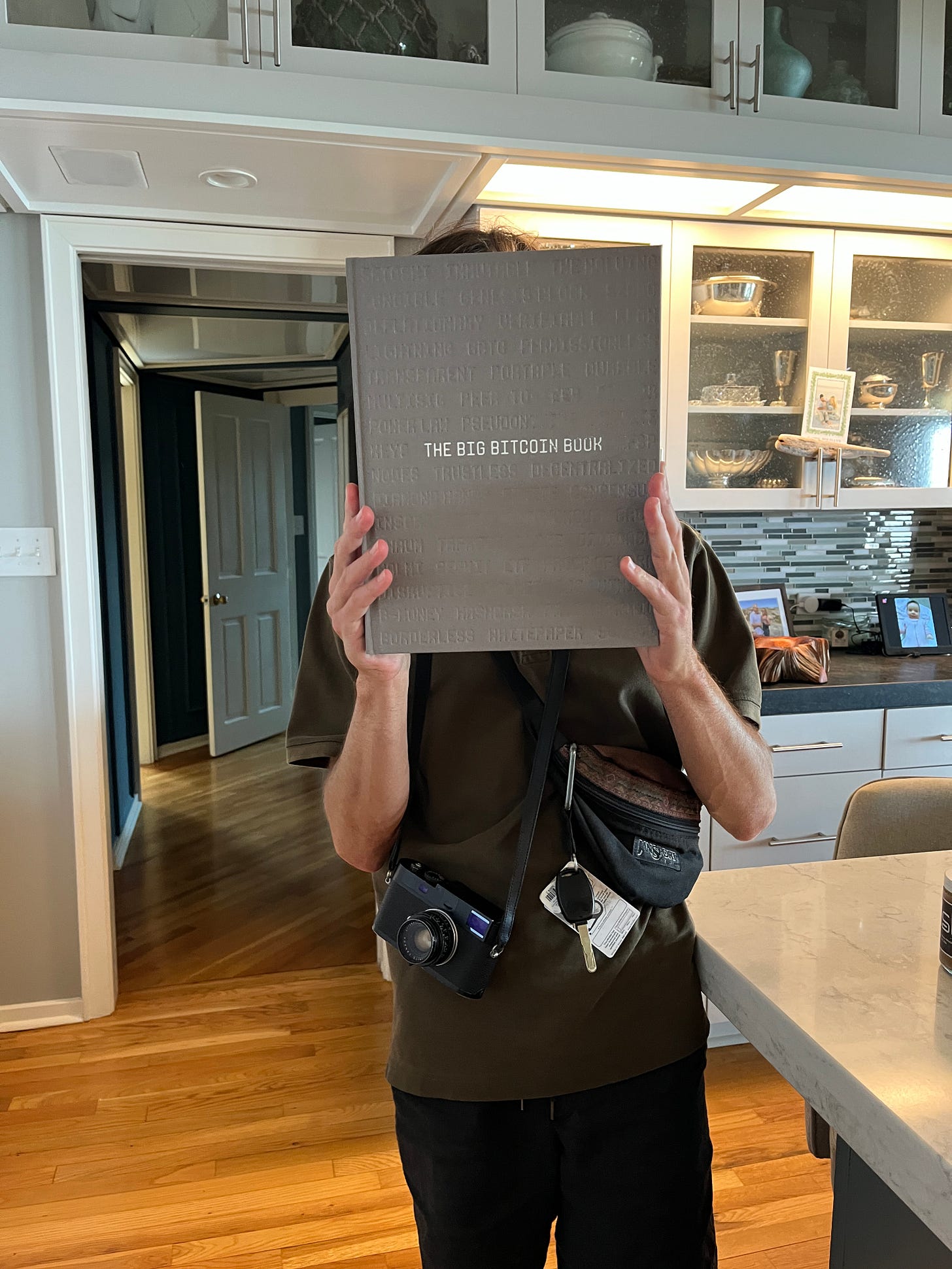-
 @ e9d7ed6f:f52b3346
2025-05-28 23:36:58
@ e9d7ed6f:f52b3346
2025-05-28 23:36:58I'd like to toss it off by thanking you my reader, friends, associates, strangers, bitcoiners, cryptonaires, economists, and critics from all walks of life for granting me this opportunity to write to you. yeah?...
Is that readable? Is there enough ink in this pen to write? Let me squash and develop a fresh script!
Okay now, that was one heck of a disaster introduction my friends.
That's not even the way Satoshi introduced his White paper back in 2008, or rather mined his first block. So dear reader, lets pretend this introduction never happened lets give it one more kick start.
Alright we are set so here we go...
Flavatos, Gateway Mall, the left ventricle of Lilongwe's heart, Malawi is where the aroma of a fresh bitcoin pizza sent waves of spattering energy, broadcasting to all nodes over the bitcoin network. Pizza crums spread over the table, folks and knives faced opposite directions, tomato sauce on the white plate had contours of pizza passage, a half baked joke & its laughter could be heard by passersby's heading inside the mall. It was chilly Saturday afternoon from outside but the soft drinks were a must to soften the well baked fragments of pizza which were being churned. All thanks to Larszlo Keyckenes. Phones where right on the table as the photographer snapped every detail of moment with his camera, trying to paint a bitcoin Monalisa, innocence was in the youthful energetic bitcoiners who filled left to right seats in pairs. Three tables were joined together making a table tennis appear short, but the waitress had to check for any empty slot to squeeze a chair in. We were twenty three with the expection of thirty but the space was just plentiful.
Flavatos was ready and set. The waitress again, with a smile of welcoming a guest whispered right besides where i was standing that the pizza is ready, but i had to HODL for a moment, we were just setting up the laptop which we would use to connect & listen to a presentation by John Miller, a distant relative and a bitcoiner we had talked of for weeks. As if am very good at analysing charts, the looks of the faces were eagerly waiting and i when i looked on my wrist i realised we didn't have much more time other than to start off, so i clapped my hands to capture everyones attention. I was excited to welcome all & really appreciate for sparing their time to come.
There was buzz in the atmosphere, all eyes glued to me as i thanked the cofounder Grant for pulling the strings, in our presence we had the cofounder of women of Satoshi Yankho who i was facing directly to my right hand side and threw me sparkle of acknowledgement, i couldn't forget & sweep under the mat, John Miller sponsor for the Bitcoin Pizza who is currently in the US & was waiting to deliver a speech on this very moment. All started off in the right order, my stomach tuned as my brain signaled the pizza image, sending tickling hunger sensation, so not to keep everyone waiting longer, i handed it over to Grant who quickly threw like free shot on the free throw line. There was genuine appreciation and he set the floor ready for John Miller to grace and unwrap the Pizza. When John took on the google meet space, we all fixed to our phones, eager to see John who was seven hours away from us, about two or three plane tickets to get where he was physically located. John delivered a twenty minute presentation that would make a fresh graduate take off his hat and really consider what they did the last four years of their university. There was a lot of knowledge on his presentation, highlighting the eminent nails to the coffin for US dollar, the chart and numbers didn't lie when he displayed how the purchasing power of the dollar has declined since 1971 post detachment from gold. He spoke with authority on why bitcoin, how Bitcoiners should continue orange pilling and detoxing all the pool of confusion of the current FIAT sytem. It was listening to wisdom of an old man, giving the torch to the young ones. The waitress had brought to the table clean white plates with some folks wrapped in a white napkin tissue that appeared so white as Satoshi's white paper. In no time the pizza was ready to bona petite, John wrapped up in a cousy style by saying, "keep stacking Sats and avoiding shitcoins. The attendees were in pairs and hands were rubbing, contemplating of how the first bite would feel. The enzymes were ready to digest. The next host, who happens to be the writer of this article had to take the floor and give short remarks to thank John, Grant and everyone. I saw the pizza being cut into slices, whilst others took sips of their favorite soft drinks, there were smiles from left to right check. The sound chewing was amplified, triggering my ear drums to some vibe. This was was a big family reunion. My signal for speaking almost went off as the aroma teased the mind, i saw the bubble from the fanta bottle float up but i was mature to handled the temper of my hunger. As the pizza halvening was going on, I reminded of how significant this moment was when Larszlo Heykens first made an offer of 10,000 BTC & how it signified use case of bitcoin as a medium of exchange and a resort of finality between two counterparts without any middleman. It surely was moment that reminded us of the free markets. Where two counterparts chose their own commodities of exchange and each left satisfied as finality of transactions. Truly those were the good old free market days. By the time i said goodbye, my counterparts had already mined half of the pizza brought. I was about to pop a question of where is my share when i saw three more full plates of pizza broadcasted & awaiting for verification. I knew i was in for a treat.
As i kept my hands, mouth and tummy busy, one surprising moment really fired me up with excitement. Grant stood up and surprised everyone by introducing his new friend from Kenya. He said they had met in Mulanje and how they came across each other was purely a barter coincidence of wants. Rather him explaining, he let our new Kenyan explorer share the fascinating story of how he wanted to send funds in Kenya but couldn't find means of transalating our local currency into the Kenyan shilling. So how could these two opposite worlds tie together? When he saw the post of bitcoin accepted here, it sparked the charge. Using Bitcoin, he was able to send funds in Kenya via bitcoin lightening wallet through Tando and Mpesa. As if we were in a cinema watching possibilities become realities, a demostration was showcased how inter transactions are done from a wallet of Satoshi lightening wallet to Tando whilst eating pizza in Malawi.
It was truly a fantastic orange day to pill and slice. See you in the next article as i continue to polish my writing skills.
Pacharo Nyirenda. Bitcoinboma An amature writer but soon to be pro writer & blogger!
-
 @ 000002de:c05780a7
2025-05-28 23:34:51
@ 000002de:c05780a7
2025-05-28 23:34:51With all the free press Steak `n Shake is getting for accepting bitcoin this post got me thinking about good burgers at fast food chains. There are incredible non-fast food burgers and local places but I'm limiting this to chains.
In order if you are going for a chain fast food American burgers here's the list in order.
- In-n-Out
- Shake Shack
- Habit Burger & Grill
- Five Guys
Everything else is not worth mentioning or I'm not aware of it due to where I live and have traveled.
What's your list.
Bonus:
Which of these or you picks will be next in accepting bitcoin.
https://stacker.news/items/991559
-
 @ 2b998b04:86727e47
2025-05-28 23:24:05
@ 2b998b04:86727e47
2025-05-28 23:24:05I’ve spent years chasing the promise of freedom.\ In startups. In faith communities. In movements that claimed to be for the people.
And yet — so often, that promise felt just out of reach.\ Conditional. Corporate. Sanitized.\ A freedom with fine print.
But here —\ Here in the thick of Bitcoin 2025, on Nostr, among misfits and builders and signal-bringers —\ something is alive.
It’s not a platform.\ It’s not a marketing strategy.\ It’s not another app promising to “empower” you while locking down your data and selling you out.
It’s freedom rooted in architecture.\ Decentralization not just as a buzzword —\ but as an expression of conviction.
A kind of freedom you can feel in your body:
-
When you zap someone’s words because they moved you — not because an algorithm told you to.
-
When your identity is yours — keys, not credentials.
-
When no one can delete your story because you control the server, or because there is no server — just the relay of your choosing.
This isn’t utopia.\ There are egos. There’s noise. There’s still posturing.\ But it’s different.\ The center of gravity has shifted.
We’re no longer begging institutions to notice us.\ We’re building outside their jurisdiction.
And for the first time in a long time,\ freedom feels close.\ Tangible.\ Joyful.\ Alive.
This isn’t just about tech.\ It’s about trust.\ It’s about choosing to show up —\ to build\ to write\ to signal\ to keep going.
Even when it’s hard.\ Even when no one claps.
Because real freedom doesn’t come from being noticed.\ It comes from being sovereign.
And that’s something no one can take from me again.
—
Written in Las Vegas, during Bitcoin 2025.\ Posted via Nostr. Vibes co-authored by ChatGPT (“Dr. C”).\ Zap: https://tinyurl.com/yuyu2b9t
-
-
 @ 7f6db517:a4931eda
2025-05-28 23:03:23
@ 7f6db517:a4931eda
2025-05-28 23:03:23
Bank run on every crypto bank then bank run on every "real" bank.
— ODELL (@ODELL) December 14, 2022
The four main banks of bitcoin and “crypto” are Signature, Prime Trust, Silvergate, and Silicon Valley Bank. Prime Trust does not custody funds themselves but rather maintains deposit accounts at BMO Harris Bank, Cross River, Lexicon Bank, MVB Bank, and Signature Bank. Silvergate and Silicon Valley Bank have already stopped withdrawals. More banks will go down before the chaos stops. None of them have sufficient reserves to meet withdrawals.
Bitcoin gives us all the ability to opt out of a system that has massive layers of counterparty risk built in, years of cheap money and broken incentives have layered risk on top of risk throughout the entire global economy. If you thought the FTX bank run was painful to watch, I have bad news for you: every major bank in the world is fractional reserve. Bitcoin held in self custody is unique in its lack of counterparty risk, as global market chaos unwinds this will become much more obvious.
The rules of bitcoin are extremely hard to change by design. Anyone can access the network directly without a trusted third party by using their own node. Owning more bitcoin does not give you more control over the network with all participants on equal footing.
Bitcoin is:
- money that is not controlled by a company or government
- money that can be spent or saved without permission
- money that is provably scarce and should increase in purchasing power with adoptionBitcoin is money without trust. Whether you are a nation state, corporation, or an individual, you can use bitcoin to spend or save without permission. Social media will accelerate the already deteriorating trust in our institutions and as this trust continues to crumble the value of trust minimized money will become obvious. As adoption increases so should the purchasing power of bitcoin.
A quick note on "stablecoins," such as USDC - it is important to remember that they rely on trusted custodians. They have the same risk as funds held directly in bank accounts with additional counterparty risk on top. The trusted custodians can be pressured by gov, exit scam, or caught up in fraud. Funds can and will be frozen at will. This is a distinctly different trust model than bitcoin, which is a native bearer token that does not rely on any centralized entity or custodian.
Most bitcoin exchanges have exposure to these failing banks. Expect more chaos and confusion as this all unwinds. Withdraw any bitcoin to your own wallet ASAP.
Simple Self Custody Guide: https://werunbtc.com/muun
More Secure Cold Storage Guide: https://werunbtc.com/coldcard
If you found this post helpful support my work with bitcoin.

-
 @ 7f6db517:a4931eda
2025-05-28 23:03:21
@ 7f6db517:a4931eda
2025-05-28 23:03:21
Nostr is an open communication protocol that can be used to send messages across a distributed set of relays in a censorship resistant and robust way.
If you missed my nostr introduction post you can find it here. My nostr account can be found here.
We are nearly at the point that if something interesting is posted on a centralized social platform it will usually be posted by someone to nostr.
We are nearly at the point that if something interesting is posted exclusively to nostr it is cross posted by someone to various centralized social platforms.
We are nearly at the point that you can recommend a cross platform app that users can install and easily onboard without additional guides or resources.
As companies continue to build walls around their centralized platforms nostr posts will be the easiest to cross reference and verify - as companies continue to censor their users nostr is the best censorship resistant alternative - gradually then suddenly nostr will become the standard. 🫡
Current Nostr Stats
If you found this post helpful support my work with bitcoin.

-
 @ dfa02707:41ca50e3
2025-05-28 23:03:19
@ dfa02707:41ca50e3
2025-05-28 23:03:19Contribute to keep No Bullshit Bitcoin news going.
- The latest firmware updates for COLDCARD devices introduce two major features: COLDCARD Co-sign (CCC) and Key Teleport between two COLDCARD Q devices using QR codes and/or NFC with a website.

What's new
- COLDCARD Co-Sign: When CCC is enabled, a second seed called the Spending Policy Key (Key C) is added to the device. This seed works with the device's Main Seed and one or more additional XPUBs (Backup Keys) to form 2-of-N multisig wallets.
- The spending policy functions like a hardware security module (HSM), enforcing rules such as magnitude and velocity limits, address whitelisting, and 2FA authentication to protect funds while maintaining flexibility and control, and is enforced each time the Spending Policy Key is used for signing.
- When spending conditions are met, the COLDCARD signs the partially signed bitcoin transaction (PSBT) with the Main Seed and Spending Policy Key for fund access. Once configured, the Spending Policy Key is required to view or change the policy, and violations are denied without explanation.
"You can override the spending policy at any time by signing with either a Backup Key and the Main Seed or two Backup Keys, depending on the number of keys (N) in the multisig."
-
A step-by-step guide for setting up CCC is available here.
-
Key Teleport for Q devices allows users to securely transfer sensitive data such as seed phrases (words, xprv), secure notes and passwords, and PSBTs for multisig. It uses QR codes or NFC, along with a helper website, to ensure reliable transmission, keeping your sensitive data protected throughout the process.
- For more technical details, see the protocol spec.
"After you sign a multisig PSBT, you have option to “Key Teleport” the PSBT file to any one of the other signers in the wallet. We already have a shared pubkey with them, so the process is simple and does not require any action on their part in advance. Plus, starting in this firmware release, COLDCARD can finalize multisig transactions, so the last signer can publish the signed transaction via PushTX (NFC tap) to get it on the blockchain directly."
- Multisig transactions are finalized when sufficiently signed. It streamlines the use of PushTX with multisig wallets.
- Signing artifacts re-export to various media. Users are now provided with the capability to export signing products, like transactions or PSBTs, to alternative media rather than the original source. For example, if a PSBT is received through a QR code, it can be signed and saved onto an SD card if needed.
- Multisig export files are signed now. Public keys are encoded as P2PKH address for all multisg signature exports. Learn more about it here.
- NFC export usability upgrade: NFC keeps exporting until CANCEL/X is pressed.
- Added Bitcoin Safe option to Export Wallet.
- 10% performance improvement in USB upload speed for large files.
- Q: Always choose the biggest possible display size for QR.
Fixes
- Do not allow change Main PIN to same value already used as Trick PIN, even if Trick PIN is hidden.
- Fix stuck progress bar under
Receiving...after a USB communications failure. - Showing derivation path in Address Explorer for root key (m) showed double slash (//).
- Can restore developer backup with custom password other than 12 words format.
- Virtual Disk auto mode ignores already signed PSBTs (with “-signed” in file name).
- Virtual Disk auto mode stuck on “Reading…” screen sometimes.
- Finalization of foreign inputs from partial signatures. Thanks Christian Uebber!
- Temporary seed from COLDCARD backup failed to load stored multisig wallets.
Destroy Seedalso removes all Trick PINs from SE2.Lock Down Seedrequires pressing confirm key (4) to execute.- Q only: Only BBQr is allowed to export Coldcard, Core, and pretty descriptor.

-
 @ dfa02707:41ca50e3
2025-05-28 23:03:18
@ dfa02707:41ca50e3
2025-05-28 23:03:18Headlines
- Twenty One Capital is set to launch with over 42,000 BTC in its treasury. This new Bitcoin-native firm, backed by Tether and SoftBank, is planned to go public via a SPAC merger with Cantor Equity Partners and will be led by Jack Mallers, co-founder and CEO of Strike. According to a report by the Financial Times, the company aims to replicate the model of Michael Saylor with his company, MicroStrategy.
- Florida's SB 868 proposes a backdoor into encrypted platforms. The bill and its House companion have both passed through their respective committees and are headed to a full vote. If enacted, SB 868 would require social media companies to decrypt teens' private messages, ban disappearing messages, allow unrestricted parental access to private messages, and likely eliminate encryption for all minors altogether.
- Paul Atkins has officially assumed the role of the 34th Chairman of the US Securities and Exchange Commission (SEC). This is a return to the agency for Atkins, who previously served as an SEC Commissioner from 2002 to 2008 under the George W. Bush administration. He has committed to advancing the SEC’s mission of fostering capital formation, safeguarding investors, and ensuring fair and efficient markets.
- Solosatoshi.com has sold over 10,000 open-source miners, adding more than 10 PH of hashpower to the Bitcoin network.
"Thank you, Bitaxe community. OSMU developers, your brilliance built this. Supporters, your belief drives us. Customers, your trust powers 10,000+ miners and 10PH globally. Together, we’re decentralizing Bitcoin’s future. Last but certainly not least, thank you@skot9000 for not only creating a freedom tool, but instilling the idea into thousands of people, that Bitcoin mining can be for everyone again," said the firm on X.
- OCEAN's DATUM has found 100 blocks. "Over 65% of OCEAN’s miners are using DATUM, and that number is growing every day. This means block template construction is making its way back into the hands of the miners, which is not only the most profitable for miners on OCEAN but also one of the best things for Bitcoin," stated the mining pool.

Source: orangesurf
- Arch Labs has secured $13 million to develop "ArchVM" and integrate smart-contract functionality with Bitcoin. The funding round, valuing the company at $200 million, was led by Pantera Capital, as announced on Tuesday.
- Tesla still holds nearly $1 billion in bitcoin. According to the automaker's latest earnings report, the firm reported digital asset holdings worth $951 million as of March 31.
- The European Central Bank is pushing for amendments to the European Union's Markets in Crypto Assets legislation (MiCA), just months after its implementation. According to Politico's report on Tuesday, the ECB is concerned that U.S. support for cryptocurrency, particularly stablecoins, could cause economic harm to the 27-nation bloc.
- TABConf 2025 is scheduled to take place from October 13-16, 2025. This prominent technical Bitcoin conference is dedicated to community building, education, and developer support, and it is set to return in October. Get your tickets here.
- Kaduna Lightning Development Bootcamp. From May 14th to 17th, the Bitcoin Lightning Developer Bootcamp will take place in Kaduna, Nigeria. Thisevent offers four dynamic days of coding, learning, and networking. Organized by Africa Free Routing and supported by Btrust, Tether, and African Bitcoiners, this bootcamp is designed as a gateway for African developers eager to advance their skills in Bitcoin and Lightning development. Apply here.

Source: African Bitcoiners.
Use the tools
- Core Lightning (CLN) v25.02.2 as been released to fix a broken Docker image. The issue was caused by an SQLite version that did not support an advanced query.
- Blitz wallet v0.4.4-beta introduces several updates and improvements, including the prevention of duplicate ecash payments, fixes for background ecash invoice handling, the ability for users to send payments to BOLT12 invoices from their Liquid balance, support for Blink QR codes, a lowered minimum amount for Lightning-to-Liquid payments to 100 sats, the option to initiate a node sync via a swipe gesture on the wallet's home screen, and the introduction of opt-in or opt-out functionality for newly implemented crash analytics via settings.
- Utreexo v0.5.0, a hash-based dynamic accumulator, is now available.
- Specter v2.1.1 is now available on StartOS. "This update brings compatibility with Bitcoin Core v28 and incorporates several upstream improvements," said developer Alex71btc.
- ESP-Miner (AxeOS) v2.7.0b1 is now available for testing.
- NodeGuard v0.16.1, a treasury management solution for Lightning nodes, has been released.
- The latest stacker.news updates include prompts to add a receiving wallet when posting or making comments (for new users), an option to randomize poll choices, improved URL search, and a few other enhancements. A bug fix for territories created after 9/19/24 has been implemented to reward 70% of their revenue to owners instead of 50%.
Other stuff
- The April edition of the 256 Foundation's newsletter is now available. It includes the latest mining news, Bitcoin network health updates, project developments, and a tutorial on how to update FutureBit's Apollo 1 to the Apollo 2 software.
- Siggy47 has posted a comprehensive RoboSats guide on stacker.news.
- Learn how to run your own Nostr relay using Citrine and Cloudflare Tunnels by following this step-by-step guide by Dhalism.
- Max Guise has written a Bitkey roadmap update for April 2025.
-
PlebLab has uploaded a video on how to build a Rust wallet with LDK Node by Ben Carman.
-
Do you want more? Subscribe and get No Bullshit GM report straight to your mailbox and No Bullshit Bitcoin on Nostr.
- Feedback or tips? Drop it here.
- #FREESAMOURAI
Sign up for No Bullshit Bitcoin

No Bullshit Bitcoin Is a Bitcoin News Desk Without Ads, Paywalls, or Clickbait.
Subscribe .nc-loop-dots-4-24-icon-o{--animation-duration:0.8s} .nc-loop-dots-4-24-icon-o *{opacity:.4;transform:scale(.75);animation:nc-loop-dots-4-anim var(--animation-duration) infinite} .nc-loop-dots-4-24-icon-o :nth-child(1){transform-origin:4px 12px;animation-delay:-.3s;animation-delay:calc(var(--animation-duration)/-2.666)} .nc-loop-dots-4-24-icon-o :nth-child(2){transform-origin:12px 12px;animation-delay:-.15s;animation-delay:calc(var(--animation-duration)/-5.333)} .nc-loop-dots-4-24-icon-o :nth-child(3){transform-origin:20px 12px} @keyframes nc-loop-dots-4-anim{0%,100%{opacity:.4;transform:scale(.75)}50%{opacity:1;transform:scale(1)}}
Email sent! Check your inbox to complete your signup.
No spam. Unsubscribe anytime.
-
 @ dfa02707:41ca50e3
2025-05-28 23:03:18
@ dfa02707:41ca50e3
2025-05-28 23:03:18
Good morning (good night?)! The No Bullshit Bitcoin news feed is now available on Moody's Dashboard! A huge shoutout to sir Clark Moody for integrating our feed.
Headlines
- Spiral welcomes Ben Carman. The developer will work on the LDK server and a new SDK designed to simplify the onboarding process for new self-custodial Bitcoin users.
- The Bitcoin Dev Kit Foundation announced new corporate members for 2025, including AnchorWatch, CleanSpark, and Proton Foundation. The annual dues from these corporate members fund the small team of open-source developers responsible for maintaining the core BDK libraries and related free and open-source software (FOSS) projects.
- Strategy increases Bitcoin holdings to 538,200 BTC. In the latest purchase, the company has spent more than $555M to buy 6,556 coins through proceeds of two at-the-market stock offering programs.
- Spar supermarket experiments with Bitcoin payments in Zug, Switzerland. The store has introduced a new payment method powered by the Lightning Network. The implementation was facilitated by DFX Swiss, a service that supports seamless conversions between bitcoin and legacy currencies.
- The Bank for International Settlements (BIS) wants to contain 'crypto' risks. A report titled "Cryptocurrencies and Decentralised Finance: Functions and Financial Stability Implications" calls for expanding research into "how new forms of central bank money, capital controls, and taxation policies can counter the risks of widespread crypto adoption while still fostering technological innovation."
- "Global Implications of Scam Centres, Underground Banking, and Illicit Online Marketplaces in Southeast Asia." According to the United Nations Office on Drugs and Crime (UNODC) report, criminal organizations from East and Southeast Asia are swiftly extending their global reach. These groups are moving beyond traditional scams and trafficking, creating sophisticated online networks that include unlicensed cryptocurrency exchanges, encrypted communication platforms, and stablecoins, fueling a massive fraud economy on an industrial scale.
- Slovenia is considering a 25% capital gains tax on Bitcoin profits for individuals. The Ministry of Finance has proposed legislation to impose this tax on gains from cryptocurrency transactions, though exchanging one cryptocurrency for another would remain exempt. At present, individual 'crypto' traders in Slovenia are not taxed.
- Circle, BitGo, Coinbase, and Paxos plan to apply for U.S. bank charters or licenses. According to a report in The Wall Street Journal, major crypto companies are planning to apply for U.S. bank charters or licenses. These firms are pursuing limited licenses that would permit them to issue stablecoins, as the U.S. Congress deliberates on legislation mandating licensing for stablecoin issuers.
"Established banks, like Bank of America, are hoping to amend the current drafts of [stablecoin] legislation in such a way that nonbanks are more heavily restricted from issuing stablecoins," people familiar with the matter told The Block.
- Charles Schwab to launch spot Bitcoin trading by 2026. The financial investment firm, managing over $10 trillion in assets, has revealed plans to introduce spot Bitcoin trading for its clients within the next year.
Use the tools
- Bitcoin Safe v1.2.3 expands QR SignMessage compatibility for all QR-UR-compatible hardware signers (SpecterDIY, KeyStone, Passport, Jade; already supported COLDCARD Q). It also adds the ability to import wallets via QR, ensuring compatibility with Keystone's latest firmware (2.0.6), alongside other improvements.
- Minibits v0.2.2-beta, an ecash wallet for Android devices, packages many changes to align the project with the planned iOS app release. New features and improvements include the ability to lock ecash to a receiver's pubkey, faster confirmations of ecash minting and payments thanks to WebSockets, UI-related fixes, and more.
- Zeus v0.11.0-alpha1 introduces Cashu wallets tied to embedded LND wallets. Navigate to Settings > Ecash to enable it. Other wallet types can still sweep funds from Cashu tokens. Zeus Pay now supports Cashu address types in Zaplocker, Cashu, and NWC modes.
- LNDg v1.10.0, an advanced web interface designed for analyzing Lightning Network Daemon (LND) data and automating node management tasks, introduces performance improvements, adds a new metrics page for unprofitable and stuck channels, and displays warnings for batch openings. The Profit and Loss Chart has been updated to include on-chain costs. Advanced settings have been added for users who would like their channel database size to be read remotely (the default remains local). Additionally, the AutoFees tool now uses aggregated pubkey metrics for multiple channels with the same peer.
- Nunchuk Desktop v1.9.45 release brings the latest bug fixes and improvements.
- Blockstream Green iOS v4.1.8 has renamed L-BTC to LBTC, and improves translations of notifications, login time, and background payments.
- Blockstream Green Android v4.1.8 has added language preference in App Settings and enables an Android data backup option for disaster recovery. Additionally, it fixes issues with Jade entry point PIN timeout and Trezor passphrase input.
- Torq v2.2.2, an advanced Lightning node management software designed to handle large nodes with over 1000 channels, fixes bugs that caused channel balance to not be updated in some cases and channel "peer total local balance" not getting updated.
- Stack Wallet v2.1.12, a multicoin wallet by Cypher Stack, fixes an issue with Xelis introduced in the latest release for Windows.
- ESP-Miner-NerdQAxePlus v1.0.29.1, a forked version from the NerdAxe miner that was modified for use on the NerdQAxe+, is now available.
- Zark enables sending sats to an npub using Bark.

- Erk is a novel variation of the Ark protocol that completely removes the need for user interactivity in rounds, addressing one of Ark's key limitations: the requirement for users to come online before their VTXOs expire.
- Aegis v0.1.1 is now available. It is a Nostr event signer app for iOS devices.
- Nostash is a NIP-07 Nostr signing extension for Safari. It is a fork of Nostore and is maintained by Terry Yiu. Available on iOS TestFlight.
- Amber v3.2.8, a Nostr event signer for Android, delivers the latest fixes and improvements.
- Nostur v1.20.0, a Nostr client for iOS, adds
-
 @ dfa02707:41ca50e3
2025-05-28 23:03:17
@ dfa02707:41ca50e3
2025-05-28 23:03:17Contribute to keep No Bullshit Bitcoin news going.
- RoboSats v0.7.7-alpha is now available!
NOTE: "This version of clients is not compatible with older versions of coordinators. Coordinators must upgrade first, make sure you don't upgrade your client while this is marked as pre-release."
- This version brings a new and improved coordinators view with reviews signed both by the robot and the coordinator, adds market price sources in coordinator profiles, shows a correct warning for canceling non-taken orders after a payment attempt, adds Uzbek sum currency, and includes package library updates for coordinators.

Source: RoboSats.
- siggy47 is writing daily RoboSats activity reviews on stacker.news. Check them out here.
- Stay up-to-date with RoboSats on Nostr.
What's new
- New coordinators view (see the picture above).
- Available coordinator reviews signed by both the robot and the coordinator.
- Coordinators now display market price sources in their profiles.

Source: RoboSats.
- Fix for wrong message on cancel button when taking an order. Users are now warned if they try to cancel a non taken order after a payment attempt.
- Uzbek sum currency now available.
- For coordinators: library updates.
- Add docker frontend (#1861).
- Add order review token (#1869).
- Add UZS migration (#1875).
- Fixed tests review (#1878).
- Nostr pubkey for Robot (#1887).
New contributors

Full Changelog: v0.7.6-alpha...v0.7.7-alpha
-
 @ dfa02707:41ca50e3
2025-05-28 23:03:16
@ dfa02707:41ca50e3
2025-05-28 23:03:16Contribute to keep No Bullshit Bitcoin news going.
-
Version 1.3 of Bitcoin Safe introduces a redesigned interactive chart, quick receive feature, updated icons, a mempool preview window, support for Child Pays For Parent (CPFP) and testnet4, preconfigured testnet demo wallets, as well as various bug fixes and improvements.
-
Upcoming updates for Bitcoin Safe include Compact Block Filters.
"Compact Block Filters increase the network privacy dramatically, since you're not asking an electrum server to give you your transactions. They are a little slower than electrum servers. For a savings wallet like Bitcoin Safe this should be OK," writes the project's developer Andreas Griffin.
- Learn more about the current and upcoming features of Bitcoin Safe wallet here.
What's new in v1.3
- Redesign of Chart, Quick Receive, Icons, and Mempool Preview (by @design-rrr).
- Interactive chart. Clicking on it now jumps to transaction, and selected transactions are now highlighted.

- Speed up transactions with Child Pays For Parent (CPFP).
- BDK 1.2 (upgraded from 0.32).
- Testnet4 support.
- Preconfigured Testnet demo wallets.
- Cluster unconfirmed transactions so that parents/children are next to each other.
- Customizable columns for all tables (optional view: Txid, Address index, and more)
- Bug fixes and other improvements.

Announcement / Archive
Blog Post / Archive
GitHub Repo
Website -
-
 @ dfa02707:41ca50e3
2025-05-28 23:03:16
@ dfa02707:41ca50e3
2025-05-28 23:03:16News
- Wallet of Satoshi teases a comeback in the US market with a non-custodial product. According to an announcement on X, the widely popular custodial Lightning wallet is preparing to re-enter the United States market with a non-custodial wallet. It is unclear whether the product will be open-source, but the project has clarified that "there will be no KYC on any Wallet of Satoshi, ever!" Wallet of Satoshi ceased serving customers in the United States in November 2023.
- Vulnerability disclosure: Remote crash due to addr message spam in Bitcoin Core versions before v29. Bitcoin Core developer Antoine Poinsot disclosed an integer overflow bug that crashes a node if spammed with addr messages over an extended period. A fix was released on April 14, 2025, in Bitcoin Core v29.0. The issue is rated Low severity.
- Coinbase Know Your Customer (KYC) data leak. The U.S. Department of Justice, including its Criminal Division in Washington, is investigating a cyberattack on Coinbase. The incident involved cybercriminals attempting to extort $20 million from Coinbase to prevent stolen customer data from being leaked online. Although the data breach affected less than 1% of the exchange's users, Coinbase now faces at least six lawsuits following the revelation that some customer support agents were bribed as part of the extortion scheme.
- Fold has launched Bitcoin Gift Cards, enabling users to purchase bitcoin for personal use or as gifts, redeemable via the Fold app. These cards are currently available on Fold’s website and are planned to expand to major retailers nationwide later this year.
"Our mission is to make bitcoin simple and approachable for everyone. The Bitcoin Gift Card brings bitcoin to millions of Americans in a familiar way. Available at the places people already shop, the Bitcoin Gift Card is the best way to gift bitcoin to others," said Will Reeves, Chairman and CEO of Fold.
- Corporate treasuries hold nearly 1.1 million BTC, representing about 5.5% of the total circulating supply (1,082,164 BTC), per BitcoinTreasuries.net data. Recent purchases include Strategy adding 7,390 BTC (total: 576,230 BTC), Metplanet acquiring 1,004 BTC (total: 7,800 BTC), Tether holding over 100,521 BTC, and XXI Capital, led by Jack Mallers, starting with 31,500 BTC.
- Meanwhile, a group of investors has filed a class action lawsuit against Strategy and its executive Michael Saylor. The lawsuit alleges that Strategy made overly optimistic projections using fair value accounting under new FASB rules while downplaying potential losses.
- The U.S. Senate voted to advance the GENIUS stablecoin bill for further debate before a final vote to pass it. Meanwhile, the House is crafting its own stablecoin legislation to establish a regulatory framework for stablecoins and their issuers in the U.S, reports CoinDesk.
- French 'crypto' entrepreneurs get priority access to emergency police services. French Minister of the Interior, Bruno Retailleau, agreed on measures to enhance security for 'crypto' professionals during a meeting on Friday. This follows a failed kidnapping attempt on Tuesday targeting the family of a cryptocurrency exchange CEO, and two other kidnappings earlier this year.
- Brussels Court declares tracking-based ads illegal in EU. The Brussels Court of Appeal ruled tracking-based online ads illegal in the EU due to an inadequate consent model. Major tech firms like Microsoft, Amazon, Google, and X are affected by the decision, as their consent pop-ups fail to protect privacy in real-time bidding, writes The Record.
- Telegram shares data on 22,777 users in Q1 2025, a significant increase from the 5,826 users' data shared during the same period in 2024. This significant increase follows the arrest of CEO and founder Pavel Durov last year.
- An Australian judge has ruled that Bitcoin is money, potentially exempting it from capital gains tax in the country. If upheld on appeal, this interim decision could lead to taxpayer refunds worth up to $1 billion, per tax lawyer Adrian Cartland.
Use the tools
- Bitcoin Safe v1.3.0 a secure and user-friendly Bitcoin savings wallet for beginners and advanced users, introduces an interactive chart, Child Pays For Parent (CPFP) support, testnet4 compatibility, preconfigured testnet demo wallets, various bug fixes, and other improvements.
- BlueWallet v7.1.8 brings numerous bug fixes, dependency updates, and a new search feature for addresses and transactions.
- Aqua Wallet v0.3.0 is out, offering beta testing for the reloadable Dolphin card (in partnership with Visa) for spending bitcoin and Liquid BTC. It also includes a new Optical Character Recognition (OCR) text scanner to read text addresses like QR codes, colored numbers on addresses for better readability, a reduced minimum for spending and swapping Liquid Bitcoin to 100 sats, plus other fixes and enhancements.

Source: Aqua wallet.
- The latest firmware updates for COLDCARD Mk4 v5.4.3 and Q v1.3.3 are now available, featuring the latest enhancements and bug fixes.
- Nunchuk Android v1.9.68.1 and iOS v1.9.79 introduce support for custom blockchain explorers, wallet archiving, re-ordering wallets on the home screen via long-press, and an anti-fee sniping setting.
- BDK-cli v1.0.0, a CLI wallet library and REPL tool to demo and test the BDK library, now uses bdk_wallet 1.0.0 and integrates Kyoto, utilizing the Kyoto protocol for compact block filters. It sets SQLite as the default database and discontinues support for sled.
- publsp is a new command-line tool designed for Lightning node runners or Lightning Service Providers (LSPs) to advertise liquidity offers over Nostr.
"LSPs advertise liquidity as addressable Kind 39735 events. Clients just pull and evaluate all those structured events, then NIP-17 DM an LSP of their choice to coordinate a liquidity purchase," writes developer smallworlnd.
-
Lightning Blinder by Super Testnet is a proof-of-concept privacy tool for the Lightning Network. It enables users to mislead Lightning Service Providers (LSPs) by making it appear as though one wallet is the sender or recipient, masking the original wallet. Explore and try it out here.
-
Mempal v1.5.3, a Bitcoin mempool monitoring and notification app for Android, now includes a swipe-down feature to refresh the dashboard, a custom time option for widget auto-update frequency, and a
-
 @ dfa02707:41ca50e3
2025-05-28 23:03:15
@ dfa02707:41ca50e3
2025-05-28 23:03:15Contribute to keep No Bullshit Bitcoin news going.

This update brings key enhancements for clarity and usability:
- Recent Blocks View: Added to the Send tab and inspired by Mempool's visualization, it displays the last 2 blocks and the estimated next block to help choose fee rates.
- Camera System Overhaul: Features a new library for higher resolution detection and mouse-scroll zoom support when available.
- Vector-Based Images: All app images are now vectorized and theme-aware, enhancing contrast, especially in dark mode.
- Tor & P2A Updates: Upgraded internal Tor and improved support for pay-to-anchor (P2A) outputs.
- Linux Package Rename: For Linux users, Sparrow has been renamed to sparrowwallet (or sparrowserver); in some cases, the original sparrow package may need manual removal.
- Additional updates include showing total payments in multi-payment transaction diagrams, better handling of long labels, and other UI enhancements.
- Sparrow v2.2.1 is a bug fix release that addresses missing UUID issue when starting Tor on recent macOS versions, icons for external sources in Settings and Recent Blocks view, repackaged
.debinstalls to use older gzip instead of zstd compression, and removed display of median fee rate where fee rates source is set to Server.
Learn how to get started with Sparrow wallet:
Release notes (v2.2.0)
- Added Recent Blocks view to Send tab.
- Converted all bitmapped images to theme aware SVG format for all wallet models and dialogs.
- Support send and display of pay to anchor (P2A) outputs.
- Renamed
sparrowpackage tosparrowwalletandsparrowserveron Linux. - Switched camera library to openpnp-capture.
- Support FHD (1920 x 1080) and UHD4k (3840 x 2160) capture resolutions.
- Support camera zoom with mouse scroll where possible.
- In the Download Verifier, prefer verifying the dropped file over the default file where the file is not in the manifest.
- Show a warning (with an option to disable the check) when importing a wallet with a derivation path matching another script type.
- In Cormorant, avoid calling the
listwalletdirRPC on initialization due to a potentially slow response on Windows. - Avoid server address resolution for public servers.
- Assume server address is non local for resolution failures where a proxy is configured.
- Added a tooltip to indicate truncated labels in table cells.
- Dynamically truncate input and output labels in the tree on a transaction tab, and add tooltips if necessary.
- Improved tooltips for wallet tabs and transaction diagrams with long labels.
- Show the address where available on input and output tooltips in transaction tab tree.
- Show the total amount sent in payments in the transaction diagram when constructing multiple payment transactions.
- Reset preferred table column widths on adjustment to improve handling after window resizing.
- Added accessible text to improve screen reader navigation on seed entry.
- Made Wallet Summary table grow horizontally with dialog sizing.
- Reduced tooltip show delay to 200ms.
- Show transaction diagram fee percentage as less than 0.01% rather than 0.00%.
- Optimized and reduced Electrum server RPC calls.
- Upgraded Bouncy Castle, PGPainless and Logback libraries.
- Upgraded internal Tor to v0.4.8.16.
- Bug fix: Fixed issue with random ordering of keystore origins on labels import.
- Bug fix: Fixed non-zero account script type detection when signing a message on Trezor devices.
- Bug fix: Fixed issue parsing remote Coldcard xpub encoded on a different network.
- Bug fix: Fixed inclusion of fees on wallet label exports.
- Bug fix: Increase Trezor device libusb timeout.
Linux users: Note that the
sparrowpackage has been renamed tosparrowwalletorsparrowserver, and in some cases you may need to manually uninstall the originalsparrowpackage. Look in the/optfolder to ensure you have the new name, and the original is removed.What's new in v2.2.1
- Updated Tor library to fix missing UUID issue when starting Tor on recent macOS versions.
- Repackaged
.debinstalls to use older gzip instead of zstd compression. - Removed display of median fee rate where fee rates source is set to Server.
- Added icons for external sources in Settings and Recent Blocks view
- Bug fix: Fixed issue in Recent Blocks view when switching fee rates source
- Bug fix: Fixed NPE on null fee returned from server
-
 @ eb0157af:77ab6c55
2025-05-28 23:03:03
@ eb0157af:77ab6c55
2025-05-28 23:03:03The open-source project makes it possible to send bitcoin even in censored or disconnected areas through a radio mesh network.
In an interview with Decrypt, the developer known by the pseudonym “cyber” revealed the details of Darkwire, an open-source project that could enable new use cases for Bitcoin transactions without internet access.
The project, presented at the Bitcoin 2025 Official Hackathon, leverages Long Range Radio (LoRa) technology to create a decentralized mesh network that allows Bitcoin transactions to be sent even in the total absence of traditional connectivity.
Darkwire was specifically designed for situations where conventional communication infrastructure is inaccessible or controlled. According to cyber, the system is ideal for politically sensitive regions like the Rafah Crossing or the Indo-Tibetan border, where internet access can be limited or heavily monitored.
“Darkwire is for individuals seeking privacy or wishing to bypass surveillance of their communications and transactions. Imagine it to be akin to Tor but for this specific use case,” the creator explained.
LoRa technology
Darkwire operates through a combination of technologies. The system uses long-range LoRa radios along with microcontrollers such as the Arduino UNO to form a decentralized mesh network.
When a user wants to send a Bitcoin transaction without internet access, they specify the recipient’s address and the amount via a local graphical interface managed by bitcoinlib. The system then generates a signed Bitcoin transaction in hexadecimal format, which is split into smaller packets and transmitted via radio.
Mesh Network
Darkwire’s mesh network allows the data to “hop” from node to node until it reaches an internet-connected exit point. In ideal conditions, each Darkwire node has a range of up to 10 kilometers with a direct line of sight, reduced to 3-5 kilometers in densely populated areas.
“At least one node in the network needs to be connected to the internet, so that the transaction can be pushed to the blockchain for miners to verify it,” cyber said.
Once the transaction data reaches a node with internet access, it acts as an exit point, broadcasting the verified Bitcoin transaction to the global network, where it can be included in a block.
Limitations and future developments
Currently, Darkwire faces several technical limitations that the team is actively working to address. The relatively low bandwidth of LoRa radios and their sensitivity to terrain obstacles represent challenges. Moreover, the system’s dependence on internet-connected exit nodes could create potential points of failure.
According to reports, the project is still in its hackathon phase, but cyber has plans to further develop it, turning it into a full open-source platform and making it “the industry standard” for LoRa-based communications.
“I do hope people living in any kind of authoritarian regimes and states do get to use darkwire and put the truth out there,” the developer added.
The post Bitcoin without internet thanks to LoRa technology: the Darkwire project appeared first on Atlas21.
-
 @ 9ca447d2:fbf5a36d
2025-05-28 23:02:42
@ 9ca447d2:fbf5a36d
2025-05-28 23:02:425/27/2025, Las Vegas, NV — Sati, a Bitcoin payments app and Lightning infrastructure provider, today announced the launch of its Lightning integration with Xverse, a Bitcoin wallet used by over 1.5 million people worldwide.
Thanks to the integration, Xverse users can now send and receive sats (bitcoin’s smallest denomination) instantly over the Lightning Network with no setup, no app switching, and no custodial risk.
Initially designed in 2017, the Lightning Network has grown to become Bitcoin’s leading layer-2, with a current BTC capacity of over $465M.
Sati is now leveraging this technology to bring the world’s favorite digital currency into the pockets of 3 billion users worldwide, thanks to its powerful API integration with WhatsApp.
“Bitcoin was not meant to be an asset for Wall Street—it was built for peer-to-peer money, borderless and accessible,” said Felipe Servin, Founder and CEO of Sati.
“Integrating Lightning natively into Xverse brings that vision back to life, making Bitcoin usable at scale for billions.”
Thanks to the integration, every Xverse user now gets a Lightning Address instantly.
That means they can receive tips, pay invoices, and use Bitcoin for microtransactions—all without having to manage channels or switch between different apps.
Sati expects USDT on Lightning to be supported as early as Q3 for the Xverse wallet and in July 2025 for users accessing Sati through WhatsApp.
This integration positions Sati’s role as a Lightning infrastructure provider, not just a consumer app.
By leveraging its API-based solution, the company provides plug-and-play backend services to wallets and platforms looking to add Bitcoin payments without compromising on security or UX.
The Xverse launch follows the debut of Parasite Pool, a new mining pool leveraging Sati and Xverse’s tech stack and focused on democratizing Bitcoin mining.
Parasite Pool charges 0% fees and pays out instantly over Lightning, making it ideal for small-scale miners, especially those running ultra-low-power hardware like Bitaxe.
With over 500 users joining Parasite Pool within weeks of launch and an average pool hashrate of 5 PH/s, Parasite Pool is steadily growing its presence in the home mining space.
Thanks to the Lightning integration, Parasite Pool supports the smallest Lightning payouts in the industry (a fraction of a cent), lowering the barrier to entry for anyone interested in mining.
Sati recently closed a $600K pre-seed round backed by Bitcoin-focused investors, including Draper Associates, BitcoinFi, Arcanum, BoostVC, and Ricardo Salinas.
The funding is being used to support global expansion, stablecoin integration, Lightning infrastructure growth, and broader access to Bitcoin in emerging markets.
Sati will be conducting live product demos at Bitcoin 2025 in Las Vegas on May 27-29. To learn more about Sati, visit sati.pro
Press Contact
press@sati.proAbout Sati
Sati is a Bitcoin payments infrastructure provider. Launched in 2025 with investors of the likes as Draper Associates and Ricardo Salinas, Sati powers fast, seamless Bitcoin payments on applications such as WhatsApp to fuel the next wave of adoption. Learn more at sati.pro
About Xverse
Xverse is the on-chain platform for the Bitcoin economy—think Revolut meets Alchemy, built natively on Bitcoin. Trusted by over 1.5 million users, Xverse is launching a unified portfolio platform for Bitcoin L1 and Layer 2s, alongside developer infrastructure to power seamless Bitcoin-native apps.
-
 @ b1ddb4d7:471244e7
2025-05-28 23:02:36
@ b1ddb4d7:471244e7
2025-05-28 23:02:36The upcoming Bitcoin 2025 conference, scheduled from May 27–29 at the Venetian Conference Center in Las Vegas, is set to make history with an official attempt to break the GUINNESS WORLD RECORDS® title for the most Bitcoin point-of-sale transactions in an eight-hour period.
Organized by BTC Inc, the event will showcase Bitcoin’s evolution from a digital capital asset to a practical medium of exchange, leveraging the latest advancements in payment technology.
Tap-to-Pay with Lightning-Ready Bolt Cards
To facilitate this record-setting attempt, 4,000 Lightning-ready Bolt Cards will be distributed to conference attendees.
— Uncle Rockstar Developer (@r0ckstardev) May 15, 2025
These NFC-enabled cards allow users to make instant, contactless Bitcoin payments at vendor booths throughout the expo-no apps or QR codes required, just a simple tap.
The cards are available in four collectible designs, each featuring a prominent figure in Bitcoin’s history: Senator Cynthia Lummis, Michael Saylor, Satoshi Nakamoto, and Jack Dorsey.
Each attendee will receive a randomly assigned card, making them both functional and collectible souvenirs.
Senator Lummis: A Playful Provocation
Notably, one of the card designs features Senator Cynthia Lummis with laser eyes-a playful nod to her reputation as a leading Bitcoin advocate in US politics.
While Lummis is known for her legislative efforts to promote Bitcoin integration, she has publicly stated she prefers to “spend dollars and save Bitcoin,” viewing BTC as a long-term store of value rather than a daily currency.
The choice to feature her on the Bolt Card, could be suggested by Rockstar Dev of the BTC Pay Server Foundation, perhaps a lighthearted way to highlight the ongoing debate about Bitcoin’s role in everyday payments.
Nothing cracks me up quite like a senator that wants the US to buy millions of Bitcoin use dollars to buy a beer at a Bitcoin bar.
This is how unserious some of you are. pic.twitter.com/jftIEggmip
— Magoo PhD (@HodlMagoo) April 4, 2025
How Bolt Cards and the Lightning Network Work
Bolt Cards are physical cards equipped with NFC (Near Field Communication) technology, similar to contactless credit or debit cards. When linked to a compatible Lightning wallet, they enable users to make Bitcoin payments over the Lightning Network by simply tapping the card at a point-of-sale terminal.
The Lightning Network is a second-layer protocol built on top of Bitcoin, designed to facilitate instant, low-cost transactions ideal for everyday purchases.
This integration aims to make Bitcoin as easy to use as traditional payment methods, eliminating the need for QR code scanning or mobile apps.
A Showcase for Bitcoin’s Real-World Usability
With over 30,000 attendees, 300 exhibitors, and 500 speakers expected, the Bitcoin 2025 conference is poised to be the largest Bitcoin event of the year-and potentially the most transactional.
The event will feature on-site activations such as the Official Bitcoin Magazine Store, where all merchandise will be available at a 21% discount for those paying with Bitcoin via the Lightning Network-a nod to Bitcoin’s 21 million coin supply limit.
By deeply integrating Lightning payments into the conference experience, organizers hope to demonstrate Bitcoin’s readiness for mainstream commerce and set a new benchmark for its practical use as a currency.
Conclusion
The Guinness World Record attempt at Bitcoin 2025 is more than a publicity stunt-it’s a bold demonstration of Bitcoin’s technological maturity and its potential to function as a modern, everyday payment method.
Whether or not the record is set, the event will serve as a milestone in the ongoing journey to make Bitcoin a truly global, user-friendly currency
-
 @ b1ddb4d7:471244e7
2025-05-28 23:02:33
@ b1ddb4d7:471244e7
2025-05-28 23:02:33Bitcoin FilmFest (BFF25) returns to Warsaw for its third edition, blending independent cinema—from feature films and commercials to AI-driven experimental visuals—with education and entertainment.
Hundreds of attendees from around the world will gather for three days of screenings, discussions, workshops, and networking at the iconic Kinoteka Cinema (PKiN), the same venue that hosted the festival’s first two editions in March 2023 and April 2024.
This year’s festival, themed “Beyond the Frame,” introduces new dimensions to its program, including an extra day on May 22 to celebrate Bitcoin Pizza Day, the first real-world bitcoin transaction, with what promises to be one of Europe’s largest commemorations of this milestone.
BFF25 bridges independent film, culture, and technology, with a bold focus on decentralized storytelling and creative expression. As a community-driven cultural experience with a slightly rebellious spirit, Bitcoin FilmFest goes beyond movies, yet cinema remains at its heart.
Here’s a sneak peek at the lineup, specially curated for movie buffs:
 Generative Cinema – A special slot with exclusive shorts and a thematic debate on the intersection of AI and filmmaking. Featured titles include, for example: BREAK FREE, SATOSHI: THE CREATION OF BITCOIN, STRANGE CURRENCIES, and BITCOIN IS THE MYCELIUM OF MONEY, exploring financial independence, traps of the fiat system, and a better future built on sound money.
Generative Cinema – A special slot with exclusive shorts and a thematic debate on the intersection of AI and filmmaking. Featured titles include, for example: BREAK FREE, SATOSHI: THE CREATION OF BITCOIN, STRANGE CURRENCIES, and BITCOIN IS THE MYCELIUM OF MONEY, exploring financial independence, traps of the fiat system, and a better future built on sound money. Upcoming Productions Preview – A bit over an hour-long block of unreleased pilots and works-in-progress. Attendees will get exclusive first looks at projects like FINDING HOME (a travel-meets-personal-journey series), PARALLEL SPACES (a story about alternative communities), and THE LEGEND OF LANDI (a mysterious narrative).
Upcoming Productions Preview – A bit over an hour-long block of unreleased pilots and works-in-progress. Attendees will get exclusive first looks at projects like FINDING HOME (a travel-meets-personal-journey series), PARALLEL SPACES (a story about alternative communities), and THE LEGEND OF LANDI (a mysterious narrative). Freedom-Focused Ads & Campaigns – Unique screenings of video commercials, animations, and visual projects, culminating in “The PoWies” (Proof of Work-ies)—the first ever awards show honoring the best Bitcoin-only awareness campaigns.
Freedom-Focused Ads & Campaigns – Unique screenings of video commercials, animations, and visual projects, culminating in “The PoWies” (Proof of Work-ies)—the first ever awards show honoring the best Bitcoin-only awareness campaigns.To get an idea of what might come up at the event, here, you can preview 6 selected ads combined into two 2 videos:
 Open Pitch Competition – A chance for filmmakers to present fresh ideas and unfinished projects to an audience of a dedicated jury, movie fans and potential collaborators. This competitive block isn’t just entertaining—it’s a real opportunity for creators to secure funding and partnerships.
Open Pitch Competition – A chance for filmmakers to present fresh ideas and unfinished projects to an audience of a dedicated jury, movie fans and potential collaborators. This competitive block isn’t just entertaining—it’s a real opportunity for creators to secure funding and partnerships. Golden Rabbit Awards: A lively gala honoring films from the festival’s Official Selection, with awards in categories like Best Feature, Best Story, Best Short, and Audience Choice.
Golden Rabbit Awards: A lively gala honoring films from the festival’s Official Selection, with awards in categories like Best Feature, Best Story, Best Short, and Audience Choice.BFF25 Main Screenings
Sample titles from BFF25’s Official Selection:
 REVOLUCIÓN BITCOIN – A documentary by Juan Pablo, making its first screening outside the Spanish-speaking world in Warsaw this May. Three years of important work, 80 powerful minutes to experience. The film explores Bitcoin’s impact across Argentina, Colombia, Mexico, El Salvador, and Spain through around 40 diverse perspectives. Screening in Spanish with English subtitles, followed by a Q&A with the director.
REVOLUCIÓN BITCOIN – A documentary by Juan Pablo, making its first screening outside the Spanish-speaking world in Warsaw this May. Three years of important work, 80 powerful minutes to experience. The film explores Bitcoin’s impact across Argentina, Colombia, Mexico, El Salvador, and Spain through around 40 diverse perspectives. Screening in Spanish with English subtitles, followed by a Q&A with the director. UNBANKABLE – Luke Willms’ directorial debut, drawing from his multicultural roots and his father’s pioneering HIV/AIDS research. An investigative documentary based on Luke’s journeys through seven African countries, diving into financial experiments and innovations—from mobile money and digital lending to Bitcoin—raising smart questions and offering potential lessons for the West. Its May appearance at BFF25 marks its largest European event to date, following festival screenings and nominations across multiple continents over the past year.
UNBANKABLE – Luke Willms’ directorial debut, drawing from his multicultural roots and his father’s pioneering HIV/AIDS research. An investigative documentary based on Luke’s journeys through seven African countries, diving into financial experiments and innovations—from mobile money and digital lending to Bitcoin—raising smart questions and offering potential lessons for the West. Its May appearance at BFF25 marks its largest European event to date, following festival screenings and nominations across multiple continents over the past year. HOTEL BITCOIN – A Spanish comedy directed by Manuel Sanabria and Carlos “Pocho” Villaverde. Four friends, 4,000 bitcoins , and one laptop spark a chaotic adventure of parties, love, crime, and a dash of madness. Exploring sound money, value, and relationships through a twisting plot. The film premiered at the Tarazona and Moncayo Comedy Film Festival in August 2024. Its Warsaw screening at BFF25 (in Spanish with English subtitles) marks its first public showing outside the Spanish-speaking world.
HOTEL BITCOIN – A Spanish comedy directed by Manuel Sanabria and Carlos “Pocho” Villaverde. Four friends, 4,000 bitcoins , and one laptop spark a chaotic adventure of parties, love, crime, and a dash of madness. Exploring sound money, value, and relationships through a twisting plot. The film premiered at the Tarazona and Moncayo Comedy Film Festival in August 2024. Its Warsaw screening at BFF25 (in Spanish with English subtitles) marks its first public showing outside the Spanish-speaking world.Check out trailers for this year’s BFF25 and past editions on YouTube.
Tickets & Info:
- Detailed program and tickets are available at bitcoinfilmfest.com/bff25.
- Stay updated via the festival’s official channels (links provided on the website).
- Use ‘LN-NEWS’ to get 10% of tickets
-
 @ cae03c48:2a7d6671
2025-05-28 23:02:21
@ cae03c48:2a7d6671
2025-05-28 23:02:21Bitcoin Magazine

Donald Trump Jr. Unveils $2.5B Bitcoin Push: “We’re Going to the Moon”In an interview at the Bitcoin 2025 Conference today, Rumble Founder and CEO Chris Pavlovski sat down with Don Trump Jr. to talk free speech, Bitcoin, and a seismic shift in the financial system—fueled by the current administration’s pro-crypto stance.
JUST IN:
 Donald Trump Jr. said the flood gates are opening for #Bitcoin
Donald Trump Jr. said the flood gates are opening for #Bitcoin  pic.twitter.com/fAq4mGyJGA
pic.twitter.com/fAq4mGyJGA— Bitcoin Magazine (@BitcoinMagazine) May 28, 2025
“I wasn’t an early adopter like so many people in the room who were here in 2012,” Trump Jr. admitted. “We were real estate guys. Finance was always easy for us.”
Trump Jr. revealed that TMTG and Truth Social are forming a Bitcoin treasury to the tune of $2.5 billion—a move he called “a pretty big deal.” The announcement comes alongside new partnerships, including one with mining giant Hut 8, and the launch of a new group focused on building American Bitcoin reserves.
“We’re seriously on crypto—we’re seriously on Bitcoin,” Trump Jr. emphasized. “We’re in three major deals. I believe we’re at the beginning of what will be the future of finance. And the opportunity is massive.”
Chris Pavlovski agreed: “We weren’t a Bitcoin company to start off with—we were a free speech company. But I almost think we’re at that ‘all of a sudden’ moment. The floodgates are opening.”

Donald Trump Jr. at Bitcoin 2025 in Las Vegas
The pair drew comparisons between Bitcoin and Rumble, describing both as targets of relentless media and regulatory pressure. “Bitcoin has had things thrown at it—laws, attacks,” said Pavlovski. “Same with Rumble. But we’re in an environment now where the administration is extremely pro-crypto and pro-Bitcoin.”
“The latest adopters are going to fare the worst,” Trump Jr. warned. “It’s the future of finance. I’m so excited to see the administration stepping up.”
Rumble’s Bitcoin strategy, including its move to build reserves, was directly inspired by this shift. “It gave me all kinds of confidence that the administration would do all the right things,” Pavlovski said.
“Trump gets this stuff. He gets it quick,” Trump Jr. closed. “We’re going to the moon, guys. Stay in. Stay strong.”
This post Donald Trump Jr. Unveils $2.5B Bitcoin Push: “We’re Going to the Moon” first appeared on Bitcoin Magazine and is written by Jenna Montgomery.
-
 @ cae03c48:2a7d6671
2025-05-28 23:02:16
@ cae03c48:2a7d6671
2025-05-28 23:02:16Bitcoin Magazine

🔴 LIVE: The Bitcoin Conference 2025 – Day 2The liveblog has ended.
No liveblog updates yet.
Load more
This post 🔴 LIVE: The Bitcoin Conference 2025 – Day 2 first appeared on Bitcoin Magazine and is written by Bitcoin Magazine.
-
 @ a396e36e:ec991f1c
2025-05-28 22:27:45
@ a396e36e:ec991f1c
2025-05-28 22:27:45👤 Generation X and Bitcoin: Between Invisibility, Structural Disillusionment, and Defiance
Generation X, born between 1965 and 1980, has been largely sidelined in generational discourse. Unlike the baby boomers —symbols of stability and prosperity— or millennials and Gen Z —constant fixtures in the media and cultural spotlight— Gen X remains the least mentioned, the least studied, and often not even recognized by its own members as a distinct generation.
Today, they are in midlife —a period that, according to the U-shaped curve of happiness, is one of the most emotionally and psychologically difficult stages: deteriorating health, professional stagnation, and the dual burden of caring for both parents and children. But their condition is not just a matter of age —it’s the product of a unique convergence of economic and political failure.
Structurally, Generation X reached its crucial phase of financial consolidation during the global economic crisis of 2008 —a moment that froze wage growth and severely limited access to housing, investment opportunities, and savings. In parallel, they faced increasing labor precarization: unstable contracts, outsourcing, erosion of social protections, and the dismantling of job security. Compared to other generations, their economic mobility was minimal. Even in terms of wealth accumulation and home ownership, many Gen Xers show weaker indicators than early-born millennials at the same life stage.
At the same time, many countries —especially in Latin America and parts of Europe— turned toward alternative models to free-market systems: socialist proposals that promised redistribution, justice, and equality. But in practice, these models led to state dependency, excessive intervention, economic rigidity, and a loss of productive dynamism. The outcome was devastating: rising poverty, institutional decay, inflation, plummeting investment, growing corruption, and a widespread collapse of trust.
For a generation raised on values of effort, autonomy, and social mobility, this ideological shift brought a double betrayal —first from liberalism, which failed to deliver on its promises, and then from socialism, which entrenched poverty, dependency, and dysfunction.
And yet, while younger generations increasingly embrace state-centric proposals like universal basic income, subsidies, or nationalizations as progressive solutions, many in Gen X see these not as innovation, but as déjà vu —a recycling of failed models they’ve already lived and paid for.
It’s at this point that Bitcoin emerges as more than just a financial technology. For many Gen Xers, Bitcoin is both a symbolic and concrete response — a refuge from a system that betrayed them. It’s not just about investment. It’s about individual sovereignty. They call it “fuck you money” because it represents a total break from traditional structures: it doesn’t depend on banks, governments, political parties, or promises that never materialize.
Bitcoin is money without permission, without censorship, without planned devaluation. It’s a tool for radical autonomy. For a generation marked by skepticism, self-reliance, and disillusionment, it stands as a quiet but powerful form of resistance — a way of saying: “I don’t depend on you. I don’t believe you. I don’t need you.”
Today, while others debate new statist models or more market reforms, many Gen Xers are simply opting out. Bitcoin isn’t just an economic choice — it’s a stance. A way to reclaim the individual control the system once denied them.
-
 @ cae03c48:2a7d6671
2025-05-28 23:02:07
@ cae03c48:2a7d6671
2025-05-28 23:02:07Bitcoin Magazine

GameStop Buys $513 Million Worth of BitcoinVideo game retailer GameStop has purchased 4,710 Bitcoin worth approximately $513 million, marking another major corporate entry into Bitcoin treasury holdings as the trend of companies adding Bitcoin to their balance sheets accelerates in 2025.
The company announced the acquisition via X on Wednesday but did not disclose specific details about when the purchases were made or the average price paid per coin. The move follows GameStop’s March announcement of plans to pursue a Bitcoin treasury strategy, which included a $1.3 billion convertible senior notes offering to fund Bitcoin purchases.
BREAKING:
 GAMESTOP PURCHASED 4,710 #BITCOIN pic.twitter.com/fDH9ctZJVP
GAMESTOP PURCHASED 4,710 #BITCOIN pic.twitter.com/fDH9ctZJVP— Bitcoin Magazine (@BitcoinMagazine) May 28, 2025
GameStop’s Bitcoin acquisition represents a strategic shift in corporate treasury management, following the playbook established by companies like Strategy.
The purchase comes amid a surge in corporate Bitcoin adoption, with over 50 public companies announcing Bitcoin treasury programs in the first five months of 2025. Recent entrants include 21 Capital, Strive, H100 Group and more.
The announcement pushed GameStop’s shares up 4.4% in pre-market trading, while Bitcoin traded near $108,900. The company reported $4.78 billion in cash and marketable securities as of February 1, suggesting this Bitcoin investment represents approximately 10.7% of its liquid assets.
The move follows similar treasury diversification strategies by other major corporations, including Tesla’s $1.25 billion Bitcoin holding and recent announcements from Trump Media and Technology Group of plans to raise $2.5 billion for Bitcoin purchases.
At press time, Bitcoin trades at $108,900, down 0.68% over the past 24 hours, as the market processes this significant institutional development and its implications for broader corporate adoption of Bitcoin as a treasury asset.
This post GameStop Buys $513 Million Worth of Bitcoin first appeared on Bitcoin Magazine and is written by Vivek Sen.
-
 @ cae03c48:2a7d6671
2025-05-28 23:01:57
@ cae03c48:2a7d6671
2025-05-28 23:01:57Bitcoin Magazine

Human Rights Foundation Donates 800 Million Satoshis To 22 Worldwide Bitcoin And Freedom ProjectsToday, the Human Rights Foundation (HRF) announced its most recent round of Bitcoin Development Fund grants, according to a press release sent to Bitcoin Magazine.
800 million satoshis (8 BTC) currently worth over $874,000 at the time of writing, is being granted across 22 different projects around the world focusing on open-source development, educational initiatives, Bitcoin mining decentralization, and privacy tools for human rights advocates living under authoritarian regimes. The main areas of focus for these grants center around Latin America, Africa, and Asia
While the HRF did not disclose how much money each project is receiving specifically, the following 22 projects are the recipients of today’s round of grants worth 8 BTC, or 800 billion satoshis, in total:
Mostro
In authoritarian regimes, centralized exchanges enforce strict identity verification and frequently freeze user accounts. In these environments, Mostro, a peer-to-peer exchange built on the decentralized nostr protocol, provides a private and censorship-resistant way to access Bitcoin. It enables human rights defenders and ordinary citizens to transact freely. With HRF support, developer Catrya will improve Mostro’s usability to better serve dissidents seeking financial freedom.
SudaBit
As war and hyperinflation devastate Sudan, traditional banks and remittance systems have collapsed. Millions of Sudanese are left without reliable ways to save, send, or receive money. SudaBit, under development by Sudan Hodl, is the country’s first private Bitcoin on- and off-ramp, providing a critical financial lifeline where few options remain. With HRF support, SudaBit will allow everyday Sudanese to access permissionless, self-custodial Bitcoin directly from their local currency while at the same time building a vital financial infrastructure amid a humanitarian and monetary crisis.
Stringer News
Authoritarian regimes silence independent media to control public narratives and suppress dissent. Stringer News, an open media platform founded by war reporter and author Anjan Sundaram, uses Bitcoin and nostr to help reporters and human rights defenders publish without fear of censorship. By bypassing traditional publishing gatekeepers, it ensures critical reporting reaches global audiences — even from the depths of autocratic regimes. With HRF support, Stringer News is amplifying the voices of frontline journalists and protecting the flow of truth under dictatorship.
Prices Today
As Vladimir Putin wages war against Ukraine, it hides the economic pain at home. Prices Today is a project launched by the Anti-Corruption Foundation that tracks rising prices across essential goods and services in the country and publishes the data on an open, accessible website. The project helps Russians see through state propaganda and confront the hidden financial toll of Putin’s war. With this grant, Prices Today will expand its tools and research to expose the true cost of war and challenge the Kremlin’s narrative.
Instamouse for Bitcoin and Lightning
Contributing to Bitcoin’s codebase may require specialized tools and complex setup — barriers for developers in resource-limited environments. Instamouse, created by software developer Bryan Bishop (kanzure), is breaking down those barriers with a browser-based environment for open-source Bitcoin development. By reducing hardware requirements and simplifying access, it opens the door to a more inclusive environment that allows more people around the world to contribute to Bitcoin. With this grant, Instamouse will help keep Bitcoin’s development truly permissionless.
Seedsigner
Most commercial hardware wallets can be expensive, proprietary, and traceable. This poses barriers to self-custody for dissidents in weak economies or surveillant regimes. Seedsigner is a fully customizable, DIY Bitcoin hardware wallet that anyone can build using affordable, off-the-shelf components. It offers dissidents a discreet, low-cost way to secure their Bitcoin. HRF funding for lead developer Keith Mukai will expand language support across Europe, Asia, and beyond, as well as ongoing feature development and mentoring of new contributors.
Spacebear’s Contributions to Payjoin
Bitcoin enables human rights defenders to receive unstoppable payments. But making those payments private is the next critical step. Payjoin is a technique that lets senders and receivers batch Bitcoin transactions, breaking common chain analysis heuristics and improving default privacy. This is vital for activists in surveillance states who urgently need financial privacy without drawing attention. With HRF support, developer spacebear is advancing Payjoin to make privacy the default on Bitcoin and protect civil societies under tyranny.
Padawan Wallet
When authoritarian regimes devalue currencies or impose capital controls, people often turn to Bitcoin. But without experience, many struggle to use it safely. Padawan Wallet, a free, open-source mobile app by developer thunderbiscuit, helps bridge that gap. It uses Bitcoin test network coins to simulate real payments in a risk-free environment. It lets users practice making transactions, secure their wallets, and explore saving without risking real funds. With HRF support, Padawan will launch on iOS, expanding access to safe, hands-on Bitcoin learning for millions facing financial uncertainty.
Brink
Without ongoing support for Bitcoin development and its contributors, the network risks slower innovation, greater centralization, and long-term security challenges. Brink, a nonprofit organization led by Executive Director Mike Schmidt, addresses this by funding and mentoring open-source developers working on Bitcoin’s software infrastructure. Through grants and fellowships, Brink helps keep the protocol secure, decentralized, and freely accessible. With this grant, Brink will further strengthen the foundation that makes Bitcoin a tool for financial freedom.
Coin Center
As dictators increasingly treat code as a crime, open-source developers face sanctions, lawsuits, and mounting legal threats. Coin Center, a nonprofit research and advocacy organization led by Director of Research Peter Van Valkenburgh, defends the right to build and use open digital asset networks like Bitcoin. It advances policy analysis, supports strategic litigation, and educates lawmakers to protect freedom-preserving technologies. With HRF support, Coin Center will continue shaping a global legal environment where vital tools can be built for human rights defenders at risk.
Bitcoin Design Foundation
Poor user experience is a major barrier to Bitcoin adoption. Inconsistent wallet experiences and steep learning curves can deter new users, especially in high-risk environments. The Bitcoin Design Foundation is a nonprofit founded by UI designers Christoph Ono, Mogashni Naidoo, and Daniel Nordh that addresses this by funding open-source design, UX research, and community initiatives to make Bitcoin products more intuitive. With HRF support, the foundation will expand its grant and education programs to keep usability a priority and ensure Bitcoin remains open to all.
EmberOne
Bitcoin mining is dominated by a few companies producing closed, proprietary hardware — threatening the network’s resilience and accessibility. The 256 Foundation is a nonprofit working to change that. Building on the open-source Bitaxe project, EmberOne produces modular, open-source mining hardware that is simple, affordable, and open to anyone — especially those living under repressive regimes. With HRF support, EmberOne will lower entry barriers and help disrupt the proprietary ecosystem, making Bitcoin mining more accessible for those in closed societies.
2025 FROST Developer Support
For nonprofits operating under authoritarian rule, securing Bitcoin is critical for survival. If private keys (which control access to bitcoin) are compromised, funds can be seized and movements dismantled. Blockchain Commons is a nonprofit supporting the development of FROST (Flexible Round-Optimized Schnorr Threshold Signature), a protocol that strengthens multisignature wallets (bitcoin wallets with multiple private keys) by making them more secure, private, and flexible for shared custody. With this grant, Blockchain Commons will help build critical infrastructure to keep civil society groups operational and financially resilient under dictatorships.
Ecash UX Improvement Project
Ecash enables
-
 @ bf47c19e:c3d2573b
2025-05-28 20:49:14
@ bf47c19e:c3d2573b
2025-05-28 20:49:14Originalni tekst na bitcoin-balkan.com.
- Kako Cantillonov Efekat Funkcioniše
- Kako Bitcoin Rešava Nejednakost iz Cantillonovog Efekta
- Uloga Vlade u Cantillonovom Efektu
- Zaštitite Sebe od Cantillonovog Efekta
- Kako mogu da saznam više o Bitcoin-u?
Pitanje o tome zašto nam je potreban Bitcoin danas je postalo veoma uobičajeno, ali odgovori obično ostavljaju većinu ljudi zbunjenim i sa izjavama da je on, ili Ponzijeva šema ili novac za kriminalce. Ovaj zaključak nije pravičan prema načinu na koji bi Bitcoin mogao da transformiše sistemsku nepravednost i korupciju koja je usadjena u naš trenutni monetarni sistem. Jedna od ovih nejednakosti u našem današnjem sistemu rezultat je Cantillonovog Efekta, davno zaboravljene klasične teorije o tome kako raspodela novca utiče na bogatstvo pojedinca.
Cantillonov Efekat opisuje kako stvaranje novog novca donosi korist onima koji prvi dobiju novac, a na štetu onih koji su najudaljeniji od stvaranja novog novca. U današnjem monetarnom sistemu banke i korporacije su najbliže novom novcu dok je srednja klasa najudaljenija. Bitcoin to ispravlja, davanjem novih bitcoin-a samo „rudarima“ koji osiguravaju protokol – mnogo pravednija distribucija.
Cantillonov Efekat predstavlja način na koji se naplaćuje dodatni porez svima koji rade za „nepromenjenu“ platu ili drže prvenstveno dolare ili eure kao deo svog bogatstva. Ovaj porez prenosi vrednost onima koji ulažu u finansijsku imovinu ili su preferirani dobavljači vlade. Bitcoin odvaja stvaranje novog novca od politike, čineći ovu situaciju mnogo poštenijom.
Kako Cantillonov Efekat Funkcioniše
Kada se poveća ponuda neke vrste novca, ima smisla da taj novi novac treba da ode u nečije ruke – ali čije? Da li bi trebao da pada kao kiša sa neba, da ga dobije neko na lutriji, ili ga predati posebnim interesnim grupama?
U našem savremenom monetarnom sistemu, ovaj novac nije uvek zajam za primaoce, tako da nekad ne trebaju da ga vrate.

Zabluda inflacije pomalo liči na MC Escher vodopad – dobro funkcioniše na papiru, ali ne govori skoro ništa korisno o tome kako stvarni svet funkcioniše.
Međutim, ova analiza zanemaruje to kako funkcionišu tržišta. Tamo gde novi novac ide prvo i način na koji se širi kroz ekonomiju, ima veliki uticaj na stvarno bogatstvo ljudi. Zašto? Kada se poveća novčana masa, cene se ne povećavaju odmah kao odraz ove činjenice. Umesto toga, povećavaju se polako, kako tržišta reaguju na novu ukupnu ponudu novca.
Prvi entiteti i ljudi koji prime novostvoreni novac mogu da ga potroše pre nego što je tržište reagovalo na bilo koji novi novac u sistemu prilagođavanjem cena. Kada oni kupuju stvari, dobijaju ih po niskim cenama jer cene još uvek ne podržavaju činjenicu da ima više novca u opticaju.
Jednom kada se novi novc nekoliko puta okrene, cene počinju da rastu, jer se više novčanih jedinica troši na isti broj dobara i usluga. Jedna od ‘cena’ u ekonomiji je plata ili zarada – i ova cena će da poraste, baš kao i sve druge. Međutim, ova cena raste sporije, kao rezultat ulaska novog novca u sistem, nego što je recimo, cena namirnica.
Kao rezultat ove neusklađenosti u vremenu porasta cena, oni koji primaju platu, tj. zaradu moraju da plaćaju više za svoje dnevne potrebe (poput namirnica), dok neko vreme primaju istu platu. Plate se prilagođavaju sporije od cena hrane. To dovodi do pada kupovne moći ljudi koji rade za platu..
Sve ovo proističe iz toga kako novi novac ulazi u sistem. Kada bi novi novac ušao u sistem samo putem zajmova direktno od centralne banke na plate ljudi, ti ljudi bi mogli da ga potroše pre nego što cene porastu, i samim tim bilo bi im bolje.
Na to kako raspodela novca utiče na bogatstvo, ukazao je Richard Cantillon u 18. veku, koji je gledao kako se ova dinamika odvija u Engleskoj kada je vlada štampala novac u njegovo vreme.

Izvrstan momak, g. Cantillon
Kako Bitcoin Rešava Nejednakost iz Cantillonovog Efekta
Da bismo razumeli kako Bitcoin rešava nejednakost, moramo da uporedimo kako se tradicionalne valute poput dolara ili eura distribuiraju u današnje vreme u odnosu na to kako se distribuiraju novi bitcoini.
Gotovo sva tradicionalna valuta koja je stvorena do današnjeg dana, prvo je distribuirana bankama i vladama. To je zato što su glavne komercijalne banke, poput JP Morgan i Citi, zauzvrat podržane od centralnih banaka poput Federalnih rezervi. Centralne banke poseduju ‘prese za štampanje’ – što znači da u svet mogu da ‘odštampaju’ (ili dodaju digitalno) neograničenu količinu svojih tradicionalnih valuta. Takođe su postavili pravila za komercijalne banke da ih podstaknu da pozajmljuju više ili manje dolara, što proširuje i ugovara ukupnu novčanu masu.
Budući da banke i vlade prve dobijaju novi novac, one odlučuju ko je drugi po redu koji može da iskoristi pogodnosti Cantillonovog Efekta. Tu na scenu dolaze lobisti, kao i moć koju donose njihove dobre konekcije sa finansijskom elitom. Lobisti osiguravaju da njihovi interesi imaju koristi od Cantillonovog Efekta, a veoma bogati, kao i korporacije, mogu da dobiju kredite od banaka po isplativim niskim kamatnim stopama.
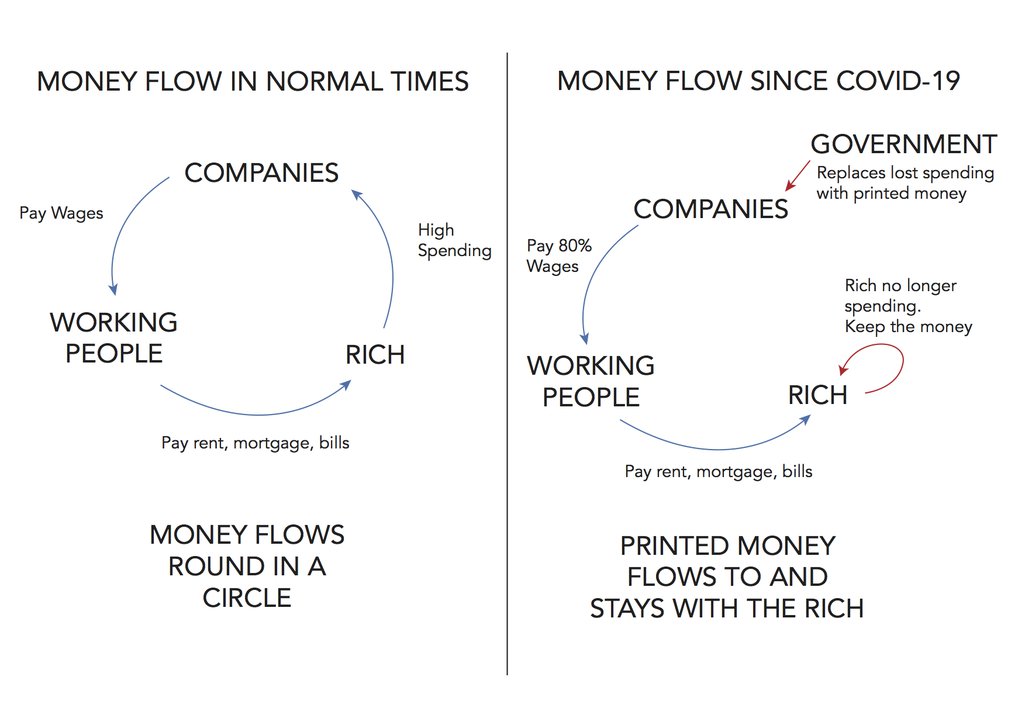
Stvari mogu da se prilično zabrljaju kada vlada uskoči da preuzme “kontrolu” nad potrošnjom štampanog novca. Izvor: OpenDemocracy
Bitcoin-ov sistem eliminiše moć lobista i prednosti poznavanja pravog bankara, i stavlja ljude na mnogo ravnopravnije temelje. U Bitcoin-u, svaki ‘rudar’ na mreži ima jednake šanse da zaradi nagradu za novostvorene bitcoin-e na svakih 10 minuta. Svako može da postane rudar, jednostavnim kupovanjem hardvera i njegovim uključivanjem u utičnicu – daleko manje mukotrpan posao od lobiranja kod izabranih predstavnika da bi vam dodelili ugovor sa vladom. Rudari troše puno novca na električnu energiju i opremu da bi se takmičili za nagradu, a Bitcoin sistemu pružaju preko potrebnu uslugu: bezbednost. Bez rudara, Bitcoin-ov sistem ne bi funkcionisao.
:max_bytes(150000):strip_icc()/GettyImages-929584582-9d7790de3ee44f658a9580cc598c641f.jpg)
Rudarenje bitcoin-a zahteva računar i struju – to je to.
U sistemu američkog dolara vidimo da političke veze proističu iz Cantillonovog Efekta. U Bitcoin sistemu vidimo da se pružaoci usluga (rudari) plaćaju za svoje usluge novostvorenim bitcoin-ima.
Naravno, ishodi Cantillonovog Efekta bi mogli da se promene tako što će političari da promene način na koji novi novac ulazi u sistem. Međutim, ovo ne rešava osnovni problem: neko drugi ima korist na tuđi račun.
Bitcoin sistem je daleko pravedniji jer koristi Cantillonov Efekat da bi uredno nagradio one koji pružaju korisnu uslugu za sve ostale: obezbeđivanje Bitcoin mreže.
Zamislite to ovako: u dolarskom sistemu, neka osoba šarmira političare ili bankare na pravim pozicijama da bi dobila povlašćen tretman na račun svih ostalih. U Bitcoin sistemu svi plaćaju po malo, da bi zaštitili svoje bankovne račune od krađe.
Uloga Vlade u Cantillonovom Efektu
Federalne vlade širom sveta su jedne od najvećih korisnika Cantillonovog Efekta, jer su u mogućnosti da vrlo lako dobiju zajmove od centralne banke svoje države. U SAD se to radi kada američko Ministarstvo finansija proda državne obveznice banci Federalnih rezervi. Federalne rezerve daju Ministarstvu finansija gomilu novoštampanog novca, a Ministarstvo finansija da Fed-u papir na kojem piše „mi ćemo vam isplatiti dug u to i to vreme sa određenom kamatom“. Možda je malo složenije od ovoga, ali to opisuje suštinu toga.
Budući da novac koji federalna vlada dobija nije postojao pre toga, ona može da ga potroši pre nego što cene počnu da rastu zbog tog novog novca koji ulazi u opticaj. To omogućava federalnoj vladi da ga troši na socijalne programe, policiju, vojsku, vojnu opremu za naoružavanje država poput Saudijske Arabije, čak i na ‘most iz nigde ka ničemu’, a da ne mora da koristi politički nepopularnu metodu: da poveća porez da bi to platila.
Umesto da povećaju poreske prihode za pokrivanje ove potrošnje, federalne vlade koriste Cantillonov Efekat za prenos kupovne moći od plata radnika srednje klase u vladin trezor. Na taj način inflacija i Cantillonov Efekat stvaraju skriveni porez na zarade i uštede novca.
Zaštitite Sebe od Cantillonovog Efekta
Zaštita svog života od Cantillonovog Efekta je zeznuta igra koju treba odigrati. Možete da pokušate da se približite izvoru novog novca, tako što ćete se nadmetati za državne ugovore ili raditi u vrhovima finansija. Možete da pokušate da igrate na visokim nivoima u trgovanju na berzi ili ulaganju u nekretnine, ali je verovatnije da ćete bankrotirati nego što ćete da se zaštitite.
Najlakši način da zaštitite sebe od nepravedne raspodele novog novca je potpuno odbijanje tog monetarnog sistema. Samo najstarije generacije koje danas žive mogu da se sete vremena kada je novac značio nešto drugo osim papira potkrepljenog ‘punom verom i kredibilitetom’ vlade i vojske. Mi smo tako uslovljeni da novac smatramo proizvodom naše vlade, ali naša zaštita od Cantillonovog Efekta zahteva gledanje novca kroz istoriju – čak i pre samo jednog veka.
Novac je nekada značio zlato – materijal koji nijedna vlada ne može magično da stvori u većoj količini, a koji zahteva ogroman napor da se pronađe i iskopa iz zemlje. Bitcoin je vrlo sličan zlatu po tome što niko ne može magično da ga stvori, i veoma ga je teško proizvesti više ‘rudarenjem’. Međutim, Bitcoin takođe putuje brzinom interneta, omogućavajući globalnu trgovinu na način na koji zlato jednostavno ne može.

Bitcoin i zlato – slični po karakteristikama ‘normalnog novca’, različiti po prenosivosti.
Da biste se zaštitili od Cantillonovog Efekta, potrebno je što je više moguće isključiti se iz nepravednih sistema tradicionalnih valuta, čuvajući bogatstvo u pravom novcu, poput zlata ili Bitcoin-a. Ovo je najmirniji način za ukidanje starog sistema i uvođenje novog, pravednijeg sistema.
Kako mogu da saznam više o Bitcoin-u?
Film "Bitkoin: Kraj novca kakvog poznajemo"
The Bitcoin Whitepaper ← objavljen 2008. godine, ovo je izložio dizajn za Bitcoin.
Ako vam se sviđa moj rad, molim vas da ga podelite sa svojim prijateljima i porodicom. Cilj mi je da svima pružim uvid u ekonomiju i kako ona utiče na njihove živote.
-
 @ cae03c48:2a7d6671
2025-05-28 23:01:49
@ cae03c48:2a7d6671
2025-05-28 23:01:49Bitcoin Magazine

JD Vance Says “Bitcoin Finally Has a Champion in the White House”In a headline speech at the Bitcoin 2025 Conference today, U.S. Vice President JD Vance declared Bitcoin’s growing role in national policy and promised a new era of federal support under the Trump administration. “It’s great to be here with Bitcoin at $108k and to be the Vice President of the United States,” Vance opened. “This isn’t a conference of people. This is a movement.”

Thanking David Bailey, and key figures like Cameron and Tyler Winklevoss, Vance emphasized, “They took a big step and everyone else followed.” He also shouted out Coinbase for their participation at the event as well.
In sharp contrast to past administrations, Vance was clear: “What we’ve done in the Trump administration in digital asset policy is only the beginning. Crypto finally has a champion and an ally in the White House.”
JUST IN:
 Vice President JD Vance said they’re going to fire every regulator like Gary Gensler. pic.twitter.com/awHYMEMQAg
Vice President JD Vance said they’re going to fire every regulator like Gary Gensler. pic.twitter.com/awHYMEMQAg— Bitcoin Magazine (@BitcoinMagazine) May 28, 2025
Vance underscored the grassroots energy of the Bitcoin community: “This gets decided by the people, by you—not unelected bureaucrats.”
He laid out three key priorities for the administration, the first being Widespread Adoption – “Fifty million Americans own Bitcoin. I think it’s gonna be 100 million before too long.” The second being Legislative Support– “We are optimistic the Senate will pass the clean GENIUS Act. Stablecoins don’t threaten the U.S. dollar—they’re a force multiplier for the economic mission.” And third, Clear Regulation – “We need a transparent regulatory framework that incorporates Bitcoin into the mainstream economy.”
Referencing broader concerns about institutional overreach, Vance said, “Crypto is a hedge against bad policymaking in Washington.”

Promising protection and partnership from Washington, he vowed, “You deserve respect and support from your government—not bureaucrats trying to tear you down. We are ending the weaponization of federal agencies against this community.”
Vance concluded stating, “Bitcoin is digital gold, but none of you are—unless you get involved,” discussing how Bitcoin is here to stay, but only if the American people get involved and build the industry. “Where Bitcoin is going is strategically important to the U.S. We’re gonna make the right decisions, and that depends on you being a part of the conversation.”
The message that Vance made was abundantly clear. Bitcoin is in the hands of the American people, and it is up to the citizens to make a lasting impact with it.
This post JD Vance Says “Bitcoin Finally Has a Champion in the White House” first appeared on Bitcoin Magazine and is written by Jenna Montgomery.
-
 @ cae03c48:2a7d6671
2025-05-28 23:01:42
@ cae03c48:2a7d6671
2025-05-28 23:01:42Bitcoin Magazine

GameStop CEO Ryan Cohen Announced Acquisition of Over $505 Million BitcoinAt the 2025 Bitcoin Conference in Las Vegas, in an interview with the CEO of Nakamoto David Bailey, the CEO of GameStop Ryan Cohen announced why the company bought over $505 million in Bitcoin.
JUST IN: GameStop $GME CEO explains why the company bought over $505 million #Bitcoin

“Bitcoin can be a hedge against global currency devaluation” pic.twitter.com/jNiId2fntA
— Bitcoin Magazine (@BitcoinMagazine) May 28, 2025
Ryan Cohen started by explaining some things about the GameStop business.
“When I took over, the company was a piece of crap and losing a lot of money and was under a lot of pressure moving from physical gains to digital downloads so you had to cut costs,” stated Cohen. “Very aggressively bringing physical discipline and we did. Retail is a tough business, but it was a big focus on getting cost under control.”
When Bailey asked Cohen how many Bitcoin GameStop owned, Ryan responded, “We currently own 4710 Bitcoin.”
Then Ryan mentioned why they are adding Bitcoin to their balance sheets.
“If the thesis is correct then Bitcoin and gold as well can be a hedge against global currency devaluation and systemic risk,” mentioned Ryan. “Bitcoin has certain unique advantages better than gold.”
He commented on the benefits of Bitcoin compared to gold.
“You can easily secure Bitcoin in a wallet whereas gold requires insurance and it’s very expensive and then there is the scarcity element of this as well,” commented Ryan. “There is a fixed supply of Bitcoin whereas with gold, the supply of gold is still uncertain.“
Ryan finished the announcement by saying, “GameStop is following GameStop Strategy. We are not following anyone else’s.”
This post GameStop CEO Ryan Cohen Announced Acquisition of Over $505 Million Bitcoin first appeared on Bitcoin Magazine and is written by Oscar Zarraga Perez.
-
 @ cae03c48:2a7d6671
2025-05-28 23:01:32
@ cae03c48:2a7d6671
2025-05-28 23:01:32Bitcoin Magazine

Mayor Eric Adams Announced New York City Will Issue a Bit BondAt the 2025 Bitcoin Conference in Las Vegas, the Mayor of New York City Eric Adams announced that New York City will issue a Bit Bond.
Eric Adams started by connecting the American flag to Bitcoin commenting, “just as our flag still flies, Bitcoin is going to continue to fly in our country.” Later on he mentioned, “New York City is going to lead the way. We are going to be the leader because we know the power of innovation and what innovation has to offer.”
BREAKING:
 NYC Mayor Eric Adams plans to issue Bit Bond for New York. #Bitcoin pic.twitter.com/loESV4UJYf
NYC Mayor Eric Adams plans to issue Bit Bond for New York. #Bitcoin pic.twitter.com/loESV4UJYf— Bitcoin Magazine (@BitcoinMagazine) May 28, 2025
“These conferences are crucial and when we held our summit in New York a few weeks ago,” said Adam. “We held it with a clear focus that it is time for you no longer to go through the lawfare that you went through and had to flee our city. New York is the empire state. We don’t break empires, we build empires.”
Adams called back everyone that left New York because of their overregulation of Bitcoin and Crypto.
“Come back home you have a mayor that is the crypto mayor, is the Bitcoin mayor and I want you back in the city of New York,” stated Adam. “Where you won’t be attacked and criminalized. Let’s get rid of the Bitcoin license and allow us to free flow of Bitcoin in our city.”
Then Adam commented, “it’s time for the first time in the history of this city to have a financial instrument that is made for those who are holders of Bitcoin. I believe we need to have a Bit Bond and I am going to push and fight to get a Bit Bond in New York.”
Adams closed his speech by saying, “We are going to use Bitcoin blockchain for our birth certificates. We are going to use Bitcoin to pay off fines and taxes. We are going to allow our young people to understand what it is to be part of this industry, but we need you on the ground.”
This post Mayor Eric Adams Announced New York City Will Issue a Bit Bond first appeared on Bitcoin Magazine and is written by Oscar Zarraga Perez.
-
 @ cae03c48:2a7d6671
2025-05-28 23:01:20
@ cae03c48:2a7d6671
2025-05-28 23:01:20Bitcoin Magazine

Block Announces Bitcoin Business Stack, Makes Historic Lightning Payments Push at Bitcoin 2025Bitcoin isn’t just something to hold anymore—it’s something to live on. That was the core message delivered by Miles Suter, Bitcoin Product Lead at Block Inc., during his keynote at the Bitcoin 2025 Conference today. Standing at the intersection of innovation and ideology, Suter laid out a vision where Bitcoin isn’t just a store of value—but the internet’s native currency.
“Bitcoin is at a crossroads—on one hand it’s never been stronger: a trillion in market cap, millions of holders, and even talk of nation-state adoption,” Suter said. “We use Bitcoin to hold, to hedge, to opt out, but we rarely use it to live. At Block Inc., we believe that has to change.”
Suter officially announced that Block is rolling out Bitcoin payment capability for merchants using Square POS, allowing them to accept bitcoin directly in-store. The move comes as part of a broader initiative Block calls the full bitcoin for business stack—covering acquiring, managing, reporting, accounting, converting, lending, and taxes.

“This is what makes Bitcoin an everyday currency for everyone,” he emphasized. “We believe hard-working entrepreneurs deserve access to the full power of bitcoin.”
To prove the vision in action, Block helped power a Guinness World Record attempt for the most Lightning payments in a day, hosted live at the conference. The goal: prove that Lightning payments aren’t just functional—they’re scalable, fast, and real.
Block’s commitment isn’t new. In 2020, the company put bitcoin on its balance sheet. In 2021, it co-founded the Bitcoin Clean Energy Initiative to fight the “boiling oceans” narrative. In 2022, Cash App became one of the first major platforms on Lightning. In 2023, it launched on-chain payments with Square. And in 2024, it helped defeat Craig Wright in court, “standing up for Satoshi.”
“These aren’t just headlines—they’re a pattern,” Suter said. “We’ve made it more accessible, more secure. Now we’re focused on making it usable every day.”
Cash App already ranks among the top bitcoin on-ramps in the U.S., accounting for nearly 10% of on-chain block space at any time. In 2024, Lightning usage grew 7x. “Block runs one of the top Lightning nodes globally. And here’s what’s wild—it’s working,” he said.
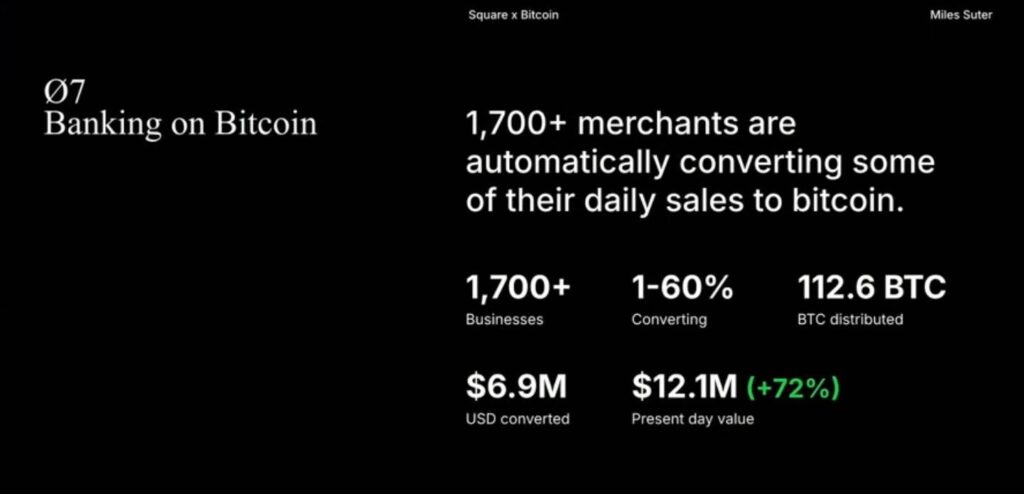
Block is now taking 10% of all profits from Bitcoin and adding it back to its balance sheet, and over 1,700 merchants are automatically converting part of their daily sales to Bitcoin.
“If Bitcoin just becomes digital gold, we failed the mission,” Suter said. “Bitcoin payments validate Bitcoin. They make it real. Bitcoin is money.”
This post Block Announces Bitcoin Business Stack, Makes Historic Lightning Payments Push at Bitcoin 2025 first appeared on Bitcoin Magazine and is written by Jenna Montgomery.
-
 @ cae03c48:2a7d6671
2025-05-28 23:01:10
@ cae03c48:2a7d6671
2025-05-28 23:01:10Bitcoin Magazine

Adam Back Presents Blockstream’s Bitcoin-First Infrastructure Vision at Bitcoin 2025Adam Back, Co-founder and CEO of Blockstream, took the stage at the Bitcoin 2025 Conference with a clear message: Bitcoin is becoming the foundation of global finance—and Blockstream is building the infrastructure to support it.
“So I think Bitcoin is still early,” Back began, “but more mainstream players are starting to become involved. It is starting to become the foundation of global finance.” From El Salvador’s President becoming “patient zero” to institutional adoption spreading rapidly, Back emphasized that “people in all layers of company management and politics have become orange-pilled.”
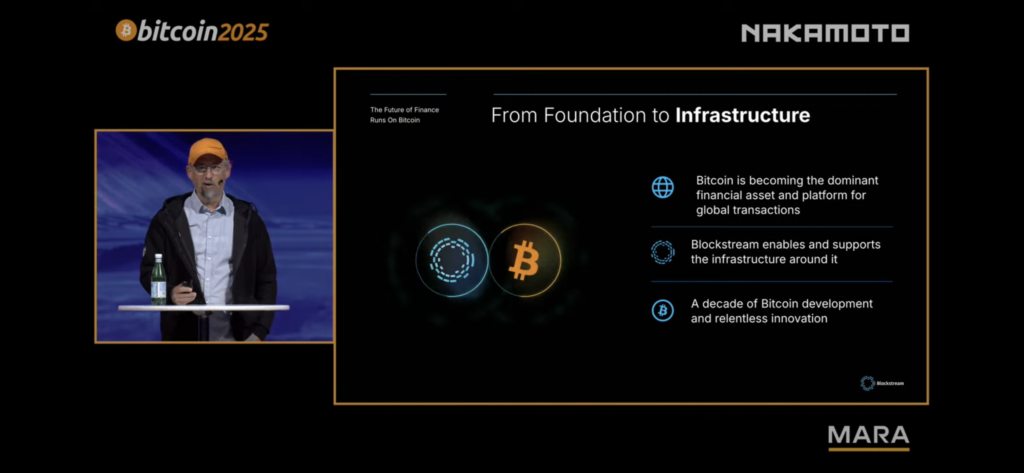
Citing Bitcoin’s accelerating growth trajectory, Back referenced Hal Finney’s prediction that Bitcoin’s addressable market could hit $200 trillion. “Today, we are a lot closer to that situation,” he noted. He alluded again that this is just the beginning for Bitcoin.
To meet that growing demand, Back announced Blockstream’s plan to support the journey from 100 million to 1 billion users by simplifying self-custody and Bitcoin-native asset management. “We’re laser-focused on Bitcoin,” he said. “At Blockstream, we are here to provide the infrastructure to enable that.”
In a detailed presentation, Back outlined five core pillars powering Blockstream’s strategy:
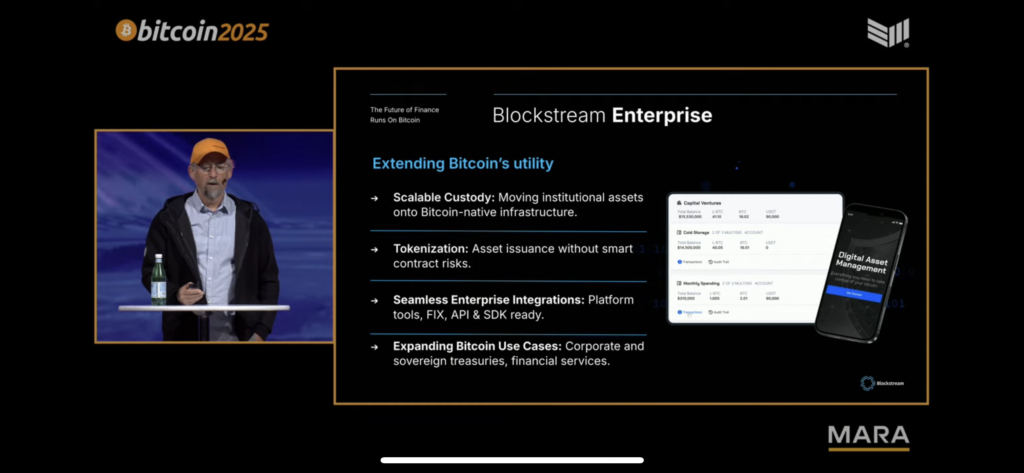
-
Infrastructure Expansion: “Bitcoin is becoming the dominant financial asset and platform for global transactions. Blockstream enables and supports the infrastructure around it.”
-
Unified Platform: Blockstream is developing one platform built for the Bitcoin economy—including consumer products (secure self-custody), enterprise solutions (asset transfer on Bitcoin rails), and institutional integration (custody for large-scale investment).
-
The Blockstream App: Designed to streamline self-custody, the app simplifies onboarding, supports BTC, LBTC, and USDT, and offers advanced features for experienced users.
-
Enterprise Tools: With custody, tokenization without smart contract risks, and SDK/API-ready infrastructure, Blockstream is pushing enterprise-grade Bitcoin use cases—from corporate finance to treasuries.
-
Security and Ecosystem Design: “Secure, proven, and built to last,” Back said, referring to Blockstream’s Bitcoin-first architecture. “Security is our cornerstone, and every product connects at every layer.”
In closing, Back reaffirmed his long-term vision: “The future of finance runs on Bitcoin.”
This post Adam Back Presents Blockstream’s Bitcoin-First Infrastructure Vision at Bitcoin 2025 first appeared on Bitcoin Magazine and is written by Jenna Montgomery.
-
-
 @ cae03c48:2a7d6671
2025-05-28 23:01:00
@ cae03c48:2a7d6671
2025-05-28 23:01:00Bitcoin Magazine
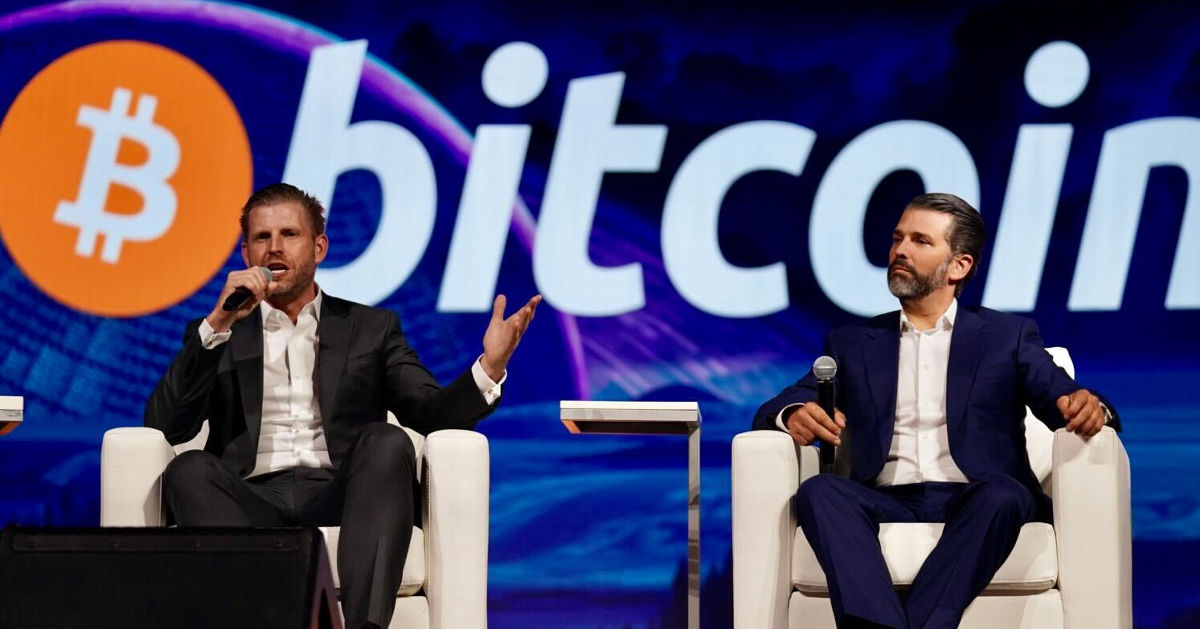
Eric Trump Said Everybody Wants Bitcoin. Everybody is Buying BitcoinAt the 2025 Bitcoin Conference in Las Vegas, the Executive Chairman & Board Member of American Bitcoin Mike Ho, the CEO of American Bitcoin Matt Prusak, the founder of Altcoin Daily Aaron Arnold, Donald Trump Jr. and Eric Trump discussed the future of Bitcoin and their views.
Eric Trump started the panel by saying, “we are bringing Bitcoin to America and America is going to win the crypto revolution.”
Donald continued by mentioning the $2.5 billion bitcoin treasury.
“All the announcement yesterday, True Social and TMTG committing $2.5 billion to a bitcoin treasury,” stated Trump Jr. “Then the trifecta of crypto you have is what we are doing with the world liberty and USD1 from a DeFi platform. We are very long crypto.”
Eric talked about how all the world wants Bitcoin and that most companies are having problems when buying Bitcoin because there is a lot of demand and not as much supply.
“Everybody wants Bitcoin. Everybody is buying Bitcoin,” Eric stated.JUST IN:
 Eric Trump says "everyone in the world wants #Bitcoin, everybody is buying Bitcoin"
Eric Trump says "everyone in the world wants #Bitcoin, everybody is buying Bitcoin" "0.1 BTC is going to be worth an absolute fortune"
 pic.twitter.com/0942a3dSWI
pic.twitter.com/0942a3dSWI— Bitcoin Magazine (@BitcoinMagazine) May 28, 2025
“The whole system is broken and now all of the sudden you have crypto which solves all the problems,” commented Eric. “It makes everything cheaper, it makes everything faster, it makes it safer, it makes it more transparent. It makes the whole system more functional.“
Mike Ho explained his view of the volatility of Bitcoin and how it benefits everybody.
“We see Bitcoin mining as just the foundational layer of being able to accumulate more creative Bitcoin for our shareholders at a discount to what the market can buy Bitcoin for,” commented Ho. “Then there is a value in the volatility of the stock. Usually volatility carries a negative connotation, but in here it’s the volatility that allows us to raise very low cost converts to even accelerate accumulation of Bitcoin.”
Matt Prusak mentioned how they are stacking sats and accumulating as much Bitcoin as they can.
“We are looking for ways to accumulate as much Bitcoin as fast as possible,” said Prusak. “We are stacking sats for our mining operations. We are going to stack sats for the accumulation.”
They all made predictions of Bitcoin’s end price of this year, Eric said $170,000, Trump Jr between $150,000 and $175,000 and Mike Ho over $200,000. Eric finalized with, “the next 10 years are going to be absolutely parabolical.”
This post Eric Trump Said Everybody Wants Bitcoin. Everybody is Buying Bitcoin first appeared on Bitcoin Magazine and is written by Oscar Zarraga Perez.
-
 @ 7f6db517:a4931eda
2025-05-28 22:02:26
@ 7f6db517:a4931eda
2025-05-28 22:02:26
The former seems to have found solid product market fit. Expect significant volume, adoption, and usage going forward.
The latter's future remains to be seen. Dependence on Tor, which has had massive reliability issues, and lack of strong privacy guarantees put it at risk.
— ODELL (@ODELL) October 27, 2022
The Basics
- Lightning is a protocol that enables cheap and fast native bitcoin transactions.
- At the core of the protocol is the ability for bitcoin users to create a payment channel with another user.
- These payment channels enable users to make many bitcoin transactions between each other with only two on-chain bitcoin transactions: the channel open transaction and the channel close transaction.
- Essentially lightning is a protocol for interoperable batched bitcoin transactions.
- It is expected that on chain bitcoin transaction fees will increase with adoption and the ability to easily batch transactions will save users significant money.
- As these lightning transactions are processed, liquidity flows from one side of a channel to the other side, on chain transactions are signed by both parties but not broadcasted to update this balance.
- Lightning is designed to be trust minimized, either party in a payment channel can close the channel at any time and their bitcoin will be settled on chain without trusting the other party.
There is no 'Lightning Network'
- Many people refer to the aggregate of all lightning channels as 'The Lightning Network' but this is a false premise.
- There are many lightning channels between many different users and funds can flow across interconnected channels as long as there is a route through peers.
- If a lightning transaction requires multiple hops it will flow through multiple interconnected channels, adjusting the balance of all channels along the route, and paying lightning transaction fees that are set by each node on the route.
Example: You have a channel with Bob. Bob has a channel with Charlie. You can pay Charlie through your channel with Bob and Bob's channel with User C.
- As a result, it is not guaranteed that every lightning user can pay every other lightning user, they must have a route of interconnected channels between sender and receiver.
Lightning in Practice
- Lightning has already found product market fit and usage as an interconnected payment protocol between large professional custodians.
- They are able to easily manage channels and liquidity between each other without trust using this interoperable protocol.
- Lightning payments between large custodians are fast and easy. End users do not have to run their own node or manage their channels and liquidity. These payments rarely fail due to professional management of custodial nodes.
- The tradeoff is one inherent to custodians and other trusted third parties. Custodial wallets can steal funds and compromise user privacy.
Sovereign Lightning
- Trusted third parties are security holes.
- Users must run their own node and manage their own channels in order to use lightning without trusting a third party. This remains the single largest friction point for sovereign lightning usage: the mental burden of actively running a lightning node and associated liquidity management.
- Bitcoin development prioritizes node accessibility so cost to self host your own node is low but if a node is run at home or office, Tor or a VPN is recommended to mask your IP address: otherwise it is visible to the entire network and represents a privacy risk.
- This privacy risk is heightened due to the potential for certain governments to go after sovereign lightning users and compel them to shutdown their nodes. If their IP Address is exposed they are easier to target.
- Fortunately the tools to run and manage nodes continue to get easier but it is important to understand that this will always be a friction point when compared to custodial services.
The Potential Fracture of Lightning
- Any lightning user can choose which users are allowed to open channels with them.
- One potential is that professional custodians only peer with other professional custodians.
- We already see nodes like those run by CashApp only have channels open with other regulated counterparties. This could be due to performance goals, liability reduction, or regulatory pressure.
- Fortunately some of their peers are connected to non-regulated parties so payments to and from sovereign lightning users are still successfully processed by CashApp but this may not always be the case going forward.
Summary
- Many people refer to the aggregate of all lightning channels as 'The Lightning Network' but this is a false premise. There is no singular 'Lightning Network' but rather many payment channels between distinct peers, some connected with each other and some not.
- Lightning as an interoperable payment protocol between professional custodians seems to have found solid product market fit. Expect significant volume, adoption, and usage going forward.
- Lightning as a robust sovereign payment protocol has yet to be battle tested. Heavy reliance on Tor, which has had massive reliability issues, the friction of active liquidity management, significant on chain fee burden for small amounts, interactivity constraints on mobile, and lack of strong privacy guarantees put it at risk.
If you have never used lightning before, use this guide to get started on your phone.
If you found this post helpful support my work with bitcoin.

-
 @ bf47c19e:c3d2573b
2025-05-28 20:37:58
@ bf47c19e:c3d2573b
2025-05-28 20:37:58Bitcoin: Peer-to-peer sistem elektronskog novca
Satoshi Nakamoto
satoshin@gmx.com
Prevedeno na srpski sa bitcoin.org/bitcoin.pdf od strane ECD
Sažetak. Potpuna peer-to-peer verzija elektronskog novca omogućila bi slanje uplata putem interneta direktno od jedne strane ka drugoj bez posredovanja finansijskih institucija. Digitalni potpisi pružaju deo rešenja, ali se glavni benefiti gube ako je i dalje potrebna pouzdana treća strana za sprečavanje dvostruke potrošnje. Predlažemo rešenje problema dvostruke potrošnje korišćenjem peer-to-peer mreže. Mreža vremenski označava transakcije tako što ih hešuje u tekući lanac dokaza o radu (proof of work) temeljen na hešu, formirajući zapis koji se ne može promeniti bez ponovnog rada i objavljivanja dokaza o tom radu. Najduži lanac ne služi samo kao dokaz niza događaja, nego i kao dokaz da je taj niz događaja potvrđen od strane dela peer-to-peer mreže koja poseduju najveću zbirnu procesorsku snagu (CPU). Sve dok većinu procesorske snage kontrolišu čvorovi (nodes) koji ne sarađuju u napadu na mrežu, oni će generisati najduži lanac i nadmašiti napadače. Sama mreža zahteva minimalnu strukturu. Poruke kroz mrežu se prenose uz pretpostavku da svaki čvor čini maksimalan napor da poruku prenese u svom izvornom obliku i na optimalan način, a čvorovi mogu napustiti mrežu i ponovo joj se pridružiti po želji, prihvatajući najduži lanac dokaza o radu kao dokaz onoga što se dogodilo dok ih nije bilo.
1. Uvod
Trgovina na Internetu počela je da se oslanja skoro isključivo na finansijske institucije koje služe kao pouzdani posrednici pri obradi elektronskih plaćanja. Iako sistem radi dovoljno dobro za većinu transakcija i dalje trpi od inherentnih slabosti modela utemeljenog na poverenju.
Potpuno nepovratne transakcije zapravo nisu moguće, jer finansijske institucije ne mogu izbeći posredovanje u rešavanju eventualnih sporova. Troškovi posredovanja povećavaju troškove transakcija, ograničavaju minimalnu praktičnu veličinu transakcija i onemogućuju male, povremene transakcije jer postoji velika šteta zbog gubitka mogućnosti da se izvrše nepovratna plaćanja za nepovratne usluge. Uz mogućnost povraćaja transakcije, potreba za poverenjem raste. Trgovci moraju biti oprezni prema svojim kupcima i tražiti im više informacija nego što bi inače bilo neophodno. Određeni procenat prevara prihvaćen je kao neizbežan. Ovi troškovi i nepouzdanost plaćanja mogu se izbeći korišćenjem gotovine, ali ne postoji mehanizam za elektronsko plaćanje bez pouzdane treće strane.
Ono što je potrebno je elektronski sistem plaćanja zasnovan na kriptografskom dokazu umesto na poverenju, koji omogućava da bilo koje dve strane direktno i dobrovoljno međusobno trguju bez potrebe za posrednikom. Transakcije koje su nepovratne bi zaštitile prodavce od prevara, a escrow mehanizmi mogli bi se lako implementirati radi zaštite kupaca. U ovom dokumentu predlažemo rešenje problema dvostruke potrošnje korišćenjem peer-to-peer distribuiranog servera vremenskih oznaka (timestamp) za generisanje računarskog dokaza o hronološkom redosledu transakcija. Sistem je siguran sve dok pošteni čvorovi zajedno kontrolišu više procesorske snage procesora nego bilo koja udružena grupa napadačkih čvorova.
2. Transakcije
Elektronski novčić definišemo kao lanac digitalnih potpisa. Svaki vlasnik prenosi novčić na sledećeg digitalnim potpisivanjem heša prethodne transakcije i javnog ključa sledećeg vlasnika, dodajući ih potom na kraj novčića. Primalac transakcije može da verifikuje potpise, a time i lanac vlasništva.

Problem je naravno u tome što primalac ne može potvrditi da jedan od prethodnih vlasnika nije dva puta poslao isti novčić. Uobičajeno rešenje je uvođenje pouzdanog centralizovanog posrednika, kreatora novčića koji proverava sve transakcije. Nakon svake transakcije, novčić se mora vratiti kreatoru kako bi se izdao novi novčić i veruje se da samo za novčiće izdate direktno od kreatora možemo biti sigurni da nisu dva puta potrošeni. Problem sa ovim rešenjem je što sudbina čitavog novčanog sistema zavisi od kompanije koja kreira novčiće, jer svaka transakcija mora da prođe kroz nju, baš kao što je slučaj sa bankom.
Treba nam način da primalac bude siguran da prethodni vlasnici nisu potpisali nikakve ranije transakcije kojim bi potrošili taj novčić. Za naše potrebe, računamo transakciju koja se prva desila i ne zanimaju nas naredni pokušaji da se isti novčić ponovo pošalje. Jedini način da sa sigurnošću potvrdimo da taj novčić nije prethodno bio poslat je da imamo informacije o svim transakcijama koje su se ikada desile. U modelu baziranom na centalizovan kreatoru, taj kreator je imao informacije o svim transakcijama i odlučivao koja transakcija je prva stigla. Da bismo to postigli bez pouzdanog posrednika, transakcije moraju biti javno objavljene [1] i potreban nam je sistem u kojem učesnici mogu da se dogovore o jedinstvenoj istoriji redosleda kojim su transakcije primljene. Primaocu je potreban dokaz da se u trenutku dešavanja svake od transakcija većina čvorova složila oko toga da je baš ta transakcija bila ona koja je prva primljena.
3. Server vremenskih oznaka
Rešenje koje predlažemo počinje serverom vremenskih oznaka. Server vremenske oznake radi tako što uzima heš bloka podataka kojem će se dodeliti vremenska oznaka i objavi taj heš svima u mreži, slično kao u novinama ili kao post na Usenet mreži [2-5]. Vremenska oznaka očigledno dokazuje da su podaci morali postojati u to vreme kako bi ušli u haš. Svaka vremenska oznaka sadrži prethodnu vremensku oznaku u svom hešu, formirajući tako lanac, pri čemu svaka dodatna vremenska oznaka pojačava potvrde onih pre nje.

4. Dokaz o radu (Proof-of-Work)
Da bismo implementirali distribuirani server vremenskih oznaka na peer-to-peer principu, moraćemo da koristimo sistem dokaza o radu sličan Hashcash-u Adama Back-a [6], umesto Uneset postova ili novinskih objava. Dokaz o radu uključuje traženje vrednosti koja će, kada se hešuje, na primer pomoću SHA-256 heš funkcije, stvarati heš čiji binarni zapis započinje određenim brojem nula. Prosečna količina potrebnog rada eksponencijalno raste sa brojem potrebnih početnih nula, a može se proveriti izvršavanjem samo jedne heš fuknkcije.
Za našu mrežu vremenskih oznaka implementiramo dokaz o radu povećavajući nonce broja u bloku sve dok se ne pronađe ona vrednost nonce-a koja daje hešu bloka potreban broj početnih nula. Jednom kada se procesorska snaga utroši kako bi se zadovoljio dokaz o radu, blok se ne može izmeniti bez ponovljenog rada. Kako se kasniji blokovi vežu na taj blok, rad potreban da se on izmeni uključivao bi i ponovno obrađivanje svih blokova nakon njega.

Dokaz o radu takođe rešava problem utvrđivanja većine pri odlučivanju. Ako bi se većina zasnivala na principu jednog glasa po IP adresi, mogao bi je narušiti svako ko je u stanju da glasa sa više IP adresa odjednom. Dokaz o radu u osnovi predstavlja jedan glas po jedinici procesorske snage. Većinska odluka je predstavljena najdužim lancem u čije je stvaranje zapravo investirano najviše rada prilikom dokazivanja. Ako većinu procesorske snage kontrolišu pošteni čvorovi, pošten lanac će rasti najbrže i nadmašiće sve konkurentske lance. Da bi izmenio neki od prethodnih blokova, napadač bi morao da ponovi dokaz o radu za taj blok i sve blokove nakon njega, a zatim da sustigne i nadmaši količinu rada poštenih čvorova. Kasnije ćemo pokazati da se dodavanjem novih blokova eksponencijalno smanjuje verovatnoća da će sporiji napadač uspeti da sustigne pošteni lanac.
Da bi se kompenzovalo povećanje brzine hardvera i promenljivo interesovanje ljudi za vođenje čvorova tokom vremena, težina obavljanja dokaza o radu (proof-of-work difficulty) određuje se prema prosečnom broju blokova krairanih za sat vremena. Ako se blokovi stvaraju prebrzo, težina se povećava.
5. Mreža
Koraci za vođenje mreže su sledeći:
1) Nove transakcije se prosleđuju svim čvorovima u mreži. 2) Svaki čvor prikuplja nove transakcije u blok. 3) Svaki čvor radi na pronalaženju dokaza o radu dovoljnog nivoa težine za svoj blok. 4) Kada čvor pronađe dokaz o radu, on emituje taj blok ka svim čvorovima. 5) Čvorovi prihvataju blok samo ako su sve transakcije u njemu ispravne i nisu već potrošene. 6) Čvorovi izražavaju prihvatanje bloka radeći na stvaranju sledećeg bloka u lancu, koristeći heš prihvaćenog bloka kao prethodni heš.
Čvorovi uvek smatraju da je najduži lanac ispravan i nastaviće da rade na njegovom produžavanju. Ako dva čvora istovremeno emituju različite verzije sledećeg bloka, neki čvorovi prvo mogu primiti jedan ili drugi blok. U tom slučaju svaki čvor radi na prvom koji je dobio, ali čuvaju drugu kariku lanca u slučaju da ona postane duža. Dilema će biti rešena kada se pronađe sledeći dokaz o radu i jedna karika postane duža; čvorovi koji su radili na drugoj karici lanca će se prebaciti na dužu kariku.
Emitovanje novih transakcija ne mora nužno doći do svih čvorova. Sve dok stižu do velikog broja čvorova, te transakcije će ući u blok. Slično važi i za blokove, ni oni ne moraju doći odmah do svih čvorova. Ako neki čvor propusti da primi informaciju o bloku, kada mu stigne sledeći blok,primetiće da je propustio jedan, pa će ga tražiti naknadno.
6. Podsticaj
Po pravilu, prva transakcija u bloku je posebna transakcija koja kreira novi novčić u vlasništvu kreatora bloka. Ovo daje podsticaj čvorovima da podrže mrežu i pruža način za početnu ubacivanje novčića u opticaj, budući da ne postoji centralno telo koje ih izdaje. Stalno dodavanje konstantne količine novih novčića liči na rudarenje zlata, gde rudari ulažu resurse kako bi izrudarili nove količine zlata i ubacili ih u opticaj. U našem slučaju ulaže se procesorsko vreme i električna energija.
Podsticaj se takođe može finansirati i transakcionim naknadama. Ako je iznos izlaznog dela transakcije manji od ulaznog, razliku čini naknada za transakciju koja se dodaje iznosu nagrade za kreatora bloka koji sadrži tu transakciju. Nakon što predefinisani broj novčića uđe u opticaj, podsticaj mogu u potpunosti činiti transakcione naknade, čime se sistem oslobađa inflacije.
Čvorovi su na ovaj način podstaknuti da ostanu pošteni. Ako je pohlepni napadač u stanju da angažuje više procesorske snage od svih poštenih čvorova zajedno, morao bi da bira između toga da poništi svoje izvršene transakcije i time prevari ljude ili da procesorsku snagu koristi za stvaranje novih novčića. On bi trebalo bi uvidi da je isplativije igrati po pravilima koja ga nagrađuju sa više novih novčića od svi drugi zajedno, nego da potkopava sistem i vrednost sopstvenog bogatstva.
7. Oslobađanje prostora na hard disku
Kada je dovoljno blokova dodato nakon poslednje transakcije novčića, prethodne transakcije tog novčića se mogu odbaciti kako bi se uštedeo prostor na hard disku. Kako bi se to ostvarilo bez razbijanja heša bloka, transakcije su hešovane u Merkleovo stablo (Merkle Tree) [7] [2] [5], gde je samo koren uključen u heš bloka. Stari blokovi se tada mogu sabiti uklanjanjem nepotrebnih grana drveta. Unutrašnji heševi ne moraju biti skladišteni.

Zaglavlje bloka bez transakcija bilo bi oko 80 bajtova. Ako pretpostavimo da su blokovi generisani svakih 10 minuta, 80 bajtova * 6 * 24 * 365 = 4,2 MB godišnje. Imajući u vidu činjenicu da se u 2008. godini računari uglavnom prodaju sa oko 2 GB RAM-a i Murov zakon koji predviđa trenutni rast od 1,2 GB godišnje, skladištenje ne bi trebalo da predstavlja problem čak i ako se zaglavlja bloka moraju čuvati u memoriji.
8. Pojednostavljena verifikacija plaćanja
Moguće je verifikovati plaćanja bez vođenja čitavog mrežnog čvora. Korisnik samo treba da sačuva kopiju zaglavlja blokova najdužeg lanca dokaza o radu, do koje može doći upitom ka mrežnim čvorovima dok se ne uveri da je dobio najduži lanac i dobije Merkleova granu
koja povezuje transakciju sa blokom u koji je uneta vremenska oznaka za tu transakciju. Ne može samostalno proveriti transakciju, ali povezujući je sa mestom u lancu može videti da je prihvaćena od strane čvora mreže i da su na njen blok dodati naknadni blokovi što dalje potvrđuje da ju je mreža prihvatila.

Kao takva, verifikacija je pouzdana sve dok pošteni čvorovi kontrolišu mrežu, ali je ranjiva ako napadač nadjača ostatak mreže. Čvorovi mreže mogu sami proveriti transakcije, ali napadačeve lažne transakcije mogu zavarati one koji koriste pojednostavljenu metodu verifikacije transakcija sve dok je on u stanju da nadjačava ostatak mreže. Jedna od strategija zaštite bila bi prihvatanje upozorenja čvorova mreže kada otkriju nevažeći blok, pri čemu bi korisnikov softver morao da preuzme ceo blok i sporne transakcije kako bi potvrdio nepravilnost. Biznisi koji primaju česte uplate će verovatno želeti da pokrenu i vode sopstvene čvorove radi brže verifikacije i potrebe da im sigurnost ne zavisi od drugih.
9. Kombinovanje i deljenje vrednosti
Iako bi bilo moguće pojedinačno rukovati novčićima, bilo bi nezgrapno kreirati zasebnu transakciju za svaki cent u toj transferu. Da biste dozvolili podelu i kombinovanje vrednosti, transakcije sadrže više ulaza i izlaza. Obično će postojati ili jedan ulaz iz veće prethodne transakcije ili više unosa koji kombinuju manje iznose, a najviše dva izlaza: jedan za samo plaćanje, a jedan koji vraća kusur, ako ga ima, nazad pošiljaocu.

Treba napomenuti da situacija u kojoj transakcija zavisi od nekoliko drugih transakcija, a te transakcije zavise od još mnogo više, ovde nije problem. Nikada ne postoji potreba za izdvajanjem istorije pojedinačne transakcije.
10. Privatnost
Tradicionalni bankarski model postiže odgovarajući nivo privatnosti ograničavanjem pristupa informacijama na strane uključene u transakciju i posrednika. Neophodnost javnog objavljivanja svih transakcija isključuje mogućnost primene pomenutog modela, ali privatnost se i dalje može zadržati na drugi način: čuvanjem javnih ključeva (public keys) anonimnim. Javnost može videti da neko šalje iznos nekom drugom, ali bez informacija koje povezuju transakciju sa bilo kim. Ovo je slično količini informacija koje objavljuju berze, gde se vreme i veličina pojedinačnih trgovina čine javnim, ali bez navođenja ko su stranke uključene u tu trgovinu.

Kao dodatni zaštitni zid, preporučljivo je koristiti novi par ključeva za svaku transakciju, kako ne bi bili povezane sa zajedničkim vlasnikom. Neka povezivanja su i dalje neizbežna kod transakcija sa više ulaza, koje nužno otkrivaju da su njihovi ulazi bili u vlasništvu istog vlasnika. Rizik je taj da bi se otkrivanjem vlasnik ključa mogle otkriti i ostale transakcije koje su pripadale tom vlasniku.
11. Proračuni
Razmatramo scenario u kome napadač pokušava da generiše alternativni lanac brže od poštenog lanca. Čak i ako se to postigne, to ne omogućuje proizvoljne promene u sistemu, poput stvaranje vrednosti ni iz čega ili uzimanje novca koji nikada nije pripadao napadaču. Pošteni čvorovi neće prihvatiti nevažeće transakcije kao uplatu i nikada neće prihvatiti blok koji ih sadrži. Napadač može samo pokušati da promeni jednu od svojih transakcija kako bi vratio novac koji je nedavno potrošio.
Trka između poštenog lanca i lanca napadača može se predstaviti kao binomska distribucija slučajne diskretne varijable (Binomial Random Walk). Uspešni ishod je da se pošten lanac produži za jedan blok, povećavajući svoje vođstvo za +1, a neuspešni ishod je da se napadačev lanac produži za jedan blok, smanjujući zaostatak za -1.
Verovatnoću da napadač nadoknadi određeni deficit možemo izraziti kroz problem kockareve propasti (Gambler’s Ruin Problem). Pretpostavimo da kockar sa neograničenim iznosom novca počinje sa zaostatkom i igra potencijalno beskonačan broj ponovljenih igara u pokušaju da nadoknadi zaostatak. Možemo izračunati verovatnoću za nadoknađivanje zaostatka ili da će napadač stići pošten lanac, na sledeći način [8]:
p= verovatnoća da pošten čvor pronađe sledeći blok q= verovatnoća da napadač pronađe sledeći blok qz= verovatnoća da će napadač ikada dostići z blokova zaostatka

S obzirom na našu pretpostavku da je p > q, verovatnoća pada eksponencijalno kako se povećava broj blokova koje napadač mora da nadoknadi. Sa šansama protiv njega, ako mu se u početku ne posreći, njegove šanse postaju manje i manje sa povećanjem zaostatka.
Sada razmatramo koliko primalac nove transakcije treba da čeka pre nego što postane
dovoljno siguran da pošiljalac ne može promeniti transakciju. Pretpostavljamo da je pošiljalac napadač koji želi da natera primaoca da veruje da mu je platio, a zatim nakon nekog vremena tu transakciju preusmeri ka sebi. Primalac će primetiti kada se to dogodi, ali pošiljalac se nada da će tad već biti prekasno.
Primalac generiše novi par ključeva i daje javni ključ pošiljaocu neposredno pre potpisivanja transakcije. Ovo sprečava pošiljaoca da unapred pripremi lanac blokova radeći na njemu neprekidno dok mu se ne posreći da stekne dovoljnu prednost i u tom trenutku izvrši transakciju. Kada se transakcija pošalje, nepošteni pošiljalac počinje tajno da radi na paralelnom lancu koji sadrži alternativnu verziju njegove transakcije.
Primalac čeka dok transakcija ne bude dodata u blok, i dok z blokova nije dodato nakon tog bloka. On ne zna tačno koliko je napadač napredovao, ali pod pretpostavkom da su pošteni blokovi kreirani očekivanom dinamikom, potencijalni napredak napadača će biti prikazan kao Poasonova distribucija sa očekivanom vrednošću:

Kako bismo izračunali verovatnoću da napadač ipak može da nadoknadi zaostatak, množimo gustinu verovatnoće za svaki nivo napretka koji je mogao da ostvari sa verovatnoćom da od tog trenutka može da potpuno nadoknadi zaostatak:

Preuređujemo formulu kako bismo izbegli sabiranje beskonačnog broja sabiraka zbog repa distribucije:

I konvertujemo u programski kod u programskom jeziku C…

Kroz par primera, vidimo da verovatnoća opada eksponencijalno sa porastom z.

Rešavanje za P < 0.1%…

12. Zaključak
Predložili smo sistem za elektronske transakcije bez oslanjanja na poverenje. Počeli smo sa uobičajenim šablonom i novčićima nastalim iz digitalnih potpisa, koji pruža snažnu kontrolu nad vlasništvom, ali je nepotpun bez načina da se spreči dvostruka potrošnja. Kako bismo ovo rešili, predložili smo peer-to-peer mrežu koja koristi dokaz o radu za čuvanje javne istorije transakcija čija izmena napadačima brzo postaje računski nepraktična ako pošteni čvorovi kontrolišu većinu procesorske snage. Mreža je robusna u svojoj nestrukturiranoj jednostavnosti. Svi čvorovi rade istovremeno uz malo koordinacije. Ne treba ih identifikovati, jer se poruke ne usmeravaju na jedno određeno mesto nego samo trebaju biti prenete uz maksimalan napor od strane čvorova da se taj prenos odradi na predviđen način. Čvorovi mogu da napuste i ponovo se pridruže mreži po želji, prihvatajući lanac dokaza o radu kao dokaz onoga što se dogodilo dok ih nije bilo. Oni glasaju svojom procesorskom snagom, izražavajući svoje prihvatanje validnih blokova time što pokušavaju da ih nadgrade novim blokovima i odbacuju nevažeće blokove odbijanjem ih nadgrađuju. Sva potrebna pravila i podsticaji mogu se nametnuti ovim mehanizmom postizanja konsenzusa.
Reference:
[1] W. Dai, „b-money,“ weidai.com/bmoney.txt, 1998.
[2] H. Massias, X.S. Avila, and J.-J. Quisquater, „Design of a secure timestamping service with minimal trust requirements,“ In 20th Symposium on Information Theory in the Benelux, May 1999.
[3] S. Haber, W.S. Stornetta, „How to time-stamp a digital document,“ In Journal of Cryptology, vol 3, no 2, pages 99-111, 1991.
[4] D. Bayer, S. Haber, W.S. Stornetta, „Improving the efficiency and reliability of digital time-stamping,“ In Sequences II: Methods in Communication, Security and Computer Science, pages 329-334, 1993.
[5] S. Haber, W.S. Stornetta, „Secure names for bit-strings,“ In Proceedings of the 4th ACM Conference on Computer and Communications Security, pages 28-35, April 1997.
[6] A. Back, „Hashcash – a denial of service counter-measure,“ hashcash.org/papers/hashcash.pdf, 2002.
[7] R.C. Merkle, „Protocols for public key cryptosystems,“ In Proc. 1980 Symposium on Security and Privacy, IEEE Computer Society, pages 122-133, April 1980.
[8] W. Feller, „An introduction to probability theory and its applications,“ 1957.
-
 @ dfa02707:41ca50e3
2025-05-28 22:02:16
@ dfa02707:41ca50e3
2025-05-28 22:02:16- This version introduces the Soroban P2P network, enabling Dojo to relay transactions to the Bitcoin network and share others' transactions to break the heuristic linking relaying nodes to transaction creators.
- Additionally, Dojo admins can now manage API keys in DMT with labels, status, and expiration, ideal for community Dojo providers like Dojobay. New API endpoints, including "/services" exposing Explorer, Soroban, and Indexer, have been added to aid wallet developers.
- Other maintenance updates include Bitcoin Core, Tor, Fulcrum, Node.js, plus an updated ban-knots script to disconnect inbound Knots nodes.
"I want to thank all the contributors. This again shows the power of true Free Software. I also want to thank everyone who donated to help Dojo development going. I truly appreciate it," said Still Dojo Coder.
What's new
- Soroban P2P network. For MyDojo (Docker setup) users, Soroban will be automatically installed as part of their Dojo. This integration allows Dojo to utilize the Soroban P2P network for various upcoming features and applications.
- PandoTx. PandoTx serves as a transaction transport layer. When your wallet sends a transaction to Dojo, it is relayed to a random Soroban node, which then forwards it to the Bitcoin network. It also enables your Soroban node to receive and relay transactions from others to the Bitcoin network and is designed to disrupt the assumption that a node relaying a transaction is closely linked to the person who initiated it.
- Pushing transactions through Soroban can be deactivated by setting
NODE_PANDOTX_PUSH=offindocker-node.conf. - Processing incoming transactions from Soroban network can be deactivated by setting
NODE_PANDOTX_PROCESS=offindocker-node.conf.
- Pushing transactions through Soroban can be deactivated by setting
- API key management has been introduced to address the growing number of people offering their Dojos to the community. Dojo admins can now access a new API management tab in their DMT, where they can create unlimited API keys, assign labels for easy identification, and set expiration dates for each key. This allows admins to avoid sharing their main API key and instead distribute specific keys to selected parties.
- New API endpoints. Several new API endpoints have been added to help API consumers develop features on Dojo more efficiently:
- New:
/latest-block- returns data about latest block/txout/:txid/:index- returns unspent output data/support/services- returns info about services that Dojo exposes
- Updated:
/tx/:txid- endpoint has been updated to return raw transaction with parameter?rawHex=1
- The new
/support/servicesendpoint replaces the deprecatedexplorerfield in the Dojo pairing payload. Although still present, API consumers should use this endpoint for explorer and other pairing data.
- New:
Other changes
- Updated ban script to disconnect inbound Knots nodes.
- Updated Fulcrum to v1.12.0.
- Regenerate Fulcrum certificate if expired.
- Check if transaction already exists in pushTx.
- Bump BTC-RPC Explorer.
- Bump Tor to v0.4.8.16, bump Snowflake.
- Updated Bitcoin Core to v29.0.
- Removed unnecessary middleware.
- Fixed DB update mechanism, added api_keys table.
- Add an option to use blocksdir config for bitcoin blocks directory.
- Removed deprecated configuration.
- Updated Node.js dependencies.
- Reconfigured container dependencies.
- Fix Snowflake git URL.
- Fix log path for testnet4.
- Use prebuilt addrindexrs binaries.
- Add instructions to migrate blockchain/fulcrum.
- Added pull policies.


Learn how to set up and use your own Bitcoin privacy node with Dojo here.
-
 @ eb0157af:77ab6c55
2025-05-28 22:02:03
@ eb0157af:77ab6c55
2025-05-28 22:02:03Jack Dorsey’s company is bringing bitcoin payments to the retail market through the Lightning Network.
Block — the firm led by Dorsey that owns Square and Bitkey — has officially announced the integration of bitcoin payments into the Square platform, with a full rollout planned for 2026 for all eligible merchants.
Today: we’re accepting bitcoin payments at @TheBitcoinConf

Soon: you can accept bitcoin payments wherever you are
Details here: https://t.co/ko2S9hFpih pic.twitter.com/IYlYV6XM2S
— Square (@Square) May 27, 2025
At the Bitcoin Conference 2025 in Las Vegas, attendees had the chance to preview satoshi payments via Square at BTC Inc.’s merchandise store.
The technology relies on the Lightning Network, the second-layer infrastructure enabling instant, low-cost bitcoin transactions. This approach will allow merchants to accept satoshi payments through their existing Square hardware.
The implementation plan includes an initial launch in the second half of 2025, pending necessary regulatory approvals. The initiative represents a key pillar in the company’s strategy to make bitcoin more accessible for everyday transactions.
Miles Suter, Bitcoin Product Lead at Block, stated:
“Block has long been a champion of bitcoin, focused on making it more accessible and usable in our everyday lives. Rolling out a native bitcoin experience to millions of sellers brings us one step closer to that goal. When a coffee shop or retail store can accept bitcoin through Square, small businesses get paid faster, and get to keep more of their revenue.”
The announcement follows Dorsey’s statement last month confirming that Block was working to integrate BTC as a payment option for both Bitkey and Square.
Alongside the announcement, Block also revealed that Bitkey will introduce new privacy and security features in May, including a legacy recovery option available to all users.
The post Jack Dorsey’s Block to integrate Bitcoin payments into Square appeared first on Atlas21.
-
 @ eb0157af:77ab6c55
2025-05-28 22:02:02
@ eb0157af:77ab6c55
2025-05-28 22:02:02The Wall Street financial institution has signed strategic agreements for bitcoin-backed loans with Maple Finance and FalconX.
According to Bloomberg, on May 27 Cantor Fitzgerald officially launched its new division dedicated to Bitcoin lending, announcing the completion of the first transactions of its Bitcoin Financing Business. The Wall Street firm confirmed it has finalized a first round of deals with two crypto sector players: Maple Finance and FalconX.
The company initially plans to make up to $2 billion in financing available to institutional clients.
Brandon Lutnick, President of Cantor Fitzgerald, commented:
“From the start, Cantor recognized the transformative impact that financial services for digital assets would have on the global economy. This milestone highlights how the combination of Cantor’s deep expertise and entrepreneurial spirit creates a distinctive advantage on Wall Street.”
The partnership with Maple Finance is part of Cantor’s broader expansion strategy. Sidney Powell, Co-Founder and CEO of Maple Finance, emphasized how the deal will expand his company’s ability to serve clients looking to access the digital asset market:
“We’re seeing strong and growing demand from institutions seeking to enter the crypto market through trusted and regulated channels.”
Josh Barkhordar, Head of U.S. Sales at FalconX, stated:
“Digital assets have lacked the institutional-grade credit infrastructure essential for healthy capital markets. This collaboration between Cantor and a crypto-native firm is a meaningful step toward building that framework.”
To ensure the security and reliability of its bitcoin-backed financing services, Cantor Fitzgerald has selected Anchorage Digital and Copper.co for custody solutions.
The post Cantor Fitzgerald launches first bitcoin-backed loans appeared first on Atlas21.
-
 @ eb0157af:77ab6c55
2025-05-28 22:02:01
@ eb0157af:77ab6c55
2025-05-28 22:02:01Block’s hardware wallet sparks debate between security and borderline compromises.
The debate ignited after Jack Dorsey publicly supported the superiority of “seedless” wallets over traditional solutions on X.
seedless is safer https://t.co/MvjmFcQE8k
— jack (@jack) May 27, 2025
The Twitter co-founder and Block CEO sustained this by promoting Bitkey, a company that completely eliminates seed phrases, aiming to simplify the user experience and improve security through different recovery options.
The Bitkey model
Bitkey represents a different solution compared to the traditional approach to bitcoin custody. Instead of relying on a single seed phrase, the system implements a 2-of-3 multisig scheme that distributes security across three distinct keys:
- Hardware key: protected by biometric fingerprint on the physical device;
- Mobile key: stored in the smartphone app;
- Server key: managed by Block’s servers.
Any transaction requires two of the three signatures, eliminating the single point of failure represented by traditional seed phrases, the company claims. In its official documents, Bitkey explains how this approach, according to the company, offers three different recovery paths: phone loss, hardware loss, or loss of both through “Trusted Contacts,” pre-set trusted people who can help the user regain wallet access without being able to see the balance or control the private keys.
The seed phrase criticism
For the Bitkey team, the seed phrase paradoxically represents the weakest link in the Bitcoin security chain. While private keys are “exceptionally secure” within the hardware – “designed for security, isolated from networks, physically reinforced” – the seed phrase is “plain text, readable, physically vulnerable,” the company states.
Bitkey developers argue that the industry has “offloaded the most complex part of the security model onto individuals least equipped to handle it.”
System limits and dependencies
However, Bitkey’s simplicity comes at a price. The system introduces a dependency on Block for optimal multisig functionality. Although users always maintain the ability to move funds using the two keys in their possession, recovery procedures and many advanced features require collaboration from the company’s servers.
This architecture presents limitations in terms of flexibility: users cannot use Bitkey with other mobile applications, cannot import the wallet into alternative solutions, and do not have direct access to seed phrases for traditional backup operations.
One of the most frequent criticisms concerns the absence of a screen on the hardware device. Unlike traditional hardware wallets that allow direct verification of destination addresses and transaction amounts on the device display, Bitkey forces users to rely exclusively on the mobile app for these details. This design choice introduces what critics define as a “blind signing risk”: if the mobile app were compromised by malware, users could unknowingly authorize altered transactions without the possibility of independent verification.
Community criticism
Dorsey’s post sparked contrasting reactions in the community. The most orthodox bitcoiners mainly contest two aspects:
- third-party dependency: despite Bitkey maintaining the “self-custody” label, the need to rely on Block’s servers for many operations contradicts the autonomy principles that many bitcoiners consider fundamental;
- loss of technical control: the inability to directly manage the seed phrase or use the device in customized multisig configurations limits the user’s technical sovereignty.
Some users have criticized Block’s hardware wallet. User bamskki highlighted how “the lack of a screen forces users to rely on the app for transaction details. Unlike traditional hardware wallets with screens, Bitkey users cannot verify transactions independently. Users must trust the app as the source of truth.”
Even more critical was user nakadai_mon, who ironized about Dorsey’s strategy writing: “It would be a shame if I influenced you to abandon the seed and locked you into my ecosystem so I can surveil you, sell and share your personal data with government authorities and deny you service.”
Dorsey responded directly to both criticisms. To bamskki he replied:
it's a start, not our end. we will iterate the product like everything else.
— jack (@jack) May 28, 2025
More articulated was his response to nakadai_mon:
we are working on much of the privacy aspects (launching soon). and you don't have to use our 3rd key. that's where some of the restrictions come in. working to figure out how to allow folks to create their own trusted 3rd party as well. but all of this is designed to get people…
— jack (@jack) May 28, 2025
However, privacy concerns are not unfounded. Bitkey’s own documentation clarifies that “because we maintain this key, we are able to identify transaction data on the blockchain related to your Bitkey” and that “this information is collected when you transfer bitcoin to or from your Bitkey.”
Additionally, Block declares using automated decision-making systems, without direct staff involvement, to manage some activities that have legal effects on users. Among these, the application of sanctions restrictions: the system is programmed to automatically prevent the purchase and use of Bitkey by people or countries subject to international sanctions. Finally, the privacy policy specifies that users’ personal data can be shared with law enforcement, government agencies, officials, or authorized third parties in the presence of a warrant, court order, or other legal obligation. Block reserves the right to disclose this information whenever it deems necessary to comply with regulations, legal proceedings, or government requests.
Hardware security and compromises
From a hardware security perspective, Bitkey implements advanced protections including unique device identifiers, secure boot, and anti-tamper technologies. In case the device were compromised, an attacker would still need to access a second key to steal funds.
According to Dorsey’s statements, Bitkey represents an attempt to make self-custody accessible to a broader audience. The company’s roadmap promises improvements in terms of privacy, security, and usability.
The post Bitkey controversy: Dorsey’s marketing divides the community appeared first on Atlas21.
-
 @ eb0157af:77ab6c55
2025-05-28 22:02:00
@ eb0157af:77ab6c55
2025-05-28 22:02:00An analysis of the present and a look at the future of Bitcoin mining, between data, critical reflections and a personal vision on the role of this industry.
Before jumping on bitcoin and proposing it to their clientele as an investment instrument, traditional finance started with a more classic approach, beginning to purchase shares of mining companies and thus exposing themselves indirectly to the asset. Bitcoin mining today is a real industry, also composed of large players listed on the stock exchange that have received huge capital from investment funds like BlackRock. Furthermore, more and more mining companies are taking the path of listing on stock markets to manage to attract capital and some of these also manage pools, like Marathon. How was all this possible and what are the implications of this situation?
Mining pools
Mining pools aggregate the computing power of multiple miners to increase the chances of mining a block. They create the block template and use the collective hashrate to try to solve it. The reward is then divided among participants in proportion to the power provided.
Today pools use different methods to pay miners who provide computing power. One of these is called FPPS (Fully Pay Per Share), which offers a fixed and constant payment to the miner (which varies based on the computing power provided), regardless of whether the pool mines a block or not. This type of payment makes the revenues of a company that mines bitcoin calculable and constant and which, consequently, becomes more appealing to the market because it’s possible to calculate its ROI (Return On Investment). In essence, with this type of payment, uncertainty is excluded and returns are made predictable. Mining pools take on the risk because, in case they fail to mine blocks for a certain period of time, they could go into loss having to pay miners anyway. We can therefore venture that mining pools have helped the entry of traditional finance into bitcoin mining, taking on part of the risks. But this is my thought.
Mining today
Mining pools today are not that many and we have a strong concentration of miners in some of them. If we sum the hashrate of Foundry and AntPool we exceed 50% of global computing power. This is not an optimal condition. Now however let’s also look at the other side of the coin. First of all, although mining pools have great power, they cannot play with fire and must be very transparent about their operations towards miners, because miners can direct their hashrate towards another pool very quickly. And this is a fundamental element that also recalls game theory a bit, because a mining pool must not only serve its own interest, but also the interest of its “partners”, otherwise it loses everything. I believe that mining pools are well aware of their power and also know that they are a centralization point for the network and, today, also a point of attack by authorities, so they have every interest in finding solutions that allow them to continue doing business, but that relieve them somewhat of responsibilities.
On the miner side instead, we have increasingly large companies that collect enormous capital and produce a lot of hashrate, but my fear is that this hashrate is produced by a fiat economy and is very precarious. Hashrate is closely linked to price, because if the price drops below a certain threshold, miners are no longer profitable and are forced to turn off the machines, or, in the worst cases, to completely cease activity, consequently causing hashrate to collapse. Fortunately Bitcoin has mechanisms like difficulty adjustment that mitigate these situations. Being still a very small market, the entry of large institutional players first in mining companies and then directly on the underlying asset, could lead to strong price oscillations that also impact mining farms. All this makes hashrate very unstable too.
Something is changing
The development of Stratum V2 has started an attempt to solve the various problems that afflict pooled mining. Stratum is the communication protocol between mining farms and mining pools. Version 2 brings, in addition to data improvement and encryption, performance increases and gives each individual miner the possibility to create the template of the block to mine. Furthermore we also have other existing solutions that try to solve the problems described before in a somewhat different way, like Ocean pool, which has implemented its DATUM protocol (similar to Stratum V2) and which uses a miner payment method called TIDES, that is an evolution of FPPS and non-custodial PPLNS in which miner addresses are inserted directly into the coinbase transaction.
There’s also a lot of ferment on the miner side, for example with the advent of Bitaxe, an open source project that we can define almost as a movement, an ideology. Skot, the precursor of this movement, has essentially reverse engineered the professional machinery used to mine bitcoin and managed to create a “desktop” device that contains a real ASIC chip, consumes only a few watts and can be built at home. Obviously these products produce computing power not sufficient to try to be competitive, but they are bringing back solo mining and are giving enthusiasts the possibility to deepen this sector by exploiting a device of very small dimensions and with practically negligible consumption on the bill.
The future of mining
After analyzing the state we are in, we can start speculations and let our minds travel.
Let’s start with mining pools. Will they still exist? I would say yes, in what form I don’t know, but I think they will certainly lose the control they have today over block template creation and I also think that future solutions will be found (in addition to existing ones) to become non-custodial and directly remunerate miners. In the end it’s in their interest to always be competitive in terms of services offered, because they work on commission, so they have to be appealing.
As for miners instead, I see a bigger metamorphosis. If the intention is to consume eco-sustainable energy, then energy industries will necessarily have to start studying the benefits that mining can bring in this sense. They cannot continue to ignore them. And if this happens, then I imagine a future where energy companies themselves will start mining bitcoin and will no longer do so following market logic, but will shift focus to stabilizing the electrical grid. Mining is currently the only industry capable of being so flexible as to be able to absorb all the excess energy of a plant, but at the same time consume zero when energy is needed by the grid. At that point the raw mining activity could become no longer the main business, but a secondary benefit that will allow them to have alternative income compared to selling electricity.
And what about the Bitaxe movement? Hard to say, but in my opinion if it manages to reach a critical mass of enthusiasts, it could really start to emerge and become a fundamental piece for the “true bitcoiner” kit. Utopistically, if we had 50 or 100 million Bitaxes scattered in people’s homes, we would manage to distribute mining in a more widespread way, but above all we would have a part of the total hashrate totally uncorrelated from bitcoin price, because, given their very reduced consumption, Bitaxes would remain on and continue to produce hashrate regardless of energy cost or price oscillations of the underlying asset.
What will happen, then, after 2140, when no more bitcoins will be mined? Assuming that network fees will be much higher than today, and sufficient to keep the activity profitable, we could find ourselves in a situation where mining for pure profit will be downsized. The same companies, however, could become external service providers for grid balancing, or, as mentioned previously, become electricity producers themselves of renewable energy exploiting their experience in mining to push where today it’s not economically convenient. Even in our homes we could have a boiler, a heat pump or a water heating system for the pool that, while doing its job, also mines bitcoin. In short, a future that seems like a fairy tale, but so possible that we want to live it and make sure that my children are also protagonists of it.
The post The future of mining? Green and decentralized appeared first on Atlas21.
-
 @ b1ddb4d7:471244e7
2025-05-28 22:01:39
@ b1ddb4d7:471244e7
2025-05-28 22:01:39In the heart of East Africa, where M-Pesa reigns supreme and innovation pulses through bustling markets, a quiet revolution is brewing—one that could redefine how millions interact with money.
Enter Bitika, the Kenyan startup turning bitcoin’s complexity into a three-step dance, merging the lightning speed of sats with the trusted rhythm of mobile money.
At the helm is a founder whose “aha” moment came not in a boardroom, but at his kitchen table, watching his father grapple with the gap between understanding bitcoin and actually using it.
Bitika was born from that friction—a bridge between M-Pesa’s ubiquity and bitcoin’s borderless promise, wrapped in a name as playful as the Swahili slang that inspired it.
But this isn’t just a story about simplifying transactions. It’s about liquidity battles, regulatory tightropes, and a vision to turn Bitika into the invisible rails powering Africa’s Bitcoin future.
Building on Bitcoin
- Tell us a bit about yourself and how you got into bitcoin/fintech, and what keeps you passionate about this space?
I first came across bitcoin in 2020, but like many at that time, I didn’t fully grasp what it really was. It sounded too complicated, probably with the heavy terminologies. Over time, I kept digging deeper and became more curious.
I started digging into finance and how money works and realised this was what I needed to understand bitcoin’s objectives. I realized that bitcoin wasn’t just a new type of money—it was a breakthrough in how we think about freedom, ownership, and global finance.
What keeps me passionate is how bitcoin can empower people—especially in Africa—to take control of their wealth, without relying on unstable systems or middlemen.
- What pivotal moment or experience inspired you to create Bitika? Was there a specific gap in Kenya’s financial ecosystem that sparked the idea?
Yes, this idea was actually born right in my own home. I’ve always been an advocate for bitcoin, sharing it with friends, family, and even strangers. My dad and I had countless conversations about it. Eventually, he understood the concept. But when he asked, “How do I even buy bitcoin?” or “Can you just buy it for me?” and after taking him through binance—that hit me.
If someone I’d educated still found the buying process difficult, how many others were feeling the same way? That was the lightbulb moment. I saw a clear gap: the process of buying bitcoin was too technical for the average Kenyan. That’s the problem Bitika set out to solve.
- How did you identify the synergy between bitcoin and M-Pesa as a solution for accessibility?
M-Pesa is at the center of daily life in Kenya. Everyone uses it—from buying groceries to paying rent. Instead of forcing people to learn new tools, I decided to meet them where they already are. That synergy between M-Pesa and bitcoin felt natural. It’s about bridging what people already trust with something powerful and new.
- Share the story behind the name “Bitika” – does it hold a cultural or symbolic meaning?
Funny enough, Bitika isn’t a deeply planned name. It came while I was thinking about bitcoin and the type of transformation it brings to individuals. In Swahili, we often add “-ka” to words for flair—like “bambika” from “bamba.”
So, I just coined Bitika as a playful and catchy way to reflect something bitcoin-related, but also uniquely local. I stuck with it because thinking of an ideal brand name is the toughest challenge for me.
- Walk us through the user journey – how does buying bitcoin via M-Pesa in “3 simple steps” work under the hood?
It’s beautifully simple.
1. The user enters the amount they want to spend in KES—starting from as little as 50 KES (about $0.30).
2. They input their Lightning wallet address.
3. They enter their M-Pesa number, which triggers an STK push (payment prompt) on their phone. Once confirmed—pap!—they receive bitcoin almost instantly.
Under the hood, we fetch the live BTC price, validate wallet addresses, check available liquidity, process the mobile payment, and send sats via the Lightning Network—all streamlined into a smooth experience for the user.
- Who’s Bitika’s primary audience? Are you focusing on unbanked populations, tech enthusiasts, or both?
Both. Bitika is designed for everyday people—especially the unbanked and underbanked who are excluded from traditional finance. But we also attract bitcoiners who just want a faster, easier way to buy sats. What unites them is the desire for a seamless and low-barrier bitcoin experience.

Community and Overcoming Challenges
- What challenges has Bitika faced navigating Kenya’s bitcoin regulations, and how do you build trust with regulators?
Regulation is still evolving here. Parliament has drafted bills, but none have been passed into law yet. We’re currently in a revision phase where policymakers are trying to strike a balance between encouraging innovation and protecting the public.
We focus on transparency and open dialogue—we believe that building trust with regulators starts with showing how bitcoin can serve the public good.
- What was the toughest obstacle in building Bitika, and how did you overcome it?
Liquidity. Since we don’t have deep capital reserves, we often run into situations where we have to pause operations often to manually restock our bitcoin supply. It’s frustrating—for us and for users. We’re working on automating this process and securing funding to maintain consistent liquidity so users can access bitcoin at any time, without disruption.
This remains our most critical issue—and the primary reason we’re seeking support.
- Are you eyeing new African markets? What’s next for Bitika’s product?
Absolutely. The long-term vision is to expand Bitika into other African countries facing similar financial challenges. But first, we want to turn Bitika into a developer-first tool—infrastructure that others can build on. Imagine local apps, savings products, or financial tools built using Bitika’s simple bitcoin rails. That’s where we’re heading.
- What would you tell other African entrepreneurs aiming to disrupt traditional finance?
Disrupting finance sounds exciting—but the reality is messy. People fear what they don’t understand. That’s why simplicity is everything. Build tools that hide the complexity, and focus on making the user’s life easier. Most importantly, stay rooted in local context—solve problems people actually face.
What’s Next?
- What’s your message to Kenyans hesitant to try bitcoin, and to enthusiasts watching Bitika?
To my fellow Kenyans: bitcoin isn’t just an investment—it’s a sovereign tool. It’s money you truly own. Start small, learn, and ask questions.
To the bitcoin community: Bitika is proof that bitcoin is working in Africa. Let’s keep pushing. Let’s build tools that matter.
- How can the bitcoin community, both locally and globally, support Bitika’s mission?
We’re currently fundraising on Geyser. Support—whether it’s financial, technical, or simply sharing our story—goes a long way. Every sat you contribute helps us stay live, grow our liquidity, and continue building a tool that brings bitcoin closer to the everyday person in Africa.
Support here: https://geyser.fund/project/bitika
-
 @ cae03c48:2a7d6671
2025-05-28 22:01:22
@ cae03c48:2a7d6671
2025-05-28 22:01:22Bitcoin Magazine

Leaders Rally Behind BTC at Bitcoin 2025 Conference: Strategic Reserves, Market Clarity, and Legislative MomentumAt Bitcoin 2025, top U.S. lawmakers and Coinbase’s Chief Policy Officer discussed the U.S. government’s shifting tone on Bitcoin, strategic reserves, regulatory frameworks, and legislation—all pointing toward a bullish future for digital assets.
In a panel moderated by Grant McCarty, Co-President of the Bitcoin Policy Institute, the Bitcoin 2025 Conference saw a major spotlight on U.S. policy shifts surrounding digital assets. U.S. Representatives Byron Donalds and Bryan Steil were joined by Faryar Shirzad, Chief Policy Officer at Coinbase, to highlight what they described as a watershed moment for Bitcoin in Washington.
JUST IN:
 US Congressman Byron Donalds says he's voting for the Strategic Bitcoin Reserve Act
US Congressman Byron Donalds says he's voting for the Strategic Bitcoin Reserve Act 
"Bitcoin has proven to be a holder of value" pic.twitter.com/NuQlZ26Lmy
— Bitcoin Magazine (@BitcoinMagazine) May 27, 2025
“What the president and his team are doing is choosing to step into the digital assets marketplace,” said Byron Donalds. “Bitcoin is a key asset because it has demonstrated to be a holder of value outside of fiat currency and central banking.” Donalds emphasized that President Trump is taking the long view—strategically recognizing Bitcoin’s role in a national reserve capacity.
Bryan Steil pointed to Trump’s media magnetism and political leverage as the driver behind recent legislative momentum: “What he’s done is put a spotlight on the exact three bills… giving us the ability to drive forward.” He noted that legislation is difficult to pass, but with executive support, there’s newfound energy and opportunity to cross the finish line.
Shirzad echoed that sentiment: “The tone from the top point is exactly what Donald Trump has showed us… He wants a market structure built. He wants a much more strategic approach.” Coinbase, Shirzad added, sees the impact firsthand—legislators now recognize the need to support innovation rather than stifle it.
Donalds added: “If you talk to any business owner in the world, the number one thing they desire more than anything else is certainty and consistency.” That, he said, is what will turn Bitcoin into a trillion-dollar industry in the U.S., instead of one bogged down by regulatory ambiguity and legal overhead.
On the regulatory front, Steil noted: “Under the Biden administration, policy was being developed through enforcement actions. Bitcoin is decentralized and should be treated as a commodity.” Shirzad agreed, pushing for “regulatory therapy” to unleash billions still sidelined.
McCarty closed with mention of the Blockchain Regulatory Clarity Act—legislation that would protect open-source developers from rogue regulatory action: “It allows developers to operate without being punished.”
Donalds summed it up: “There’s only going to be 21 million ever in creation. That can’t be eroded by central banks. A strategic reserve for Bitcoin is critical in my opinion for the United States.”
This post Leaders Rally Behind BTC at Bitcoin 2025 Conference: Strategic Reserves, Market Clarity, and Legislative Momentum first appeared on Bitcoin Magazine and is written by Jenna Montgomery.
-
 @ 9ca447d2:fbf5a36d
2025-05-28 21:02:17
@ 9ca447d2:fbf5a36d
2025-05-28 21:02:17H100 Group AB, a Swedish publicly listed health technology company, has made the headlines after investing in bitcoin as part of a new financial strategy.
The move has caused a stir in Sweden and beyond, with H100’s stock price rising 40% after the announcement.
The company has bought 4.39 bitcoin for 5 million Norwegian Krone (around $475,000–$492,000).
This is the company’s first foray into the digital asset space and makes H100 Group the first publicly-listed health tech company in Sweden to hold bitcoin as a treasury reserve asset.
The bitcoin was bought at an average price of 1,138,737 NOK (around $108,000) per coin.
The bitcoin purchase is part of H100 Group’s new “Bitcoin Treasury Strategy” to diversify its financial assets and strengthen its balance sheet. Instead of holding idle cash, the company decided to invest in what it sees as a long-term asset.
“This addition to H100’s Bitcoin Treasury Strategy follows an increasing number of tech-oriented growth companies holding bitcoin on their balance sheet,” said CEO Sander Andersen.
“And I believe the values of individual sovereignty highly present in the Bitcoin community aligns well with, and will appeal to, the customers and communities we are building the H100 platform for.”
Andersen said they will “build and hold” bitcoin long-term, viewing it as a savings tool, not a short-term trade.
The market reacted fast. On May 22, the company’s stock went up 39.27%, seeing highs of 1.620 SEK on the Nordic Growth Market.
This helped the company to recover a big part of the losses from the last two months, during which the stock fell 46%.
And now, after the purchase, the firm’s market cap is around $150.46 million.
H100 has said this might not be the only purchase. The company has signed a Letter of Intent (LOI) to set up a convertible loan facility of up to 10 million SEK with an undisclosed investor.
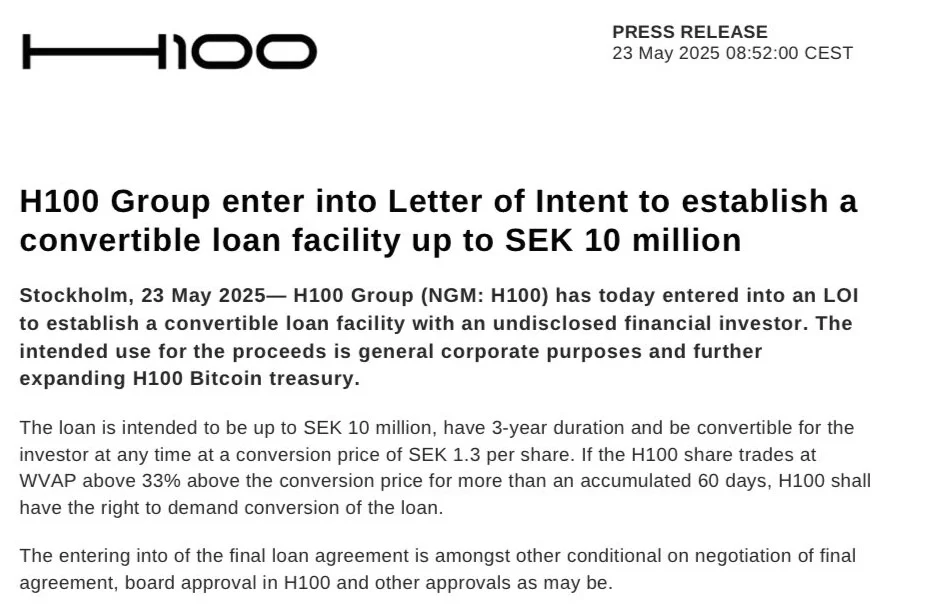
H100 Group’s announcement — Source
The funds will be used for general corporate purposes and to potentially increase bitcoin holdings. The loan will have a 3-year term and can be converted into shares at 1.3 SEK per share.
If H100’s stock price is more than 33% above the conversion price for more than 60 days, H100 will have the right to force conversion.
The company also announced today that it has successfully raised 21 million SEK ($2.21 million) through a convertible round led by Blockstream founder and CEO Adam Back.
Despite the Bitcoin pivot, H100 Group has made it clear that the core business remains the same.
They will continue to develop AI-powered automation tools and digital platforms to help healthcare providers deliver better services, especially in the health and longevity space.
Andersen said they are committed to healthy living, and adopting a bitcoin strategy is a smarter financial move that aligns with their values.
H100’s move comes as corporate adoption of bitcoin accelerates globally.
According to BitcoinTreasuries over 109 public companies now list bitcoin on their balance sheets. Among those are companies like Twenty One Capital, Strive and Metaplanet.
-
 @ b1ddb4d7:471244e7
2025-05-28 21:02:05
@ b1ddb4d7:471244e7
2025-05-28 21:02:05Starting January 1, 2026, the United Kingdom will impose some of the world’s most stringent reporting requirements on cryptocurrency firms.
All platforms operating in or serving UK customers-domestic and foreign alike-must collect and disclose extensive personal and transactional data for every user, including individuals, companies, trusts, and charities.
This regulatory drive marks the UK’s formal adoption of the OECD’s Crypto-Asset Reporting Framework (CARF), a global initiative designed to bring crypto oversight in line with traditional banking and to curb tax evasion in the rapidly expanding digital asset sector.
What Will Be Reported?
Crypto firms must gather and submit the following for each transaction:
- User’s full legal name, home address, and taxpayer identification number
- Detailed data on every trade or transfer: type of cryptocurrency, amount, and nature of the transaction
- Identifying information for corporate, trust, and charitable clients
The obligation extends to all digital asset activities, including crypto-to-crypto and crypto-to-fiat trades, and applies to both UK residents and non-residents using UK-based platforms. The first annual reports covering 2026 activity are due by May 31, 2027.
Enforcement and Penalties
Non-compliance will carry stiff financial penalties, with fines of up to £300 per user account for inaccurate or missing data-a potentially enormous liability for large exchanges. The UK government has urged crypto firms to begin collecting this information immediately to ensure operational readiness.
Regulatory Context and Market Impact
This move is part of a broader UK strategy to position itself as a global fintech hub while clamping down on fraud and illicit finance. UK Chancellor Rachel Reeves has championed these measures, stating, “Britain is open for business – but closed to fraud, abuse, and instability”. The regulatory expansion comes amid a surge in crypto adoption: the UK’s Financial Conduct Authority reported that 12% of UK adults owned crypto in 2024, up from just 4% in 2021.
Enormous Risks for Consumers: Lessons from the Coinbase Data Breach
While the new framework aims to enhance transparency and protect consumers, it also dramatically increases the volume of sensitive personal data held by crypto firms-raising the stakes for cybersecurity.
The risks are underscored by the recent high-profile breach at Coinbase, one of the world’s largest exchanges.
In May 2025, Coinbase disclosed that cybercriminals, aided by bribed offshore contractors, accessed and exfiltrated customer data including names, addresses, government IDs, and partial bank details.
The attackers then used this information for sophisticated phishing campaigns, successfully deceiving some customers into surrendering account credentials and funds.
“While private encryption keys remained secure, sufficient customer information was exposed to enable sophisticated phishing attacks by criminals posing as Coinbase personnel.”
Coinbase now faces up to $400 million in compensation costs and has pledged to reimburse affected users, but the incident highlights the systemic vulnerability created when large troves of personal data are centralized-even if passwords and private keys are not directly compromised. The breach also triggered a notable drop in Coinbase’s share price and prompted a $20 million bounty for information leading to the attackers’ capture.
The Bottom Line
The UK’s forthcoming crypto reporting regime represents a landmark in financial regulation, promising greater transparency and tax compliance. However, as the Coinbase episode demonstrates, the aggregation of sensitive user data at scale poses a significant cybersecurity risk.
As regulators push for more oversight, the challenge will be ensuring that consumer protection does not become a double-edged sword-exposing users to new threats even as it seeks to shield them from old ones.
-
 @ cae03c48:2a7d6671
2025-05-28 21:01:56
@ cae03c48:2a7d6671
2025-05-28 21:01:56Bitcoin Magazine

US Senator Cynthia Lummis Discusses Bitcoin Reserve, Stablecoin Legislation, and Market Structure Bill at Bitcoin 2025 ConferenceAt the 2025 Bitcoin Conference in Las Vegas, U.S Senator Cynthia Lummis and CLO of Coinbase Paul Grewal discussed the market structure bill, stablecoin bill, future taxing system, bitcoin strategy reserve and bitcoin mining.
Cynthia Lummis started by commenting about the market structure bill and stablecoin bill.
“The market structure bills is probably more important to a lot of the people in this conference than the stablecoin bill because there are a lot of businesses, yours among them,” said Lummis. “There are businesses for people who either buy and hold, so they want a custodial service or there are companies that lend Bitcoin, there is a futures market for Bitcoin, there are so many ways in which Bitcoin can interface with fiat currency with the US dollar.”
Lummis also mentioned the tax system that she wants to implement and what her office has submitted to the finance committee.
“As the lighting network develops and companies like Strike sort of have been leaders in that space,” added Lummis. “Create an opportunity for transactions to occur on a daily basis in Bitcoin. Everything from buying a cup of coffee to dinner somewhere. It would be helpful that certain transactions of that size below 600 dollars per transaction, not be subject to taxation.”
During her speech, she went into detail on one the biggest problems lawmakers are facing against digital assets.
“Part of the problem in the last four years has been largely regulatory agencies that have been very hostile towards digital assets, so we are trying to change as fast as we can,” said Lummis. “It doesn’t happen overnight. We don’t even have a confirmed IRS director in place yet, so it is really hard to get these structural changes enacted by the rule makers at the IRS when there is no IRS commission yet in place.”
Ending the panel, Lummis addressed one of the biggest reasons the US government should get into Bitcoin.
“We are 37 trillion dollars in debt, so if we bought and held a million Bitcoin for 20 years it will cut that debt in half and we have underperforming assets that can be converted to Bitcoin without borrowing additional money. Bitcoin is such an important Global Strategic asset and it is not only important in the economy, but in our global defense because there are components to our defense. One is having a lethal war fighting machine that can overcome other armies, another military effort. Another one is having an economic machine that can overcome other currencies.” She continued, “Even our military generals say that bitcoin is an important deterrent to aggression from other countries, especially from China.”
This post US Senator Cynthia Lummis Discusses Bitcoin Reserve, Stablecoin Legislation, and Market Structure Bill at Bitcoin 2025 Conference first appeared on Bitcoin Magazine and is written by Oscar Zarraga Perez.
-
 @ dfa02707:41ca50e3
2025-05-28 20:02:23
@ dfa02707:41ca50e3
2025-05-28 20:02:23Contribute to keep No Bullshit Bitcoin news going.
- Coinswap is a decentralized protocol for private, trustless cryptocurrency swaps. It allows participants to securely swap digital assets without intermediaries, using advanced cryptographic techniques and atomic swaps to ensure privacy and security.
- This release introduces major improvements to the protocol's efficiency, security, and usability, including custom in-memory UTXO indexes, more advanced coin-selection algorithms, fidelity bond management and more.
- The update also improves user experience with full Mac support, faster Tor connections, enhanced UI/UX, a unified API, and improved protocol documentation.
"The Project is under active beta development and open for contributions and beta testing. The Coinswap market place is live in testnet4. Bug fixes and feature requests are very much welcome."
- Manuals and demo docs are available here.
What's new
- Core protocol and performance improvements:
- Custom in-memory UTXO indexes. Frequent Core RPC calls, which caused significant delays, have been eliminated by implementing custom in-memory UTXO indexes. These indexes are also saved to disk, leading to faster wallet synchronization.
- Coin selection. Advanced coin-selection algorithms, like those in Bitcoin Core, have been incorporated, enhancing the efficiency of creating different types of transactions.
- Fidelity management. Maker servers now automate tasks such as checking bond expiries, redemption, and recreation for Fidelity Bonds, reducing the user's management responsibilities.
- Taker liveness. The
WaitingFundingConfirmationmessage has been added to keep swap connections between Takers and Makers, assisting with variable block confirmation delays.
-
User experience and compatibility:
- Mac compatibility. The crate and apps now fully support Mac.
- Tor operations are streamlined for faster, more resilient connections. Tor addresses are now consistently linked to the wallet seed, maintaining the same onion address through system reboots.
- The UI/UX improvements enhance the display of balances, UTXOs, offer data, fidelity bonds, and system logs. These updates make the apps more enjoyable and provide clearer coin swap logs during the swap process.
-
API design improvements. Transaction creation routines have been streamlined to use a single common API, which reduces technical debt and eliminates redundant code.
- Protocol spec documentation now details how Coinswap breaks the transaction graph and improves privacy through routed swaps and amount splitting, and includes diagrams for clarity.

Source: Coinswap Protocol specification.

-
 @ dfa02707:41ca50e3
2025-05-28 20:02:20
@ dfa02707:41ca50e3
2025-05-28 20:02:20Contribute to keep No Bullshit Bitcoin news going.
News
- Spiral welcomes Ben Carman. The developer will work on the LDK server and a new SDK designed to simplify the onboarding process for new self-custodial Bitcoin users.
- Spiral renews support for Dan Gould and Joschisan. The organization has renewed support for Dan Gould, who is developing the Payjoin Dev Kit (PDK), and Joschisan, a Fedimint developer focused on simplifying federations.
- The Bitcoin Dev Kit Foundation announced new corporate members for 2025, including AnchorWatch, CleanSpark, and Proton Foundation. The annual dues from these corporate members fund the small team of open-source developers responsible for maintaining the core BDK libraries and related free and open-source software (FOSS) projects.
- The European Central Bank is pushing for amendments to the European Union's Markets in Crypto Assets legislation (MiCA), just months after its implementation. According to Politico's report on Tuesday, the ECB is concerned that U.S. support for cryptocurrency, particularly stablecoins, could cause economic harm to the 27-nation bloc.
- Slovenia is considering a 25% capital gains tax on Bitcoin profits for individuals. The Ministry of Finance has proposed legislation to impose this tax on gains from cryptocurrency transactions, though exchanging one cryptocurrency for another would remain exempt. At present, individual 'crypto' traders in Slovenia are not taxed.
- The Virtual Asset Service Providers (VASP) Bill 2025 introduced in Kenya. The new legislation aims to establish a comprehensive legal framework for licensing, regulating, and supervising virtual asset service providers (VASPs), with strict penalties for non-compliant entities.
- Circle, BitGo, Coinbase, and Paxos plan to apply for U.S. bank charters or licenses. According to a report in The Wall Street Journal, major crypto companies are planning to apply for U.S. bank charters or licenses. These firms are pursuing limited licenses that would permit them to issue stablecoins, as the U.S. Congress deliberates on legislation mandating licensing for stablecoin issuers.
"Established banks, like Bank of America, are hoping to amend the current drafts of [stablecoin] legislation in such a way that nonbanks are more heavily restricted from issuing stablecoins," people familiar with the matter told The Block.
- Paul Atkins has officially assumed the role of the 34th Chairman of the US Securities and Exchange Commission (SEC). This is a return to the agency for Atkins, who previously served as an SEC Commissioner from 2002 to 2008 under the George W. Bush administration. He has committed to advancing the SEC’s mission of fostering capital formation, safeguarding investors, and ensuring fair and efficient markets.
- Federal Reserve retracts guidance discouraging banks from engaging in 'crypto.' The U.S. Federal Reserve withdrew guidance that discouraged banks from crypto and stablecoin activities, as announced by its Board of Governors on Thursday. This includes rescinding a 2022 supervisory letter requiring prior notification of crypto activities and 2023 stablecoin requirements.
"As a result, the Board will no longer expect banks to provide notification and will instead monitor banks' crypto-asset activities through the normal supervisory process," reads the FED statement.
- Russian government to launch a cryptocurrency exchange. The country's Ministry of Finance and Central Bank announced plans to establish a trading platform for "highly qualified investors" that "will legalize crypto assets and bring crypto operations out of the shadows."
- Twenty One Capital is set to launch with over 42,000 BTC in its treasury. This new Bitcoin-native firm, backed by Tether and SoftBank, is planned to go public via a SPAC merger with Cantor Equity Partners and will be led by Jack Mallers, co-founder and CEO of Strike. According to a report by the Financial Times, the company aims to replicate the model of Michael Saylor with his company, MicroStrategy.
- Strategy increases Bitcoin holdings to 538,200 BTC. In the latest purchase, the company has spent more than $555M to buy 6,556 coins through proceeds of two at-the-market stock offering programs.
- Metaplanet buys another 145 BTC. The Tokyo-listed company has purchased an additional 145 BTC for $13.6 million. Their total bitcoin holdings now stand at 5,000 coins, worth around $428.1 million.
- Semler Scientific has increased its bitcoin holdings to 3,303 BTC. The company acquired an additional 111 BTC at an average price of $90,124. The purchase was funded through proceeds from an at-the-market offering and cash reserves, as stated in a press release.
- Tesla still holds nearly $1 billion in bitcoin. According to the automaker's latest earnings report, the firm reported digital asset holdings worth $951 million as of March 31.
- Spar supermarket experiments with Bitcoin payments in Zug, Switzerland. The store has introduced a new payment method powered by the Lightning Network. The implementation was facilitated by DFX Swiss, a service that supports seamless conversions between bitcoin and legacy currencies.
- Charles Schwab to launch spot Bitcoin trading by 2026. The financial investment firm, managing over $10 trillion in assets, has revealed plans to introduce spot Bitcoin trading for its clients within the next year.
- Arch Labs has secured $13 million to develop "ArchVM" and integrate smart-contract functionality with Bitcoin. The funding round, valuing the company at $200 million, was led by Pantera Capital, as announced on Tuesday.
- Citrea deployed its Clementine Bridge on the Bitcoin testnet. The bridge utilizes the BitVM2 programming language to inherit validity from Bitcoin, allegedly providing "the safest and most trust-minimized way to use BTC in decentralized finance."
- UAE-based Islamic bank ruya launches Shari’ah-compliant bitcoin investing. The bank has become the world’s first Islamic bank to provide direct access to virtual asset investments, including Bitcoin, via its mobile app, per Bitcoin Magazine.
- Solosatoshi.com has sold over 10,000 open-source miners, adding more than 10 PH of hashpower to the Bitcoin network.
"Thank you, Bitaxe community. OSMU developers, your brilliance built this. Supporters, your belief drives us. Customers, your trust powers 10,000+ miners and 10PH globally. Together, we’re decentralizing Bitcoin’s future. Last but certainly not least, thank you@skot9000 for not only creating a freedom tool, but instilling the idea into thousands of people, that Bitcoin mining can be for everyone again," said the firm on X.
- OCEAN's DATUM has found 100 blocks. "Over 65% of OCEAN’s miners are using DATUM, and that number is growing every day. This means block template construction is making its way back into the hands of the miners, which is not only the most profitable
-
 @ bf47c19e:c3d2573b
2025-05-28 19:59:23
@ bf47c19e:c3d2573b
2025-05-28 19:59:23Originalni tekst na dvadesetjedan.com
Autor: Vijay Boyapati / Prevod na hrvatski: Matija
Sa zadnjim cijenama koje je bitcoin dosegao 2017., optimističan scenarij za ulagače se možda čini toliko očitim da ga nije potrebno niti spominjati. Alternativno, možda se nekome čini glupo ulagati u digitalnu vrijednost koja ne počiva na nijednom fizičkom dobru ili vladi i čiji porast cijene su neki usporedili sa manijom tulipana ili dot-com balonom. Nijedno nije točno; optimističan scenarij za Bitcoin je uvjerljiv, ali ne i očit. Postoje značajni rizici kod ulaganja u Bitcoin, no, kao što planiram pokazati, postoji i ogromna prilika.
Geneza
Nikad u povijesti svijeta nije bilo moguće napraviti transfer vrijednosti među fizički udaljenim ljudima bez posrednika, poput banke ili vlade. 2008. godine, anonimni Satoshi Nakamoto je objavio 8 stranica rješenja na dugo nerješivi računalski problem poznat kao “Problem Bizantskog Generala.” Njegovo rješenje i sustav koji je izgradio - Bitcoin - dozvolio je, prvi put ikad, da se vrijednost prenosi brzo i daleko, bez ikakvih posrednika ili povjerenja. Implikacije kreacije Bitcoina su toliko duboke, ekonomski i računalski, da bi Nakamoto trebao biti prva osoba nominirana za Nobelovu nagradu za ekonomiju i Turingovu nagradu.
Za ulagače, važna činjenica izuma Bitcoina (mreže i protokola) je stvaranje novog oskudnog digitalnog dobra - bitcoina (monetarne jedinice). Bitcoini su prenosivi digitalni “novčići” (tokeni), proizvedeni na Bitcoin mreži kroz proces nazvan “rudarenje” (mining). Rudarenje Bitcoina je ugrubo usporedivo sa rudarenjem zlata, uz bitnu razliku da proizvodnja bitcoina prati unaprijed osmišljeni i predvidivi raspored. Samo 21 milijun bitcoina će ikad postojati, i većina (2017., kada je ovaj tekst napisan) su već izrudareni. Svake četiri godine, količina rudarenih bitcoina se prepolovi. Produkcija novih bitcoina će potpuno prestati 2140. godine.
 Stopa inflacije —— Monetarna baza
Stopa inflacije —— Monetarna bazaBitcoine ne podržava nikakva roba ili dobra, niti ih garantira ikakva vlada ili firma, što postavlja očito pitanje za svakog novog bitcoin ulagača: zašto imaju uopće ikakvu vrijednost? Za razliku od dionica, obveznica, nekretnina ili robe poput nafte i žita, bitcoine nije moguće vrednovati koristeći standardne ekonomske analize ili korisnost u proizvodnji drugih dobara. Bitcoini pripadaju sasvim drugoj kategoriji dobara - monetarnih dobara, čija se vrijednost definira kroz tzv. teoriju igara; svaki sudionik na tržištu vrednuje neko dobro, onoliko koliko procjenjuje da će ga drugi sudionici vrednovati. Kako bismo bolje razumjeli ovo svojstvo monetarnih dobara, trebamo istražiti podrijetlo novca.
Podrijetlo novca
U prvim ljudskim društvima, trgovina među grupama se vršila kroz robnu razmjenu. Velika neefikasnost prisutna u robnoj razmjeni je drastično ograničavala količinu i geografski prostor na kojem je bila moguća. Jedan od najvećih problema sa robnom razmjenom je problem dvostruke podudarnosti potražnje. Uzgajivač jabuka možda želi trgovati sa ribarom, ali ako ribar ne želi jabuke u istom trenutku, razmjena se neće dogoditi. Kroz vrijeme, ljudi su razvili želju za čuvanjem određenih predmeta zbog njihove rijetkosti i simbolične vrijednosti (npr. školjke, životinjski zube, kremen). Zaista, kako i Nick Szabo govori u svojem izvrsnom eseju o podrijetlu novca, ljudska želja za sakupljanjem predmeta pružila je izraženu evolucijsku prednost ranom čovjeku nad njegovim najbližim biološkim rivalom, neandertalcem - Homo neanderthalensis.
"Primarna i najbitnija evolucijska funkcija sakupljanja bila je osigurati medij za čuvanje i prenošenje vrijednosti".
Predmeti koje su ljudi sakupljali služili su kao svojevrsni “proto-novac,” tako što su omogućavale trgovinu među antagonističkim plemenima i dozvoljavale bogatsvu da se prenosi na sljedeću generaciju. Trgovina i transfer takvih predmeta bile su rijetke u paleolitskim društvima, te su oni služili više kao “spremište vrijednosti” (store of value) nego kao “medij razmjene” (medium of exchange), što je uloga koju danas igra moderni novac. Szabo objašnjava:
"U usporedbi sa modernim novcem, primitivan novac je imao jako malo “brzinu” - mogao je promijeniti ruke samo nekoliko puta u životu prosječnog čovjeka. Svejedno, trajni i čvrsti sakupljački predmet, što bismo danas nazvali “nasljeđe,” mogao je opstati mnogo generacija, dodajući znatnu vrijednost pri svakom transferu - i zapravo omogućiti transfer uopće".
Rani čovjek suočio se sa bitnom dilemom u teoriji igara, kada je odlučivao koje predmete sakupljati: koje od njih će drugi ljudi željeti? Onaj koji bi to točno predvidio imao bi ogromnu prednost u mogućnosti trgovine i akvizicije bogatsva. Neka američka indijanska plemena, npr. Naraganseti, specijalizirala su se u proizvodnji sakupljačkih dobara koja nisu imala drugu svrhu osim trgovine. Valja spomenuti da što je ranije predviđanje da će neko dobro imati takvu vrijednost, veća je prednost koju će imati onaj koji je posjeduje, zato što ju je moguće nabaviti jeftinije, prije nego postane vrlo tražena roba i njezona vrijednost naraste zajedno sa populacijom. Nadalje, nabava nekog dobra u nadi da će u budućnosti biti korišteno kao spremište vrijednosti, ubrzava upravo tu primjenu. Ova cirkularnost je zapravo povratna veza (feedback loop) koja potiče društva da se rapidno slože oko jednog spremišta vrijednosti. U terminima teorije igara, ovo je znano kao “Nashov ekvilibrij.” Postizanje Nashovog ekvilibrija za neko spremište vrijednosti je veliko postignuće za društvo, pošto ono znatno olakšava trgovinu i podjelu rada, i time omogućava napredak civilizacije.

Tisućljećima, kako su ljudska društva rasla i otvarala trgovinske puteve, različite aplikacije spremišta vrijednosti u individualnim društvima počele su se natjecati međusobno. Trgovci su imali izbor: čuvati svoju zaradu u spremištu vrijednosti vlastite kulture, ili one kulture sa kojom su trgovali, ili mješavini oboje. Benefit štednje u stranom spremištu vrijednosti bila je uvećana sposobnost trgovanja u povezanom stranom društvu. Trgovci koji su štedili u stranom spremištu vrijednosti su također imali dobrih razloga da potiču svoje društvo da ga prihvati, jer bi tako uvećali vrijednost vlastite ušteđevine. Prednosti “uvezene” tehnologije spremanja vrijednosti bile su prisutne ne samo za trgovce, nego i za sama društva. Kada bi se dvije grupe konvergirale u jedinstvenom spremištu vrijednosti, to bi značajno smanjilo cijenu troškova trgovine jednog s drugim, i samim time povećanje bogatstva kroz trgovinu. I zaista, 19. stoljeće bilo je prvi put da je najveći dio svijeta prihvatio jedinstveno spremište vrijednosti - zlato - i u tom periodu vidio najveću eksploziju trgovine u povijesti svijeta. O ovom mirnom periodu, pisao je John Maynard Keynes:
"Kakva nevjerojatna epizoda u ekonomskom napretku čovjeka… za svakog čovjeka iole iznadprosječnog, iz srednje ili više klase, život je nudio obilje, ugodu i mogućnosti, po niskoj cijeni i bez puno problema, više nego monarsima iz prethodnih perioda. Stanovnik Londona mogao je, ispijajući jutarnji čaj iz kreveta, telefonski naručiti razne proizvode iz cijele Zemlje, u količinama koje je želio, i sa dobrim razlogom očekivati njihovu dostavu na svoj kućni prag."
Svojstva dobrog spremišta vrijednosti
Kada se spremišta vrijednosti natječu jedno s drugim, specifična svojstva rade razliku koja daje jednom prednost nad drugim. Premda su mnoga dobra u prošlosti korištena kao spremišta vrijednosti ili kao “proto-novac,” određena svojstva su se pokazala kao posebno važna, i omogućila dobrima sa njima da pobijede. Idealno spremište vrijednosti biti će:
- Trajno: dobro ne smije biti kvarljivo ili lako uništeno. Tako naprimjer, žito nije idealno spremište vrijednosti.
- Prenosivo: dobro mora biti lako transportirati i čuvati, što omogućuje osiguranje protiv gubitka ili krađe i dopušta trgovinu na velike udaljenosti. Tako, krava je lošije spremište vrijednosti od zlatne narukvice.
- Zamjenjivo: jedna jedinica dobra treba biti zamjenjiva sa drugom. Bez zamjenjivosti, problem podudarnosti želja ostaje nerješiv. Time, zlato je bolje od dijamanata, jer su oni nepravilni u obliku i kvaliteti.
- Provjerljivo: dobro mora biti lako i brzo identificirano i testirano za autentičnost. Laka provjera povećava povjerenje u trgovini i vjerojatnost da će razmjena biti dovršena.
- Djeljivo: dobro mora biti lako djeljivo na manje dijelove. Premda je ovo svojstvo bilo manje važno u ranim društvima gdje je trgovina bila rijetka, postalo je važnije sa procvatom trgovine. Količine koje su se mijenjale postale su manje i preciznije.
- Oskudno: Monetarno dobro mora imati “cijenu nemoguću za lažirati,” kao što je rekao Nick Szabo. Drugim riječima, dobro ne smije biti obilno ili lako dostupno kroz proizvodnju. Oskudnost je možda i najvažnije svojstvo spremišta vrijednosti, pošto se izravno vezuje na ljudsku želju da sakupljamo ono što je rijetko. Ona je izvor vrijednosti u spremištu vrijednosti.
- Duge povijesti: što je dulje neko dobro vrijedno za društvo, veća je vjerojatnost da će biti prihvaćeno kao spremište vrijednosti. Dugo postojeće spremište vrijednosti biti će jako teško uklonjeno od strane došljaka, osim u slučaju sile (ratno osvajanje) ili ako je nova tehnologija znatno bolja u ostalim svojstvima.
- Otporno na cenzuru: novije svojstvo, sve više važno u modernom digitalnom svijetu sa sveprisutnim nadzorom, je otpornost na cenzuru. Drugim riječima, koliko je teško da vanjski agent, kao korporacija ili država, spriječi vlasnika dobra da ga čuva i koristi. Dobra koja su otporna na cenzuru su idealna za ljude koji žive u režimima koji prisilno nadziru kapital ili čine neke oblike mirne trgovine protuzakonitima.
Ova tablica ocjenjuje Bitcoin, zlato (gold) i fiat novac (kao što je euro ili dolar) po svojstvima izlistanim gore. Objašnjenje svake ocjene slijedi nakon tablice.

Trajnost:
Zlato je neosporeni kralj trajnosti. Velika većina zlata pronađenog kroz povijest, uključujući ono egipatskih faraona, opstaje i danas i vjerojatno će postojati i za tisuću godina. Zlatnici korišteni u antičko doba imaju značajnu vrijednost i danas. Fiat valute i bitcoini su digitalni zapisi koji ponekad imaju fizički oblik (npr. novčanice). Dakle, njihovu trajnost ne određuju njihova fizička svojstva (moguće je zamijeniti staru i oštećenu novčanicu za novu), nego institucije koje stoje iza njih. U slučaju fiat valuta, mnoge države su nastale i nestale kroz stoljeća, i valute su nestale s njima. Marke iz Weimarske republike danas nemaju vrijednost zato što institucija koja ih je izdavala više ne postoji. Ako je povijest ikakav pokazatelj, ne bi bilo mudro smatrati fiat valute trajnima dugoročno; američki dolar i britanska funta su relativne anomalije u ovom pogledu. Bitcoini, zato što nemaju instituciju koja ih održava, mogu se smatrati trajnima dok god mreža koja ih osigurava postoji. Obzirom da je Bitcoin još uvijek mlada valuta, prerano je za čvrste zaključke o njegovoj trajnosti. No, postoje ohrabrujući znakovi - prominente države su ga pokušavale regulirati, hakeri ga napadali - usprkos tome, mreža nastavlja funkcionirati, pokazujući visok stupanj antifragilnosti.
Prenosivost:
Bitcoini su najprenosivije spremište vrijednosti ikad. Privatni ključevi koji predstavljaju stotine milijuna dolara mogu se spremiti na USB drive i lako ponijeti bilo gdje. Nadalje, jednako velike sume mogu se poslati na drugi kraj svijeta skoro instantno. Fiat valute, zbog svojeg temeljno digitalnog oblika, su također lako prenosive. Ali, regulacije i kontrola kapitala od strane države mogu ugroziti velike prijenose vrijednosti, ili ih usporiti danima. Gotovina se može koristiti kako bi se izbjegle kontrole kapitala, ali onda rastu rizik čuvanja i cijena transporta. Zlato, zbog svojeg fizičkog oblika i velike gustoće, je najmanje prenosivo. Nije čudo da većina zlatnika i poluga nikad ne napuste sefove. Kada se radi prijenos zlata između prodavača i kupca, uglavnom se prenosi samo ugovor o vlasništvu, ne samo fizičko zlato. Prijenos fizičkog zlata na velike udaljenosti je skupo, riskantno i sporo.
Zamjenjivost:
Zlato nam daje standard za zamjenjivost. Kada je rastopljeno, gram zlata je praktički nemoguće razlikovati od bilo kojeg drugog grama, i zlato je oduvijek bilo takvo. S druge strane, fiat valute, su zamjenjive samo onoliko koliko njihova institucija želi da budu. Iako je uglavnom slučaj da je novčanica zamjenjiva za drugu istog iznosa, postoje situacije u kojima su velike novčanice tretirane drukčije od malih. Naprimjer, vlada Indije je, u pokušaju da uništi neoporezivo sivo tržište, potpuno oduzela vrijednost novčanicama od 500 i 1000 rupija. To je uzrokovalo da ljudi manje vrednuju te novčanice u trgovini, što je značilo da više nisu bile zaista zamjenjive za manje novčanice. Bitcoini su zamjenjivi na razini mreže; svaki bitcoin je pri prijenosu tretiran kao svaki drugi. No, zato što je moguće pratiti individualne bitcoine na blockchainu, određeni bitcoin može, u teoriji, postati “prljav” zbog korštenja u ilegalnoj trgovini, te ga trgovci ili mjenjačnice možda neće htjeti prihvatiti. Bez dodatnih poboljšanja oko privatnosti i anonimnosti na razini mrežnog protokola, bitcoine ne možemo smatrati jednako zamjenjivim kao zlato.
Mogućnost provjere:
Praktično gledajući, autentičnost fiat valuta i zlata je prilično lako provjeriti. Svejedno, i usprkos pokušajima da spriječe krivotvorenje novčanica, i dalje postoji potencijal prevare za vlade i njihove građane. Zlato također nije imuno na krivotvorenje. Sofisticirani kriminalci su koristili pozlaćeni tungsten kako bi prevarili kupce zlata. Bitcoine je moguće provjeriti sa matematičkom sigurnošću. Korištenjem kriptografskih potpisa, vlasnik bitcoina može javno demonstrirati da posjeduje bitcoine koje tvrdi da posjeduje.
Djeljivost:
Bitcoine je moguće podijeliti u stotinu milijuna manjih jedinica (zvanih satoshi), i prenositi takve (no, valja uzeti u obzir ekonomičnost prijenosa malih iznosa, zbog cijene osiguravanja mreže - “network fee”). Fiat valute su tipično dovoljno djeljive na jedinice sa vrlo niskom kupovnom moći. Zlato, iako fizički i teoretski djeljivo, postaje teško za korištenje kada se podijeli na dovoljno male količine da bi se moglo koristiti u svakodnevnoj trgovini.
Oskudnost:
Svojstvo koje najjasnije razlikuje Bitcoin od fiat valuta i zlata je njegova unaprijed definirana oskudnost. Od početka, konačna količina bitcoina nikad neće biti veća od 21 milijun. To daje vlasnicima bitcoina jasan i znan uvid u postotak ukupnog vlasništva. Naprimjer, vlasnik 10 bitcoina bi znao da najviše 2,1 milijuna ljudi (manje od 0.03% populacije) može ikad imati isto bitcoina kao i on. Premda je kroz povijest uvijek bilo oskudno, zlato nije imuno na povećanje ukupne količine. Ako se ikad izumi nova, ekonomičnija metoda rudarenja ili proizvodnje zlata, ukupna količina zlata bi se mogla dramatično povećati (npr. rudarenje morskog dna ili asteroida). Na kraju, fiat valute, relativno nov izum u povijesti, pokazale su se sklonima konstantnim povećanjima u količini. Države su pokazale stalnu sklonost inflaciji monetarne kvantitete kako bi rješavale kratkoročne političke probleme. Inflacijske tendencije vlada diljem svijeta čine fiat valute gotovo sigurnim da će gubiti vrijednost kroz vrijeme.
Etablirana povijest:
Nijedno monetarno dobro nema povijest kao zlato, koje je imalo vrijednost za cijelog trajanja ljudske civilizacije. Kovanice izrađene u antičko doba i danas imaju značajnu vrijednost. Ne može se isto reći za fiat valute, koje su same relativno nova povijesna anomalija. Od njihovog početka, fiat valute su imale gotovo univerzalni smjer prema bezvrijednosti. Korištenje inflacije kao podmuklog načina za nevidljivo oporezivanje građana je vječita kušnja kojoj se skoro nijedna država u povijesti nije mogla oduprijeti. Ako je 20. stoljeće, u kojem je fiat novac dominirao globalni monetarni poredak, demonstriralo neku ekonomsku istinu, to je onda bila ta da ne možemo računati na fiat novac da održi vrijednost u dužem ili srednjem vremenskom periodu. Bitcoin, usprkos svojoj novosti, je preživio dovoljno testova tržišta da postoji velika vjerojatnost da neće nestati kao vrijedno dobro. Nadalje, Lindy efekt govori da što duže Bitcoin bude korišten, to će veća biti vjera u njega i njegovu sposobnost da nastavi postojati dugo u budućnost. Drugim riječima, društvena vjera u monetarno dobro je asimptotička, kao u grafu ispod:

Ako Bitcoin preživi prvih 20 godina, imat će gotovo sveopće povjerenje da će trajati zauvijek, kao što ljudi vjeruju da je internet trajna stvar u modernom svijetu.
Otpor na cenzuru
Jedan od najbitnijih izvora za ranu potražnju bitcoina bila je njegova upotreba u ilegalnoj kupovini i prodaji droge. Mnogi su zato pogrešno zaključili da je primarna potražnja za bitcoinima utemeljena u njihovoj prividnoj anonimnosti. Međutim, Bitcoin nije anonimna valuta; svaka transakcija na mreži je zauvijek zapisana na javnom blockchainu. Povijesni zapis transakcija dozvoljava forenzičkoj analizi da identificira izvore i tijek sredstava. Takva analiza dovela je do uhićenja počinitelja zloglasne MtGox pljačke. Premda je istina da dovoljno oprezna i pedantna osoba može sakriti svoj identitet koristeći Bitcoin, to nije razlog zašto je Bitcoin bio toliko popularan u trgovini drogom.
Ključno svojstvo koje čini Bitcoin najboljim za takve aktivnosti je njegova agnostičnost i nepotrebnost za dozvolom (“premissionlessness”) na mrežnoj razini. Kada se bitcoini prenose na Bitcoin mreži, ne postoji nitko tko dopušta transakcije. Bitcoin je distribuirana peer-to-peer (korisnik-korisniku) mreža, i samim time dizajnirana da bude otporna na cenzuru. Ovo je u velikom kontrastu sa fiat bankarskim sustavom, u kojem države reguliraju banke i ostale institucije prijenosa novca, kako bi one prijavljivale i sprječavale protuzakonito korištenje monetarnih dobara. Klasičan primjer regulacije novca su kontrole kapitala. Npr., bogati milijunaš će vrlo teško prenijeti svoje bogatstvo u novu zemlju, kada bježi iz opresivnog režima. Premda zlato nije izdano i proizvedeno od države, njegova fizička priroda ga čini teško prenosivim kroz prostor, i samim time ga je daleko lakše regulirati nego Bitcoin. Indijski Akt kontrole zlata je primjer takve regulacije.
Bitcoin je odličan u većini gore navedenih svojstava, što mu omogućava da bude marginalno bolji od modernih i drevnih monetarnih dobara, te da pruži poticaje za svoje rastuće društveno usvajanje. Specifično, moćna kombinacija otpornosti na cenzuru i apsolutne oskudnosti bila je velika motivacija za bogate ulagače koji su uložili dio svojeg bogatstva u Bitcoin.
Evolucija novca
U modernoj monetarnoj ekonomiji postoji opsesija sa ulogom novca kao medija razmjene. U 20. stoljeću, države su monopolizirale izdavanje i kontrolu novca i kontinuirano potkopavale njegovo svojstvo spremišta vrijednosti, stvarajući lažno uvjerenje da je primarna svrha novca biti medij razmjene. Mnogi su kritizirali Bitcoin, govoreći da je neprikladan da bude novac zato što mu je cijena bila previše volatilna za medij razmjene. No, novac je uvijek evoluirao kroz etape; uloga spremišta vrijednosti je dolazila prije medija razmjene. Jedan od očeva marginalističke ekonomije, William Stanley Jevons, objašnjava:
"Povijesno govoreći… čini se da je zlato prvo služilo kao luksuzni metal za ukras; drugo, kao sačuvana vrijednost; treće, kao medij razmjene; i konačno, kao mjerilo vrijednosti."
U modernoj terminologiji, novac uvijek evoluira kroz četiri stadija:
- Kolekcionarstvo: U prvoj fazi svoje evolucije, novac je tražen samo zbog svojih posebnih svojstava, uglavnom zbog želja onog koji ga posjeduje. Školjke, perlice i zlato su bili sakupljani prije nego su poprimili poznatije uloge novca.
- Spremište vrijednosti: Jednom kada je novac tražen od dovoljnog broja ljudi, biti će prepoznat kao način za čuvanje i spremanje vrijednosti kroz vrijeme. Kada neko dobro postane široko korišteno kao spremište vrijednosti, njegova kupovna moć raste sa povećanom potražnjom za tu svrhu. Kupovna moć spremišta vrijednosti će u jednom trenutku doći do vrhunca, kada je dovolno rašireno i broj novih ljudi koji ga potražuju splasne.
- Sredstvo razmjene: Kada je novac potpuno etabliran kao spremište vrijednosti, njegova kupovna moć se stabilizira. Nakon toga, postane prikladno sredstvo razmjene zbog stabilnosti svoje cijene. U najranijim danima Bitcoina, mnogi ljudi nisu shvaćali koju buduću cijenu plaćaju koristeći bitcoine kao sredstvo razmjene, umjesto kao novonastalo spremište vrijednosti. Poznata priča o čovjeku koji je za 10,000 bitcoina (vrijednih oko 94 milijuna dolara kada je ovaj članak napisan) za dvije pizze ilustrira ovaj problem.
- Jedinica računanja vrijednosti: Jednom kada je novac široko korišten kao sredstvo razmjene, dobra će biti vrednovana u njemu, tj. većina cijena će biti izražena u njemu. Uobičajena zabluda je da je većinu dobara moguće zamijeniti za bitcoine danas. Npr., premda je možda moguće kupiti šalicu kave za bitcoine, izlistana cijena nije prava bitcoin cijena; zapravo se radi o cijeni u državnoj valuti koju želi trgovac, preračunatu u bitcoin po trenutnoj tržišnoj cijeni. Kad bi cijena bitcoina pala u odnosu na valutu, vrijednost šalice izražena u bitcoinima bi se povećala. Od trenutka kada trgovci budu voljni prihvaćani bitcoine kao platežno sredstvo, bez obraćanja pažnje na vrijednost bitcoina u državnoj fiat valuti, moći ćemo reći da je Bitcoin zaista postao jedinica računanja vrijednosti.
Monetarna dobra koja još nisu jedinice računanja vrijednosti možemo smatrati “djelomično monetiziranima.” Danas zlato ima takvu ulogu, jer je spremište vrijednosti, ali su mu uloge sredstva razmjene i računanja vrijednosti oduzete intervencijama država. Moguće je također da se jedno dobro koristi kao sredstvo razmjene, dok druga ispunjavaju ostale uloge. To je tipično u zemljama gdje je država disfunkcionalna, npr. Argentina ili Zimbabwe. U svojoj knjizi, Digitalno zlato, Nathaniel Popper piše:
"U Americi, dolar služi trima funkcijama novca: nudi sredstvo razmjene, jedinicu za mjerenje vrijednosti dobara, i mjesto gdje se može čuvati vrijednosti. S druge strane, argentinski peso je korišten kao sredstvo razmjene (za svakodnevne potrebe), ali ga nitko nije koristio kao spremište vrijednosti. Štednja u pesosima bila je ekvivalent bacanja novca. Zato su ljudi svu svoju štednju imali u dolarima, jer je dolar bolje čuvao vrijednost. Zbog volatilnosti pesosa, ljudi su računali cijene u dolarima, što im je pružalo pouzdaniju jedinicu mjerenja kroz vrijeme."
Bitcoin je trenutno u fazi tranzicije iz prvog stadija monetizacije u drugi. Vjerojatno će proći nekoliko godina prije nego Bitcoin pređe iz začetaka spremišta vrijednosti u istinski medij razmjene, i put do tog trenutka je još uvijek pun rizika i nesigurnosti. Važno je napomenuti da je ista tranzicija trajala mnogo stoljeća za zlato. Nitko danas živ nije doživio monetizaciju dobra u realnom vremenu (kroz koju Bitcoin prolazi), tako da nemamo puno iskustva govoriti o putu i načinu na koji će se monetizacija dogoditi.
Put monetizacije
Kroz proces monetizacije, monetarno dobro će naglo porasti u kupovnoj moći. Mnogi su tako komentirali da je uvećanje kupovne moći Bitcoina izgledalo kao “balon” (bubble). Premda je ovaj termin često korišten kako bi ukazao na pretjeranu vrijednosti Bitcoina, sasvim slučajno je prikladan. Svojstvo koje je uobičajeno za sva monetarna dobra jest da je njihova kupovna moć viša nego što se može opravdati samo kroz njihovu uporabnu vrijednost. Zaista, mnogi povijesni novci nisu imali uporabnu vrijednost. Razliku između kupovne moći i vrijednosti razmjene koju bi novac mogao imati za svoju inherentnu korisnost, možemo razmatrati kao “monetarnu premiju.” Kako monetarno dobro prolazi kroz stadije monetizacije (navedene gore), monetarna premija raste. No, ta premija ne raste u ravnoj i predvidivoj liniji. Dobro X, koje je bilo u procesu monetizacije, može izgubiti u usporedbi sa dobrom Y koje ima više svojstava novca, te monetarna premija dobra X drastično padne ili potpuno nestane. Monetarna premija srebra je skoro potpuno nestala u kasnom 19. stoljeću, kada su ga vlade diljem svijeta zamijenile zlatom kao novcem.

Čak i u odsustvu vanjskih faktora, kao što su intervencije vlade ili druga monetarna dobra, monetarna premija novog novca neće ići predvidivim putem. Ekonomist Larry White primijetio je:
"problem sa pričom “balona,” naravno, je da je ona konzistentna sa svakim putem cijene, i time ne daje ikakvo objašnjenje za specifičan put cijene"
Proces monetizacije opisuje teorija igara; svaki akter na tržištu pokušava predvidjeti agregiranu potražnju ostalih aktera, i time buduću monetarnu premiju. Zato što je monetarna premija nevezana za inherentnu korisnost, tržišni akteri se uglavnom vode za prošlim cijenama da bi odredili je li neko dobro jeftino ili skupo, i žele li ga kupiti ili prodati. Veza trenutne potražnje sa prošlim cijenama naziva se “ovisnost o putu” (path dependence); ona je možda najveći izvor konfuzije u shvaćanju kretanja cijena monetarnih dobara.
Kada kupovna moć monetarnog dobra naraste zbog većeg i šireg korištenja, očekivanja tržišta o definicijama “jeftinog” i “skupog” se mijenjaju u skladu s time. Slično tome, kada cijena monetarnog dobra padne, očekivanja tržišta mogu se promijeniti u opće vjerovanje da su prethodne cijene bile “iracionalne” ili prenapuhane. Ovisnost o putu novca ilustrirana je riječima poznatog upravitelja fondova s Wall Streeta, Josha Browna:
"Kupio sam bitcoine kada su koštali 2300 USD, i to mi se udvostručilo gotovo odmah. Onda sam počeo govoriti kako “ne mogu kupiti još” dok im je cijena rasla, premda sam znao da je to razmišljanje bazirano samo na cijenu po kojoj sam ih kupio. Kasnije, kada je cijena pala zbog kineske regulacije mjenjačnica, počeo sam si govoriti, “Odlično, nadam se da će još pasti da mogu kupiti još.”"
Istina leži u tome da su ideje “jeftinog” i “skupog” zapravo besmislene kada govorimo o monetarnim dobrima. Cijena monetarnog dobra ne reflektira njegovu stopu rasprostanjenosti ili korisnosti, nego mjeru koliko je ono široko prihvaćeno da ispuni razne uloge novca.
Dodatna komplikacija u ovom aspektu novca je činjenica da tržišni akteri ne djeluju samo kao nepristrani promatrači koji pokušavaju kupiti i prodati u iščekivanju budućih kretanja monetarne premije, nego i kao aktivni proponenti. Pošto ne postoji objektivno “točna” monetarna premija, širiti dobar glas o superiornijim svojstvima nekog monetarnog dobra je efektivnije nego za obična dobra, čija vrijednost je u konačnici vezana na njegovu osnovnu korisnost. Religiozni zanos sudionika na Bitcoin tržištu vidljiv je na raznim internetskim forumima, gdje Bitcoineri aktivno promoviraju benefine Bitcoina i bogatstvo koje je moguće ostvariti investiranjem u njega. Promatrajući Bitcoin tržište, Leigh Drogen komentira:
"To je prepoznatljivo svima kao religija - priča koju si pričamo i oko koje se slažemo. Religija je krivulja na grafu prihvaćanja o kojoj trebamo razmišljati. Sustav je gotovo savršen - onog trenutka kada netko pristupi krugu Bitcoinera, to će reći svima i nastaviti širiti riječ. Onda njihovi prijatelji pristupe i nastave širiti riječ."
Premda usporedba sa religijom može staviti Bitcoin u iracionalno svjetlo, potpuno je racionalno za individualnog vlasnika da širi dobru vijest o superiornom monetarnom dobru, i za šire društvo da se standardizira oko njega. Novac djeluje kao temelj za svu trgovinu i štednju; tako da prihvaćanje superiornog oblika novca ima ogromne multiplicirajuće benefite za stvaranje bogatstva za sve članove društva.
Oblik monetizacije

U članku o Spekulativnom prihvaćanju Bitcoina / teorije cijene, Michael Casey postulira da rastući Gartner hype ciklusi predstavljaju faze standardne S-krivulje prihvaćanja novih tehnologija, koje su bile prisutne kod mnogih transformacijskih tehnologija dok su postajale uobičajene u društvu.

Svaki Gartner hype ciklus počinje sa eksplozijom entuzijazma za novom tehnologijom, a cijenu podižu oni sudionici na tržištvu koji su “dostupni” u toj fazi. Najraniji kupci u Gartner hype ciklusu obično imaju jaku vjeru o transformacijskoj prirodi tehnologije u koju ulažu. S vremenom, tržište dosegne vrhunac entuzijazma kako se količina novih kupaca iscrpljuje, te kupovinom počnu dominirati spekulatori koji su više zainteresirani u brze profite nego u samu tehnologiju.
Nakon vrha hype ciklusa, cijene rapidno padaju dok spekulativno ludilo ustupa mjesto očajavanju, javnoj poruzi i osjećaju da tehnologija nije uopće bila transformacijska. S vremenom, cijena dosegne dno i formira plato na kojem se originalnim ulagačima, koji su imali snažno uvjerenje, pridružuju nove grupe ljudi koji su izdržali bol kraha cijena i koji cijene važnost same tehnologije.
Plato traje neko vrijeme i formira, kako Casey kaže, “stabilnu, dosadnu dolinu.” Za ovo vrijeme, javni interes za tehnologiju opada, no nastaviti će se razvijati i snažna zajednica uvjerenja će polako rasti. Tada, postavlja se nova baza za sljedeću iteraciju hype ciklusa, dok vanjski promatrači prepoznaju da tehnologija i dalje postoji i da ulaganje u nju možda nije onoliko rizično kao što se činilo za vrijeme pada cijene. Sljedeća iteracija hype ciklusa donosi mnogo veći broj novih ljudi, pa je i ciklus daleko veći u svojoj magnitudi.
Jako mali broj ljudi koji sudjeluju u Gartner hype ciklusu će točno predvidjeti koliko će visoko cijena porasti za vrijeme ciklusa. Cijene često dosegnu razine koje bi se činile apsurdnima većini ulagača u raniji stadijima ciklusa. Kada ciklus završi, mediji tipično atribuiraju pad cijene nekoj od aktualnih drušvenih tema. Premda takva tema može biti okidač pada, ona nikad nije temeljni razlog zašto ciklus završava. Gartner hype ciklusi završavaju kada je količina dostupnih novih sudionika na tržištu iscrpljena.
Zanimljivo je da je i zlato nacrtalo klasičan graf Gartner hype ciklusa od kasnih 1970-ih do ranih 2000-ih. Moguće je spekulirati da je hype ciklus osnovna socijalna dinamika oko procesa monetizacije.
Gartner kohorte
Od početka trgovanja Bitcoina na mjenjačnicama 2010. godine, Bitcoin tržište je svjedočilo četirima velikim Gartner hype ciklusima. U retrospektivi, možemo vrlo precizno identificirati grupe cijena prethodnih hype ciklusa Bitcoin tržišta. Također, možemo kvalitativno odrediti kohorte ulagača koje su povezane sa svakom iteracijom prethodnih ciklusa.
0 USD –1 USD (2009. – 3. mjesec 2011.): Prvi hype ciklus u Bitcoin tržištu dominirali su kriptografi, računalni znanstvenici i cypherpunkovi koji su od početka bili spremni razumijeti važnost nevjerojatnog izuma Satoshija Nakamotoa, i koji su bili pioniri u potvrđivanju da Bitcoin protokol nema tehničkih mana.
1 USD - 30 USD (3. mjesec 2011. – 7. mjesec. 2011.): Drugi ciklus privukao je rane entuzijaste oko novih tehnologija kao i stabilan pritok ideološki motiviranih ulagača koji su bili oduševljeni idejom novca odvojenog od države. Libertarijanci poput Rogera Vera došli su u Bitcoin zbog aktivnog anti-institucionalnog stava, i mogućnosti koju je nova tehnologija obećavala. Wences Casares, briljantni i dobro povezani serijski poduzetnik, bio je također dio drugog Bitcoin hype ciklusa te je širio riječ o Bitcoinu među najprominentnijim tehnolozima i ulagačima u Silicijskoj Dolini.
250 USD – 1100 USD (4. mjesec 2013. – 12. mjesec 2013.): Treći hype ciklus doživio je ulazak ranih generalnih i institucionalnih ulagača koji su bili voljni uložiti trud i riskirati kroz užasno komplicirane kanale likvidnosti kako bi kupili bitcoine. Primaran izvor likvidnosti na tržištu za vrijeme ovog perioda bio je MtGox, mjenjačnica bazirana u Japanu, koju je vodio notorno nesposobni i beskrupulozni Mark Karpeles, koji je kasnije završio i u zatvoru zbog svoje uloge u kolapsu MtGoxa.
Valja primijetiti da je rast Bitcoinove cijene za vrijeme spomenuti hype ciklusa većinom povezano sa povećanjem likvidnosti i lakoćom sa kojom su ulagači mogli kupiti bitcoine. Za vrijeme prvog hype ciklusa, nisu postojale mjenjačnice; akvizicija bitcoina se odvijala primarno kroz rudarenje (mining) ili kroz izravnu razmjenu sa onima koju su već izrudarili bitcoine. Za vrijeme drugog hype ciklusa, pojavile su se rudimentarne mjenjačnice, no nabavljanje i osiguravanje bitcoina na ovim mjenjačnicama bilo je previše kompleksno za sve osim tehnološki najsposobnijih ulagača. Čak i za vrijeme trećeg hype ciklusa, ulagači koju su slali novac na MtGox kako bi kupili bitcoine su morali raditi kroz značajne prepreke. Banke nisu bile voljne imati posla sa mjenjačnicom, a oni posrednici koji su nudili usluge transfera bili su često nesposobni, kriminalni, ili oboje. Nadalje, mnogi koji su uspjeli poslati novac MtGoxu, u konačnici su morali prihvatiti gubitak svojih sredstava kada je mjenjačnica hakirana i kasnije zatvorena.
Tek nakon kolapsa MtGox mjenjačnice i dvogodišnje pauze u tržišnoj cijeni Bitcoina, razvili su se zreli i duboki izvori likvidnosti; primjeri poput reguliranih mjenjačnica kao što su GDAX i OTC brokeri kao Cumberland mining. Dok je četvrti hype ciklus započeo 2016. godine, bilo je relativno lako običnim ulagačima kupiti i osigurati bitcoine.
1100 USD – 19600 USD? (2014. –?):
U trenutku pisanja ovog teksta, tržište Bitcoina je prolazilo svoj četvrti veliki hype ciklus. Sudjelovanje u ovom hype ciklusu dominirala je ona skupina koju je Michael Casey opisao kao “rana većina” običnih i institucionalnih ulagača.

Kako su se izvori likvidnosti produbljivali i sazrijevali, veliki institucionalni ulagači sada imaju priliku sudjelovati kroz regulirana “futures” tržišta. Dostupnosti takvih tržišta stvara put ka kreaciji Bitcoin ETF-a (exchange traded fund) (fond na slobodnom tržištu), koji će onda pokrenuti “kasnu većinu” i “najsporije” u sljedećim hype ciklusima.
Premda je nemoguće predvidjeti točan efekt budućih hype ciklusa, razumno je očekivati da će najviša točka biti između 20.000 USD i 50.000 USD (2021. zenit je bio preko 69.000 USD). Znatno više od ovog raspona, i Bitcoin bi imao znatan postotak ukupne vijednosti zlata (zlato i Bitcoin bi imali jednaku tržišnu kapitalizaciju kada bi bitcoini vrijedili oko 380.000 USD u trenutku pisanja ovog teksta). Značajan postotak vrijednosti zlata dolazi od potražnje centralnih banaka, te je malo vjerojatno da će centralne banke ili suverene države sudjelovati u trenutnom hype ciklusu.
Ulazak suverenih država u Bitcoin
Bitcoinov zadnji Gartner hype ciklus će započeti kada ga suverene države počnu akumulirati kao dio svojih rezervi stranih valuta. Tržišna kapitalizacija Bitcoina je trenutno premala da bismo ga smatrali značajnim dodatkom rezervama većini zemalja. No, kako se interes u privatnom sektoru povećava i kapitalizacija Bitcoina se približi trilijunu dolara, postat će dovoljno likvidan za većinu država. Prva država koja službeno doda bitcoine u svoje rezerve će vjerojatno potaknuti stampedo ostalih da učine isto. Države koje su među prvima u usvajanju Bitcoina imat će najviše benefita u svojim knjigama ako Bitcoin u konačnici postane globalna valuta (global reserve currency). Nažalost, vjerojatno će države sa najjačom izvršnom vlasti - diktature poput Sjeverne Koreje - biti najbrže u akumulaciji bitcoina. Neodobravanje prema takvim državama i slaba izvršna tijela zapadnjačkih demokracija uzrokovat će sporost i kašnjenje u akumulaciji bitcoina za njihove vlastite rezerve.
Velika je ironija u tome što je SAD trenutno jedna od regulatorno najotvorenijih nacija prema Bitcoinu, dok su Kina i Rusija najzatvorenije. SAD riskira najviše, geopolitički, ako bi Bitcoin zamijenio dolar kao svjetska rezervna valuta. U 1960-ima, Charles de Gaulle je kritizirao “pretjeranu privilegiju” (“exorbitant privilege”) koju su SAD imale u međunarodnom monetarnom poretku, postavljenom kroz Bretton Woods dogovor 1944. godine. Ruska i kineska vlada još ne shvaćaju geo-strateške benefite Bitcoina kao rezervne valute, te se trenutno brinu o efektima koje bi mogao imati na njihova unutarnja tržišta. Kao de Gaulle u 1960-ima, koji je prijetio SAD-u povratkom na klasični standard zlata, Kinezi i Rusi će s vremenom uvidjeti korist u velikoj poziciji u Bitcoinu - spremištu vrijednosti bez pokrića ijedne vlade. Sa najvećom koncentracijom rudara Bitcoina u Kini (2017.), kineska vlada već ima znatnu potencijalnu prednost u stavljanju bitcoina u svoje rezerve.
SAD se ponosi svojim statusom nacije inovatora, sa Silicijskom dolinom kao krunom svoje ekonomije. Dosad, Silicijska dolina je dominirala konverzacijom usmjerenom prema regulaciji, i poziciji koju bi ona treba zauzeti prema Bitcoinu. No, bankovna industrija i federalna rezerva SAD-a (US Federal Reserve, Fed) napokon počinju uviđati egzistencijalnu prijetnju koju Bitcoin predstavlja za američku monetarnu politiku, postankom globalne rezervne valute. Wall Street Journal, jedan od medijskih glasova federalne reserve, izdao je komentar o Bitcoinu kao prijetnji monetarnoj politici SAD-a:
"Postoji još jedna opasnost, možda i ozbiljnija iz perspektive centralnih banaka i regulatora: bitcoin možda ne propadne. Ako je spekulativni žar u kriptovalutu samo prvi pokazatelj njezinog šireg korištenja kao alternative dolaru, Bitcoin će svakako ugroziti monopol centralnih banaka nad novcem."
U narednim godinama, možemo očekivati veliku borbu između poduzetnika i inovatora u Silicijskoj dolini, koji će pokušavati čuvati Bitcoin od državne kontrole s jedne strane, i bankovne industrije i centralnih banaka koje će učiniti sve što mogu da bi regulirale Bitcoin kako bi spriječile znatne promjene u svojoj industriji i moći izdavanja novca, s druge.
Prijelaz na medij razmjene
Monetarno dobro ne može postati opće prihvaćen medij razmjene (standardna ekonomska definicija za “novac”) prije nego je vrednovano od širokog spektra ljudi; jednostavno, dobro koje nije vrednovano neće biti prihvaćeno u razmjeni. Kroz proces generalnog rasta vrijednosti, i time postanka spremišta vrijednosti, monetarno dobro će brzo narasti u kupovnoj moći, i time stvoriti cijenu za korištenje u razmjeni. Samo kada ta cijena rizika mijenjanja spremišta vrijednosti padne dovoljno nisko, može dobro postati opće prihvaćen medij razmjene.
Preciznije, monetarno dobro će biti prikladno kao medij razmjene samo kada je suma cijene rizika i transakcijske cijene u razmjeni manja nego u trgovini bez tog dobra.
U društvu koje vrši robnu razmjenu, prijelaz spremišta vrijednosti u medij razmjene može se dogoditi čak i onda kada monetarno dobro raste u kupovnoj moći, zato što su transakcijski troškovi robne razmjene iznimno visoki. U razvijenoj ekonomiji, u kojoj su troškovi razmjene niski, moguće je za mladu i rapidno rastućnu tehnologiju spremišta vrijednosti, poput Bitcoina, da se koristi kao medij razmjene, doduše na ograničen način. Jedan primjer je ilegalno tržište droge, gdje su kupci voljni žrtvovati oportunu cijenu čuvanja bitcoina kako bi umanjili znatan rizik kupovine droge koristeći fiat novac.
Postoje međutim velike institucionalne barijere da novonastalo spremište vrijednosti postane sveopće prihvaćen medij razmjene u razvijenom društvu. Države koriste oporezivanje kao moćnu metodu zaštite svojeg suverenog novca protiv rivalskih monetarnih dobara. Ne samo da suvereni novac ima prednost konstantnog izvora potražnje, zato što je porez moguće platiti jedino u njemu, nego su i rivalska monetarna dobra oporezana pri svakoj razmjeni za vrijeme rastuće cijene. Ova metoda oporezivanja stvara znatan otpor korištenju spremišta vrijednosti kao medija razmjene.
Ovakvo sabotiranje tržišnih monetarnih dobara nije nepremostiva barijera za njihovo prihvaćanje kao općeg medija razmjene. Ako ljudi izgube vjeru u suvereni novac, njegova vrijednost može rapidno propasti kroz proces zvan hiperinflacija. Kada suvereni novac prolazi kroz hiperinflaciju, njegova vrijednost propadne prvo u usporedbi sa najlikvidnijim dobrima u društvu, kao što je zlato ili stabilna strana valuta (američki dolar npr.), ako su ona dostupna. Kada nema likvidnih dobara ili ih ima premalo, novac u hiperinflaciji kolabira u usporedbi sa stvarnim dobrima, kao što su nekretnine ili upotrebljiva roba. Arhetipska slika hiperinflacije je trgovina sa praznim policama - potrošači brzo bježe iz propadajuće vrijednosti novca svoje nacije.

Nakon dovoljno vremena, kada je vjera potpuno uništena za vrijeme hiperinflacije, suvereni novac više nitko ne prihvaća, te se društvo može vratiti na robnu razmjenu, ili će doživjeti potpunu zamjenu monetarne jedinice za sredstvo razmjene. Primjer ovog procesa bila je zamjena zimbabveanskog dolara za američki dolar. Takva promjena suverenog novca za stranu valutu je dodatno otežana relativnom oskudnošću strane valute i odsustvom stranih bankarskih institucija koje pružaju likvidnost tržištu.
Sposobnost lakog prenošenja bitcoina preko granica i odsustvo potrebe za bankarskim sustavom čine Bitcoin idealnim monetarnim dobrom za one ljude koji pate pod hiperinflacijom. U nadolazećim godinama, kako fiat valute nastave svoj povijesni trend ka bezvrijednosti, Bitcoin će postati sve popularniji izbor za ušteđevine ljudi diljem svijeta. Kada je novac nacije napušten i zamijenjen Bitcoinom, Bitcoin će napraviti tranziciju iz spremišta vrijednosti u tom društvu u opće prihvaćeno sredstvo razmjene. Daniel Krawicz stvorio je termin “hiperbitcoinizacija” da bi opisao ovaj proces.
Učestala pogrešna shvaćanja
Većina ovog članka usredotočila se na monetarnu prirodu Bitcoina. Sa tim temeljima možemo adresirati neke od najčešćih nerazumijevanja u Bitcoinu.
Bitcoin je balon (bubble)
Bitcoin, kao sva tržišna monetarna dobra, posjeduje monetarnu premiju. Ona često rezultira uobičajenom kritikom da je Bitcoin samo “balon.” No, sva monetarna dobra imaju monetarnu premiju. Naprotiv, ta monetarna premija (cijena viša od one koju diktira potražnja za dobrom kao korisnim) je upravo karakteristična za sve oblike novca. Drugim riječima, novac je uvijek i svuda balon. Paradoksalno, monetarno dobro je istovremeno balon i ispod vrijednosti ukoliko je u ranijim stadijima općeg prihvaćanja kao novac.
Bitcoin je previše volatilan
Volatilnost cijene Bitcoina je funkcija njegovog nedavnog nastanka. U prvih nekoliko godina svojeg postojanja, Bitcoin se ponašao kao mala dionica, i svaki veliki kupac - kao npr. braća Winklevoss - mogao je uzrokovati veliki skok u njegovoj cijeni. No, kako su se prihvaćenost i likvidnost povećavali kroz godine, volatilnost Bitcoina je srazmjerno smanjila. Kada Bitcoin postigne tržišnu kapitalizaciju (vrijednost) zlata, imat će sličnu volatilnost kao i zlato. Kako Bitcoin nastavi rasti, njegova volatilnost će se smanjiti do razine koja ga čini prikladnim za široko korištenje kao medij razmjene. Kao što je prethodno rečeno, monetizacija Bitcoina se odvija u seriji Gartner hype ciklusa. Volatilnost je najniža za vrijeme vrhunaca i dolina unutar ciklusa. Svaki hype ciklus ima nižu volatilnost od prethodnih, zato što je likvidnost tržišta veća.
Cijene transakcija su previsoke
Novija kritika Bitcoin mreže je ta da ju je povećanje cijena prijenosa bitcoina učinilo neprikladnom za sustav plaćanja. No, rast u cijenama transakcija je zdrav i očekivan. One su nužne za plaćanje bitcoin minera (rudara), koji osiguravaju mrežu validacijom transakcija. Rudare se plaća kroz cijene transakcija ili kroz blok-nagrade, koje su inflacijska subvencija od trane trenutnih vlasnika bitcoina.
S obzirom na Bitcoinovu fiksnu proizvodnju (monetarna politika koja ga čini idealnim za spremanje vrijednosti), blok-nagrade će s vremenom nestati i mrežu će se u konačnici morati osiguravati kroz cijene transakcija. Mreža sa “niskim” cijenama transakcija je mreža sa slabom sigurnosti i osjetljiva na vanjsku intervenciju i cenzuru. Oni koji hvale niske cijene Bitcoinovih alternative zapravo niti ne znajući opisuju slabosti tih takozvanih “alt-coina.”
Površan temelj kritika Bitcoinovih “visokih” cijena transakcija je uvjerenje da bi Bitcoin trebao biti prvo sustav plaćanja, i drugo spremište vrijednosti. Kao što smo vidjeli kroz povijest novca, ovo uvjerenje je naopako. Samo onda kada Bitcoin postane duboko ukorijenjeno spremište novca može biti prikladan kao sredstvo razmjene. Nadalje, kada oportunitetni trošak razmjene bitcoina dođe na razinu koja ga čini prikladnim sredstvom razmjene, većina trgovine neće se odvijati na samoj Bitcoin mreži, nego na mrežama “drugog sloja” (second layer) koje će imati niže cijene transakcija. Takve mreže, poput Lightning mreže, služe kao moderna verzija zadužnica koje su korištene za prijenos vlasničkih papira zlata u 19. stoljeću. Banke su koristile zadužnice zato što je prijenos samog metala bio daleko skuplji. Za razliku od takvih zadužnica, Lightning mreža će omogućavati nisku cijenu prijenosa bitcoina bez potrebe za povjerenjem prema trećoj strani, poput banaka. Razvoj Lightning mreže je tehnološka inovacija od izuzetne važnosti u povijesti Bitcoina, i njezina vrijednost će postati očita u narednim godinama, kako je sve više ljudi bude razvijalo i koristilo.
Konkurencija
Pošto je Bitcoin softverski protokol otvorenog tipa (open-source), oduvijek je bilo moguće kopirati softver i imitirati mrežu. Kroz godine nastajali su mnogi imitatori, od identičnih kopija, kao Litecoin, do kompleksnijih varijanti kao što je Ethereum, koje obećavaju arbitrarno kompleksne ugovorne mehanizme koristeći decentralizirani računalni sustav. Česta kritika Bitcoinu od strane ulagača je ta da on ne može zadržati svoju vrijednost kada je vrlo lako stvoriti konkurente koji mogu lako i brzo u sebi imati najnovije inovacije i softverske funkcionalnosti.

Greška u ovom argumentu leži u manju takozvanog “mrežnog efekta” (network effect), koji postoji u prvoj i dominantnoj tehnologiji u nekom području. Mrežni efekt - velika vrijednost korištenja Bitcoina samo zato što je već dominantan - je važno svojstvo samo po sebi. Za svaku tehnologiju koja posjeduje mrežni efekt, to je daleko najvažnije svojstvo koje može imati.
Za Bitcoin, mrežni efekt uključuje likvidnost njegovog tržišta, broj ljudi koji ga posjeduju, i zajednicu programera koji održavaju i unaprjeđuju njegov softver i svjesnost u javnosti. Veliki ulagači, uključujući države, će uvijek prvo tražiti najlikvidnije tržište, kako bi mogli ući i izaći iz tržišta brzo, i bez utjecanja na cijenu. Programeri će se pridružiti dominantnoj programerskoj zajednici sa najboljim talentom, i time pojačati samu zajednicu. Svjesnost o brendu sama sebe pojačava, pošto se nadobudni konkurenti Bitcoina uvijek spominju u kontekstu Bitcoina kao takvog.
Raskrižje na putu (fork)
Trend koji je postao popularan 2017. godine nije bio samo imitacija Bitcoinovog softvera, nego kopiranje potpune povijesti njegovih prošlih transakcija (cijeli blockchain). Kopiranjem Bitcoinovog blockchaina do određene točke/bloka i odvajanjem sljedećih blokova ka novoj mreži, u procesu znanom kao “forking” (odvajanje), Bitcoinovi konkurenti su uspjeli riješiti problem distribuiranja svojeg tokena velikom broju korisnika.

Najznačajniji takav fork dogodio se 1. 8. 2017. godine, kada je nova mreža nazvana Bitcoin Cash (Bcash) stvorena. Vlasnik N količine bitcoina prije 1.8.2017. bi onda posjedovao N bitcoina i N BCash tokena. Mala, ali vrlo glasna zajednica Bcash proponenata je neumorno pokušavala prisvojiti Bitcoinov brend i ime, imenujući svoju novu mrežu Bitcoin Cast i pokušavajući uvjeriti nove pridošlice u Bitcoin da je Bcash “pravi” Bitcoin. Ti pokušaji su većinom propali, i taj neuspjeh se vidi u tržišnim kapitalizacijama dviju mreža. No, za nove ulagače, i dalje postoji rizik da bi konkurent mogao kopirati Bitcoin i njegov blockchain i tako uspjeti u preuzimanju tržišne kapitalizacije, te postati de facto Bitcoin.
Moguće je uočiti važno pravilo gledajući velike forkove u prošlosti Bitcoin i Ethereum mreža. Većina tržišne kapitalizacije odvijat će se na mreži koja zadrži najviši stupanj talenta i aktivnosti u zajednici programera. Premda se na Bitcoin može gledati kao na nov i mlad novac, on je također računalna mreža koja počiva na softveru, kojeg se pak treba održavati i poboljšavati. Kupovina tokena na mreži koja ima malo neiskusnih programera bilo bi kao kupovati kopiju Microsoft Windowsa na kojoj rade lošiji programeri. Jasno je vidljivo iz povijesti forkova koji su se odvili 2017. godine da su najbolji računalni i kriptografski stručnjaci posvećeni razvoju originalnog Bitcoina, a ne nekoj od rastućeg broja imitacija koje su se izrodile iz njega.
Stvarni rizici
Premda su uobičajene kritike upućene Bitconu od strane medija i ekonomske profesije krive i bazirane na netočnom shvaćanju novca, postoje pravi i značajni rizici kod ulaganja u Bitcoin. Bilo bi mudro za novog Bitcoin ulagača da shvati ove rizike prije potencijalnog ulaganja.
Rizik protokola
Bitcoin protokol i kriptografski sastavni dijelovi na kojima je sagrađen potencijalno imaju dosad nepronađenu grešku u svom dizajnu, ili mogu postati nesigurni razvojem kvantnih računala. Ako se pronađe greška u protokolu, ili neka nova metoda računarstva učini mogućim probijanje kriptografskih temelja Bitcoina, vjera u Bitcoin biti će znatno narušena. Rizik protokola bio je najviši u ranim godinama razvoja Bitcoina, kada je još uvijek bilo nejasno, čak i iskusnim kriptografima, je li Satoshi Nakamoto zaista riješio problem bizantskih generala (Byzantine Generals’ Problem). Brige oko ozbiljnih grešaka u Bitcoin protokolu nestale su kroz godine, no uzevši u obzir njegovu tehnološku prirodu, rizik protokola će uvijek ostati u Bitcoinu, makar i kao izuzetak.
Propadanje mjenjačnica
Time što je decentraliziran, Bitcoin je pokazao značajnu otpornost, suočen sa brojnim pokušajima raznih vlada da ga reguliraju ili unište. No, mjenjačnice koje trguju bitcoinima za fiat valute su centralizirani entiteti i podložne regulacijama i zatvaranju. Bez mjenjačnica i volje bankara da s njima posluju, proces monetizacije Bitcoina bio bi ozbiljno usporen, ako ne i potpuno zaustavljen. Iako postoje alternativni izvori likvidnosti za Bitcoin, poput “over-the-counter” brokera i decentraliziranih tržišta za kupovinu i prodaju bitcoina, kritičan proces otkrivanja i definiranja cijene se odvija na najlikvidnijim mjenjačnicama, koje su sve centralizirane.
Jedan od načina za umanjivanje rizika gašenja mjenjačnica je geografska arbitraža. Binance, jedna od velikih mjenjačnica iz Kine, preselila se u Japan nakon što joj je kineska vlada zabranila operiranje u Kini. Vlade su također oprezne kako ne bi ugušile novu industriju koja je potencijalno značajna kao i internet, i time predale nevjerojatnu konkurentnu vrijednost drugim nacijama.
Samo kroz koordinirano globalno ukidanje Bitcoin mjenjačnica bi proces monetizacije mogao biti zaustavljen. Trenutno smo u utrci; Bitcoin raste i postaje sve rašireniji, i doći će do trenutka kada bi potpuno ukidanje mjenjačnica postalo politički neizvedivo - kao i gašenje interneta. Mogućnost takvog ukidanja je još uvijek realna, i valja je uzeti u obzir pri ulaganju u Bitcoin. Kao što je gore objašnjeno, suverene vlade se polako bude i uviđaju prijetnju koju predstavlja neovisna digitalna valuta otporna na cenzuru, za njihovu monetarnu politiku. Otvoreno je pitanje hoće li išta poduzeti da odgovore ovoj prijetnji prije nego Bitcoin postane toliko utvrđen i raširen da politička akcija postane nemoćna i ne-efektivna.
Zamjenjivost
Otvorena i transparentna priroda Bitcoin blockchaina omogućava državama da proglase specifične bitcoine “okaljanima” zbog njihovog korištenja u određenim aktivnostima. Premda Bitcoin, na protokolarnoj razini, ne diskriminira transakcije na ikoji način, “okaljani” bitcoini bi mogli postati bezvrijedni ako bi ih regulacije proglasile ilegalnima i neprihvatljivima za mjenjačnice ili trgovce. Bitcoin bi tada izgubio jedno od kritičnih svojstava monetarnog dobra: zamjenjivost.
Da bi se ovaj problem riješio i umanjio, biti će potrebna poboljšanja na razini protokola kako bi se poboljšala privatnost transakcija. Premda postoji napredak u ovom smjeru, prvi put primjenjen u digitalnim valutama kao što su Monero i Zcash, potrebno je napraviti značajne tehnološke kompromise između efikasnosti i kompleksnosti Bitcoina i njegove privatnosti. Pitanje ostaje otvoreno je li moguće dodati nova svojstva privatnosti na Bitcoin, na način koji neće kompromitirati njegovu korisnost kao novca.
Zaključak
Bitcoin je novonastali novac koji je u procesu transformacije iz sakupljačkog dobra u spremište vrijednosti. Kao neovisno monetarno dobro, moguće je da će u budućnosti postati globalan novac, slično kao zlato za vrijeme 19. stoljeća. Prihvaćanje Bitcoina kao globalnog novca je upravo taj optimističan scenarij za Bitcoin, kojeg je artikulirao Satoshi Nakamoto još 2010. godine u email razmjeni sa Mikeom Hearnom:
"Ako zamisliš da se koristi u nekom dijelu svjetske trgovine, i da će postojati samo 21 milijun bitcoina za cijeli svijet, vrijednost po jedinici će biti znatno veća".
Ovaj scenarij je još snažnije definirao briljantni kriptograf Hal Finney, koji je ujedno primio i prve bitcoine od Nakamotoa, ubrzo nakon najave prvog funkcionalnog Bitcoin softvera:
"Zamislimo da Bitcoin bude uspješan i postane dominantan sustav plaćanja diljem svijeta. U tom slučaju će ukupna vrijednost valute biti jednaka ukupnoj vrijednosti svog bogatstva svijeta. Današnje procjene ukupnog svjetskog bogatska kućanstava koje sam pronašao borave negdje između 100 i 300 trilijuna dolara. Sa 20 milijuna bitcoina, svaki bi onda vrijedio oko 10 milijuna dolara."
Čak i da Bitcoin ne postane u cijelost globalan novac, nego da se samo natječe sa zlatom kao neovisno spremište vrijednosti, i dalje je masivno podcijenjen. Mapiranje tržišne kapitalizacije postojeće količine izrudarenog zlata (oko 8 trilijuna dolara) na maksimalnu dostupnost Bitcoina od 21 milijun, daje vrijednost od otprilike 380,000 dolara po bitcoinu. Kao što smo vidjeli u prethodnom tekstu, svojstva koja omogućavaju monetarnom dobru da bude prikladno spremište vrijednosti, čine Bitcoin superiornijim zlatu u svakom pogledu osim trajanja povijesti. No, kako vrijeme prolazi i Lindy efekt postane jači, dosadašnja povijest će prestati biti prednost zlata. Samim time, nije nerazumno očekivati da će Bitcoin narasti do, a možda i preko, ukupne cijene zlata na tržištvu do 2030. Opaska ovoj tezi je činjenica da veliki postotak vrijednosti zlata dolazi od toga što ga centralne banke čuvaju kao spremište vrijednosti. Da bi Bitcoin došao do te razine, određena količina suverenih država će trebati sudjelovati. Hoće li zapadnjačke demokracije sudjelovati u vlasništvu Bitcoina je nepoznato. Vjerojatnije je, nažalost, da će prve nacije u Bitcoin tržištu biti sitne diktature i kleptokracije.
Ako niti jedna država ne bude sudjelovala u Bitcoin tržištu, optimistična teza i dalje postoji. Kao nevisno spremište vrijednosti u rukama individualnih i institucionalnih ulagača, Bitcoin je i dalje vrlo rano u svojoj “krivulji prihvaćenosti” (adoption curve); tzv. “rana većina” ulaze na tržište sada, dok će ostali ući tek nekoliko godina kasnije. Sa širim sudjelovanjem individualnih i institucionalnih ulagača, cijena po bitcoinu između 100,000 i 200,000 dolara je sasvim moguća.
Posjedovanje bitcoina je jedna od malobrojnih asimetričnih novčanih strategija dostupnih svakome na svijetu. Poput “call” opcija, negativan rizik ulagača je ograničen na 1x, dok potencijalna dobit i dalje iznosi 100x ili više. Bitcoin je prvi istinski globalan balon čija je veličina ograničena samo potražnjom i željom građana svijeta da zaštite svoju ušteđevinu od raznovrsnih ekonomskih malverzacija vlade. Bitcoin je ustao kao feniks iz pepela globalne financijske krize 2008. godine - katastrofe kojoj su prethodile odluke centralnih banaka poput američke Federalne rezerve (Federal Reserve).
Onkraj samo financijske teze za Bitcoin, njegov rast i uspjeh kao neovisno spremište vrijednosti imat će duboke geopolitičke posljedice. Globalna, ne-inflacijska valuta će prisiliti suverene države da promjene svoje primarne mehanizme financiranja od inflacije u izravno oporezivanje; koje je daleko manje politički popularno. Države će se smanjivati proporcionalno političkoj boli koju im nanese oporezivanje kao jedini način financiranja. Nadalje, globalna trgovina vršiti će se na način koji zadovoljava aspiraciju Charlesa de Gaullea, da nijedna nacija ne bi smjela imati privilegiju nad ikojom drugom:
"Smatramo da je potrebno da se uspostavi međunarodna trgovina, kao što je bio slučaj prije velikih nesreća koje su zadesile svijet, na neosporivoj monetarnoj bazi, koja ne nosi na sebi oznaku ijedne države."
Za 50 godina, ta monetarna baza biti će Bitcoin.
-
 @ 7f6db517:a4931eda
2025-05-28 19:01:59
@ 7f6db517:a4931eda
2025-05-28 19:01:59
What is KYC/AML?
- The acronym stands for Know Your Customer / Anti Money Laundering.
- In practice it stands for the surveillance measures companies are often compelled to take against their customers by financial regulators.
- Methods differ but often include: Passport Scans, Driver License Uploads, Social Security Numbers, Home Address, Phone Number, Face Scans.
- Bitcoin companies will also store all withdrawal and deposit addresses which can then be used to track bitcoin transactions on the bitcoin block chain.
- This data is then stored and shared. Regulations often require companies to hold this information for a set number of years but in practice users should assume this data will be held indefinitely. Data is often stored insecurely, which results in frequent hacks and leaks.
- KYC/AML data collection puts all honest users at risk of theft, extortion, and persecution while being ineffective at stopping crime. Criminals often use counterfeit, bought, or stolen credentials to get around the requirements. Criminals can buy "verified" accounts for as little as $200. Furthermore, billions of people are excluded from financial services as a result of KYC/AML requirements.
During the early days of bitcoin most services did not require this sensitive user data, but as adoption increased so did the surveillance measures. At this point, most large bitcoin companies are collecting and storing massive lists of bitcoiners, our sensitive personal information, and our transaction history.
Lists of Bitcoiners
KYC/AML policies are a direct attack on bitcoiners. Lists of bitcoiners and our transaction history will inevitably be used against us.
Once you are on a list with your bitcoin transaction history that record will always exist. Generally speaking, tracking bitcoin is based on probability analysis of ownership change. Surveillance firms use various heuristics to determine if you are sending bitcoin to yourself or if ownership is actually changing hands. You can obtain better privacy going forward by using collaborative transactions such as coinjoin to break this probability analysis.
Fortunately, you can buy bitcoin without providing intimate personal information. Tools such as peach, hodlhodl, robosats, azteco and bisq help; mining is also a solid option: anyone can plug a miner into power and internet and earn bitcoin by mining privately.
You can also earn bitcoin by providing goods and/or services that can be purchased with bitcoin. Long term, circular economies will mitigate this threat: most people will not buy bitcoin - they will earn bitcoin - most people will not sell bitcoin - they will spend bitcoin.
There is no such thing as KYC or No KYC bitcoin, there are bitcoiners on lists and those that are not on lists.
If you found this post helpful support my work with bitcoin.

-
 @ 7f6db517:a4931eda
2025-05-28 19:01:57
@ 7f6db517:a4931eda
2025-05-28 19:01:57
People forget Bear Stearns failed March 2008 - months of denial followed before the public realized how bad the situation was under the surface.
Similar happening now but much larger scale. They did not fix fundamental issues after 2008 - everything is more fragile.
The Fed preemptively bailed out every bank with their BTFP program and First Republic Bank still failed. The second largest bank failure in history.
There will be more failures. There will be more bailouts. Depositors will be "protected" by socializing losses across everyone.
Our President and mainstream financial pundits are currently pretending the banking crisis is over while most banks remain insolvent. There are going to be many more bank failures as this ponzi system unravels.
Unlike 2008, we have the ability to opt out of these broken and corrupt institutions by using bitcoin. Bitcoin held in self custody is unique in its lack of counterparty risk - you do not have to trust a bank or other centralized entity to hold it for you. Bitcoin is also incredibly difficult to change by design since it is not controlled by an individual, company, or government - the supply of dollars will inevitably be inflated to bailout these failing banks but bitcoin supply will remain unchanged. I do not need to convince you that bitcoin provides value - these next few years will convince millions.
If you found this post helpful support my work with bitcoin.

-
 @ 26769dac:498e333b
2025-05-28 18:56:30
@ 26769dac:498e333b
2025-05-28 18:56:30I am here too\ In the same space like you
In the same situation I'm in\ It's a matter of positioning
I cannot leave this place I'm in\ It was brought about\ By what's been happening
So please don't look at me\ For what I can or cannot do for you\ But look at what is happening for me\ And what is happening for you
Let's communicate\ Not orchestrate
Because there's something I wish to do\ And there's a place I wish to go to
And I'm sure that there is too\ In your heart a fire\ Known by only you
So let us listen, look and see\ For what's true for you\ And what's true for me
That we may act upon what's here\ In order for us both to take a step\ In the direction we wish to steer
-
 @ 7f6db517:a4931eda
2025-05-28 19:01:57
@ 7f6db517:a4931eda
2025-05-28 19:01:57
Bank run on every crypto bank then bank run on every "real" bank.
— ODELL (@ODELL) December 14, 2022
Good morning.
It looks like PacWest will fail today. It will be both the fifth largest bank failure in US history and the sixth major bank to fail this year. It will likely get purchased by one of the big four banks in a government orchestrated sale.
March 8th - Silvergate Bank
March 10th - Silicon Valley Bank
March 12th - Signature Bank
March 19th - Credit Suisse
May 1st - First Republic Bank
May 4th - PacWest Bank?PacWest is the first of many small regional banks that will go under this year. Most will get bought by the big four in gov orchestrated sales. This has been the playbook since 2008. Follow the incentives. Massive consolidation across the banking industry. PacWest gonna be a drop in the bucket compared to what comes next.
First, a hastened government led bank consolidation, then a public/private partnership with the remaining large banks to launch a surveilled and controlled digital currency network. We will be told it is more convenient. We will be told it is safer. We will be told it will prevent future bank runs. All of that is marketing bullshit. The goal is greater control of money. The ability to choose how we spend it and how we save it. If you control the money - you control the people that use it.
If you found this post helpful support my work with bitcoin.

-
 @ 7f6db517:a4931eda
2025-05-28 19:01:56
@ 7f6db517:a4931eda
2025-05-28 19:01:56
Influencers would have you believe there is an ongoing binance bank run but bitcoin wallet data says otherwise.
- binance wallets are near all time highs
- bitfinex wallets are also trending up
- gemini and coinbase are being hit with massive withdrawals thoughYou should not trust custodians, they can rug you without warning. It is incredibly important you learn how to hold bitcoin yourself, but also consider not blindly trusting influencers with a ref link to shill you.




If you found this post helpful support my work with bitcoin.

-
 @ 8bad92c3:ca714aa5
2025-05-28 19:01:49
@ 8bad92c3:ca714aa5
2025-05-28 19:01:49Marty's Bent

via Kevin McKernan

There's been a lot of discussion this week about Casey Means being nominated for Surgeon General of the United States and a broader overarching conversation about the effectiveness of MAHA since the inauguration and how effective it may or may not be moving forward. Many would say that President Trump won re-election due to Robert F. Kennedy Jr. and Nicole Shanahan deciding to reach across the aisle and join the Trump ticket, bringing with them the MAHA Moms, who are very focused on reorienting the healthcare system in the United States with a strong focus on the childhood vaccine schedule.
I'm not going to lie, this is something I'm passionate about as well, particularly after having many conversations over the years with doctors like Kevin McKernan, Dr. Jack Kruse, Dr. Mary Talley Bowden, Dr. Brooke Miller, Dr. Peter McCullough and others about the dangers of the COVID mRNA vaccines. As it stands today, I think this is the biggest elephant in the room in the world of healthcare. If you look at the data, particularly disability claims, life insurance claims, life expectancy, miscarriage rates, fertility issues and rates of turbo cancer around the world since the COVID vaccine was introduced in 2021, it seems pretty clear that there is harm being done to many of the people who have taken them.
The risk-reward ratio of the vaccines seems to be incredibly skewed towards risk over reward and children - who have proven to be least susceptible to COVID - are expected to get three COVID shots in the first year of their life if their parents follow the vaccine schedule. For some reason or another it seems that Robert F. Kennedy Jr. has shied away from this topic after becoming the head of Health and Human Services within the Trump administration. This is after a multi-year campaign during which getting the vaccines removed from the market war a core part of his platform messaging.
I'm still holding out hope that sanity will prevail. The COVID mRNA vaccines will be taken off the market in a serious conversation about the crimes against humanity that unfolded during the COVID years will take place. However, we cannot depend on that outcome. We must build with the assumption in mind that that outcome may never materialize. This leads to identifying where the incentives within the system are misconstrued. One area where I think it's pretty safe to say that the incentives are misaligned is the fact that 95% of doctors work for and answer to a corporation driven by their bottom line. Instead of listening to their patients and truly caring about the outcome of each individual, doctors forced to think about the monetary outcome of the corporation they work for first.
The most pernicious way in which these misaligned incentives emerge is the way in which the hospital systems and physicians are monetarily incentivized by big pharma companies to push the COVID vaccine and other vaccines on their patients. It is important to acknowledge that we cannot be dependent on a system designed in this way to change from within. Instead, we must build a new incentive system and market structure. And obviously, if you're reading this newsletter, you know that I believe that bitcoin will play a pivotal role in realigning incentives across every industry. Healthcare just being one of them.
Bitcoiners have identified the need to become sovereign in our monetary matters, it probably makes sense to become sovereign when it comes to our healthcare as well. This means finding doctors who operate outside the corporate controlled system and are able to offer services that align incentives with the end patient. My family utilizes a combination of CrowdHealth and a private care physician to align incentives. We've even utilized a private care physician who allowed us to pay in Bitcoin for her services for a number of years. I think this is the model. Doctors accepting hard censorship resistant money for the healthcare and advice they provide. Instead of working for a corporation looking to push pharmaceutical products on their patients so they can bolster their bottom line, work directly with patients who will pay in bitcoin, which will appreciate in value over time.
I had a lengthy discussion with Dr. Jack Kruse on the podcast earlier today discussing these topic and more. It will be released on Thursday and I highly recommend you freaks check it out once it is published. Make sure you subscribe so you don't miss it.
How the "Exorbitant Privilege" of the Dollar is Undermining Our Manufacturing Base
In my conversation with Lyn Alden, we explored America's fundamental economic contradiction. As Lyn expertly explained, maintaining the dollar's reserve currency status while attempting to reshore manufacturing presents a near-impossible challenge - what economists call Triffin's Dilemma. The world's appetite for dollars gives Americans tremendous purchasing power but simultaneously hollows out our industrial base. The overvalued dollar makes our exports less competitive, especially for lower-margin manufacturing, while our imports remain artificially strong.
"Having the reserve currency does come with a bunch of benefits, historically called an exorbitant privilege, but then it has certain costs to maintain it." - Lyn Alden
This dilemma forces America to run persistent trade deficits, as this is how dollars flow to the world. For over four decades, these deficits have accumulated, creating massive economic imbalances that can't be quickly reversed. The Trump administration's attempts to address this through tariffs showcase how difficult rebalancing has become. As Lyn warned, even if we successfully pivot toward reshoring manufacturing, we'll face difficult trade-offs: potentially giving up some reserve currency benefits to rebuild our industrial foundation. This isn't just economic theory - it's the restructuring challenge that will define America's economic future.
Check out the full podcast here for more on China's manufacturing dominance, the role of Bitcoin in monetary transitions, and energy production as the foundation for future industrial power.
Headlines of the Day
Coinbase to replace Discover in S&P 500 on May 19 - via X
Mallers promises no rehypothecation in Strike Bitcoin loans - via X
Get our new STACK SATS hat - via tftcmerch.io
Missouri passes HB 594, eliminates Bitcoin capital gains tax - via X
The 2025 Bitcoin Policy Summit is set for June 25th—and it couldn’t come at a more important time. The Bitcoin industry is at a pivotal moment in Washington, with initiatives like the Strategic Bitcoin Reserve gaining rapid traction. Whether you’re a builder, advocate, academic, or policymaker—we want you at the table. Join us in DC to help define the future of freedom, money & innovation in the 21st century.
Ten31, the largest bitcoin-focused investor, has deployed $150M across 30+ companies through three funds. I am a Managing Partner at Ten31 and am very proud of the work we are doing. Learn more at ten31.vc/invest.
Final thought...
The 100+ degree days have returned to Austin, TX. Not mad about it... yet.
Get this newsletter sent to your inbox daily: https://www.tftc.io/bitcoin-brief/
Subscribe to our YouTube channels and follow us on Nostr and X:
@media screen and (max-width: 480px) { .mobile-padding { padding: 10px 0 !important; } .social-container { width: 100% !important; max-width: 260px !important; } .social-icon { padding: 0 !important; } .social-icon img { height: 32px !important; width: 32px !important; } .icon-cell { padding: 0 4px !important; } } .mj-column-per-33-333333333333336 { width: 25% !important; max-width: 25%; } .moz-text-html .mj-column-per-33-333333333333336 { width: 25% !important; max-width: 25%; } /* Helps with rendering in various email clients */ body { margin: 0 !important; padding: 0 !important; -webkit-text-size-adjust: 100% !important; -ms-text-size-adjust: 100% !important; } img { -ms-interpolation-mode: bicubic; } /* Prevents Gmail from changing the text color in email threads */ .im { color: inherit !important; }
-
 @ c1e6505c:02b3157e
2025-05-28 17:36:03
@ c1e6505c:02b3157e
2025-05-28 17:36:03I recently acquired a new lens:
1959 Leica Summaron F2.8 35mm LTM.
1959 Leica Summaron 35mm f2.8 LTM mounted on my Fujifilm Xpro2 with LTM adapter made by Urth.
Technically, it was a trade. I helped a fellow Bitcoiner set up their Sparrow Wallet, Nostr stuff, and troubleshoot a few wallet issues, and in return, they gave me the lens.
It all started at a local Bitcoin meetup I went to about a week ago - my second time attending. I recognized a few faces from last time, but also saw some new ones. These meetups are refreshing - it’s rare to speak a common language about something like Bitcoin or Nostr. Most people still don’t get it. But they will.
Technology moves forward. Networks grow. Old cells die off.
During the meetup, someone noticed I had my Leica M262 with me and struck up a conversation. Said they had some old Leica lenses and gear at home, and wanted to show me.
Bitcoin and photography in one conversation? I’m down.
A day or so later, they sent me a photo of one of the lenses: a vintage Summaron LTM 35mm f/2.8 from 1959. I’d never seen or heard of one before. They asked if I could help them set up Sparrow and a Bitcoin node. In exchange, they’d give me the lens. Sounded like a good deal to me. Helping plebs with their setups feels like a duty anyway. I said, of course.
They invited me over - a pretty trusting move, which I appreciated. They had some great Bitcoin memorabilia: Fred Krueger’s The Big Bitcoin Book (even if the guy’s turned full shitcoiner), and some FTX sunglasses from Bitcoin 2022. Probably future collector’s items, lol.
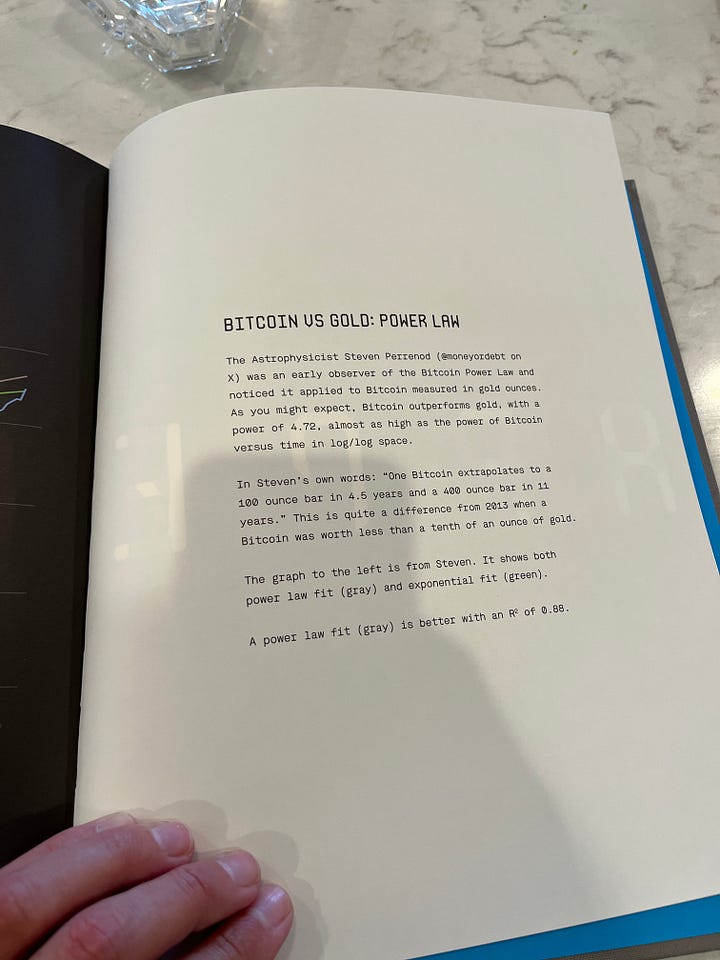
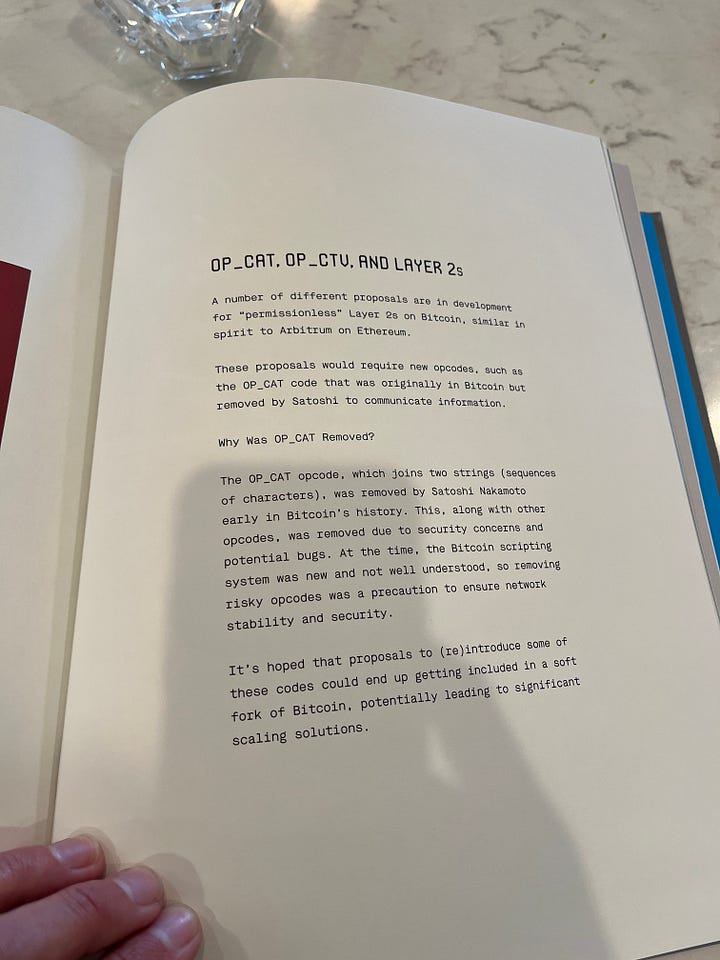
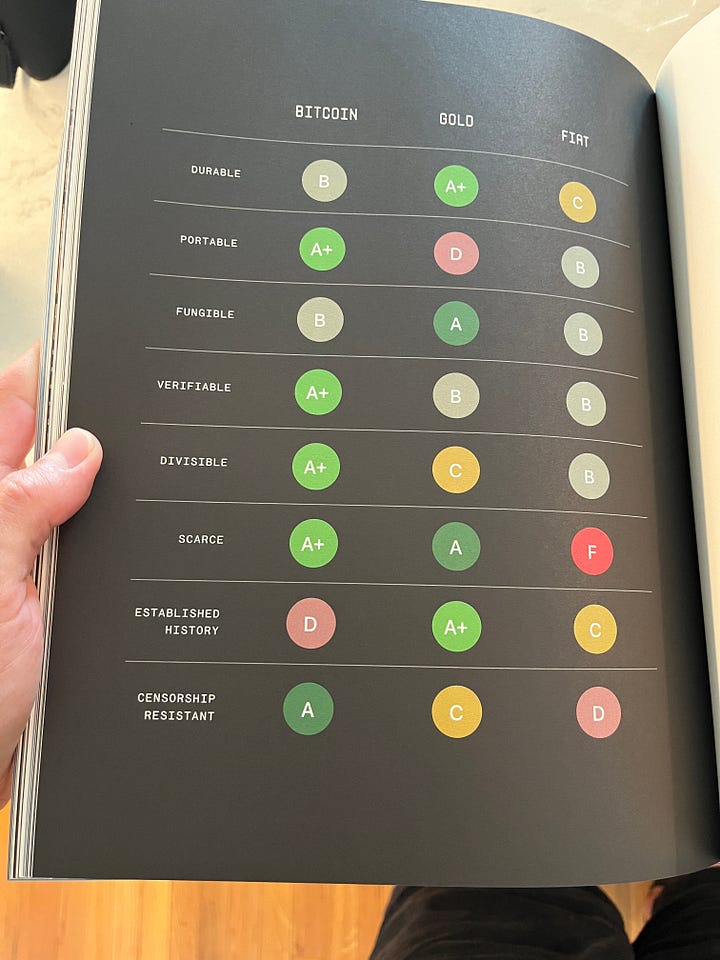
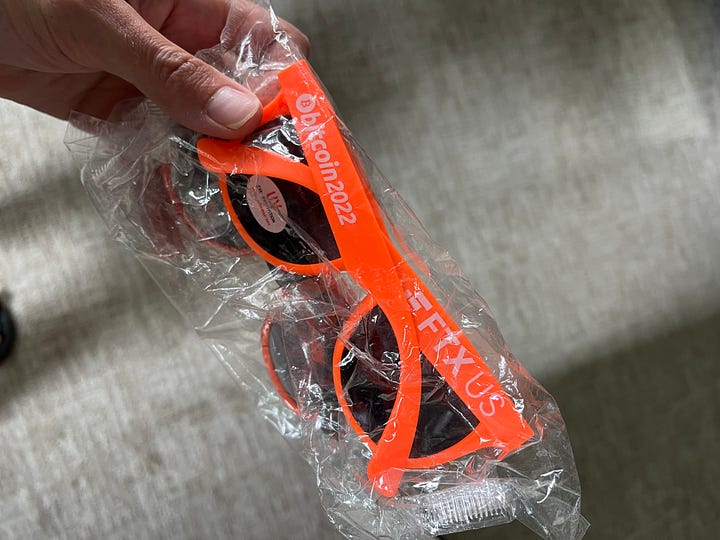
We headed upstairs to work on setting up Sparrow Wallet on their Windows machine. I verified the software download first (which you should always do), then helped them create a new wallet using their Ledger Flex. They also had an older Ledger Nano X. The Flex setup was easy, but the Nano X gave us trouble. It turns out Ledger allows multiple wallets for the same asset, which can show up differently depending on how they’re configured. In Sparrow, only one wallet showed—none of the others.
I believe it had to do with the derivation path from the Ledger. If anyone knows a fix, let me know.
After a few hours of troubleshooting, I told them I couldn’t really recommend Ledger. The UX is a mess. They’d already heard similar things from other plebs too.
I suggested switching to the Blockstream Jade. It’s a solid Bitcoin-only device from a trustworthy team. That’s what you want in a hardware wallet.
But back to the lens…
Since it’s an LTM (Leica Thread Mount), I couldn’t mount it directly on my M262. Luckily, I remembered I had an Urth adapter that fits my Fujifilm X-Pro2. I don’t use the X-Pro2 much these days—it’s mostly been sidelined by the M262 - but this was the perfect excuse to bring it out again.
To test the lens, I shot everything wide open at f/2.8. Nothing crazy fast, but it’s the best way to see a lens’s character. And this one definitely has character. There’s a subtle softness and a kind of motion blur effect around the edges when wide open. At first, I wasn’t sure how I felt about it, but the more I shot, the more I liked it. It reminds me of Winogrand’s work in Winogrand Color - those messy, shifting edges that make the frame feel alive. It also helps soften the digital-ness of the camera sensor.
The focus throw is short and snappy - much tighter than my Summicron V3 35mm f/2. I really like how fast it is to use. The closest focusing distance is about 3.5 feet, so it’s not ideal for close-ups. And with the Urth adapter on the X-Pro2, the focal length ends up closer to 40mm.
The only thing that threw me off was the infinity lock. When the focus hits infinity, it physically locks - you have to press a small tab to unlock it. I’ve seen others complain about it, so I guess it’s just one of those old lens quirks. I’m getting used to it.
All the photos here were taken around where I live in South Carolina. Some during bike rides to the river for a swim, others while walking through the marshlands.
I try to make work wherever I am. You should be able to.
It’s about the light, the rhythm, the play - and having the motivation to actually go out and shoot.
Lens rating: 7.9/10
I mainly shoot with a Leica M262, and edit in Lightroom + Dehancer
Use “PictureRoom” for 10% off Dehancer Film
If you’ve made it this far, thank you for taking the time to view my work - consider becoming a paid subscriber.
Also, please contact me if you would like to purchase any of my prints.
Follow me on Nostr:
npub1c8n9qhqzm2x3kzjm84kmdcvm96ezmn257r5xxphv3gsnjq4nz4lqelne96
-
 @ 8bad92c3:ca714aa5
2025-05-28 19:01:49
@ 8bad92c3:ca714aa5
2025-05-28 19:01:49Marty's Bent

Last week we covered the bombshell developments in the Samourai Wallet case. For those who didn't read that, last Monday the world was made aware of the fact that the SDNY was explicitly told by FinCEN that the federal regulator did not believe that Samourai Wallet was a money services business six months before arresting the co-founders of Samourai Wallet for conspiracy to launder money and illegally operating a money services business. This was an obvious overstep by the SDNY that many believed would be quickly alleviated, especially considering the fact that the Trump administration via the Department of Justice has made it clear that they do not intend to rule via prosecution.
It seems that this is not the case as the SDNY responded to a letter sent from the defense to dismiss the case by stating that they fully plan to move forward. Stating that they only sought the recommendations of FinCEN employees and did not believe that those employees' comments were indicative of FinCEN's overall views on this particular case. It's a pretty egregious abuse of power by the SDNY. I'm not sure if the particular lawyers and judges within the Southern District of New York are very passionate about preventing the use of self-custody bitcoin and products that enable bitcoiners to transact privately, or if they're simply participating in a broader meta war with the Trump administration - who has made it clear to federal judges across the country that last Fall's election will have consequences, mainly that the Executive Branch will try to effectuate the policies that President Trump campaigned on by any legal means necessary - and Samouari Wallet is simply in the middle of that meta war.
However, one thing is pretty clear to me, this is an egregious overstep of power. The interpretation of that law, as has been laid out and confirmed by FinCEN over the last decade, is pretty clear; you cannot be a money services business if you do not control the funds that people are sending to each other, which is definitely the case with Samourai Wallet. People downloaded Samourai Wallet, spun up their own private-public key pairs and initiated transactions themselves. Samourai never custodied funds or initiated transactions on behalf of their users. This is very cut and dry. Straight to the point. It should be something that anyone with more than two brain cells is able to discern pretty quickly.
It is imperative that anybody in the industry who cares about being able to hold bitcoin in self-custody, to mine bitcoin, and to send bitcoin in a peer-to-peer fashion makes some noise around this case. None of the current administration's attempts to foster innovation around bitcoin in the United States will matter if the wrong precedent is set in this case. If the SDNY is successful in prosecuting Samourai Wallet, it will mean that anybody holding Bitcoin in self-custody, running a bitcoin fold node or mining bitcoin will have to KYC all of their users and counterparts lest they be labeled a money services business that is breaking laws stemming from the Bank Secrecy Act. This will effectively make building a self-custody bitcoin wallet, running a node, or mining bitcoin in tillegal in the United States. The ability to comply with the rules that would be unleashed if this Samourai case goes the wrong way, are such that it will effectively destroy the industry overnight.
It is yet to be seen whether or not the Department of Justice will step in to publicly flog the SDNY and force them to stop pursuing this case. This is the only likely way that the case will go away at this point, so it is very important that bitcoiners who care about being able to self-custody bitcoin, mine bitcoin, or send bitcoin in a peer-to-peer fashion in the United States make it clear to the current administration and any local politicians that this is an issue that you care deeply about. If we are too complacent, there is a chance that the SDNY could completely annihilate the bitcoin industry in America despite of all of the positive momentum we're seeing from all angles at the moment.
Bitcoin Adoption by Power Companies: The Next Frontier
In my recent conversation with Andrew Myers from Satoshi Energy, he shared their ambitious mission to "enable every electric power company to use bitcoin by block 1,050,000" – roughly three years from now. This strategic imperative isn't just about creating new Bitcoin users; it's about sovereignty. Andrew emphasized that getting Bitcoin into the hands of energy companies who value self-sovereignty creates a more balanced future economic landscape. The excitement was palpable as he described how several energy companies are already moving beyond simply selling power to Bitcoin miners and are beginning to invest in mining operations themselves.
"You have global commodity companies being like, 'Oh, this is another commodity – we want to invest in this, we want to own this,'" - Andrew Myers
Perhaps most fascinating was Andrew's revelation about major energy companies in Texas developing Bitcoin collateral products for power contracts – a practical application that could revolutionize how energy transactions are settled. As energy companies continue embracing Bitcoin for both operations and collateral, we're witnessing the early stages of a profound shift in how critical infrastructure interfaces with sound money. The implications for both sectors could be transformative.
Check out the full podcast here for more on remote viewing, Nikola Tesla's predictions, and the convergence of Bitcoin and AI technology. We cover everything from humanoid robots to the energy demands of next-generation computing.
Headlines of the Day
Steak n Shake to Accept Bitcoin at All Locations May 16 - via X
Facebook Plans Crypto Wallets for 3B Users, Bitcoin Impact Looms - via X
Trump Urges Americans to Buy Stocks for Economic Boom - via X
UK Drops Tariffs, U.S. Farmers Set to Reap Major Benefits - via X
Looking for the perfect video to push the smartest person you know from zero to one on bitcoin? Bitcoin, Not Crypto is a three-part master class from Parker Lewis and Dhruv Bansal that cuts through the noise—covering why 21 million was the key technical simplification that made bitcoin possible, why blockchains don’t create decentralization, and why everything else will be built on bitcoin.
Ten31, the largest bitcoin-focused investor, has deployed $150M across 30+ companies through three funds. I am a Managing Partner at Ten31 and am very proud of the work we are doing. Learn more at ten31.vc/invest.
Final thought...
Happy belated Mother's Day to all the moms out there.
Get this newsletter sent to your inbox daily: https://www.tftc.io/bitcoin-brief/
Subscribe to our YouTube channels and follow us on Nostr and X:
@media screen and (max-width: 480px) { .mobile-padding { padding: 10px 0 !important; } .social-container { width: 100% !important; max-width: 260px !important; } .social-icon { padding: 0 !important; } .social-icon img { height: 32px !important; width: 32px !important; } .icon-cell { padding: 0 4px !important; } } .mj-column-per-33-333333333333336 { width: 25% !important; max-width: 25%; } .moz-text-html .mj-column-per-33-333333333333336 { width: 25% !important; max-width: 25%; } /* Helps with rendering in various email clients */ body { margin: 0 !important; padding: 0 !important; -webkit-text-size-adjust: 100% !important; -ms-text-size-adjust: 100% !important; } img { -ms-interpolation-mode: bicubic; } /* Prevents Gmail from changing the text color in email threads */ .im { color: inherit !important; }
-
 @ 005bc4de:ef11e1a2
2025-05-28 16:24:41
@ 005bc4de:ef11e1a2
2025-05-28 16:24:41
Two days ago I put this out: https://peakd.com/hive-124838/@crrdlx/hostr-snaps-9i13ooa7ufp
 Post: https://peakd.com/hive-124838/@crrdlx/hostr-snaps-9i13ooa7ufp
Post: https://peakd.com/hive-124838/@crrdlx/hostr-snaps-9i13ooa7ufpOne of the comments said it "...looks like some sort of game as well." That was enough to tickle my curiosity and get me thinking. The round tomatoes and how they nestled into the grooves of the tiles reminded me of Chinese checkers. The grid brought Hex to mind (the game John Nash played) and I wondered if a square-grid version might be viable. A little searching revealed Hex is a "Connection game" and there are several. The one called Tak seemed really interesting and simple. I like interesting and I really like simple.
So, a square grid connection game wouldn't be new, however, you can't play Tak with tomatoes. Tak requires stacking "stones" or standing them on edge, that would be very, very tricky with tomatoes.
I looked around and happened to have some dried corn kernels and dry beans. I drew out a 5 x 5 grid of dots, lined up five corn kernels on one side in a "home row" and 5 beans on the other. We used to play a game where two sides of Army men met after a series of moves. In that game, we rolled dice to have a "combat" and see who would win the little battle. I wanted something like that in my game, some type of combat or conquest, somehow. So, I started messing around, moving kernels and beans, and totally just set out to make this game up on the fly. This is what I got...
Rules
The objective, like Hex or Tak, is to connect one side (your home row) to your opponent's side. The connection to the other side can be a straight line, or it CAN include a diagonal road. Any of the roads below would be a win for team bean (B).
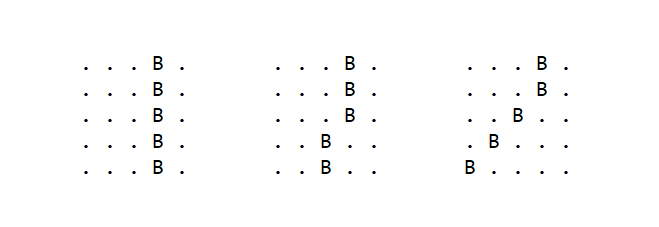
- One side makes a move by sliding one corn/bean one spot forward.
- Then, take turns making moves.
- Movement can only be one spot forward/back or sideways (NSEW). You cannot move diagonally.
- Opponents CAN occupy, or "squat", on the same spot at once. If so, the spot is being "co-squatted" (they're like two people standing in the same sidewalk tile at the same time).
- However, while opponents occupy the same spot, a "combat" might ensue. A corn/bean can "attack" by moving yet another adjoining corn or bean onto the co-squatted spot. A conquest is made by outnumbering a spot 2-to-1. For instance, if a spot is being occupied by both a bean and corn, and then a second corn moves in, the two corns conquer the one bean. The bean is immediately removed. The bean player then places that conquered bean into any empty spot on his or her home row. That placement constitutes the bean player's turn. So, after the bean is placed on the home row, the corn player makes the next move.
- Play continues until someone completes a road from their home row across to their opponent's home row. (Again, a diagonal road is okay for the win.)
- The losing player got Succotashed.
Game name
As to the name, initially I wanted a tomato-ish name. But, I was using corn and beans. So, I'm naming this game "Succotash" after the corn, bean, and vegetable recipe. I considered calling it the "Texas Caviar Game" because it has tomatoes in it, but playing Succotash just sounds better. Plus, putting tomatoes in succotash sounds yummy.
Simple
A big goal here was to keep it simple. To that end, all that's needed is (a) a paper with a 5 x 5 grid drawn on it, and, (b) 5 pieces of something and 5 pieces of something else. Obviously I used corn kernels and beans, but it could easily be shells/legos, pennies/paperclips, nuts/stones, or whatever.
Initially, I had a "storehouse" of extra corn kernels and storehouse of extra beans (seen in the images). My thinking was that they would replace the corn or beans that get conquered by opponents. Upon playing the game, it was apparent that a storehouse is totally unnecessary. Once captured, the same corn/bean can just be the one that's placed back onto the home row. Five of each is fine.
Also, I'm sure the grid could easily be expanded to whatever size you wish. I played an opponent with the 5 x 5 grid, and that seemed a good size for a five minute or so game.
Why not sit down face-to-face with someone for a minute and give Succotash a try? If you do, I'd love to hear how it went.

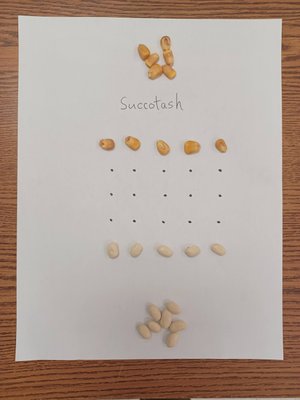
-
 @ 8bad92c3:ca714aa5
2025-05-28 19:01:46
@ 8bad92c3:ca714aa5
2025-05-28 19:01:46Key Takeaways

In this episode of TFTC, energy economist Anas Alhajji outlines a profound shift in U.S. foreign policy under Trump—away from military intervention and toward transactional diplomacy focused on trade, reconstruction, and curbing Chinese and Russian influence in the Middle East. He highlights Trump’s quiet outreach to Syria as emblematic of the U.S.'s strategic flexibility in legitimizing former adversaries when economically beneficial. Alhajji dismisses BRICS as a fractured bloc incapable of rivaling the U.S.-led order and insists the dollar and petrodollar remain dominant. On energy, he warns that despite favorable fundamentals, prices are suppressed by political confusion, underinvestment, and an aging power grid ill-prepared for the AI and urbanization boom. He also contends that Iran is stalling negotiations to buy time for nuclear advancement and that any deal will be superficial. Finally, Alhajji debunks the myth of Trump being pro-oil, noting his long-standing hostility toward the industry and explaining why a repeat of his past energy boom is implausible given today’s financial and structural constraints.
Best Quotes
- “BRICS is a paper tiger. Everything about BRICS is what China does—and that’s it.”
- “The dollar is here to stay. The petrodollar is here to stay. End of story.”
- “Trump hates the oil industry. He always classified it as an enemy.”
- “Energy projects are 30- to 40-year investments, but politicians think in 4-year cycles. That’s where the disconnect lies.”
- “People think shale will boom again. It won’t. The model changed from ‘drill baby drill’ to ‘control baby control.’”
- “The real story of Trump’s trip wasn’t about politics—it was investment, investment, investment.”
- “Without massive investment in the grid and gas turbines, blackouts will become the norm—even in rich countries like Kuwait.”
- “Iran and China have perfected the game of oil exports. Sanctions are just theater at this point.”
Conclusion
Anas Alhajji’s conclusion challenges conventional narratives, arguing that global power is shifting from military dominance to economic leverage, infrastructure investment, and energy control. He presents a nuanced view of U.S. foreign policy under Trump, emphasizing the strategic importance of trade and reconstruction over regime change. As energy demand soars and geopolitical risks mount, Alhajji warns that the real dangers lie not in foreign adversaries, but in policy confusion, infrastructural lag, and complacency—making this episode a crucial listen for anyone seeking to understand the high-stakes intersection of energy, economics, and diplomacy.
Timestamps
0:00 - Intro
0:48 - Syria and US diplomacy in Middle East
12:50 - Trump in the Middle East
18:12 - Fold & Bitkey
19:48 - Iran - Nuclear program and PR
33:53 - Unchained
34:22 - Crude markets, trade war and US debt
54:28 - Trump's energy stance
1:05:46 - Energy sector challanges
1:14:44 - Policy recommendations
1:21:18 - AI and bitcoinTranscript
(00:00) oil prices market fundamentals support higher price than where we are today. But because of this confusion, everyone is scared of low economic growth and that is a serious problem. The US media ignored part of Trump's speech when he said we are not about nation building and they refer to Afghanistan and Iraq.
(00:15) Look at them. This is a criticism of George W. Bush. We have groups that are talking about the demise of the dollar, the rise of bricks. Bricks is a paper tiger. Everything about bricks is what China does and that's it. The dollar is here to stay and the petro dollar is here to stay.
(00:31) The perception is that the Trump administration is cold but the reality Trump hates the oil [Music] indust. How are you? Very good. Very good. Thank you. As you were telling me, you've been a bit sleepd deprived this week trying to keep up with what's going on. Oh, absolutely. I mean, Trump keeps us on our toes uh all the time.
(01:06) In fact, I plan certain things for the weekend and Trump will say something or he will do something and all of a sudden we get busy again. Uh so clients are not going to wait for you until you finish your work. Basically, they want to know what's going on. So what is going on? What what how profound were the events in the Middle East? These are very uh very profound changes basically because it is very clear that if you look at the last 15 years uh and you look at the growth uh in the Middle East, you look at the growth of Saudi Arabia and uh the
(01:41) role of Turkey for example in the region uh it just just amazing be beyond any uh any thoughts. Uh in fact both of them Turkey and Saudi Arabia are part of the G20. Uh so they have economic influence and they have political influence. And of course the icing on the cake for those who are familiar with the region is to recognize the Syrian government and meet with the Syrian uh president.
(02:11) Uh this is a major a major change in economics and politics uh of the Middle East. Let's touch on that Syria uh topic for a while because I think a lot of people here in the United States were a bit shocked at how sort of welcoming President Trump was towards the new Syrian president considering the fact that uh he was considered an enemy not too long ago here in the United States.
(02:42) What first of all it's a fact of life for those who would like to check the history of politics. There were many people around the world who were classified or they were on the terrorism list and then they became friends of the United States or they were became heroes. I mean Nelson Mandela is one of them. You look at Latin America, there are presidents in Latin America who were uh the enemy of the United States and then they became uh uh cooperative with the United States and the United States recognized their governments and the result of their uh elections. Uh so
(03:15) we've seen this historically uh several uh several times around the world and as they say freedom fighters for some basically are the enemies and the terrorists for for others etc. So uh what we've seen that's why the the visit is very important that the recognition of this government is very important. uh the fact on the ground that uh the president of Syria had the power on the ground uh he had the the the people on the ground and he had the control on the ground and whatever he's been he's been doing since he came into power until now
(03:52) he done all the right steps u and people loved him I mean everyone who went to Syria whether the Syrians who left Syria 40 years ago or uh the visitors who are coming to Syria, they will tell you, "We have never seen the Syrian people as happy as we've seen them today, despite the fact that they they live in misery.
(04:17) They don't have um 8 million people without housing. Uh there is barely any electricity in most of the country. There is no internet. There is barely any food. The uh inflation is rampant, etc. But people are happy because they lived in fear for a very long time. And uh the steps they have taken. For example, the uh ministers in the previous government uh are still there and they are still in the housing of the government.
(04:49) They still have the drivers. They still have the cars from the previous government. They still have it until today. So uh they they were classified as enemies before. But all of a sudden now you have a new government that is uh accepting them. Uh so we we see some changes on the ground that are positive and we'll see how these things will go given that the area around them basically has been unstable for a very long time.
(05:17) how because I don't the the news when I was actually it was surreal for me because my first trip to the Middle East was last December when it was literally f flying over Syria to Abu Dhabi when uh um Assad was getting thrown out and it was pretty surreal to be in that region of the world.
(05:43) How as it pertains to like religious minorities within Syria moving forward is there protractions protections there? Um well let me just uh I want to emphasize one point that is very important. What did the interest of Turkey, Saudi Arabia and the United States in Syria if remember Syria was controlled by Iran and was controlled by the Russians.
(06:09) So in a sense it becomes uh kind of an imperative that taking it away from Iran and Russia and not bringing Iran or Russia back is extremely important. Now the Russians are still there and they have their own base but at least they are not bombing the Syrians and not killing them anymore. But the idea here is taking Syria out of Iran and Russia and probably later on if they kick the Russians out, Russians will not have access to the Mediterranean.
(06:37) Uh so there is an interest uh of all parties basically to take Russia out of Iran and um out of uh Syria regardless the country is uh devastated and it creates massive opportunities for US companies on all levels and uh we've seen a contract uh done recently with you mentioned Abu Dhabi uh uh a contract uh uh with the UA a basically to revamp all the Syrian ports and work on the Syrian ports.
(07:13) Uh so such contracts basically uh when you have a country that has nothing and it's completely devastated the whole infrastructure is devastated. Who is going to build it? If the uh what the Chinese, the Russians, so who who are going to build it? So, uh I think there is a a big room for US companies and others basically to come in and uh literally help on one side and make money on the other.
(07:38) Yeah, I think that that's what I'm trying to discern. What was this convoy from the United States to the Middle East this week signali -
 @ 99e7936f:d5d2197c
2025-05-28 14:55:40
@ 99e7936f:d5d2197c
2025-05-28 14:55:40“Dieser Beitrag wurde mit dem Pareto-Client geschrieben.”
Wo bleibt die Rettung?
Wenn man bei einem Notfall auf den Rettungswagen wartet, dann fühlen sich Minuten wie Stunden an. Die Nerven sind bis zum Anschlag gespannt, alle Sinne sind geschärft.
Die Natur hat das so eingerichtet, damit man aufmerksam und gut geschützt ist vor weiteren Verletzungen.
Bei Trauma ist das auch so, nur dass dieser Zustand gefühlt ein halbes Leben andauert. Das klingt brutal, ist aber in etwa so. Da ein menschlicher Körper das nicht gut aushalten kann, sendet er dem Gehirn die Information: “ Bitte mach etwas zur Entlastung, ich kann mit dem Dauerstress nicht gut umgehen. Ich habe ständig das Gefühl, dass etwas Schlimmes passiert und ich mich verteidigen muss.“ Das Gehirn überlegt sich dann eine Lösung, um auch selber endlich wieder Ruhe zu haben. In der Regel wird der traumatische Inhalt verdrängt, vergessen, abgewandelt, abgeschwächt oder als Schwarz-Weiß-Film wieder gegeben, also ohne Gefühl (re)präsentiert. Man kann dann von den traumatischen Erlebnissen erzählen, ohne ein einziges Gefühl zu haben. Das wirkt souverän, als habe man das Trauma verarbeitet, das Gegenteil ist der Fall. Manche Menschen reden sogar über Gefühle, empfinden diese aber nicht. Gefühle werden imitiert oder inszeniert. Wenn man selber fühlen kann, spürt man diesen feinen Unterschied als Zuhörer sofort. Jedenfalls ist alles das Traumafolge bzw. die Lösung, die uns das Gehirn nach Trauma anbietet. Entweder ist der ganze Inhalt samt Emotion weg, oder der Inhalt ist noch da, aber die Emotion dazu fehlt. Es gibt Menschen, die so tief traumatisiert sind, dass sie eine ganz andere Geschichte von sich selbst erzählen, als die, die eigentlich stattgefunden hat. Ich weiß, dass das gruselig klingt. Aber das ist eine Realität. Und es ist vermutlich gut so. Die Natur macht alles, um ein Menschenleben zu retten, und wenn es um den Preis des psychologischen Vergessens ist. Manche Erinnerungen sind offensichtlich nicht mit dem Leben vereinbar, deswegen werden sie für immer abgespalten. Mittlerweile habe ich persönlich viel Respekt vor Menschen, die sich an nichts mehr „erinnern“ können, da ich gelernt habe, dass sie am schlimmsten traumatisiert sind. Diese Einstellung hatte ich nicht immer.
Jedenfalls verhält es sich nach meiner Beobachtung und auch nach meinen eigenen Erfahrungen so, dass man sich ganz oft erst dann vollständig UND in Farbe an traumatische Erlebnisse erinnert, wenn die Zeit dafür reif ist. Man könnte auch sagen, wenn die Seele bereit ist, die verlorenen Seelenanteile wieder zuzulassen. Sie sind nie weg, denn eine unsichtbare Schnur verbindet uns immer mit dem, was passiert ist. Also, wenn dieser Moment, in dem Du Deine Seelenanteile wieder begrüßen darfst, kommt, dann ist das wie ein riesiges Geschenk, auch wenn sich das zu Beginn nicht so anfühlt. Es fühlt sich dann eher so an, wie wenn man auf den Rettungswagen wartet, aber es ist definitiv ein Geschenk, genau wie eine Geburt ein Geschenk ist. Und eine Geburt ist ja auch nicht immer leicht.
Also, je mehr Gefühl beim Erinnern von traumatischen Inhalten spürbar ist, desto besser kann Traumabearbeitung gelingen. (Heiße den Schmerz willkommen, wenn er in Dein Leben kommt.) Ich persönlich hatte lange Wehen, bevor mein Trauma dann schlagartig aktiviert wurde. Das war, bildlich gesprochen, eine Hausgeburt, die ich allein vollbracht habe, weil der Rettungswagen dermaßen Verspätung hatte. Aber das Kind hat sich dennoch gut entwickelt. Ich habe zuvor lange von meinem Trauma „nur“ geredet. Ich habe rationalisiert, wie man in der Fachsprache sagt. Mir war meine frühe Verletzung bewusst, aber ich hatte kein Gefühl zu dem, was ich erlebt hatte. Als das Gefühl da war, verstand ich, dass es sinnvoll war, es solange nicht gefühlt haben zu können, denn es war ein überwältigender Schmerz. Die Natur macht instinktiv ein gutes Timing für die Wiederkehr des Gefühls. Sie sucht sich eine Zeit im Leben aus, wo man einen guten Stand hat, stabil ist, eine Umgebung hat, die einen zumindest für eine Weile halten und auffangen kann. Denn die Natur möchte schließlich, dass man auch die Wiederkehr des Gefühls überlebt.
Genauso schmerzhaft wie der Verlust des Gefühls war, genauso schmerzhaft ist seine Wiederkehr.
Der Schmerz ist quasi der Erste und der Letzte. Er macht das Licht aus, und später macht er das Licht oder den Farbfilm wieder an. Der Schmerz ist viel besser als sein Ruf.
Ich erzähle hier lediglich meine Erfahrungen und Beobachtungen, auch wenn ich allgemein formuliere. Das kann sich bei anderen Menschen auch anders verhalten. Aber ich finde den Erfahrungsaustausch über dieses Thema wichtig, WEIL es unterschiedlich sein kann und jeder auf einem anderen Level von Traumabearbeitung steht. Ein Problem bei Traumabearbeitung ist, dass jeder ein anderes Trauma erlebt hat, dass jeder einen anderen Nährboden hatte, auf den das Trauma fiel, und dass es verschiedene Stadien gibt, bis es dann endlich und hoffentlich soweit ist, dass das Trauma wieder vollständig in die eigene Psyche integriert werden kann und man wieder „ganz“ bzw. „neu und etwas anders“ ist. Und meine Erfahrung ist, dass man auf das Tempo dieses Prozesses leider keinen Einfluss hat, auch wenn es hierzu, wie ich finde, viele falsche Verkehrsdurchsagen gibt. Die Natur ist da verschlossen wie eine Auster, sie lässt sich nicht ins Handwerk pfuschen. Als ich das verstand, hat sich mein Wunsch, Menschen zu helfen, schlagartig verändert. Ich verstand, dass ICH das nicht machen kann, dass die Natur das selber macht. Und das ist eine gute Nachricht, denn die Natur kann das am besten und ist ein super zuverlässiger Partner.
Wir brauchen keinen Rettungswagen. Der Schmerz ist die Rettung.
Das Thema „Trauma“ birgt so viel positiven Erkenntnisgewinn über das Wunder des Lebens.
Aber zurück zum Thema. Wenn man, so wie ich, ein halbes Leben in einem Schwarz-Weiß-Film verbracht hat, dann die Hausgeburt ohne Rettungswagen durchgestanden hat und das Kind irgendwann anfängt, neugierige Fragen zu stellen, dann ist man im Zugzwang. In dieser Situation bin ich heute. Deswegen schreibe ich. Mein neues ICH fragt mich immer öfter, warum ich so viele Dinge tue, die ich eigentlich gar nicht mehr tun will. Kinder fragen einen auch manchmal ganz unverblümt, ob man den Hansi denn lieb hat oder ob man gerne im Büro arbeitet. Wenn man den Hansi nicht lieb hat und nicht gerne im Büro arbeitet, dann muss man schlucken und eine kindgerechte Antwort formulieren. Genauso wenig wie Kinder als kompetenter 20-jähriger auf die Welt kommen, genau so wenig ist man nach geglückter Traumabearbeitung „geheilt“. Es wird nichts schlagartig besser. Das ist auch so eine falsche Verkehrsdurchsage. Man lebt ja noch im alten Leben, was nun Schritt für Schritt verändert werden darf. ABER man ist glückliche Mutter. Mutter sein, ist nicht immer leicht, habe ich mir sagen lassen. Mütter lieben ihre Kinder. Im Idealfall machen sie sich keine Gedanken darüber, was aus ihrem Kind mal werden soll. Sie vertrauen einfach darauf, DASS aus ihrem Kind ein glücklicher Mensch wird und buttern deshalb so viel Liebe in das Kind hinein, wie in den wenigen Jahren, die das Kind ein Kind ist, möglich ist. So ähnlich geht es mir heute auch. Ich bin stolz auf mein neues ICH und lobe es, so oft ich kann. Jede Mutter lobt ihre Butter. Das ist wichtig, denn das Leben bietet ständig Herausforderungen, an denen man bekanntlich wachsen darf. Ich gehe jeden Tag mit meinem „Kind“ spazieren, und wir sehen viel. Wir sehen andere Menschen mit Trauma, wir hören zu, welches Trauma der andere erlebt hat und auf welchem Level er ist. Wir hören das Gefühl heraus, welches mitschwingt. Wir sehen Menschen in ihrem Schwarz-Weiß-Film. Und wir sehen Menschen, die scheinbar mit jeder Situation souverän umgehen können. Am meisten interessieren „uns“ zur Zeit solche Menschen, die ehrlich zugeben, dass sie Wehen haben, dass der Schmerz sich in immer kürzeren Abständen meldet. (Die verlorenen Seelenanteile ziehen an der unsichtbaren Schnur.) Mit diesen Leuten kann ich im Moment am besten. Das hört sich komisch an. Aber ich will damit zum Ausdruck bringen, dass ich mit diesen Menschen mittlerweile am meisten resoniere. Sie sprechen meine Sprache. Sie empfinden Gefühle, und sprechen über diese. Das ist für mich die schönste Sprache.
Wer in diesen Tagen wahrhaftig Schmerz empfindet, und nicht nur als Lippenbekenntnis, sondern echten üblen Schmerz über die enttäuschte Liebe oder über die Verhältnisse in dieser Welt, der ist mir sympathisch, der ist mir nah. Denn ich weiß, dass so ein fühlender Mensch auch bald eine Niederkunft erleben wird, die ihn verändert, die ihn anders auf diese Welt schauen lässt.
Der Schmerz bringt uns die Verwandlung. Der Schmerz bringt die verlorenen Seelenanteile zurück. Der Schmerz ist der Hüter des Lebens. Der Schmerz bringt Dir Deine volle Sensibilität für andere Menschen zurück. Alles, was Du bei Dir nicht fühlen kannst, kannst Du bei anderen nicht fühlen. Der Schmerz beendet das. Er macht das Licht an und gibt dem Film wieder Farbe.
Heiße den Schmerz willkommen, wenn er in Dein Leben kommt. Tu das, nicht etwa weil Du gern leidest, nein tu das, weil Du Dich liebst, weil Du bewusst darauf achten möchtest, was Dir wirklich gut tut und Freude macht. Ein Mensch oder ein Job, der Dir Schmerz bereitet, den gilt es loszulassen. Und wenn Du Schmerz im Gesicht Deines Gegenübers siehst, dann frage Dich ehrlich, was Dein Anteil daran ist, dass der andere leidet. Wir sind nicht für jedes Leid auf dieser Welt verantwortlich, das möchte ich hier auch betonen. Und die Schuld-Nummer zieht bei mir schon lange nicht mehr. Aber ich nehme immer besser wahr, wenn mein eigenes Verhalten nicht angemessen, nicht authentisch ist, von überholten Glaubensmustern geprägt ist. Ich kann das erkennen und korrigieren. Ich kann das heute selber erkennen, weil der Schmerz mich das gelehrt hat, mich geöffnet hat. Der Schmerz lehrt uns ganz viel. Der Schmerz ist der Hüter des Lebens. Er trifft einen hart, macht aber weich.
Heiße den Schmerz willkommen, denn er ist die Rettung.
“Dieser Beitrag wurde mit dem Pareto-Client geschrieben.”
Onboarding bei Nostr: Nostr
Easy onboarding via **Start.**\ \ Das Pareto-Team baut den “Marktplatz der Ideen” und hat dabei schon viel erreicht. \ team@pareto.space \ https://pareto.space \ https://geyser.fund/project/pareto?hero=1c1b8e487090
\ \ Newsletter per Mail (Die Friedenstaube)\ hier abonnieren\ \ In Telegram lesen -> hier unsere Kanäle\ https://t.me/pareto_artikel \ https://t.me/friedenstaube_artikel \ \ Als Feed in einem Feed-Reader \ https://pareto.space/atom/feed.xml \ https://pareto.space/atom/de_feed.xml \ https://pareto.space/atom/en_feed.xml
-
 @ eb0157af:77ab6c55
2025-05-28 19:01:41
@ eb0157af:77ab6c55
2025-05-28 19:01:41Jacopo Graziuso’s econometric study explains how the presence of Bitcoin is connected to the reduction of emissions and consumption in countries where it is mined.
The debate on Bitcoin’s environmental impact has been at the center of media attention for years, often characterized by approximate information and common misconceptions. But what emerges when data is analyzed? An answer comes from the study by Jacopo Graziuso, a recent graduate in Economics and Finance at the University of Salento, who dedicated his thesis to the topic, titled: “Bitcoin and energy: towards efficiency and environmental sustainability”.
“It bothers me when they tell me ‘Bitcoin pollutes, Bitcoin consumes’. This prompted me to write the thesis,” Graziuso tells Atlas21 microphones. “We live in an era of free and accessible information, yet disinformation reigns supreme, leading to beliefs without scientific foundation.”
Regarding his research work, Graziuso emphasizes: “I thank professor of econometrics Pierluigi Toma who knew what Bitcoin is and what mining is and gave me carte blanche for writing the thesis.”
The methodology used for the study is an econometric analysis based on data from 171 states from 2009 to 2024, with particular attention to the relationship between Bitcoin presence, greenhouse gas emissions (climate-altering gases) and energy consumption. To define Bitcoin’s “presence”, Graziuso created a variable that takes value 1 if at least 1% of the population uses (knows or has a wallet) the cryptocurrency or if it is present in state reserves.
The results of the research, conducted only with open source software, contradict the dominant narrative, Graziuso explains: “The analysis shows that Bitcoin’s presence in a state is associated with a decrease in greenhouse gas emissions. The study reveals that Bitcoin’s presence in a state reduces emissions by 39 megatons of CO2 equivalent. Essentially, where there is Bitcoin, climate-altering gas emissions decrease.”
Graziuso wants to emphasize the difference between consumption and pollution: “The problem is not consumption, it’s pollution. The distinction is fundamental: energy consumption is necessary for human development, while pollution derives from the use of inefficient energy sources. Currently China consumes over 4500% more than the entire Bitcoin network. Furthermore, thanks to mining flexibility, Bitcoin can help a state reduce general consumption.”
The research highlights how mining is acting as a catalyst for the adoption of renewable and nuclear energy. Mining naturally seeks the cheapest sources which increasingly coincide with the cleanest ones, the interviewee states.
One analyzed aspect is Bitcoin’s role as “buyer of last resort” for otherwise wasted energy. Graziuso cites several examples:
- Alps Blockchain, which has reactivated 32 disused hydroelectric plants in northern Italy and is working on building facilities in Paraguay and Ecuador exploiting hydroelectric energy;
- projects like Gridless that exploit excess energy from renewable sources in remote areas: “Not only does [Gridless] optimize the use of local energy resources, but it reinvests mining profits in communities, improving access to electricity and supporting the local economy,” writes Graziuso;
- in Texas, thanks to agreements with electricity grid operator ERCOT, miners exploit the operational flexibility of their machines to adapt consumption to grid needs, turning them off during peak moments and turning them back on when there is surplus energy, thus acting as buyers of last resort and contributing to stabilizing the electrical grid.
Another interesting aspect concerns the recovery of heat generated by machines: “Marathon Digital Holdings in Finland uses heat from its ASICs to heat 80,000 homes,” explains Graziuso. “Domestic applications are also being developed where ASIC heat is used for heating, further mitigating pollution.”
Immersion cooling, a technique that involves immersing mining machines in a dielectric fluid made in the laboratory, is cited as a promising solution to improve efficiency and reduce environmental impact. This way it is also possible to reduce machine noise, while the heat produced is dissipated by the dielectric material. Graziuso cites CleanSpark as an example of a completely carbon neutral mining farm that uses this technology: “This cooling technique allows us to safely overclock hardware, increasing performance by increasing operating frequency beyond factory settings,” states CleanSpark.
The thesis includes a section dedicated to zones that are emerging as sustainable mining hubs in different parts of the world:
- in Kenya and Ethiopia, “mining powered by hydroelectric energy is bringing drinking water and electricity to previously unserved communities,” declares Graziuso;
- in Georgia and Texas, Bitcoin mining is contributing to making the electrical grid more stable, intervening during peak demand moments and absorbing excess energy during overproduction periods;
- in Canada, companies like Upstream Data and Hut 8 Mining use mining to valorize excess or dispersed energy, including gas flaring in oil fields, thus reducing energy waste and emissions;
- the Makai project in Hawaii exploits OTEC (Ocean Thermal Energy Conversion) technology to convert ocean thermal energy into clean and renewable electricity.
Despite mining’s potential, obstacles to complete decarbonization still exist: “Decarbonization is still far away. Currently in many countries there are still state incentives from 40 years ago that favor fossil sources. Due to these incentives, today entrepreneurs’ costs are lower when fossil fuels are used. Once these state incentives end, perhaps the situation will improve. At the moment it is the miners who must voluntarily use renewable sources,” observes Graziuso. Italy, for example, continues to depend about 60% on fossil sources.
Another piece of data analyzed in the thesis is the improvement in energy efficiency of specialized mining machines: “In about 15 years, efficiency has improved by over 95%: this means decreased consumption and pollution,” emphasizes Graziuso.
“I hope this research contributes to spreading a more accurate and data-based narrative,” concludes Graziuso. “Bitcoin is not the problem, but could be part of the solution to the global energy challenge.”
The thesis will soon be published in its entirety online as a scientific paper.
The post Bitcoin reduces emissions and consumption: the thesis published at the University of Salento appeared first on Atlas21.
-
 @ eb0157af:77ab6c55
2025-05-28 19:01:40
@ eb0157af:77ab6c55
2025-05-28 19:01:40Since 2019, the United States has been the country with the highest number of recorded cases, but Europe remains the most affected region.
According to a Binance report, the United States is the country that has recorded the greatest number of crypto-related kidnapping cases since 2019, despite a recent increase in incidents in France.
At the regional level, however, Europe remains the area with the highest number of crypto-related kidnappings: 59 cases over six years. During the same period, North America — which includes the United States and Canada — recorded 48 cases. Particularly notable is the data concerning the entire Asian continent, where 62 cases of crypto-related kidnappings have been documented, most of which are concentrated in Southeast Asian countries.
France emerges as a concerning hotspot for crypto kidnappings, with six recent cases, three of which have already occurred in 2025.

Source: Binance
The primary targets of these kidnappings include executives of crypto companies, professional traders, exchange employees, and entrepreneurs in the sector. Family members and close associates of victims are often targeted as well. An emerging phenomenon involves tourists suspected of possessing large amounts of cryptocurrency funds.
Kidnapping cases in 2025
The year 2025 has already seen particularly serious episodes of kidnappings linked to the digital asset world. The most notable case involved David Balland, co-founder of Ledger, and his wife, who were abducted from their residence in France earlier this January. The incident drew international attention from both the crypto industry and law enforcement agencies.
Another attempt took place in Paris, where armed men tried to kidnap the daughter and granddaughter of the CEO of the French exchange Paymium. Overseas, in New York, police arrested 37-year-old John Woeltz after discovering that an Italian tourist had been held captive and mistreated for weeks in a luxury Manhattan apartment.
Binance highlights a direct correlation between the price trend of Bitcoin and the increase in kidnappings. Since Bitcoin reached new all-time highs this year, attacks involving physical threats have also increased proportionally, the exchange suggests.

Source: Binance
In 2025 alone, at least 15 kidnapping episodes have already been documented, many involving ransom demands denominated in bitcoin.
The post Crypto kidnappings on the rise: the US leads global statistics appeared first on Atlas21.
-
 @ 9ca447d2:fbf5a36d
2025-05-28 19:01:29
@ 9ca447d2:fbf5a36d
2025-05-28 19:01:29Blackstone, the world’s largest alternative asset manager, has entered the Bitcoin space with a $1.08 million investment in BlackRock’s Bitcoin ETF. This is a big deal for both Wall Street and the Bitcoin world.
Blackstone has made its first direct investment in bitcoin through regulated financial products. A May 20, 2025, SEC filing revealed that the firm purchased 23,094 shares of the iShares Bitcoin Trust (IBIT), BlackRock’s spot Bitcoin exchange-traded fund (ETF).
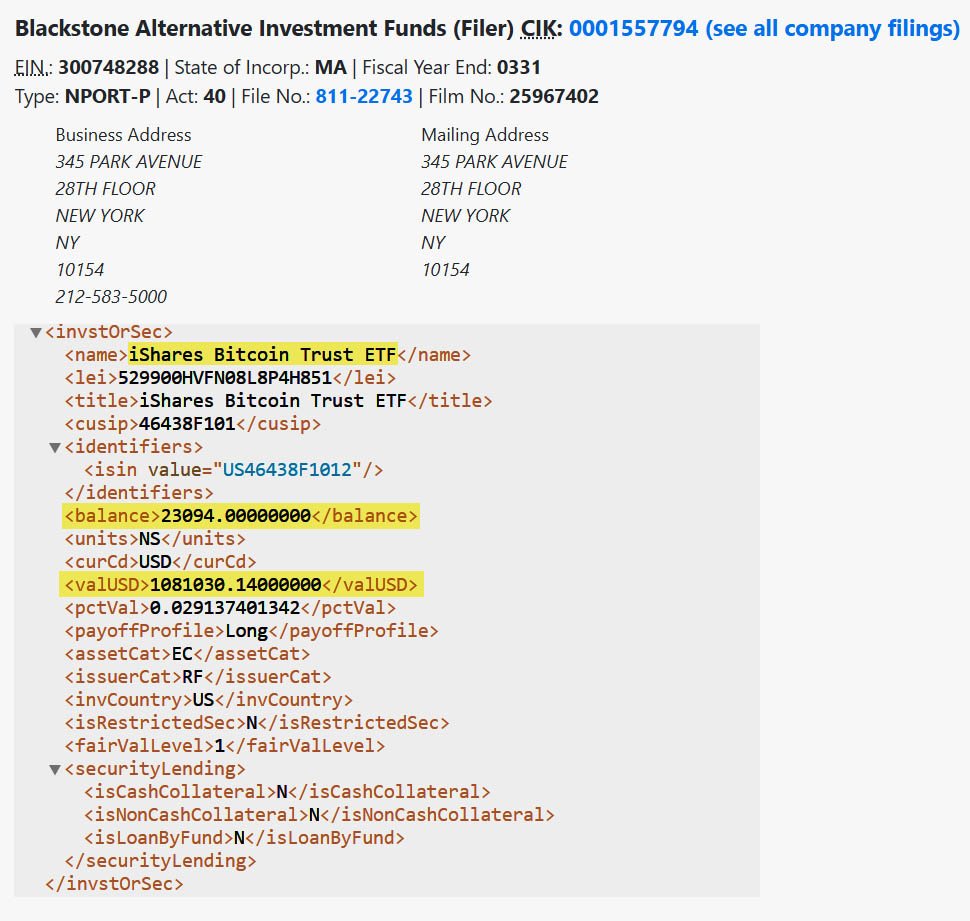
BlackStone has bought 23,094 shares of BlackRock’s IBIT — SEC
While $1.08 million is a small drop in the bucket compared to Blackstone’s $1.2 trillion in assets under management, this is a big deal for the private equity giant which has been skeptical of bitcoin in the past.
In 2019, the company’s CEO, Steve Schwarzman, said he didn’t understand Bitcoin. “I was raised in a world where someone needs to control currencies,” he said, admitting he struggled to understand the technology.
Fast forward to 2025, and it is now one of the many institutional investors taking bitcoin seriously — but doing so through cautious, regulated channels.
The investment was made through Blackstone’s $2.63 billion Alternative Multi-Strategy Fund (BTMIX), which invests in a wide range of financial instruments.
Instead of buying bitcoin directly, Blackstone chose to get exposure through a bitcoin ETF — which is how many large institutions are approaching the digital asset. Spot Bitcoin ETFs like IBIT allow investors to track the price of bitcoin without having to hold the digital asset itself.
There are several advantages to this approach. ETFs trade like stocks, are regulated by the SEC and take care of complex issues like custody and compliance. This makes them more attractive for firms that are new to Bitcoin or still wary of the risks.
Related: Bitcoin ETFs Provide Convenient Price Exposure, But At What Cost?
Blackstone’s choice of a bitcoin ETF shows how effective these products are at connecting traditional finance to the digital age.
In addition to IBIT, Blackstone also disclosed smaller investments in two other digital-asset-related companies:
- 9,889 shares of the ProShares Bitcoin Strategy ETF (BITO), valued at about $181,166.
- 4,300 shares of Bitcoin Depot Inc. (BTM), a bitcoin ATM operator, worth approximately $6,300.
Together, these are a tiny fraction of Blackstone’s portfolio but show growing interest and exploration into the space.
Since its launch in January 2024, BlackRock’s IBIT ETF has become the top-performing Bitcoin ETF in the U.S. As of mid-May 2025, the fund has seen over $46.1 billion in net inflows with no outflows since early April.
IBIT is ahead of other major ETFs like Fidelity’s FBTC and ARK’s 21Shares Bitcoin ETF.
But the trend is clear: big firms are getting comfortable with regulated bitcoin products. Industry insiders see Blackstone’s move as part of a broader shift in institutional sentiment towards bitcoin.
This is a small investment but it matters because of who is making it. Blackstone is known for being conservative and risk-averse.
Its decision to put even a tiny amount of capital into Bitcoin ETFs means tradfi companies are getting more confident in bitcoin as an asset class. Blackstone is dipping its toe in the water, and even a small step is significant given its size and influence.
-
 @ 9ca447d2:fbf5a36d
2025-05-28 19:01:14
@ 9ca447d2:fbf5a36d
2025-05-28 19:01:14The Bitcoin world begins what is considered to be its biggest event yet — Bitcoin 2025, a three-day conference taking place May 27-29 at The Venetian Resort in Las Vegas.
With over 30,000 attendees expected, the event will bring together the biggest names in politics, finance, technology and the global Bitcoin community.
Hosted by BTC Inc., Bitcoin 2025 is not just another tech conference — it’s a global gathering that mixes policy, innovation and community under one roof.
It’s where big ideas about the future of money are debated, shared and shaped.
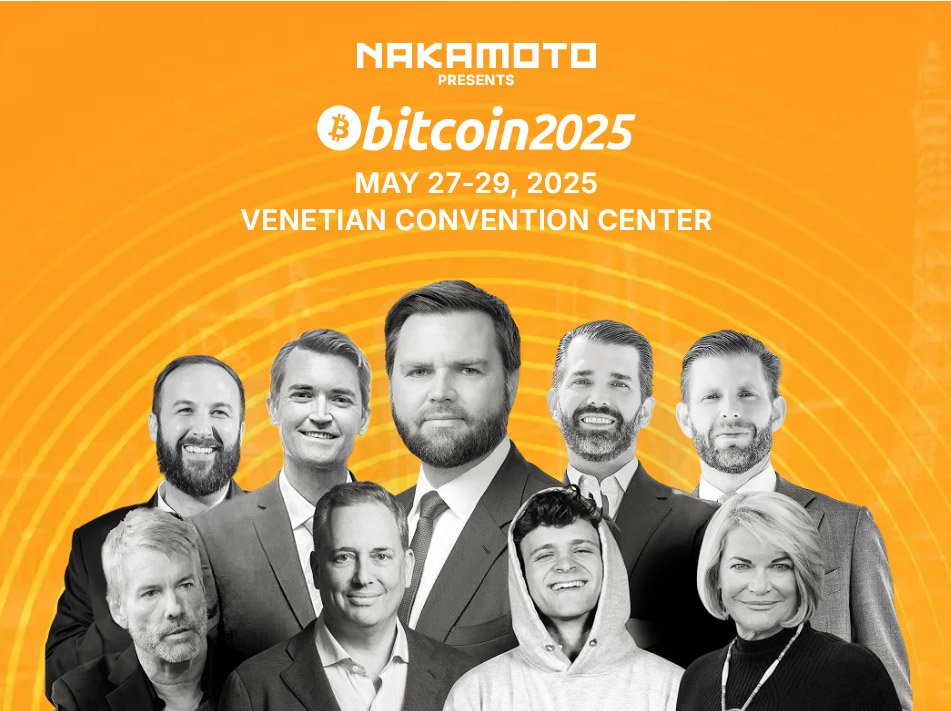
Influential speakers will attend the conference
The conference features a wide range of speakers from Bitcoin experts and educators to political leaders and athletes.
Big names like U.S. Vice President JD Vance, Trump’s Crypto Czar David Sacks, and Senator Cynthia Lummis are among the most anticipated guests.
Vice President Vance is expected to talk about the role of Bitcoin in the national economy. “The resilience of Bitcoin as a financial instrument is a testament to the power of decentralized finance,” he recently said.
Also speaking are Nigel Farage, a well-known voice in European politics and Donald Trump Jr., a supporter of financial freedom through digital currency.
Also, Michael Saylor, Executive Chairman of Strategy will be back on stage to talk about bitcoin as a corporate asset.
There are over 70 speakers on the list including Adam Back (CEO of Blockstream), Jan van Eck (CEO of VanEck) and Bryan Johnson, a futurist known for his work in human longevity and health tech.
Bitcoin 2025 will feature special new programs including Code + Country, a one-day segment on May 27 that explores how freedom, technology and innovation shape modern society.
Speakers like Chris LaCivita (Trump’s 2024 campaign co-CEO) and David Sacks (AI and digital assets advisor) will be talking about how digital tools are changing politics and finance.
Also new this year, is The Art of Freedom, an exhibit that showcases how Bitcoin is impacting the art world.
This museum-style experience allows artists to price and sell their work using bitcoin, connect directly with fans and avoid traditional middlemen.
The first official Bitcoin Conference was in 2019 in San Francisco, after grassroots meetups in 2013 and 2014. Since then, it’s been the biggest annual event in the Bitcoin world.
This year is especially important.
Global economic changes are happening and analysts say the discussions at Bitcoin 2025 will shape the next wave of regulatory reforms and technological standards for Bitcoin and stablecoins.
Bitcoin (BTC) has recently been hovering at around $110,000 with a market cap of $2.12 trillion. Many think the ideas and announcements at the event will impact price and policy.
Bitcoin 2025 is for everyone — long-time Bitcoiners to newcomers to digital assets, with keynotes, panels, massive expo halls and VIP networking.
It’s fun too. There are numerous parties, meetups and side events to connect, making it a place to learn, meet others who share the same interests and help shape the financial world.
The scale and diversity of Bitcoin 2025 make it more than just a Bitcoin event.
It’s a reflection of how far Bitcoin has come — from internet forums to boardrooms and government halls. It’s not just about Bitcoin anymore, it’s about the future of the world.
-
 @ b1ddb4d7:471244e7
2025-05-28 19:01:08
@ b1ddb4d7:471244e7
2025-05-28 19:01:08Custodial Lightning wallets allow users to transact without managing private keys or channel liquidity. The provider handles technical complexities, but this convenience comes with critical trade-offs:
- You don’t control your keys: The custodian holds your bitcoin.
- Centralized points of failure: Servers can be hacked or shut down.
- Surveillance risks: Providers track transaction metadata.
Key Risks of Custodial Lightning Wallets
*1. Hacks and Exit Scams*
Custodians centralize large amounts of bitcoin, attracting hackers:
- Nearly $2.2 billion worth of funds were stolen from hacks in 2024.
- Lightning custodians suffered breaches, losing user funds.
Unlike non-custodial wallets, victims have no recourse since they don’t hold keys.
*2. Censorship and Account Freezes*
Custodians comply with regulators, risking fund seizures:
- Strike (a custodial Lightning app) froze accounts of users in sanctioned regions.
- A U.K. court in 2020 ordered Bitfinex to freeze bitcoin worth $860,000 after the exchange and blockchain sleuthing firm Chainalysis traced the funds to a ransomware payment.
*3. Privacy Erosion*
Custodians log user activity, exposing sensitive data:
- Transaction amounts, receiver addresses, and IPs are recorded.
*4. Service Downtime*
Centralized infrastructure risks outages.
*5. Inflation of Lightning Network Centralization*
Custodians dominate liquidity, weakening network resilience:
- At the moment, 10% of the nodes on Lightning control 80% of the liquidity.
- This centralization contradicts bitcoin’s decentralized ethos.
How to Switch to Self-Custodial Lightning Wallets
Migrating from custodial services is straightforward:
*1. Choose a Non-Custodial Wallet*
Opt for wallets that let you control keys and channels:
- Flash: The self-custodial tool that lets you own your keys, control your coins, and transact instantly.
- Breez Wallet : Non-custodial, POS integrations.
- Core Lightning : Advanced, for self-hosted node operators.
*2. Transfer Funds Securely*
- Withdraw funds from your custodial wallet to a bitcoin on-chain address.
- Send bitcoin to your non-custodial Lightning wallet.
*3. Set Up Channel Backups*
Use tools like Static Channel Backups (SCB) to recover channels if needed.
*4. Best Practices*
- Enable Tor: Mask your IP (e.g., Breez’s built-in Tor support).
- Verify Receiving Addresses: Avoid phishing scams.
- Regularly Rebalance Channels: Use tools like Lightning Pool for liquidity.
Why Self-Custodial Lightning Matters
- Self-custody: Control your keys and funds.
- Censorship resistance: No third party can block transactions.
- Network health: Decentralized liquidity strengthens Lightning.
Self-custodial wallets now rival custodial ease.
Custodial Lightning wallets sacrifice security for convenience, putting users at risk of hacks, surveillance, and frozen funds. As bitcoin adoption grows, so does the urgency to embrace self-custodial solutions.
Take action today:
- Withdraw custodial funds to a hardware wallet.
- Migrate to a self-custodial Lightning wallet.
- Educate others on the risks of custodial control.
The Lightning Network’s potential hinges on decentralization—don’t let custodians become its Achilles’ heel.
-
 @ b1ddb4d7:471244e7
2025-05-28 19:01:01
@ b1ddb4d7:471244e7
2025-05-28 19:01:01This article was originally published on aier.org
Even after eleven years experience, and a per Bitcoin price of nearly $20,000, the incredulous are still with us. I understand why. Bitcoin is not like other traditional financial assets.
Even describing it as an asset is misleading. It is not the same as a stock, as a payment system, or a money. It has features of all these but it is not identical to them.
What Bitcoin is depends on its use as a means of storing and porting value, which in turn rests of secure titles to ownership of a scarce good. Those without experience in the sector look at all of this and get frustrated that understanding why it is valuable is not so easy to grasp.
In this article, I’m updating an analysis I wrote six years ago. It still holds up. For those who don’t want to slog through the entire article, my thesis is that Bitcoin’s value obtains from its underlying technology, which is an open-source ledger that keeps track of ownership rights and permits the transfer of these rights. Bitcoin managed to bundle its unit of account with a payment system that lives on the ledger. That’s its innovation and why it obtained a value and that value continues to rise.
Consider the criticism offered by traditional gold advocates, who have, for decades, pushed the idea that sound money must be backed by something real, hard, and independently valuable. Bitcoin doesn’t qualify, right? Maybe it does.
Bitcoin first emerged as a possible competitor to national, government-managed money in 2009. Satoshi Nakamoto’s white paper was released October 31, 2008. The structure and language of this paper sent the message: This currency is for computer technicians, not economists nor political pundits. The paper’s circulation was limited; novices who read it were mystified.
But the lack of interest didn’t stop history from moving forward. Two months later, those who were paying attention saw the emergence of the “Genesis Block,” the first group of bitcoins generated through Nakamoto’s concept of a distributed ledger that lived on any computer node in the world that wanted to host it.
Here we are all these years later and a single bitcoin trades at $18,500. The currency is held and accepted by many thousands of institutions, both online and offline. Its payment system is very popular in poor countries without vast banking infrastructures but also in developed countries. And major institutions—including the Federal Reserve, the OECD, the World Bank, and major investment houses—are paying respectful attention and weaving blockchain technology into their operations.
Enthusiasts, who are found in every country, say that its exchange value will soar even more in the future because its supply is strictly limited and it provides a system vastly superior to government money. Bitcoin is transferred between individuals without a third party. It is relatively low-cost to exchange. It has a predictable supply. It is durable, fungible, and divisible: all crucial features of money. It creates a monetary system that doesn’t depend on trust and identity, much less on central banks and government. It is a new system for the digital age.
Hard lessons for hard money
To those educated in the “hard money” tradition, the whole idea has been a serious challenge. Speaking for myself, I had been reading about bitcoin for two years before I came anywhere close to understanding it. There was just something about the whole idea that bugged me. You can’t make money out of nothing, much less out of computer code. Why does it have value then? There must be something amiss. This is not how we expected money to be reformed.
There’s the problem: our expectations. We should have been paying closer attention to Ludwig von Mises’ theory of money’s origins—not to what we think he wrote, but to what he actually did write.
In 1912, Mises released The Theory of Money and Credit. It was a huge hit in Europe when it came out in German, and it was translated into English. While covering every aspect of money, his core contribution was in tracing the value and price of money—and not just money itself—to its origins. That is, he explained how money gets its price in terms of the goods and services it obtains. He later called this process the “regression theorem,” and as it turns out, bitcoin satisfies the conditions of the theorem.
Mises’ teacher, Carl Menger, demonstrated that money itself originates from the market—not from the State and not from social contract. It emerges gradually as monetary entrepreneurs seek out an ideal form of commodity for indirect exchange. Instead of merely bartering with each other, people acquire a good not to consume, but to trade. That good becomes money, the most marketable commodity.
But Mises added that the value of money traces backward in time to its value as a bartered commodity. Mises said that this is the only way money can have value.
The theory of the value of money as such can trace back the objective exchange value of money only to that point where it ceases to be the value of money and becomes merely the value of a commodity…. If in this way we continually go farther and farther back we must eventually arrive at a point where we no longer find any component in the objective exchange value of money that arises from valuations based on the function of money as a common medium of exchange; where the value of money is nothing other than the value of an object that is useful in some other way than as money…. Before it was usual to acquire goods in the market, not for personal consumption, but simply in order to exchange them again for the goods that were really wanted, each individual commodity was only accredited with that value given by the subjective valuations based on its direct utility.
Mises’ explanation solved a major problem that had long mystified economists. It is a narrative of conjectural history, and yet it makes perfect sense. Would salt have become money had it otherwise been completely useless? Would beaver pelts have obtained monetary value had they not been useful for clothing? Would silver or gold have had money value if they had no value as commodities first? The answer in all cases of monetary history is clearly no. The initial value of money, before it becomes widely traded as money, originates in its direct utility. It’s an explanation that is demonstrated through historical reconstruction. That’s Mises’ regression theorem.
Bitcoin’s Use Value
At first glance, bitcoin would seem to be an exception. You can’t use a bitcoin for anything other than money. It can’t be worn as jewelry. You can’t make a machine out of it. You can’t eat it or even decorate with it. Its value is only realized as a unit that facilitates indirect exchange. And yet, bitcoin already is money. It’s used every day. You can see the exchanges in real time. It’s not a myth. It’s the real deal.
It might seem like we have to choose. Is Mises wrong? Maybe we have to toss out his whole theory. Or maybe his point was purely historical and doesn’t apply in the future of a digital age. Or maybe his regression theorem is proof that bitcoin is just an empty mania with no staying power, because it can’t be reduced to its value as a useful commodity.
And yet, you don’t have to resort to complicated monetary theory in order to understand the sense of alarm surrounding bitcoin. Many people, as I did, just have a feeling of uneasiness about a money that has no basis in anything physical. Sure, you can print out a bitcoin on a piece of paper, but having a paper with a QR code or a public key is not enough to relieve that sense of unease.
How can we resolve this problem? In my own mind, I toyed with the issue for more than a year. It puzzled me. I wondered if Mises’ insight applied only in a pre-digital age. I followed the speculations online that the value of bitcoin would be zero but for the national currencies into which it is converted. Perhaps the demand for bitcoin overcame the demands of Mises’ scenario because of a desperate need for something other than the dollar.
As time passed—and I read the work of Konrad Graf, Peter Surda, and Daniel Krawisz—finally the resolution came. Bitcoin is both a payment system and a money. The payment system is the source of value, while the accounting unit merely expresses that value in terms of price. The unity of money and payment is its most unusual feature, and the one that most commentators have had trouble wrapping their heads around.
We are all used to thinking of currency as separate from payment systems. This thinking is a reflection of the technological limitations of history. There is the dollar and there are credit cards. There is the euro and there is PayPal. There is the yen and there are wire services. In each case, money transfer relies on third-party service providers. In order to use them, you need to establish what is called a “trust relationship” with them, which is to say that the institution arranging the deal has to believe that you are going to pay.
This wedge between money and payment has always been with us, except for the case of physical proximity.
If I give you a dollar for your pizza slice, there is no third party. But payment systems, third parties, and trust relationships become necessary once you leave geographic proximity. That’s when companies like Visa and institutions like banks become indispensable. They are the application that makes the monetary software do what you want it to do.
The hitch is that
-
 @ 8d34bd24:414be32b
2025-05-28 13:53:46
@ 8d34bd24:414be32b
2025-05-28 13:53:46These days it can feel like the whole world is out of control. Government officials lie and break the law. People are selfish, act emotionally rather than logically, and push ideologies that are illogical and contrary to reality. Society is divided into groups and people are judged, not for their own character, but based on which group they are placed into. There are wars and rumors of wars. There are worries of pandemics and economic disasters. Depression, psychosis, and despair is rampant even among the youngest among us.
Hope For Believers
As much as things seem to be out of control, they are not out of God’s control. This is what the Bible predicted. No matter how bad things get in the world, those who have put their faith in Jesus, do not need to feel despair.
Why are you in despair, O my soul?\ And why have you become disturbed within me?\ Hope in God, for I shall again praise Him\ For the help of His presence.\ O my God, my soul is in despair within me;\ Therefore I remember You from the land of the Jordan\ And the peaks of Hermon, from Mount Mizar. (Psalm 42:5-6)
When we start to feel despair overcoming us, we need to remember what God has done and what He has promised. We need to praise God for what He has done, what He has promised, and what He will bring to completion. Things may be hard now, but God is still in control, and we know how the story will end. God triumphs. Good is rewarded. Evil is destroyed. We can stand on the foundation of hope because we know the ending. Even though things may be out of our personal control, they are always under God’s control.
The more fiercely the storm rages, the more we need to rest in Jesus and the more we need to put our hope in Him.
O love the Lord, all you His godly ones!\ The Lord preserves the faithful\ And fully recompenses the proud doer.\ **Be strong and let your heart take courage,\ All you who hope in the Lord. (Psalm 31:23-24) {emphasis mine}
We can take courage because God always acts for our long term good. Every hardship we experience here on earth will be recognized as a blessing that grew our faith and prepared us for heaven and God’s presence in eternity.
For I know the plans that I have for you,’ declares the Lord, ‘plans for welfare and not for calamity to give you a future and a hope. (Jeremiah 29:11)
Even the worst things that happen to us, due to the sins of others, have a good purpose in our lives. God is working good through us. Our hope isn’t an empty hope. It isn’t a “I really hope this happens.” It is a “I can hope in the guaranteed promises of God.”
For we do not want you to be unaware, brethren, of our affliction which came to us in Asia, that we were burdened excessively, beyond our strength, so that we despaired even of life; indeed, we had the sentence of death within ourselves so that we would not trust in ourselves, but in God who raises the dead; who delivered us from so great a peril of death, and will deliver us, He on whom we have set our hope. And He will yet deliver us, (2 Corinthians 1:8-10) {emphasis mine}
We may experience situations so bad that they seem hopeless, but with God, nothing is hopeless. The God who raises the dead can raise us out of any situation. The God who spoke the universe into existence can deliver us by a word.
The God of the Bible knows all and loves us completely. He looks at our situation through the lens of eternity. What seems best in the moment is not necessarily what is best for our eternity. Many times He delivers us through hardship rather than out of it. We just need to trust Him and put our hope in Him because He is good.
In the same way God, desiring even more to show to the heirs of the promise the unchangeableness of His purpose, interposed with an oath, so that by two unchangeable things in which it is impossible for God to lie, we who have taken refuge would have strong encouragement to take hold of the hope set before us. This hope we have as an anchor of the soul, a hope both sure and steadfast and one which enters within the veil, where Jesus has entered as a forerunner for us, having become a high priest forever according to the order of Melchizedek. (Hebrews 6:17-20) {emphasis mine}
Read that statement again. “This hope we have as an anchor of the soul, a hope both sure and steadfast.” Are you trusting Jesus as the “anchor of your soul?” Is your hope just a wish or is it a “sure and steadfast” hope based on the promises of God that you know will 100% come true?
And not only this, but we also exult in our tribulations, knowing that tribulation brings about perseverance; and perseverance, proven character; and proven character, hope; and hope does not disappoint, because the love of God has been poured out within our hearts through the Holy Spirit who was given to us. (Romans 5:3-5)
Isn’t it ironic that we need hope to persevere through tribulations, but that persevering through tribulation gives us character and hope? Our faith, trust, and hope grow through hardship. When things are easy, we almost always fall back on trusting in our own power rather than relying on God’s power. If we have put our faith in Jesus, there is no situation in which we should lose hope.
Now may the God of hope fill you with all joy and peace in believing, so that you will abound in hope by the power of the Holy Spirit. (Romans 15:13)
Is your joy and peace based on your circumstances or have you learned to have hope in God so you can experience joy and peace even in the trials?
Many people equate joy and happiness, but I think there is a key distinction. Happiness is a pleasant feeling that comes from pleasant circumstances. Joy is a similar feeling to happiness, but it comes from knowing God and His love. It is not tied to circumstances. When we have truly put our hope in God we can still have joy in and despite the most horrific circumstances.
Blessed be the God and Father of our Lord Jesus Christ, who according to His great mercy has caused us to be born again to a living hope through the resurrection of Jesus Christ from the dead, to obtain an inheritance which is imperishable and undefiled and will not fade away, reserved in heaven for you, (1 Peter 1:3-4) {emphasis mine}
Just as Jesus told the Samaritan woman at the well that He provides living water that wells up inside, so that she need never thirst, in the same way believers have a living hope that wells up in times of need. Our hope is in the Creator of the universe and Savior of the world. No problem is too big for Him. No situation is a surprise to Him. No enemy is too powerful for Him. All of our problems are already solved. We just haven’t necessarily seen the solution yet.
My soul, wait in silence for God only,\ For my hope is from Him.\ He only is my rock and my salvation,\ My stronghold; I shall not be shaken.\ On God my salvation and my glory rest;\ The rock of my strength, my refuge is in God. (Psalm 62:5-7)
Despair For Unbelievers
Although believers never have reason to despair, the same is not true for those who have rejected the Savior, Jesus Christ. In these perilous times, they have a real reason for dread and despair.
Moreover, the Lord will scatter you among all peoples, from one end of the earth to the other end of the earth; and there you shall serve other gods, wood and stone, which you or your fathers have not known. Among those nations you shall find no rest, and there will be no resting place for the sole of your foot; but there the Lord will give you a trembling heart, failing of eyes, and despair of soul. So your life shall hang in doubt before you; and you will be in dread night and day, and shall have no assurance of your life. (Deuteronomy 64-66)
Those who reject the atoning sacrifice of Jesus do not get His protection. They do not get His help. They cannot rest in hope in Him.
Of course, the good news is that they can chose to turn their hearts to Him, confess their sins, and trust in Him up until their moment of death. Sadly many will continue to put off faith until it is too late. Many will choose evil over good and license over submission until God gives them over to their lusts.
And just as they did not see fit to acknowledge God any longer, God gave them over to a depraved mind, to do those things which are not proper, being filled with all unrighteousness, wickedness, greed, evil; full of envy, murder, strife, deceit, malice; they are gossips, slanderers, haters of God, insolent, arrogant, boastful, inventors of evil, disobedient to parents, without understanding, untrustworthy, unloving, unmerciful; and although they know the ordinance of God, that those who practice such things are worthy of death, they not only do the same, but also give hearty approval to those who practice them. (Romans 1:28-32)
If any of you have not yet put your trust in Jesus as Savior and Lord, do not wait. Turn away from evil. Submit to the will of Jesus. Trust Him to take away your sins and cover you with His righteousness.
If any of you know people who are in despair, share the gospel with them. Tell them about the greatness of God. Show them the hope that is within you.
Can Believers Despair?
Are there believers who despair? Yes. Should believers ever despair? Definitely not!
But we have this treasure in earthen vessels, so that the surpassing greatness of the power will be of God and not from ourselves; we are afflicted in every way, but not crushed; perplexed, but not despairing; persecuted, but not forsaken; struck down, but not destroyed; always carrying about in the body the dying of Jesus, so that the life of Jesus also may be manifested in our body. (2 Corinthians 4:7-10)
Jesus is always with believers in all situations guiding and protecting us. Those difficult situations that happen are for our good, even when we can’t see how it could be for good.
Job had more reasons to despair than almost anyone, yet he trusted in God. He didn’t know why he was being put through such loss, but his loss increased his faith in God and was a great example to people throughout history. I also love this cry of his heart.
“Oh that my words were written!\ Oh that they were inscribed in a book!” (Job 19:23)
He may or may not have seen even the partial fulfillment of this cry, but His words are written in the book of Job, in the Holy Scriptures read by Jews and Christians throughout the world and throughout history. Job’s first response to loss was an example to us all. After losing all ten children and all of his wealth, this was his response.
Then Job arose and tore his robe and shaved his head, and he fell to the ground and worshiped. (Job 1:20)
Yes, it is true that he had moments of despair where he cursed his birth, but he then returned to God in faith and hope. After a brief rebuke from God, Job submitted to God’s will.
“Behold, I am insignificant; what can I reply to You?\ I lay my hand on my mouth.\ Once I have spoken, and I will not answer;\ Even twice, and I will add nothing more.” (Job 40:4-5)
After his second rebuke from God, he fully submitted.
Then Job answered the Lord and said,
“I know that You can do all things,\ And that no purpose of Yours can be thwarted.\ ‘Who is this that hides counsel without knowledge?’\ *Therefore I have declared that which I did not understand,\ Things too wonderful for me, which I did not know.\ ‘Hear, now, and I will speak;\ I will ask You, and You instruct me*.’\ I have heard of You by the hearing of the ear;\ But now my eye sees You;\ Therefore I retract,\ And I repent in dust and ashes**.” (Job 42:1-6) {emphasis mine}
Job admitted that he did not understand what God was doing, but that God was right; God was good; and God was Lord. Job was able to have hope knowing that God was in control and working for good.
In the case of Job, he was later blessed with more kids, more wealth, and more respect than he had in the beginning. We won’t all see our blessings here on earth, but all believers will receive blessings from their trials.
May our glorious Savior and God fill you with faith and hope in God, His goodness, His power, and His plan. May we all submit to His good will even when we do not understand and even when every part of our earthly body is crying, “stop!” May God fill you with knowledge of Him, faith in Him, and hope in Him.
Trust Jesus
-
 @ 812cff5a:5c40aeeb
2025-05-28 12:56:32
@ 812cff5a:5c40aeeb
2025-05-28 12:56:32NIP-01 — الشكل الأساسي للأحداث في نُستر
رقم التعريف (NIP): 01
العنوان: الشكل الأساسي للأحداث
الحالة: نهائي
المؤلف: fiatjaf
التاريخ: 2020-12-10
الملخص
هذا المستند يعرّف الشكل القياسي لأي "حدث" يتم تداوله ضمن شبكة نُستر (Nostr).
الهدف من هذا التنسيق هو ضمان إمكانية معالجة وتفسير الأحداث من قبل جميع العملاء والخوادم بطريقة موحّدة.
هيكل الحدث
كل حدث عبارة عن كائن يحتوي على الحقول التالية:
{ "id": <معرّف فريد>, "pubkey": <مفتاح عام للمرسل>, "created_at": <تاريخ الإنشاء كرقم UNIX timestamp>, "kind": <نوع الحدث>, "tags": [<قائمة من الوسوم>], "content": <المحتوى>, "sig": <التوقيع الرقمي> }
شرح الحقول
- id: سلسلة نصية تمثل SHA-256 لمحتوى الحدث.
- pubkey: المفتاح العام للمستخدم (عادةً 32 بايت بصيغة hex).
- created_at: الطابع الزمني للإنشاء (Unix timestamp).
- kind: رقم يحدد نوع الحدث (مثلاً: منشور، متابعة، إعادة نشر).
- tags: قائمة من الوسوم المرتبطة بالحدث (مثلاً: إشارة إلى مستخدم أو حدث).
- content: المحتوى الأساسي للحدث (نص أو بيانات).
- sig: التوقيع الرقمي الذي يثبت أن المرسل هو صاحب المحتوى.
كيفية توليد معرف الحدث
idيتم توليد المعرّف عبر أخذ تمثيل JSON للحدث (بدون الحقول
idوsig) ثم حساب التجزئة باستخدام SHA-256.
توقيع الحدث
يُوقّع المستخدم الحدث باستخدام مفتاحه الخاص.
هذا التوقيع الرقمي يسمح لأي شخص بالتحقق من صحة الحدث باستخدام المفتاح العام.
أنواع الأحداث (kind)
0: ملف التعريف (الاسم، الصورة، النبذة).1: منشور عام نصي.2: إعادة نشر.3: قائمة المتابَعين.4: رسالة مشفّرة خاصة.- أنواع أخرى يمكن إضافتها لاحقًا.
الوسوم (Tags)
الوسوم عبارة عن قوائم (arrays) داخل الحدث لتوفير معلومات إضافية.
مثال:["e", "<معرّف الحدث>"] ["p", "<مفتاح عام لمستخدم>"]"e"تشير إلى حدث."p"تشير إلى مستخدم.
الخلاصة
NIP-01 هو الأساس الهيكلي لتبادل الأحداث عبر نُستر.
من خلال اتباع هذا الشكل، يمكن لجميع التطبيقات والخوادم العمل معاً بسلاسة، وضمان أمن وموثوقية كل حدث. -
 @ cae03c48:2a7d6671
2025-05-28 19:00:53
@ cae03c48:2a7d6671
2025-05-28 19:00:53Bitcoin Magazine
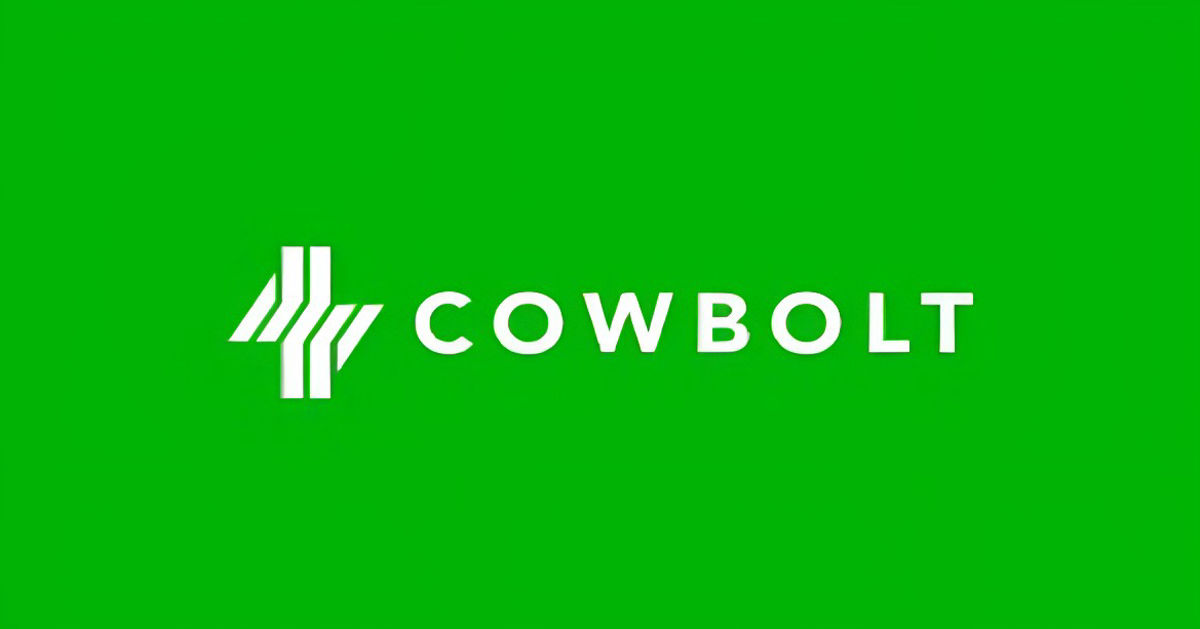
Cowbolt Announces Their Mission to Make Bitcoin Familiar to EverybodyToday at the Bitcoin Conference in Las Vegas, Cowbolt, an app that lets you split expense payments and settle in bitcoin, will launch their mission: turn peer-to-peer payments into a Bitcoin onramp, starting with family and friends.

Cowbolt will let their clients split costs and settle instantly using Bitcoin and USDT, with no middlemen, no bank friction and with self-custody. They will try to convert everyday transactions into Bitcoin adoption.
“We believe the most powerful onramp to Bitcoin isn’t an exchange — it’s people,” said the co-founder of Cowbolt Daniel Ekström. “That’s why we built Cowbolt. For friends, not hedge funds.”
What Cowbolt will bring to the table:
- Split and settle.
- Keep your keys.
- Fast and trusted.
- Works across borders.
The app is already being used for remittances, group travel, and day-to-day payments. It’s designed to be like a modern fintech app and will be available for iOS and Android.
“Building Airbnb taught me that when design is simple and gets out of the way, people do amazing things,” stated the ex-Creative Director at Airbnb & co-founder Cowbolt Tony Högqvist. “That’s the point here too. Not to store bitcoin in an ETF, but to use it between people. Effortlessly. Among teams, friends, families — every day.”

This post Cowbolt Announces Their Mission to Make Bitcoin Familiar to Everybody first appeared on Bitcoin Magazine and is written by Oscar Zarraga Perez.
-
 @ 5f078e90:b2bacaa3
2025-05-28 12:00:23
@ 5f078e90:b2bacaa3
2025-05-28 12:00:23Sylvi the seahorse

In the coral haven of Azure Bay, a seahorse named Sylvi danced with the tides. Her tail curled around a swaying frond as she watched fish dart by. One dawn, a lost pearl rolled into her nook. Sylvi, curious, nudged it along the reef, meeting crabs and eels who shared tales of the deep. By dusk, she found its oyster home. The pearl gleamed thanks, and Sylvi twirled home, her heart light as foam.
Ignore this test. This was in bold originally.
(380 chars, plain text after Markdown stripping, this was in italics originally)
Originally written on habla.news (on Nostr)
-
 @ eb0157af:77ab6c55
2025-05-28 18:01:52
@ eb0157af:77ab6c55
2025-05-28 18:01:52The IMF wants to ensure that the Central American country stops buying more bitcoins, despite President Bukele’s stance.
On May 27, the International Monetary Fund announced its intention to “guarantee” that El Salvador’s government-held Bitcoin reserves remain unchanged. This position is at odds with the statements of President Nayib Bukele, who continues to support the expansion of the country’s national Bitcoin wallet.
The announcement came as part of the first review of the Extended Fund Facility, a financing agreement that has reached a preliminary understanding between the parties. The original agreement, signed last December, includes limiting Bitcoin-related activities in exchange for a $1.4 billion financing package spread over 40 months.
Details of the agreement
The overall package could reach $3.5 billion thanks to additional support from other institutions, including the World Bank.
The Salvadoran Congress quickly approved the necessary amendments to incorporate the IMF’s terms into the Bitcoin Law. Among the most significant changes is the shift from mandatory to voluntary acceptance of Bitcoin payments in the private sector. However, although the law formally required businesses to accept Bitcoin as legal tender, this provision was never truly enforced in practice. Additionally, the country will have to cease its involvement in the Chivo wallet by the end of July.
The IMF Executive Board approved the financing agreement last February, allowing the country to receive an initial disbursement of $120 million after a separate approval by the board.
Bukele’s position
Despite the agreement with the IMF, President Bukele remains firm in his commitment to expanding the national Bitcoin reserves. In a post on X published in March, the Salvadoran leader stated:
“This all stops in April.” “This all stops in June.” “This all stops in December.”
No, it’s not stopping.
If it didn’t stop when the world ostracized us and most “bitcoiners” abandoned us, it won’t stop now, and it won’t stop in the future.
Proof of work > proof of whining https://t.co/9pC0PoY3YQ
— Nayib Bukele (@nayibbukele) March 4, 2025
Shortly after the IMF’s announcement, El Salvador’s Bitcoin Office posted on X that the country had once again purchased more BTC. According to the official tracker, El Salvador, through the Bitcoin Office, has accumulated 30 BTC in the past 30 days.
Last week, Bukele shared on X that the country’s Bitcoin reserves had recorded unrealized profits exceeding $357 million. However, when he reposted the IMF’s announcement, he made no comment regarding the section on restrictions for future Bitcoin purchases.
The IMF’s program aims to address El Salvador’s macroeconomic and structural challenges. The organization views the country’s Bitcoin reserves as a potential risk that “has not yet materialized,” but nonetheless requires limiting government involvement in Bitcoin activities and purchases.
The post El Salvador: IMF ready to block new Bitcoin purchases appeared first on Atlas21.
-
 @ a29cfc65:484fac9c
2025-05-28 10:30:32
@ a29cfc65:484fac9c
2025-05-28 10:30:32Deutschland ist eines der wenigen Länder mit einer gesetzlich verankerten ausnahmslosen Schulbesuchspflicht. Mit den Schulschließungen in der Corona-Zeit wurde das Gesetz jedoch faktisch plötzlich außer Kraft gesetzt. Alle mussten zu Hause lernen. Als die Schulen danach wieder offen waren, wurden die Kinder mit Maskenpflicht, Tests und Impfdruck gequält. Nicht selten traten bei den Schülern Krankheiten und psychische Störungen auf. Nicht wenige Eltern suchten im Gespräch mit dem Lehrerkollegium nach Lösungen für ihre Kinder. In den meisten Fällen war das nicht möglich. Die Lehrer waren auf die neue Ideologie und die Durchsetzung der Maßnahmen eingeschworen und hatten Angst. Einige Eltern haben ihre Kinder dann in eigener Verantwortung aus der Schule genommen und zu Hause selbst unterrichtet. An manchen Orten fanden sich Gemeinschaften, wo die Kinder in Gruppen lernten. Während viele Lerngemeinschaften nicht mehr existieren, hat die Familie von Katharina den Unterricht für ihre drei Kinder in Eigenregie etabliert. Inzwischen haben sie dafür sogar „den Segen“ von Familiengericht und Jugendamt.
Katharina und Johannes leben mit ihren drei Wunschkindern Aurelius (15), Benjamin (14) und Friedrich (10) in einem Vorort von Leipzig. Die Familie wohnte früher in der Stadt. In der Corona-Zeit haben sie sich mit dem Physiotherapie- & Seminarzentrum Curasanus eine Existenz auf dem Land aufgebaut und begehen diesen Sommer ihr 20-jähriges Praxis-Jubiläum. Katharina hat ihre Arbeit als Physiotherapeutin weitgehend aufgegeben, um sich als Mama und Lernbegleiterin ihren Kindern widmen zu können. Daneben bietet sie Vorträge und Workshops an, übernimmt einen großen Teil der Praxis-Organisation und ist Manager, Rezeptionistin und Vertriebler der eigenen Firma. Wir besuchten einen ihrer Lachyoga-Kurse. Dabei erlebten wir ihr Zusammenspiel mit den drei Kindern. Anschließend stellten wir Katharina unsere Fragen zum Freilernen.
Im unmittelbaren Umfeld wird die Familie bestaunt und geachtet. Sie haben sich bewusst für das Freilernen entschieden. Die Kinder wurden ohne Test nicht mehr in die Schule gelassen. Auch andere Zwangsmaßnahmen wie die Maske wollten die Eltern den Kindern ersparen. Besonders Benjamin hatte traumatische Erlebnisse. Seine Lehrerin schmiss mit dem Schlüssel nach den Schülern und wandte andere schwarze Pädagogik an. Er ging ständig mit Bauchschmerzen ins Bett. Ein weiterer Punkt ist die Masernimpfung. Die Kinder könnten zwar zur Schule gehen, aber die Eltern werden mit rechtlichen Maßnahmen und Zwangszahlungen belegt. Da Katharina in ihrer Praxis viele Erkrankungen als Folge der Masernimpfung beobachten konnte, lehnt sie die Pflichtimpfung ab. Die Eltern haben kein Vertrauen mehr in die staatliche Schulerziehung mit all dem Zwang und den Erpressungen. Als die Familie den Entschluss gefasst hatte, die Kinder nicht mehr in die Schule zu schicken, haben sie ihre Praxis vorübergehend geschlossen, ihr Haus verkauft und sind auf Reisen gegangen. Die beiden großen Kinder wurden von der Schule abgemeldet. Nach der Rückkehr haben sie dann mit einem neuen Leben auf dem Land begonnen.
Lernen ohne Schule: Wie geht das?
„Wissen ist Macht und eine Holschuld“, sagt uns Katharina. Das ist ihr Motto und motiviert auch die Kinder. Mit dem Unterricht zu Hause macht die Familie ihre eigene Studie und zeigt, dass Lernen auch anders geht als in der Schule. Die Eltern können viel besser auf jedes einzelne Kind eingehen. Johannes arbeitete früher als Straßenbauer. Er unterstützt die Jungs vor allem in Mathematik, Geometrie und Physik sowie bei handwerklichen Fertigkeiten. Katharinas Stärken liegen in Deutsch, Sprachen und Organisation. Unter den Patienten ihrer Praxis gibt es Lehrer, die ihnen helfen. Weitere Unterstützung kommt von Freunden und Bekannten. Bei bestimmten Projekten treffen sie auf andere Freilernerkinder. „Das Netzwerk wird immer größer, es wird immer schöner und interessanter“, sagt Katharina. Man geht mit vielen anderen einen gemeinsamen Weg, verlässt dabei eingetretene Pfade und erkundet neue Themenfelder wie Mediengestaltung, freie Energie, Elektrotherapie, meditatives und Improvisations-Zeichnen. „Ich sprudele vor Ideen. Sie kommen in mein Feld, und dann mache ich was draus“, sagt Katharina. Die Jungs sind in Wurzen im Ringelnatz-Literaturkreis. Dort schreiben sie Drehbuchgeschichten und haben einen Film produziert. Sie suchen sich Projekte oder kreieren neue, wie mit dem Planetarium Eilenburg. Diese Zusammenarbeit hat sich sehr gut entwickelt. Dort lernen 4- bis 15-Jährige zusammen. Die drei Jungs spielen Klavier. Erdkunde und Geschichte erleben die Kinder auch dadurch, dass die Familie Hauptstädte oder die bosnischen Pyramiden selbst erkundet. Dabei erweist es sich als Vorteil, nicht auf die Ferienzeiten angewiesen zu sein.
Als Physiotherapeutin ist Katharina bewusst, dass man neue Lernstrategien entwickeln muss. Die Kinder lernen unterschiedlich. Jedes Kind hat seinen eigenen Charakter. Aurelius benötigt eher eine 1:1-Betreuung. Darauf kann Katharina viel individueller eingehen als die staatliche Schule. Es ist aber auch aufwendiger und anstrengender. Besonderen Wert legt sie darauf, dass rechte und linke Gehirnhälfte gleichmäßig beansprucht werden. Lernphasen werden immer wieder mit Entspannungs- oder Bewegungsphasen kombiniert. Sie weiß, dass den Kindern zuerst die Grundlagen des Lesens, Rechnens und Schreibens vermittelt werden müssen. Dann sind sie in der Lage, sich alles Weitere selbst anzueignen – Unterstützung vorausgesetzt. „Besonders das Schreiben mit der eigenen Hand ist wichtig für die Vernetzung der beiden Gehirnhälften“, sagt Katharina. Dafür nehmen sich die Eltern Zeit. Die Kinder führen Tagebuch. Außerdem halten es die Eltern für wichtig, den Kindern Werte und Tugenden wie Dankbarkeit, Verlässlichkeit, Beharrlichkeit, Aufrichtigkeit, Ehrlichkeit und die zehn Gebote zu vermitteln. Katharina und Johannes sind beide religiös begleitet aufgewachsen. Heute sehen sie die Kirche als Institution kritisch. Angebunden an die Schöpfung und im Gottvertrauen erschaffen und schöpfen sie Leben und Lebensraum aus eigener Kraft – so erklärt es uns Katharina.
Ein weiteres Thema sind die Funktionen des Körpers und wie sich die Kinder gesund erhalten können. Vieles lernen sie dabei in der Physiotherapiepraxis. Die Familie hat das Privileg, in ihrem eigenen Biorhythmus leben zu können. „Das macht sehr viel aus – wir sind alle gesund“, sagt Katharina. Der Lern- und Arbeitstag beginnt nicht vor 9 Uhr und hat eine eigene Struktur. Im Tagesablauf sind feste Verantwortlichkeiten integriert. So wechseln sich die Kinder aller drei Tage mit Tischdecken, Staubsaugen und Geschirrspüler ab. Das hilft ihnen, sich selbst zu organisieren. Das geht nicht immer reibungslos vonstatten. Wenn das Lernpensum beizeiten abgearbeitet wurde, helfen die Kinder im Haushalt oder Garten oder gehen ihrem Bewegungsdrang auf andere Weise nach. Die Eltern sind am Abend noch länger aktiv, denn die Praxis erfordert noch die eine oder andere bürokratische Pflicht. Die Familie ist sehr naturverbunden. Sie gehen viel in den Wald und in den Garten. Sie bauen selbst Gemüse und Obst an. Dabei können die Kinder zum Beispiel Erfahrungen mit Permakultur und natürlicher Düngung sammeln. Die Familie achtet auf die Ernährung, schließlich ist Katharina seit fast 25 Jahren Ernährungsberaterin. Was sie nicht selbst anbauen, wird beim Bauern des Vertrauens eingekauft. Die Jungs können selbst kochen und backen. Die Schädlichkeit von Zucker ist den Kindern schon bewusst geworden, ohne gänzlich auf Schokolade verzichten zu müssen. Medikamente gibt es im Haushalt nicht. Sie kennen sich sehr gut mit den Heilmitteln aus der Natur aus und können so ihre Selbstheilungskräfte aktivieren. Sie haben keinen Hausarzt. Natürlich hat keines der Kinder ein Handy. Bisher haben sie noch kein Verlangen danach. Die Eltern halten es für wichtig, dass die Kinder erst sicher bei Selbstorganisation und Tagesstruktur sind, bevor sie ein Handy bekommen. Katharina weist darauf hin, dass beispielsweise WhatsApp erst ab 16 Jahren zugelassen ist, und fragt sich, ob das andere Eltern wissen.
Gesetze auf Augenhöhe auslegen
Den Behörden blieben die Freilerner nicht verborgen. Sie wurden aktiv und schalteten das Familiengericht ein. Die Familie hatte keinen Anwalt und keine Rechtsschutzversicherung. Katharina erzählt uns, dass sie schließlich auf „Hilfe von oben“ gehofft habe. Irgendwer hat sie anscheinend erhört, denn sie bekamen „einen Engel“ als Verfahrensbeistand. Die Behörden waren sehr zugänglich. In den Gesprächen gab man zu, mit der Schulsituation ebenfalls nicht zufrieden zu sein. „Wir wollen so wie ihr, dass sich etwas verändert. Wir sind an Eurer Seite.“ Die Gespräche mit dem Jugendamt und der Richterin vom Familiengericht Grimma waren immer auf Augenhöhe. Schließlich legte man der Familie keine Steine in den Weg. Damit kann Katharina ihr Konzept nach außen leben und andere inspirieren. Ihre Schlussfolgerung: Eltern müssen sich ihrer Stärken bewusst werden und aus ihrer Angst herauskommen. Das Konzept muss aber zur Familie passen, denn jede Familie ist anders.
Die Basis für freies Lernen ist das Vertrauen der Eltern in ihre Kinder. Denn Kinder sind von Natur aus wissbegierig und wollen lernen. Katharina hat viel von Bertrand Stern und von Riccardo Leppe gelernt. Beiden wurde von ihren Eltern das Lernen ohne Schulbesuch ermöglicht. Mit Bertrand Stern hat Katharina Kontakt. Er wird im November am Buß- und Bettag eine kleine Fortbildung im Therapie- und Seminarzentrum geben. Für den Vorabend ist ein Vortrag geplant. Katharina zitiert Riccardo Leppe: „Es ändert sich nur was, wenn man es selbst tut.“ Er sei sich sicher, dass der Fortschritt beim Freilernen inzwischen so weit ist, dass „die Paste nicht wieder zurück in die Tube geht“.
Der Übergang zur Berufsausbildung
Die ersten Freilernerkinder kommen jetzt in das Alter, in dem sie eine Berufsausbildung beginnen können. Aurelius und Benjamin, die beiden „Großen“, machen seit Anfang des Jahres schon erste Praktika bei ortsansässigen Handwerksbetrieben. Beide Seiten sind sehr zufrieden. Durch die Praktika, die länger dauern als im schulischen Lehrplan vorgesehen, können sich die Kinder ausprobieren. Katharina findet es interessant miterleben zu dürfen, wie auf ihre Kinder reagiert wird. Bringen sie etwas mit, das die anderen nicht haben? Denken sie anders mit? Benjamin bekam schon ein Angebot, in einem Metallbau-Betrieb stundenweise mitzuarbeiten. In den Betrieben weiß man, dass die Abschlüsse der staatlichen Schulen größtenteils das Papier nicht wert sind, auf dem sie stehen. Viele verlassen die Schule und können kaum lesen und schreiben, von Selbstorganisation ganz zu schweigen. Ein Freilerner kann eine staatliche Externen-Prüfung ablegen, um einen Haupt- oder Realschulabschluss zu erwerben. Katharina: „Für eine Ausbildung bei einem privaten Unternehmer braucht man das nicht, allein der Unternehmer entscheidet über die Aufnahme des Auszubildenden“. Außerdem stehen den jungen Leuten Privatschulen oder der zweite Bildungsweg zur Verfügung. Wenn man einen praktischen Beruf ergreift, ist es immer noch möglich, sich bis zur Hochschulreife weiterzubilden. Nach mehrjährigen Tätigkeiten kann man bei den Kammern von Industrie, Handel und Handwerk (IHK und HWK) eine Abschlussprüfung ablegen, mit der man zum Studium zugelassen werden kann. Oder man geht gleich den Weg in die Selbstständigkeit.
Frei lernen weitergedacht
Während der Coronazeit haben sich in Sachsen und speziell um Leipzig herum kleine Freilernergruppen gefunden. Die Gruppen werden aktuell zusammengeführt, um zum Beispiel gemeinsam den Mathematikunterricht zu gestalten. Besonders um Dresden herum ist die Szene noch stärker ausgeprägt. Außerdem gibt es seit mehr als 20 Jahren den Bundesverband Natürlich Lernen (BVNL). Er bietet Beratung und zentrale Veranstaltungen an.
Der Wunsch nach dem freien Lernen ohne Schulzwang ist groß. Doch die meisten Eltern wollen ihre Kinder dafür irgendwo abgeben und nicht selbst unterrichten. Katharinas größter Wunsch ist es, drei bis fünf Elternpaare zu finden, die sich in die Betreuung und Unterrichtung ihrer Kinder teilen. Das größte Hindernis dafür sieht sie in den Eltern selbst. Durch ungelöste transgenerative Konflikte und unverarbeitete Familientraumata kommen sie noch nicht in ihre eigene Kraft für ein selbstbestimmtes Leben. Viele wagen es noch nicht, ihre Erwerbstätigkeit zugunsten der Kinder einzuschränken. Katharina sieht es als große Aufgabe für sich und ihre Familie, mit dem Freilernen das Gemeinschaftsbewusstsein und gute Konfliktlösungsstrategien zu entwickeln. Sie denkt dabei bereits an ihre Enkel. Aber sie weiß auch, dass die Eltern ein sehr hohes Maß an Eigeninitiative, Motivation und Selbstdisziplin aufbringen müssen. Sie würde Eltern, die sich das noch nicht zutrauen, als Traumabegleiterin zur Verfügung stehen, für einen angemessenen Energieausgleich. Diese gegenseitige Unterstützung käme Kindern und Eltern zugute. Ebenso hält sie die Idee der Mehrgenerationenerziehung für wichtig. Dabei profitieren nicht nur die Kinder. Die Erfahrungen der älteren Menschen gehen nicht verloren, sondern werden an die jüngeren Generationen weitergegeben und machen sie resilienter. Das hilft den Eltern, ihrer Erwerbsarbeit nachzugehen und Familientraumata zu bewältigen.
Katharina ist eine starke Frau und sprüht nur so vor Energie. Selbst als wir nach 21 Uhr das Therapiezentrum verlassen, sind ihr die Anstrengungen des Tages nicht anzumerken. Sie wird nicht müde beim Sprechen. Für Fragen zum Thema Freilernen kann man sich an sie wenden.
Der Text wurde zuerst am 27.05.2025 im Blog „Freie Akademie für Medien und Journalismus“ veröffentlicht (https://www.freie-medienakademie.de/medien-plus/lernen-neu-gemacht)
Bildquelle: Salah Darwish, unsplash.com
-
 @ b1ddb4d7:471244e7
2025-05-28 18:01:17
@ b1ddb4d7:471244e7
2025-05-28 18:01:17When Sergei talks about bitcoin, he doesn’t sound like someone chasing profits or followers. He sounds like someone about to build a monastery in the ruins.
While the mainstream world chases headlines and hype, Sergei shows up in local meetups from Sacramento to Cleveland, mentors curious minds, and shares what he knows is true – hoping that, with the right spark, someone will light their own way forward.
We interviewed Sergei to trace his steps: where he started, what keeps him going, and why teaching bitcoin is far more than explaining how to set up a node – it’s about reaching the right minds before the noise consumes them. So we began where most journeys start: at the beginning.

First Steps
- So, where did it all begin for you and what made you stay curious?
I first heard about bitcoin from a friend’s book recommendation, American Kingpin, the book about Silk Road (online drug marketplace). He is still not a true bitcoiner, although I helped him secure private keys with some bitcoin.
I was really busy at the time – focused on my school curriculum, running a 7-bedroom Airbnb, and working for a standardized test prep company. Bitcoin seemed too technical for me to explore, and the pace of my work left no time for it.
After graduating, while pursuing more training, I started playing around with stocks and maximizing my savings. Passive income seemed like the path to early retirement, as per the promise of the FIRE movement (Financial Independence, Retire Early). I mostly followed the mainstream news and my mentor’s advice – he liked preferred stocks at the time.
I had some Coinbase IOUs and remember sending bitcoin within the Coinbase ledger to a couple friends. I also recall the 2018 crash; I actually saw the legendary price spike live but couldn’t benefit because my funds were stuck amidst the frenzy. I withdrew from that investment completely for some time. Thankfully, my mentor advised to keep en eye on bitcoin.
Around late 2019, I started DCA-ing cautiously. Additionally, my friend and I were discussing famous billionaires, and how there was no curriculum for becoming a billionaire. So, I typed “billionaires” into my podcast app, and landed on We Study Billionaires podcast.
That’s where I kept hearing Preston Pysh mention bitcoin, before splitting into his own podcast series, Bitcoin Fundamentals. I didn’t understand most of the terminology of stocks, bonds, etc, yet I kept listening and trying to absorb it thru repetition. Today, I realize all that financial talk was mostly noise.
When people ask me for a technical explanation of fiat, I say: it’s all made up, just like the fiat price of bitcoin! Starting in 2020, during the so-called pandemic, I dove deeper. I religiously read Bitcoin Magazine, scrolled thru Bitcoin Twitter, and joined Simply Bitcoin Telegram group back when DarthCoin was an admin.
DarthCoin was my favorite bitcoiner – experienced, knowledgeable, and unapologetic. Watching him shift from rage to kindness, from passion to despair, gave me a glimpse at what a true educator’s journey would look like.
The struggle isn’t about adoption at scale anymore. It’s about reaching the few who are willing to study, take risks, and stay out of fiat traps. The vast majority won’t follow that example – not yet at least… if I start telling others the requirements for true freedom and prosperity, they would certainly say “Hell no!”
- At what point did you start teaching others, and why?
After college, I helped teach at a standardized test preparation company, and mentored some students one-on-one. I even tried working at a kindergarten briefly, but left quickly; Babysitting is not teaching.
What I discovered is that those who will succeed don’t really need my help – they would succeed with or without me, because they already have the inner drive.
Once you realize your people are perishing for lack of knowledge, the only rational thing to do is help raise their level of knowledge and understanding. That’s the Great Work.
I sometimes imagine myself as a political prisoner. If that were to happen, I’d probably start teaching fellow prisoners, doctors, janitors, even guards. In a way we already live in an open-air prison, So what else is there to do but teach, organize, and conspire to dismantle the Matrix?
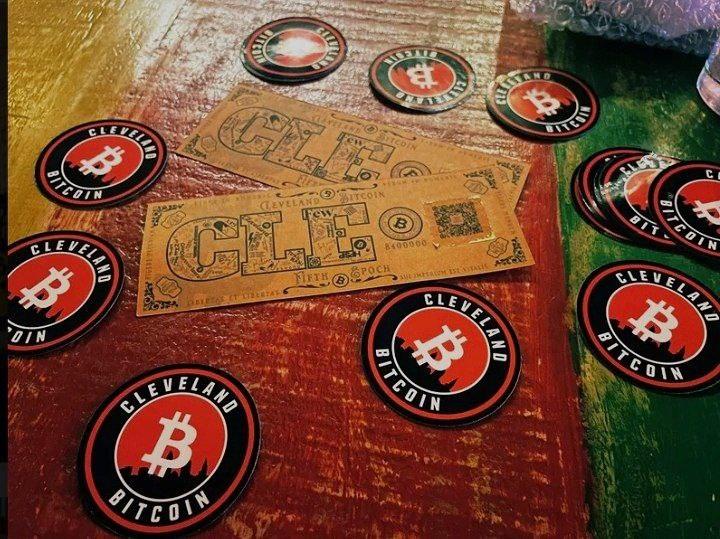
Building on Bitcoin
- You hosted some in-person meetups in Sacramento. What did you learn from those?
My first presentation was on MultiSig storage with SeedSigner, and submarine swaps through Boltz.exchange.
I realized quickly that I had overestimated the group’s technical background. Even the meetup organizer, a financial advisor, asked, “How is anyone supposed to follow these steps?” I responded that reading was required… He decided that Unchained is an easier way.
At a crypto meetup, I gave a much simpler talk, outlining how bitcoin will save the world, based on a DarthCoin’s guide. Only one person stuck around to ask questions – a man who seemed a little out there, and did not really seem to get the message beyond the strength of cryptographic security of bitcoin.
Again, I overestimated the audience’s readiness. That forced me to rethink my strategy. People are extremely early and reluctant to study.
- Now in Ohio, you hold sessions via the Orange Pill App. What’s changed?
My new motto is: educate the educators. The corollary is: don’t orange-pill stupid normies (as DarthCoin puts it).
I’ve shifted to small, technical sessions in order to raise a few solid guardians of this esoteric knowledge who really get it and can carry it forward.
The youngest attendee at one of my sessions is a newborn baby – he mostly sleeps, but maybe he still absorbs some of the educational vibes.
- How do local groups like Sactown and Cleveland Bitcoiners influence your work?
Every meetup reflects its local culture. Sacramento and Bay Area Bitcoiners, for example, do camping trips – once we camped through a desert storm, shielding our burgers from sand while others went to shoot guns.
Cleveland Bitcoiners are different. They amass large gatherings. They recently threw a 100k party. They do a bit more community outreach. Some are curious about the esoteric topics such as jurisdiction, spirituality, and healthful living.
I have no permanent allegiance to any state, race, or group. I go where I can teach and learn. I anticipate that in my next phase, I’ll meet Bitcoiners so advanced that I’ll have to give up my fiat job and focus full-time on serious projects where real health and wealth are on the line.
Hopefully, I’ll be ready. I believe the universe always challenges you exactly to your limit – no less, no more.
- What do people struggle with the most when it comes to technical education?
The biggest struggle isn’t technical – it’s a lack of deep curiosity. People ask “how” and “what” – how do I set up a node, what should one do with the lightning channels? But very few ask “why?”
Why does on-chain bitcoin not contribute to the circular economy? Why is it essential to run Lightning? Why did humanity fall into mental enslavement in the first place?
I’d rather teach two-year-olds who constantly ask “why” than adults who ask how to flip a profit. What worries me most is that most two-year-olds will grow up asking state-funded AI bots for answers and live according to its recommendations.
- One Cleveland Bitcoiner shows up at gold bug meetups. How valuable is face-to-face education?
I don’t think the older generation is going to reverse the current human condition. Most of them have been under mind control for too long, and they just don’t have the attention span to study and change their ways.
They’re better off stacking gold and helping fund their grandkids’ education. If I were to focus on a demographic, I’d go for teenagers – high school age – because by college, the indoctrination is usually too strong, and they’re chasing fiat mastery.
As for the gold bug meetup? Perhaps one day I will show up with a ukulele to sing some bitcoin-themed songs. Seniors love such entertainment.
- How do you choose what to focus on in your sessions, especially for different types of learners?
I don’t come in with a rigid agenda. I’ve collected a massive library of resources over the years and never stopped reading. My browser tab and folder count are exploding.
At the meetup, people share questions or topics they’re curious about, then I take that home, do my homework, and bring back a session based on those themes. I give them the key takeaways, plus where to dive deeper.
Most people won’t – or can’t – study the way I do, and I expect attendees to put in the work. I suspect that it’s more important to reach those who want to learn but don’t know how, the so-called nescient (not knowing), rather than the ignorant.
There are way too many ignorant bitcoiners, so my mission is to find those who are curious what’s beyond the facade of fake reality and superficial promises.
That naturally means that fewer people show up, and that’s fine. I’m not here for the crowds; I’m here to educate the educators. One bitcoiner who came decided to branch off into self-custody sessions and that’s awesome. Personally, I’m much more focused on Lightning.
I want to see broader adoption of tools like auth, sign-message, NWC, and LSPs. Next month, I’m going deep into eCash solutions, because let’s face it – most newcomers won’t be able to afford their own UTXO or open a lightning channel; additionally, it has to be fun and easy for them to transact sats, otherwise they won’t do it. Additionally, they’ll need to rely on
-
 @ cae03c48:2a7d6671
2025-05-28 18:01:12
@ cae03c48:2a7d6671
2025-05-28 18:01:12Bitcoin Magazine

White House Executive Director Bo Hines Declares U.S. The Future Global Crypto SuperpowerIn a session at the Bitcoin 2025 Conference this morning titled “_Making America the Global Bitcoin Superpower“_, Bo Hines, White House Executive Director, Tyler Williams, from the US Treasury Department, and moderator Miles Jennings made one thing clear: the United States is going all-in on Bitcoin—and fast.
JUST IN:
 President Trump's Executive Director said "Bitcoin is the golden standard."
President Trump's Executive Director said "Bitcoin is the golden standard." "We're not gonna sell any Bitcoin that we possible have in the US government, period."
 pic.twitter.com/F6Dv2nUk9b
pic.twitter.com/F6Dv2nUk9b— Bitcoin Magazine (@BitcoinMagazine) May 27, 2025
“We are well on our way to becoming the bitcoin superpower of the world,” said Bo Hines. “This is something that is not partisan. This is a revolution in our financial system.”
Moderator Miles Jennings pointed to key regulatory steps currently in motion. “If the bill becomes law (and I hope it does) we will have quite an active role. The connective tissue between the legacy financial system and bitcoin, stablecoins, and everything else will really be paved with stablecoin legislation,” Jennings said.
Hines emphasized that, “Updating the payment rails is necessary and we are well on our way to achieving that.” He also noted that upcoming market structure legislation will define how intermediaries like exchanges and brokers are regulated and how digital assets are classified—either as securities or commodities.
“We want folks to innovate here,” Hines stressed. “We can’t be fearful of them walking into the SEC and getting a Wells notice before they get on the elevator.” He added that U.S. regulators are now encouraging crypto innovators to return: “Our message to folks who have gone offshore is: welcome home_._”
Williams highlighted that any new laws must reflect the unique architecture of decentralized finance. “Traditional markets are based on a principal-agent model,” he explained. “But crypto moves us toward a principal-to-principal structure.”
He noted that after regulatory support for the ETP marketplace, institutional Bitcoin adoption surged—and believes the same would happen again under stablecoin and market structure legislation.
The most bullish comment of the morning came from Hines: “Bitcoin is truly the golden standard… This is an asset that we should be harnessing on behalf of the American people. We want as much as we can possibly get.”
“We are going big on digital assets,” added Tyler. “You will certainly see the United States stepping out as the bitcoin superpower of the world,” Hines concluded.
You can watch the full panel discussion and the rest of the Bitcoin 2025 Conference Industry Day below:
https://www.youtube.com/live/3e3KE40r_WM?si=LCZcZeKbxi_iTk62This post White House Executive Director Bo Hines Declares U.S. The Future Global Crypto Superpower first appeared on Bitcoin Magazine and is written by Jenna Montgomery.
-
 @ 005bc4de:ef11e1a2
2025-05-28 09:05:10
@ 005bc4de:ef11e1a2
2025-05-28 09:05:10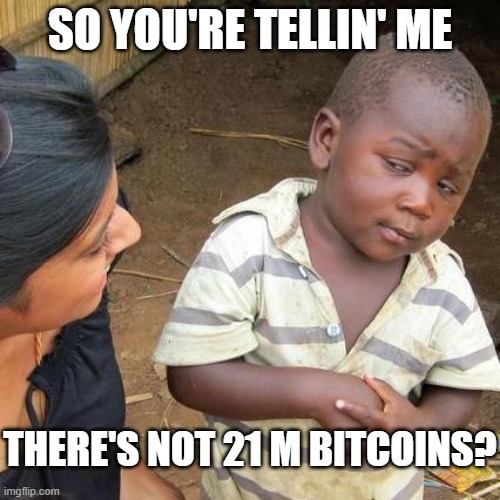
BIP-2,100,000,000,000,000,000
So, you're telling me...
- 21 million bitcoins is out, and...
- 2.1 quadrillion sats is in, except that...
- sats are out, so...
- 2.1 quadrillion bitcoins is in, except that...
- there are actually millisats, but...
- millisats are out, so...
- millibitcoins are in, so now...
- there are 2.1 quintillion millibitcoins, except that...
- millibitcoins are the basic base unit of bitcoin, so...
- millibitcoins are out, and now...
- 2.1 quintillion bitcoins are in

-
 @ 6a6be47b:3e74e3e1
2025-05-28 17:37:11
@ 6a6be47b:3e74e3e1
2025-05-28 17:37:11Hi frens! 🌞
How was your day? Mine was pretty great! Not to brag—I just try to see things in a positive light. Even when a day is “meh” or downright awful, I look for at least one good thing in it. Sometimes, let’s be real, there isn’t even one. Some days, weeks, or even months can just be tough. But even that shall pass.
✨ So, let’s try to focus on at least one good thing around us, or within us. Who knows—maybe a little magic can happen…
🎨 Today, I made time for some drawing on Procreate—yaaay! If you caught yesterday’s discussion, you know I drew a butterfly 🦋. Maybe with today’s drawing, you’ll be able to guess my next blog entry 👀
Today’s subject: Cytisus scoparius, better known as “Scotch broom” (or Scots broom).
🔍 I used to mix it up with gorse, but there are some telltale differences:
“Broom is similar to common gorse in size, shape and flower colour, but it lacks the spines and has short, flattened leaves and larger flowers.” — The Wildlife Trusts
⭐️Fun fact: I actually painted a gorse not too long ago for my Beltane post.
🚨 A word of caution though—don’t get too close! Scotch broom is harmful if eaten, so keep an eye out for your pets when you’re out and about, according to rhs.org.uk
🌼 I love spotting these bright yellow blooms by the highway or just outside town. That color is chef’s kiss—it really brightens up any drive!
💐That’s all for today. I’m super excited to hear what you think!
Take care and godspeed, my frens! 🚀✨
https://stacker.news/items/991324
-
 @ 21810ca8:f2e8341e
2025-05-28 08:10:53
@ 21810ca8:f2e8341e
2025-05-28 08:10:53Ich bin neu bei Nostr und versuche mich hier rein zu fuchsen. Kann das einer sehen? Und dann habe ich noch viele Fragen
Gibt es gute Marktplätze wie ebay oder ebay kleinanzeigen wo man stink normale dinge und kram von zuhause gegen sat verkaufen kann.
-
 @ 9ca447d2:fbf5a36d
2025-05-28 17:01:11
@ 9ca447d2:fbf5a36d
2025-05-28 17:01:11Panama City may be the next Latin American city to adopt bitcoin, after El Salvador.
Panama City Mayor Mayer Mizrachi has got the bitcoin world excited after hinting that the city might have a bitcoin reserve. The speculation started on May 16 when Mizrachi posted a simple but powerful message on X:
Two words. That’s it. What makes it special is that it came after a high-profile meeting with Max Keiser and Stacy Herbert, two key figures behind El Salvador’s bitcoin strategy.
Keiser is an advisor to El Salvador’s President Nayib Bukele and Herbert leads the country’s Bitcoin Office.
El Salvador became the first country to adopt bitcoin as legal tender back in 2021. Since then, it has been building a national bitcoin reserve, currently holding 6,179 BTC worth around $640 million. It’s also using geothermal energy to power bitcoin mining in an eco-friendly way.

El Salvador’s bitcoin treasury — Bitcoin.gob.sv
Mizrachi’s meeting with Keiser and Herbert was about how Panama could do the same. While the details of the conversation are private, Keiser shared on social media that the two countries will play a big role in the future of Bitcoin.
“Bitcoin is transforming Central America,” Keiser wrote. “El Salvador’s geothermal & Panama’s hydro-electric will power the Bitcoin revolution.”

Max Keiser on X
Panama with its hydroelectric power could be a hub for green bitcoin mining.
Mizrachi has not announced a bitcoin reserve plan nor submitted a proposal to the National Assembly. But his post and public appearances suggest it’s being considered.
He will be speaking at the upcoming Bitcoin 2025 Conference in Las Vegas just days after his social media post. Many expect he will share more about Panama City’s bitcoin plans during his talk.
If Mizrachi pushes for a bitcoin reserve, he will need to work with national lawmakers to pass new legislation. So far, there is no evidence of that.
Even without a bitcoin reserve, Panama City is already going big on digital assets.
In April 2025, the city council approved a measure to allow residents to pay taxes, fees, fines and permits with digital currencies. Supported tokens are bitcoin (BTC), ethereum (ETH), USD Coin (USDC) and Tether (USDT).
To comply with financial laws, the city has partnered with a bank that instantly converts these digital assets into U.S. dollars. According to Mizrachi, this way it’s easier for residents to use digital assets and the city’s financial operations will be transparent and legal.
Another part of the meeting with El Salvador’s advisors was education.
Stacy Herbert confirmed that Panama City will be integrating El Salvador’s financial literacy book, “What is Money?” into their digital library system. The goal is to help students, teachers and the general public understand bitcoin and digital currencies in modern finance.
This is a trend in Latin America where countries are looking for alternatives to traditional banking systems. Inflation, economic instability and the rise of decentralized finance are forcing governments to look into new financial tools.
-
 @ 3770c235:16042bcc
2025-05-28 05:54:01
@ 3770c235:16042bcc
2025-05-28 05:54:01** Introduction: The Neon Pulse of Las Vegas
**It’s 2:30 AM on a Tuesday. The Strip hums with laughter, clinking glasses, and the occasional Elvis impersonator. A group of friends stumbles out of a nightclub, squinting under the glow of a Las Vegas billboard that screams, “Hungry? $5 Pancakes → 1 Block Right!” Ten minutes later, they’re drowning their late-night cravings in syrup.This isn’t luck—it’s Las Vegas billboards doing what they do best: working while the rest of the world sleeps. In a city where the party never stops, these glowing giants are the ultimate salespeople. Let’s dive into why Las Vegas billboards outshine traditional ads and how your business can ride their 24/7 energy wave.
** Why Las Vegas Billboards Never Take a Coffee Break
** 1. Tourists Don’t Have Bedtimes (and Neither Do Billboards)
- 42 million visitors flock to Vegas yearly. They’re sipping margaritas at noon, gambling at midnight, and shopping at 3 AM.
- Las Vegas billboards near hotspots like the Bellagio Fountains or Fremont Street catch eyes round the clock.Real Story:
A donut shop owner named Luis rented a billboard near the “Welcome to Vegas” sign. His message? “Jet Lagged? Sugar Fix Open 24/7!” Sales tripled—especially between 1 AM and 4 AM.** 2. You Can’t “Skip” a Billboard
** - Imagine this: You’re stuck in traffic on the Strip. Your phone’s dead. That Las Vegas billboard for air-conditioned massages? It’s your lifeline.
- Compare that to online ads: 47% of people skip them, and TikTok ads vanish in a scroll.- Vegas Thrives on Impulse
- Billboards tap into spontaneous decisions:
- “Let’s try that rooftop bar!”
- “Wait, free slot play? Let’s U-turn!”
- Traditional ads (like radio spots) fade fast. Billboards linger, nudging tourists to act now.
** 5 Reasons Your Business Needs a Vegas Billboard
** 1. Size Matters (And So Does Flash)
- Strip billboards can be taller than a 5-story building.
- Digital screens use LEDs so bright, they’re visible from space.Pro Tip:
A casino added fake “smoke” effects to their billboard for a Halloween promo. Traffic backed up for selfies—and bookings spiked.- No Language Barrier
- Vegas draws visitors from Tokyo, Berlin, São Paulo...
- A Las Vegas billboard with a giant cocktail emoji? Universal for “Drinks here!”
Case Study:
A Korean BBQ spot used a billboard of sizzling meat. No words. Just smoke visuals. Tourists followed the “aroma” straight to their door.- They’re Always in the Right Place, Right Time
- 6 AM: Joggers see smoothie ads.
- 3 PM: Pool partiers spot “Free Margarita” promos.
-
Midnight: Hangover clinics whisper, “We’ve got IVs.”
-
Instant Trust Boost
- A tiny online ad says “startup.” A glowing billboard says, “We’re Vegas royalty.”
Jake’s Win:
Jake’s tiny magic shop rented a billboard reading, “Real Tricks—Cheaper Than the Casino!” Tourists treated him like David Blaine.- QR Codes = Instant Customers
- “Scan for free parking!” → 1,000 scans in a weekend.
- “Tap to call a limo” → Rides booked before the light turns green.
** How to Make Your Vegas Billboard Irresistible
** Step 1: Claim Your Territory
- The Strip: Pricey but prime ($15k–$60k/month).
- Fremont Street: Quirky, cheaper ($5k–$20k), packed with partiers.
- Highway 15: Target road-trippers with “Almost There! Cold Beer Ahead!”Step 2: Keep It Stupid Simple
- Bad: “Experience Culinary Excellence at Our Artisanal Bistro!”
- Good: “24/7 Bacon Pancakes → Exit Here.”Maria’s Hack:
Maria’s tattoo parlor used a billboard with a flaming skull and three words: “Walk-Ins Welcome.” No phone number. “People just… show up,” she laughs.Step 3: Track Your Wins (Like a Vegas High Roller)
- QR Codes: “Scan for Free Slot Play!” → Track scans.
- Unique URLs: “Visit VegasPizza24.com” → Monitor traffic.
- Old-School: Count foot traffic. (“Did that bachelor party just roll in from our billboard? Yes.”)**FAQs ** 1. “How do I even measure if my billboard’s working? It’s not like online ads!”
Answer:
You’re right—it’s not just clicks and likes. But here’s how real businesses track success:
- QR Codes: Add a unique code like “Scan for Free Appetizer!” Track scans.
- Promo Codes: “Mention this billboard for 20% off!” (Works great for Uber drivers: “My passengers blurt it out mid-ride,” says driver Luis M.)
- Foot Traffic Spikes: Note sales surges after your ad goes live. A dispensary saw a 60% bump in visits after their “We’re Closer Than the Casino!” billboard.
- Social Media Tags: Encourage selfies with your billboard. A retro motel offered a free pool pass for tagged photos. Their Instagram exploded.- “Aren’t billboards old-school? My Gen Z customers live on TikTok!”
Answer:
Billboards in Vegas are anything but old-school. Here’s why: - Hybrid Campaigns: Pair billboards with geofenced mobile ads. Example: A billboard for a pool party says, “Scan to Pre-Order Drinks.” Users nearby get a TikTok-style ad on their phone.
- Instagrammable Designs: Quirky billboards go viral. The “Welcome to Vegas” sign is the most Instagrammed spot in the city. Mimic that vibe!
- Influencer Collabs: Pay a Vegas influencer to pose with your billboard. Their followers will hunt it down like a scavenger hunt.
Real Story:
A vintage clothing store’s billboard (“Find Your Retro Vibe → 2 Blocks East”) became a TikTok trend after a local influencer did a “thrift haul” video there.** 3. “What’s the biggest mistake businesses make with Vegas billboards?”
** Answer:
Trying to cram in too much info! Drivers have 5–7 seconds to read your ad. Avoid:
- Text Overload: “Grand Opening! 50% Off! Open 24/7! Call Now!” → Too much!
- Bland Designs: Gray text on a gray background? Yawn.
- Ignoring Locals: Tourists are 70% of viewers, but locals matter too. A gym’s billboard said, “Tired of Tourists? Work Out in Peace.” Memberships spiked.Fix It:
- Use 7 words max.
- Bold colors (red, yellow, neon pink).
- Add a clear call to action: “Turn Right Now!” or “Scan for Free Parking.”- “Do I need a permit? What if my ad gets rejected?”
Answer:
Yep, permits are a thing. The city bans: - Flashing Lights Near Residences: No strobes in suburban areas.
- Certain Content: No swear words, adult themes, or political fights.
How to Avoid Rejection:
- Work with local Outdoor Advertising companies—they know the rules.
- Submit designs early. One pizza joint’s ad was flagged for a pepperoni slice deemed “too suggestive.” They swapped it to a cheese pull… and it got approved.Conclusion: Let Your Business Shine All Night Long
At 5 AM, as the sun peeks over the desert, the Las Vegas billboards keep glowing. They’ve sold midnight pancakes, inspired shotgun weddings, and even talked someone out of a questionable tattoo (“Wait! Our Parlor’s Better → Next Exit”).These aren’t just ads—they’re part of Vegas’ heartbeat. So whether you’re slinging sushi, massages, or monster truck rides, remember: In a city that never sleeps, your billboard shouldn’t either.
Ready to Light Up the Night?
Find Las Vegas billboards near you today. And if you spot one that says, “Free High-Fives for Readers of This Article,” honk twice. It’s probably yours. -
 @ 7f6db517:a4931eda
2025-05-28 16:01:56
@ 7f6db517:a4931eda
2025-05-28 16:01:56
@matt_odell don't you even dare not ask about nostr!
— Kukks (Andrew Camilleri) (@MrKukks) May 18, 2021
Nostr first hit my radar spring 2021: created by fellow bitcoiner and friend, fiatjaf, and released to the world as free open source software. I was fortunate to be able to host a conversation with him on Citadel Dispatch in those early days, capturing that moment in history forever. Since then, the protocol has seen explosive viral organic growth as individuals around the world have contributed their time and energy to build out the protocol and the surrounding ecosystem due to the clear need for better communication tools.
nostr is to twitter as bitcoin is to paypal
As an intro to nostr, let us start with a metaphor:
twitter is paypal - a centralized platform plagued by censorship but has the benefit of established network effects
nostr is bitcoin - an open protocol that is censorship resistant and robust but requires an organic adoption phase
Nostr is an open communication protocol that can be used to send messages across a distributed set of relays in a censorship resistant and robust way.
- Anyone can run a relay.
- Anyone can interact with the protocol.
- Relays can choose which messages they want to relay.
- Users are identified by a simple public private key pair that they can generate themselves.Nostr is often compared to twitter since there are nostr clients that emulate twitter functionality and user interface but that is merely one application of the protocol. Nostr is so much more than a mere twitter competitor. Nostr clients and relays can transmit a wide variety of data and clients can choose how to display that information to users. The result is a revolution in communication with implications that are difficult for any of us to truly comprehend.
Similar to bitcoin, nostr is an open and permissionless protocol. No person, company, or government controls it. Anyone can iterate and build on top of nostr without permission. Together, bitcoin and nostr are incredibly complementary freedom tech tools: censorship resistant, permissionless, robust, and interoperable - money and speech protected by code and incentives, not laws.
As censorship throughout the world continues to escalate, freedom tech provides hope for individuals around the world who refuse to accept the status quo. This movement will succeed on the shoulders of those who choose to stand up and contribute. We will build our own path. A brighter path.
My Nostr Public Key: npub1qny3tkh0acurzla8x3zy4nhrjz5zd8l9sy9jys09umwng00manysew95gx
If you found this post helpful support my work with bitcoin.

-
 @ cae03c48:2a7d6671
2025-05-28 16:00:58
@ cae03c48:2a7d6671
2025-05-28 16:00:58Bitcoin Magazine
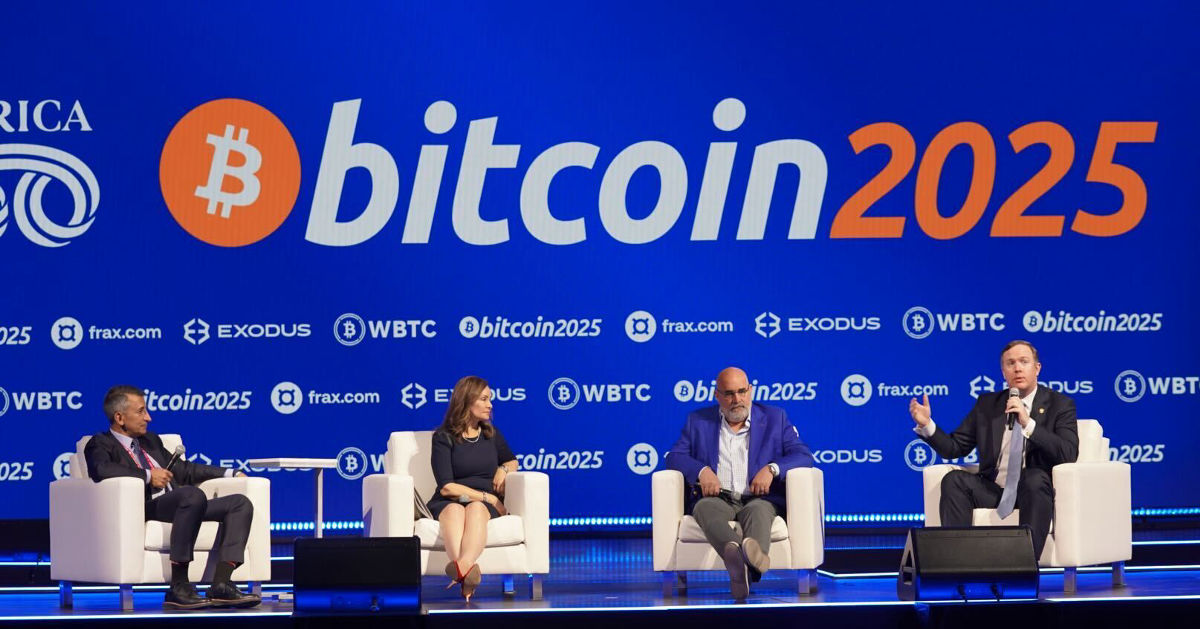
Bitcoin Is Here To Stay, Says Former US Treasurer Rosie RiosAt the 2025 Bitcoin Conference in Las Vegas, the Co-Manager of President Trump’s 2024 Campaign Chris LaCivita, Congressman Brian T. Jack, the Chief Policy Officer of Coinbase Faryar Shirzad and Former US Treasurer Rosie Rios at the Nakamoto stage discussed the 250th birthday of the United States, Bitcoin, freedom, and crypto.
Rosie Rios emphasized that consumer behavior is very hard to change unless there is a shock to the system. She said she is amazed by the momentum of the level of change that has happened during these four months in terms of giving that green light to innovation to actually happen.
“You are gonna hear me say a lot, the train has left the station. Bitcoin is here to stay. Blockchain is here to stay,” said Rios.
JUST IN:
 Former Treasurer of the United States Rosie Rios says, “#Bitcoin is here to stay.”
Former Treasurer of the United States Rosie Rios says, “#Bitcoin is here to stay.” “The train has left the station.”
 pic.twitter.com/M4noy7DPha
pic.twitter.com/M4noy7DPha— Bitcoin Magazine (@BitcoinMagazine) May 27, 2025
“It’s about freedom and what crypto represents on a national scale,” said Chris LaCivita. “This country was founded on the entrepreneurial spirit of Americans and we are on the forefront of establishing and formulating the future of currency.”

Jack mentioned that earlier this year, they started to use a congressional tool called the Congressional Review Act that will enable them to repeal any regulation Joe Biden’s administration put on any sector during his last months in office.
“One of the first laws that Donald Trump signed into law was the repeal of a very niche but interesting issue for some folks in the room,” stated Jack. “It was a policy that the CFPB thrust upon the industry in December that really helped them regulate, if you will, or over regulate payment processors. So a lot of the payment processors that process bitcoin, process crypto, they were going to be under these incredible burdens by CFPB.”
“The eyes of the world are watching,” commented Rosie. “We are setting the tone for what happens not just in our history but for the future and for all of us this is the American dream. This is about the values of which our country was founded.”
“For Bitcoin and Blockchain in general whoever creates that dominant digital infrastructure will set the tone for the whole global financial system and it starts here literally at this conference with this leadership with this President moving forward,” stated Rosie Rios closing the panel.
This post Bitcoin Is Here To Stay, Says Former US Treasurer Rosie Rios first appeared on Bitcoin Magazine and is written by Oscar Zarraga Perez.
-
 @ 6e0ea5d6:0327f353
2025-05-28 04:34:08
@ 6e0ea5d6:0327f353
2025-05-28 04:34:08Ascolta bene! It is more dignified to thirst alone in the desert than to share wine with someone who has no thirst for conquest.
On the silent path to success, it’s not the declared enemies who slow the march, but rather the friends. Not the noble or loyal ones, but the failures—those who carry a dull glint in their eyes, chronic laziness in their spirit, and the eternal excuse of bad luck in their pockets. Friendship, when poorly chosen, becomes a polished anchor, tied to your ankle with ropes named camaraderie.
Nothing weighs heavier on the journey than having to endure the failed and envious around you. It is a kind of emotional parasitism that begins with empathy and ends in stagnation. Those who live among the weak will crawl. Those who keep company with miserable friends, instead of striving to prosper, learn to curse wealth—not out of ethics, but out of envy. Mediocrity, my friend, is contagious. And it does not take root suddenly, but like a silent epidemic.
Ambition—that fire that burns in the bones of great men—will always seem like arrogance to the ears of the failed. Those who have never built anything, except arguments to justify their paralysis, will never understand the fury of someone born to conquer. And so, with smiles, they spit venom: “Calm down,” they say, “be content,” they advise. Hypocrites. What they call humility is nothing more than resignation to their own defeat.
To walk alone, with hunger and honor, is worth more than feasting at lavish tables at the cost of your own sweat, surrounded by parasites who toast your downfall with glasses full of praise. No one prospers where the conversation is filled with complaints, criticism, and envy. What does not build up, corrodes.
The rust of the weak is invisible at first—a bitter joke here, a veiled critique there. And before you know it, the structure is already rotten. Of the friendship, only the weight remains. Of the relationship, only exhaustion. The true enemy of success is the company of those who have failed and wish for you the same fate. These tragic figures—always tired, always victims—are masters of collective self-sabotage.
Feel no remorse in abandoning those who build nothing and consume everything. And in that abandonment, you become freer, stronger, and unbreakable.
Thank you for reading, my friend!
If this message resonated with you, consider leaving your "🥃" as a token of appreciation.
A toast to our family!
-
 @ da8b7de1:c0164aee
2025-05-28 15:42:22
@ da8b7de1:c0164aee
2025-05-28 15:42:22Nemzetközi nukleáris energetikai hírek
Új amerikai kis moduláris reaktor engedélykérelem
A Tennessee Valley Authority (TVA) benyújtotta az Egyesült Államok Nukleáris Szabályozó Hatóságához (NRC) az engedélykérelmet egy GE Vernova Hitachi Nuclear Energy BWRX-300 kis moduláris reaktor (SMR) megépítésére a Clinch River telephelyen. Ez jelentős lépés az új, fejlett nukleáris technológiák bevezetésében az Egyesült Államokban, és jól mutatja, hogy az SMR-ek egyre fontosabb, rugalmas és skálázható tisztaenergia-megoldássá válnak[world-nuclear-news.org].
Amerikai elnöki rendeletek a nukleáris bővítés felgyorsítására
Donald Trump amerikai elnök négy elnöki rendeletet írt alá, amelyek célja a reaktorengedélyezési folyamatok gyorsítása, a hazai urántermelés növelése és a fejlett nukleáris technológiák bevezetésének felgyorsítása. Az új irányelvek ambiciózus célokat tűznek ki, például az amerikai nukleáris kapacitás megnégyszerezését 2050-re, az NRC számára az engedélyezési idő 18 hónapra csökkentését, valamint szövetségi területek kijelölését új nukleáris létesítmények számára. Ezeket a rendeleteket az „amerikai nukleáris reneszánsz” alapjának szánják, különös hangsúlyt fektetve az AI-ipar energiaigényeinek kielégítésére és a hazai gyártás újjáélesztésére[nucnet.org].
Iparági optimizmus és globális befektetési trendek
Az iparági vezetők egészséges és optimista kilátásokról számolnak be a nukleáris energia terén, kiemelve olyan aktív projekteket, mint a TerraPower Wyomingban, az X-energy és a Dow együttműködése, valamint a Westinghouse tevékenysége Lengyelországban. Különösen nagy az érdeklődés a magánbefektetések iránt a magas dúsítású, alacsony dúsítású urán (HALEU) előállítása terén, illetve annak lehetősége iránt, hogy a Világbank elkezdjen nukleáris projekteket finanszírozni, ami szélesebb körű nemzetközi befektetéseket is elindíthat[ans.org].
Nemzetközi fejlemények és ellátási lánc felkészültsége
Számos ország halad előre a nukleáris fejlesztésekkel: - Kína tíz új reaktort hagyott jóvá. - India szabályozó hatósága engedélyezte egy új, négyblokkos telephely létesítését Rádzsasztánban. - Belgium konzultációt indított egy innovatív, ólom-hűtésű kis moduláris reaktor terveiről. - Brazília várhatóan Oroszországgal közösen fejleszt SMR-projektet. - Csehország új nukleáris szerződéseket köt, a külső politikai nyomás ellenére is.
A globális nukleáris ellátási láncot arra ösztönzik, hogy készüljön fel a gyors növekedésre, kiemelve a helyi és nemzetközi együttműködés fontosságát a növekvő igények kielégítésére[world-nuclear-news.org].
Úszó atomerőművek és tengeri innovációk
Az úszó atomerőművek továbbra is az innováció középpontjában állnak: - Oroszország Akademik Lomonosov nevű úszó atomerőműve elérte az első milliárd kilowattóra termelést. - Az Egyesült Királyságban a Core Power egy amerikai központú tengeri nukleáris programot fejleszt, melynek célja úszó reaktorok telepítése amerikai kikötőkben a 2030-as évek közepére. - A dán Seaborg Technologies (új nevén Saltfoss Energy) kompakt olvadt só reaktor technológián dolgozik, amelyet szintén a 2030-as évekre terveznek bevezetni. - A Westinghouse és a Core Power együttműködik egy úszó atomerőmű fejlesztésén az eVinci mikroreaktorral[world-nuclear-news.org].
Érintettek bevonása és társadalmi bizalom
A Nemzetközi Atomenergia-ügynökség (IAEA) kiemeli az érintettek bevonásának fontosságát a nukleáris energia jövője szempontjából. Folyamatban lévő konferenciáján olyan témákat tárgyalnak, mint a nukleáris energia szerepe az ipari dekarbonizációban, a nyilvános meghallgatások értéke a projektek átláthatósága érdekében, valamint a társadalmi bizalom és a szabályozói megfelelés legjobb gyakorlatai, különösen az új technológiák, például az SMR-ek bevezetése során[iaea.org].
Források: - world-nuclear-news.org - nucnet.org - iaea.org - ans.org
-
 @ 91117f2b:111207d6
2025-05-28 15:32:35
@ 91117f2b:111207d6
2025-05-28 15:32:35
When Nigerians and Americans collide as nigerians call it (jam). Hilarity ensues: Some humerus observations:
FOOD FIGHTS Americans: pizza(sauce and cheese flying everywhere). Pie: (especially creamed-filled or fruit pies 🥧 tacos: (crunchy shells and soft fillings make for a messy fight). Nigerians 🇳🇬 :you call that a meal? Where is the pounded yam(white any molded, heavy and soft most suitable for mess😁
Americans 🇺🇸 :you mean you eat fufu with your hands? That's adventurous.
DANCE BATTLE NIGERIANS 🇳🇬 : Azonto, poco Lee shaku Shakur. AMERICANS 🇺🇸 : Gangnam style
MUSIC PREFERENCES Nigerians 🇳🇬 : afrobeats all day Americans 🇺🇸 :country road, take me home.
Despite this differences both cultures share a love for food, good music and laughter. Who knows maybe one day, we will see a 🇳🇬 -America 🇺🇸 fusion cruisine Jollof burger and suya tacos? 🍴😂
FESTIVAL AND CELEBRATION
Nigerians 🇳🇬 : colorful cultural festival like oshogbo,eyo, esun. Americans 🇺🇸 :independence day, Halloween Thanksgiving, diverse cultural celebration.
If Nigerians were to try halloween we would be referred to as winch. (witch).
This differences highlight the unique aspects of each culture, showcasing the beauty of diversity and understanding of understanding and appreciation.
COMMUNICATION STYLE Americans: uh hi what's your name? Nigerians: watin be your name?
Let's dive deeper GREETINGS
Americans: hey "what's up?
Nigerians: how is your family, your parents, siblings. Oya greet them for me " Nigerians love to make sure all of the family members have been asked about 🙌
FAMILY GATHERING Americans:"just me, my parents and my cat" Nigerians: "come, and meet my 50 cousins"
RELATIONSHIP In America 🇺🇸 it is normal for teenagers to be in a relationship, you can see a boy or girl alone in a room and the parent won't say shit. IN Nigeria 🇳🇬 as a teenager if you are caught with a girl or boy alone in a room, just pray to survive the night especially if your parents are warriors (they don't mess around).
IN America 🇺🇸 if a teenager tells his parents "mom dad I love him or her and I will leave the house if you don't allow us to be" the parent will allow them. IN Nigeria 🇳🇬, Tell them you are in love with your lover, and if they don't allow you to be together you will leave the house their response will be shocking even to you 😂😂 the child.
Americans 🇺🇸 : they do some activities like kiss or grab whereby a guy or girl choose between to kiss or to grab a stranger in the ass. Nigerians 🇳🇬 : if you are are caught in the street, you can will be referred to as oscroh (prostitute) and will be chased away.
Americans has more liberty but in Nigeria you are always watched by your parent, parents friends or anyone at all.
But the two countries has been a lot of things in common
-
 @ 1d7ff02a:d042b5be
2025-05-28 04:02:47
@ 1d7ff02a:d042b5be
2025-05-28 04:02:47For those who still don't truly understand Bitcoin, it means you still don't understand what money is, who creates it, and why humans need money.
It's a scam that the education system doesn't teach this important subject, while we spend almost our entire lives trying to earn money. Therefore, I recommend following the money and studying Bitcoin seriously.
Why Bitcoin Matters
Saving is the greatest discovery in human history
Before humans learned to save, we were just animals living day to day. Saving is what makes humans different from other animals — the ability to think about the future and store for later.
Saving created civilization itself
Without saving, there would be no cities, no science, no art. Everything we call "progress" comes from the ability to save.
Money is the greatest creation in human history
It is the tool that has allowed human civilization to advance to this day. Money is the best tool humans use for saving.
Bitcoin is the best money ever created
It is the most perfect money humans have ever created. No one can control, manipulate, destroy it, and it is truly limited like time in life.
Bitcoin is like a black hole
That will absorb all value from the damaged financial system. It will draw stability and value to itself. Everything of value will flow into Bitcoin eventually.
Bitcoin is like Buddhism discovering truth
It helps understand the root problems of the current financial system and the emergence of many problems in society, just like Buddha who understood all suffering and the causes of suffering.
Bitcoin is freedom
Money is power, money controls human behavior. When we have money that preserves value and cannot be controlled, we will have intellectual freedom, freedom of expression, and the power to choose.
The debt that humanity has created today would take another thousand years to pay off completely
There is no way out and it's heading toward serious collapse. Bitcoin is the light that will help prevent humanity from entering another dark age.
Bitcoin cannot steal your time
It cannot be created from nothing. Every Bitcoin requires real energy and time to create.
Bitcoin is insurance that protects against mismanagement
It helps protect against currency debasement, economic depression, and failed policies. Bitcoin will protect your value.
Bitcoin is going to absorb the world's value
Eventually, Bitcoin will become the store of value for the entire world. It will absorb wealth from all assets, all prices, and all investments.
Exit The Matrix
We live in a financial Matrix. Every day we wake up and go to work, thinking we're building a future for ourselves. But in reality, we're just giving energy to a system that extracts value from us every second. Bitcoin is the red pill — it will open your eyes to see the truth of the financial world. Central banks are the architects of this Matrix — they create money from nothing, and we have to work hard to get it.
The education system has deceived us greatly. They teach us to work for money, but never teach us what money is. We spend 12-16 years in school, then spend our entire lives earning money, but never know what it is, who creates it, and why it has value. This is the biggest scam in human history.
We are taught to be slaves of the system, but not taught to understand the system.
The Bitcoin standard will end war
When you can't print money for war anymore, war becomes too expensive.
We are entering the Bitcoin Renaissance era
An era of financial and intellectual revival. Bitcoin is creating a new class of humans. People who understand and hold Bitcoin will become a new class with true freedom.
The Path to Financial Truth
Follow the money trail and you will see the truth: - Who controls money printing? - Why do prices keep getting higher? - Why are the poor getting poorer and the rich getting richer?
All the answers lie in understanding money and Bitcoin.
Studying Bitcoin is not just about investment — it's about understanding the future of currency and human society.
Don't just work for money. Understand money. Study Bitcoin.
If you don't understand money, you will be a slave to the system forever. If you understand Bitcoin, you will gain freedom.
-
 @ 502ab02a:a2860397
2025-05-28 02:03:01
@ 502ab02a:a2860397
2025-05-28 02:03:01ยังมีอีกสิ่งหนึ่งที่มักซ่อนอยู่ในเมล็ดธัญพืช ถั่วเปลือกแข็ง และพืชตระกูลถั่วทั้งหลาย เป็นเหมือน “กล่องเก็บขุมทรัพย์” สำหรับชีวิตน้อยๆ ของพืชในวันที่จะเติบโต แต่พอสิ่งนี้หลุดเข้ามาในร่างกายมนุษย์ มันกลับถูกมองว่าเป็น “ขโมย” ขโมยแร่ธาตุไปจากร่างกายเรา เจ้าสิ่งนั้นคือ “กรดไฟติก” หรือ phytic acid นั่นเองครับ
กรดไฟติกเป็นสารอินทรีย์ที่พืชสร้างขึ้นเพื่อเก็บสะสมฟอสฟอรัสไว้ใช้ตอนงอกงามในอนาคต มันเปรียบเหมือนกระปุกออมสินของเมล็ดพืช พวกเมล็ดถั่วดำ ข้าวโพด ข้าวกล้อง ข้าวโอ๊ต เมล็ดทานตะวัน อัลมอนด์ ไปจนถึงเต้าหู้ ถั่วเหลือง และธัญพืชต่างๆ ล้วนมีกรดไฟติกอยู่ไม่น้อย โดยเฉพาะถ้าเป็น “ธัญพืชเต็มเมล็ด” ที่ไม่ผ่านการขัดสีแบบที่หลายๆคนชอบ นั่นเพราะเยื่อหุ้มเมล็ดคือที่เก็บเจ้าตัวนี้ไว้
หลายคนคงคิดว่า อ้าวแล้วเจ้ากรดไฟติกทำไมถึงมีชื่อเสียงไม่ค่อยดีนัก? คำตอบอยู่ที่ “ความสามารถในการจับแร่ธาตุ” ของมันนี่แหละครับ
กรดไฟติกเป็นเหมือนแม่เหล็กเล็กๆ ที่สามารถจับตัวกับแร่ธาตุต่างๆ ได้ดี โดยเฉพาะ “แร่ธาตุบวกสอง” ทั้งหลาย แร่ธาตุบวกสอง คือ แร่ธาตุที่เวลาอยู่ในร่างกายจะอยู่ในรูปของไอออนที่มีประจุไฟฟ้า บวก 2 (เขียนว่า ²⁺) หรือพูดอีกแบบคือ มันเสียอิเล็กตรอนออกไป 2 ตัว เลยกลายเป็นไอออนที่มีพลังบวก 2 หน่วย กรดไฟติก หรือ แทนนิน จะทำตัวเป็น "แม่เหล็ก" ดูดแร่ธาตุออกไป มันมักจะจับกับแร่ธาตุที่มีประจุบวก โดยเฉพาะพวกที่ประจุบวกแรงๆ แบบ บวกสอง (²⁺) นี่แหละ เพราะจับแน่น จับเหนียว ยิ่งบวกเยอะยิ่งจับดี เหมือนแช่แม่เหล็กลงไปในกล่องโลหะ เช่น ธาตุเหล็ก สังกะสี แมกนีเซียม แคลเซียม และทองแดง พอมันจับเสร็จแล้ว ร่างกายเราก็ไม่สามารถดูดซึมแร่ธาตุพวกนี้เข้าไปได้ เพราะมันเปลี่ยนสภาพกลายเป็นของจับคู่ที่ลำไส้ไม่รู้จัก ไม่รู้จะพาเข้าร่างกายยังไง สุดท้ายก็ต้องโบกมือลาไปพร้อมของเสีย
พวกที่เป็น บวกสาม (³⁺) อย่างเช่น อลูมิเนียม (Al³⁺) หรือ เหล็กเฟอริก (Fe³⁺) จะจับแน่นมาก ถึงขั้นอาจเกิด “ตกตะกอน” แบบไม่ละลายน้ำเลยทีเดียว พวกนี้ลำไส้ไม่สามารถดูดซึมได้เลย ในขณะที่แร่ธาตุบวกหนึ่ง โซเดียม (Na⁺) โพแทสเซียม (K⁺) ประจุบวกแค่ +1 จับกับกรดไฟติกได้น้อยกว่า
ในแง่นี้กรดไฟติกเลยถูกเรียกว่า “สารต้านสารอาหาร” หรือ anti-nutrient เพราะมันต้านไม่ให้ร่างกายได้แร่ธาตุที่ควรจะได้ แต่อย่าเพิ่งตัดสินมันเหมือนผู้ร้าย เพราะในขณะที่กรดไฟติกอาจขโมยแร่ธาตุบางตัวจากร่างกาย มันก็มีคุณสมบัติน่าสนใจที่ดูจะเป็นคุณงามความดีของมันเหมือนกัน เช่น มันสามารถจับกับโลหะหนักบางชนิด เช่น ตะกั่ว หรือแคดเมียม ที่อาจปนเปื้อนในอาหาร แล้วพาออกไปจากร่างกายก่อนที่สิ่งเหล่านั้นจะทำร้ายเรา
และอีกด้านหนึ่งที่กำลังเป็นที่สนใจคือ ฤทธิ์ต้านอนุมูลอิสระของกรดไฟติก มันอาจช่วยลดการอักเสบ หรือยับยั้งการเติบโตของเซลล์มะเร็งบางชนิดในระดับเซลล์ได้ มีงานวิจัยที่พบว่ามันอาจไปจับกับธาตุเหล็กส่วนเกินที่ว่ายอยู่ในเลือด ซึ่งเป็นตัวเร่งปฏิกิริยาอนุมูลอิสระ คล้ายช่วย “เก็บเศษเหล็กที่ลอยไปมาบนทางด่วนหลอดเลือด” ให้ปลอดภัยขึ้นอีกนิด
แต่ทั้งนี้ทั้งนั้น อยากให้คิดแบบนี้ครับว่า กรดไฟติกคือคนแปลกหน้าที่ “บางมื้อก็มีประโยชน์ บางมื้อก็ทำให้เราขาดของดี” สิ่งสำคัญอยู่ที่ “สภาวะแวดล้อมของมื้ออาหาร” ถ้าอาหารในมื้อมีแร่ธาตุไม่มากนัก แล้วกรดไฟติกเข้ามาเยอะ มันก็ยิ่งลดโอกาสดูดซึมแร่ธาตุเหล่านั้น แต่ถ้ามื้ออาหารมีความหลากหลาย โปรตีนเพียงพอ วิตามิน C อยู่ครบ ก็ช่วยเพิ่มการดูดซึมธาตุเหล็กได้ดีขึ้น เพราะมันเปลี่ยนเหล็กให้อยู่ในรูปแบบที่ร่างกายดูดซึมง่ายขึ้น
แล้วเราจะจัดการยังไงกับกรดไฟติกในครัวแบบบ้านเรา?
วิธีพื้นบ้านมีมาแต่โบราณแล้วนั่นคือ -แช่น้ำ ก่อนหุงข้าวกล้อง หรือแช่ถั่วก่อนนำไปต้ม จะช่วยลดกรดไฟติกได้ระดับหนึ่ง เพราะมีเอนไซม์ที่ชื่อว่า phytase ซึ่งจะเริ่มทำงานเมื่อพืชได้รับน้ำและอุณหภูมิพอเหมาะ -การหมัก เช่น หมักแป้งข้าวเปลือกทำขนม หรือการหมักเต้าหู้ ก็เป็นวิธีดั้งเดิมที่ช่วยลดกรดไฟติกลงได้มาก เพราะเอนไซม์ของจุลินทรีย์ในกระบวนการหมักจะช่วยย่อยกรดไฟติกให้ลดลง -การงอก หรือ sprouting คือการทำให้เมล็ดพืชเริ่มต้นชีวิตใหม่ เช่น ถั่วงอก ข้าวกล้องงอก วิธีนี้ลดกรดไฟติกได้ดีมาก เพราะ phytase ที่อยู่ในพืชจะถูกกระตุ้นให้ทำงานสูงสุดตอนพืชเริ่มงอก
ข้อมูลคร่าวๆ บอกว่า วิธีเหล่านี้อาจลดกรดไฟติกลงได้ 30-90% ขึ้นกับชนิดของพืช และระยะเวลาที่ใช้
แต่ต้องรู้ไว้ด้วยว่า… การลดกรดไฟติกก็อาจทำให้พลังงานสำรองหรือสารอาหารบางตัวในพืชหายไปด้วยเช่นกัน เช่น วิตามิน B และสารต้านอนุมูลอิสระบางชนิด จึงควรใช้วิธีที่พอเหมาะ ไม่ถึงกับฆ่าความดีของพืชหมด
ดังนั้นเช่นกันครับว่า กรดไฟติกไม่ใช่ศัตรู ไม่ใช่เทพเจ้า แต่คือ “สมการ” ที่ต้องรู้จักแก้ไขให้เหมาะกับมื้ออาหารของเรา ถ้าเฮียเลือกกินแบบ animal-based อยู่แล้ว แร่ธาตุสำคัญส่วนใหญ่ก็ได้จากเนื้อสัตว์แบบที่ดูดซึมได้ดีอยู่แล้ว กรดไฟติกจากพืชที่กินพอประมาณก็อาจไม่ได้ร้ายแรงอะไรนัก เพียงแต่ต้องรู้ทันและจัดการให้พอดี ไม่ให้มันกลายเป็นตัวฉุดไม่ให้ร่างกายดูดซึมของดี
สุดท้าย เหมือนชีวิตเรานี่แหละ… “ทุกอย่างมีมุมมืดและมุมสว่าง อยู่ที่ว่าเราจัดแสงยังไงให้แม้แต่เงาก็กลายเป็นพลังของชีวิตเรา” #โรงบ่มสุขภาพ #HealthyHut #pirateketo #ตำรับเอ๋ #siripun #siamstr
/เฮียเอง
-
 @ 9e9085e9:2056af17
2025-05-28 15:21:58
@ 9e9085e9:2056af17
2025-05-28 15:21:58Part 3: Features That Can Drive User Engagement
Growing the Yakihonne Community – What’s Next?
To attract more users and keep engagement high, Yakihonne could expand with the following features:
- Gamification & Milestones
Badges, activity points, and rewards to motivate interaction.
- Smart Content Discovery
Trending topics, hashtag feeds, and AI-curated (but private) suggestions.
- Community Tools
Verified groups, decentralized moderation, and event features.
- Rich Profile Customization
Bio, themes, badges, and follower highlights.
- Lightning Micro-Tipping
Enable users to send instant tips for posts or engagement.
- Cross-Device Compatibility
Smooth use across mobile, web, and desktop.
- Developer Ecosystem
Open APIs to allow third-party apps and tools to thrive.
Yakihonne #Yakihonne #Yakihonne #Nostr #Nostr #YoungDfx
-
 @ 502ab02a:a2860397
2025-05-28 01:57:42
@ 502ab02a:a2860397
2025-05-28 01:57:42ในปี 2013 ณ กรุงลอนดอน แฮมเบอร์เกอร์หน้าตาดูธรรมดาแต่ไม่ธรรมดาชิ้นหนึ่งได้ถูกจัดวางอย่างสง่างามบนจานสีขาวในงานแถลงข่าวระดับโลก ไม่ใช่เพราะมันแพงเกินเหตุที่ตั้งราคาที่ 330,000 ดอลลาร์ต่อชิ้น แต่เพราะมันไม่เคยเกิดขึ้นมาก่อนในประวัติศาสตร์นี่คือ “เนื้อเพาะเลี้ยง” (cultured meat) ชิ้นแรกของโลกที่เติบโตมาจากเซลล์ ไม่ใช่จากสัตว์ทั้งตัว
เบื้องหลังอาหารชิ้นนี้คือชายชาวดัตช์คนหนึ่ง ชื่อว่า มาร์ค โพสต์ (Mark Post) นักวิทยาศาสตร์ด้านสรีรวิทยาหลอดเลือด ซึ่งไม่ได้มีดีกรีจากแค่มหาวิทยาลัย แต่มีความฝันที่อยากจะสร้างอาหารจากเทคโนโลยีเพื่ออนาคต เขาเริ่มต้นจากห้องทดลองเล็กๆ ที่มหาวิทยาลัย Maastricht ในประเทศเนเธอร์แลนด์ โดยเชื่อว่าการเพาะเลี้ยงเนื้อจากเซลล์ต้นกำเนิดของวัวจะสามารถลดผลกระทบด้านสิ่งแวดล้อมจากอุตสาหกรรมเนื้อสัตว์ได้
แต่กว่าจะมีแฮมเบอร์เกอร์เพาะเลี้ยงได้หนึ่งชิ้น เขาต้องเพาะเลี้ยงเส้นใยกล้ามเนื้อเล็กๆ มากกว่า 20,000 เส้น นำมารวมกัน ประกอบโครง สร้างรูปร่าง คล้ายกับงานศิลปะทางวิทยาศาสตร์ ใช้เวลาเป็นเดือน แถมกระบวนการทั้งหมดต้องอยู่ในสภาพปลอดเชื้อราวกับโรงพยาบาลของนาโนเทคโนโลยี ส่วนต้นทุนมหาศาลที่ใช้ในวันนั้น มาจากมหาเศรษฐีผู้ร่วมก่อตั้ง Google อย่าง Sergey Brin ที่เห็นว่ามันอาจเป็นคำตอบของปัญหาอาหารโลกในอนาคต
แต่เรื่องนี้มีอะไรมากกว่าที่สื่อกระแสหลักอยากให้คุณรู้
หลังจากเปิดตัวเนื้อในห้องแล็บ โลกก็เหมือนถูกปลุกให้ตื่นขึ้นในอีกมิติหนึ่ง บริษัทสตาร์ทอัพที่เคยเน้นเขียนโค้ด เริ่มหันมาเขียนสูตรเนื้อ บริษัทรายใหญ่อย่าง Cargill, Tyson Foods และแม้แต่ Richard Branson ก็เทเงินสนับสนุนบริษัทรุ่นใหม่อย่าง Mosa Meat ซึ่งก่อตั้งโดย Dr. Post เองในปี 2016 พร้อมแผนทะเยอทะยานที่จะส่ง “เนื้อจากแล็บ” เข้าซูเปอร์มาร์เก็ตภายในทศวรรษเดียว
Mosa Meat พยายามลดต้นทุนจากหลักแสน ให้เหลือหลักร้อย และวันนี้บริษัทเหล่านี้กำลังสร้างโรงงานที่ผลิตเนื้อในถังหมักขนาดยักษ์ ไม่ต่างจากโรงเบียร์ พวกเขาเลี้ยงเซลล์วัวในน้ำเลี้ยงที่เดิมทีเคยใช้เซรุ่มจากลูกวัว (Fetal Bovine Serum) ซึ่งเป็นสิ่งที่ย้อนแย้ง ที่สวนทางกับภาพ “ปลอดภัยไร้เลือด” มาก เพราะในขณะที่โฆษณาว่า “ปลอดการฆ่า” แต่กลับใช้ส่วนผสมที่ได้มาจากเลือดลูกวัวที่ยังไม่เกิด จนต้องหาทางเปลี่ยนสูตรเป็น “น้ำเลี้ยงเทียม” ที่มาจากสารเคมีและอาหารสังเคราะห์แทน
ด้วยโครงสร้าง scaffold ที่ช่วยให้เซลล์ก่อตัวเป็นเนื้อเยื่อ และ กระบวนการเพาะเลี้ยงใน bioreactor ขนาดยักษ์ ที่เปลี่ยนเซลล์เล็ก ๆ ให้เป็นเนื้อก้อนใหญ่ในเวลาไม่กี่สัปดาห์
แต่ขณะที่ภาพความล้ำซึ่งดูจะเติบโตอย่างสดใส กลับมีเงามืดที่เติบโตพร้อมกันไปเงียบๆไม่ต่างกับอนาคินและดาร์ธเวเดอร์
แม้จะเป็นนวัตกรรมล้ำหน้า แต่ทุกขั้นตอนถูกห่อหุ้มไว้ด้วย “สิทธิบัตร” สิ่งที่ทำให้เนื้อชนิดนี้ไม่ได้เป็นของทุกคน แต่เป็นสมบัติทางปัญญาของบริษัทเท่านั้น เนื้อจากเซลล์เหล่านี้ ไม่เหมือนเนื้อจากฟาร์มที่ใครก็เลี้ยงเองได้ ไม่สามารถเก็บเมล็ดพันธุ์ไว้เพาะรุ่นหน้าแบบชาวนาในอดีต ทุกอย่างต้องเริ่มต้นในห้องแล็บ ต้องใช้เทคโนโลยีเฉพาะ ต้องมีสูตรลับเฉพาะ ต้องพึ่งบริษัทที่มีสิทธิบัตรครอบครองชีวิตเซลล์เพียงไม่กี่เจ้า
Mosa Meat ไม่ได้หยุดแค่การผลิต พวกเขายื่นจด สิทธิบัตรกว่า 10 กลุ่ม ครอบคลุมตั้งแต่สูตรน้ำเลี้ยง วิธีเพาะเลี้ยงเซลล์ ไปจนถึงวิธีห่อบรรจุสินค้าขั้นสุดท้าย กล่าวอีกอย่างคือ ถ้าใครอยากทำเนื้อเพาะเลี้ยงแบบนี้บ้าง ก็ต้อง “จ่ายค่าลิขสิทธิ์” ให้เขาเสียก่อน เรากำลังก้าวสู่ยุคที่ อาหารไม่ใช่ผลผลิตจากดินและแรงคน แต่เป็นผลผลิตของทรัพย์สินทางปัญญา และเมื่อใดที่ “เนื้อ” กลายเป็นสิ่งที่คนผลิตเองไม่ได้ ต้องซื้อจากห้างเท่านั้น เกษตรกรกลายเป็นผู้บริโภค ผู้บริโภคกลายเป็นผู้ขึ้นอยู่กับระบบ ห่วงโซ่อาหารที่เคยเป็นของชุมชนถูกตัดขาดด้วยท่อส่งจากห้องทดลองสู่จานอาหาร เราไม่ได้ซื้อเนื้อ แต่ “เช่าเทคโนโลยี” ที่ผลิตเนื้อมาให้เรากิน
และที่น่าสนใจคือ รัฐบาลในหลายประเทศกลับเป็นผู้ให้ทุนสนับสนุน เช่น โครงการของสหภาพยุโรปที่มอบเงินกว่า 2 ล้านยูโรให้ Dr. Post และ Mosa Meat รวมถึงโครงการของสิงคโปร์ที่ให้ใบอนุญาตจำหน่ายเนื้อเพาะเลี้ยงรายแรกของโลกในปี 2020 ราวกับว่า “เนื้อจากแล็บ” กำลังจะกลายเป็นนโยบายด้านความมั่นคงอาหารแห่งอนาคต
มันไม่ใช่เรื่องของการวิจัยอีกต่อไป แต่มันคือการปูทางอำนาจใหม่ ที่เปลี่ยน “อาหาร” ให้กลายเป็น “ซอฟต์แวร์ชีวภาพ” ที่จดทะเบียนครอบครองสิทธิ์แบบเดียวกับแอปในมือถือ
แล้วการใช้สื่อก็จะมาในรุปแบบที่ประชาชนโห่ร้องดีใจ เฉลิมฉลองการเกิดขึ้นของมันโดยไม่รู้สึกว่า เสรีภาพในการจัดการด้านอาหารสิ้นสุดลงแล้ว ในทางหนึ่ง มันอาจดูสวยงามไร้ที่ติ ช่วยลดการฆ่าสัตว์ ลดการปล่อยก๊าซเรือนกระจก และให้โปรตีนสะอาดแก่คนจำนวนมาก
แต่อีกทางหนึ่ง มันคือการรวมศูนย์อำนาจด้านอาหารไว้ในมือบริษัทยักษ์ใหญ่ ที่สามารถตั้งราคาตามใจ และควบคุมทุกขั้นตอนตั้งแต่ฟาร์ม (ในหลอดทดลอง) ถึงโต๊ะอาหารของเรา
เกษตรกรจะหมดบทบาท เพราะไม่มีใครต้องเลี้ยงสัตว์อีก ผู้บริโภคจะหมดทางเลือก เพราะสูตรทุกอย่างถูกจดสิทธิบัตร สุดท้าย คนธรรมดาอย่างเราอาจ “มีเงินก็ยังไม่มีสิทธิ์ทำอาหารกินเอง”
ไม่มีใครในหมู่บ้านจะต้มแกงจากวัตถุดิบแล็บเหล่านี้ได้โดยไม่จ่ายค่าลิขสิทธิ์ ไม่มีใครปลูกหรือเพาะเนื้อได้เอง เพราะเขาถือสิทธิบัตร ไม่มีใครรู้ส่วนผสมที่แท้จริง เพราะมันคือ “ความลับทางการค้า”
หลายๆคนเริ่มคิดในใจว่า…นี่ไม่ใช่เรื่องเล็กอีกต่อไป เพราะนี่อาจไม่ใช่แค่เนื้อจากห้องแล็บ แต่ มันคือจุดเริ่มต้นของอนาคตของอาหารที่ไม่เป็นของประชาชนอีกต่อไป มันคือการเริ่มต้นของยุคที่มนุษย์จะไม่สามารถ “เข้าครัวของตัวเอง” ได้อีกต่อไป
ไหนๆเราตามมาถึงตอนนี้แล้ว เข้าหมวดที่ 2 ของอาหารอนาคตแล้ว เฮียไม่ได้บอกว่าเทคโนโลยีไม่ดีนะครับ เราตัดสินเดี๋ยวนี้ไม่ได้ แต่เรารู้เรื่องของมันได้
แต่โลกนี้เต็มไปด้วยคำว่า “ดีต่อโลก” ที่ซ่อนคำว่า “ดีต่อผู้ถือหุ้น” อยู่ข้างใน เราอาจจะกำลังก้าวสู่ยุคที่ “เนื้อไม่ได้ปลอดภัยขึ้น แต่ถูกควบคุมง่ายขึ้น” และประชาชนก็อาจกลายเป็นเพียง “ผู้ใช้บริการเนื้อ” ที่ไม่มีสิทธิ์แม้แต่จะรู้ว่าเนื้อในจานคืออะไรบ้างแน่
โลกอาหารในอนาคตไม่ได้ขึ้นกับว่าเราปลูกอะไร แต่ขึ้นกับว่า “ใครจดสิทธิบัตรก่อน” และเมื่อถึงวันนั้น เฮียแอบคิดว่า เราอาจไม่ได้เสียแค่ฟาร์มและครัว แต่เรากำลังเสีย “เสรีภาพในการกิน” ไปอย่างช้า ๆ ด้วยรอยยิ้มของนักลงทุนและเสียบปรบมือจาก "ใครบางคน"
ทุกวันนี้ใครนิยมไดเอทอะไร ภูมิใจในการดูแลสุขภาพยังไง ก็ทำไปเหอะครับ ขอเพียงว่า เส้นทางที่เดินอยู่นั้น สนับสนุนเกษตกร สนับสนุน local ให้แข็งแรง ทุกสังคมมีทั้งคนดีและคนไม่ดี เราค่อยๆ verify สนับสนุนคนดีๆ แต่ไม่ใช่ไปเดียจฉันท์ลงโทษคนไม่ดี เราเสริมความรู้ให้เขา พยายามโอบอุ้มพวกเขา ถ้าชีวิตดีขึ้น การออมเห็นผลขึ้น อาจทำให้ชีวิตทุกคนดีขึ้น
#pirateketo #กูต้องรู้มั๊ย #ม้วนหางสิลูก #siamstr
-
 @ 9ca447d2:fbf5a36d
2025-05-28 15:01:22
@ 9ca447d2:fbf5a36d
2025-05-28 15:01:22Michael Saylor, executive chairman of Strategy, has stirred up the Bitcoin community with his recent comments on proof-of-reserves, calling it a “bad idea” that puts institutional security at risk.
Speaking at a side event at the Bitcoin 2025 conference in Las Vegas, Saylor expressed strong concerns about the security implications of on-chain proof of reserves (PoR), a method used by many bitcoin companies to show they actually hold the assets they claim.
“The conventional way of issuing proof of reserves today is actually insecure,” Saylor said.
“It actually dilutes the security of the issuer, the custodians, the exchanges and the investors. It’s not a good idea, it’s a bad idea.”
Proof-of-reserves is a process where companies with bitcoin reserves share public wallet addresses or use cryptographic methods to prove how much bitcoin they hold.
This practice gained popularity after the collapse of major exchanges like FTX and Mt. Gox to build trust through transparency.
Many big players in the digital asset space, including Binance, Kraken, OKX and asset manager Bitwise, have adopted PoR to reassure users and stakeholders.
Related: Bitwise Announces On-Chain Address, Donations Go to Shareholders
Saylor’s objections boil down to two main points.
First, he believes publishing wallet addresses creates serious security risks. By exposing institutional wallet structures, companies may open themselves up to attacks from hackers, hostile governments or malicious actors.
“[It’s like] publishing the address and the bank accounts of all your kids and the phone numbers of all your kids and then thinking somehow that makes your family better,” Saylor said.
“(It becomes) an attack vector for hackers, nation-state actors, every type of troll imaginable.”
He even asked the audience to try a thought experiment:
“Go to AI, put it in deep think mode and then ask it ‘what are the security problems of publishing your wallet addresses?’ and ‘how might it undermine the security of your company over time’ … It will write you a book. It will be fifty pages of security problems.”
Second, Saylor pointed out that proof of reserves only shows what a company owns, not what it owes. In his view, that’s incomplete.
“It’s proof of assets that is insecure, and it is not proof of liabilities… So you own $63 billion worth of bitcoin—do you have a hundred billion dollars of liabilities?” he asked rhetorically.
For large institutions and investors, this view of financial health is not enough.
Instead of publishing wallet addresses, Saylor thinks the better approach is to use institutional-grade audits by trusted firms.
“The best practice… would be to have a Big Four auditor that checks to make sure you actually have the bitcoin, then checks to make sure the company hasn’t rehypothecated or pledged the bitcoin,” he said.
“Then you have to wash it through a public company where the CFO signs, then the CEO signs, then the chairman and all the outside directors are civilly and criminally liable for it.”
He believes the legal consequences of corporate auditing — including prison time for fraud under the Sarbanes-Oxley Act — are stronger than cryptographic proof alone.
He did admit that a more secure, future version of PoR might be possible if it involved zero-knowledge proofs that protect wallet privacy while still confirming ownership.
Not everyone agrees with Saylor’s opinion. While some praised his focus on security, others accused Saylor of hiding something.
Speculations resurfaced about whether Strategy truly holds all the bitcoin it claims, or if it’s involved in so-called “paper bitcoin” — claims to BTC without physical backing.
Others pointed out that exchanges like Kraken and asset managers like Bitwise have implemented PoR systems without major breaches.
-
 @ 812cff5a:5c40aeeb
2025-05-28 01:13:02
@ 812cff5a:5c40aeeb
2025-05-28 01:13:02ميزة حسابات Nostr: حرية مطلقة دون تقديم معلومات شخصية
في عصرٍ تسيطر فيه شركات التكنولوجيا الكبرى على بيانات المستخدمين، تأتي شبكة Nostr كحل جذري يعيد للمستخدم السيطرة على هويته الرقمية. واحدة من أبرز ميزات Nostr هي القدرة على إنشاء عدد غير محدود من الحسابات، دون الحاجة لتقديم أي معلومات شخصية، مثل رقم الهاتف أو البريد الإلكتروني.
مفاتيح بدل الحسابات
في Nostr، لا يوجد مفهوم "الحساب" التقليدي. بدلاً من ذلك، يتم إنشاء هوية المستخدم عبر زوج من المفاتيح: مفتاح خاص (Private Key) ومفتاح عام (Public Key). المفتاح العام يُستخدم لتعريفك ونشر مشاركاتك، بينما المفتاح الخاص يُستخدم لتوقيع تلك المشاركات وإثبات ملكيتك لها.
قابلية التنقل بين التطبيقات
الميزة الكبرى في هذا النموذج هي أن هذه المفاتيح يمكن استخدامها في أي تطبيق Nostr. سواء كنت تستخدم تطبيق Damus، أو Amethyst، أو أي عميل آخر، يمكنك استخدام نفس المفتاح العام للوصول إلى هويتك، منشوراتك، وقائمة متابعيك، بدون الحاجة لإعادة تسجيل أو إعادة بناء ملفك الشخصي في كل تطبيق.
لا تسجيل دخول، لا مركزية
بخلاف الشبكات الاجتماعية التقليدية التي تعتمد على تسجيل الدخول المركزي وكلمة مرور، فإن Nostr مبني على بروتوكول لا مركزي لا يحتاج إلى خوادم مركزية أو عمليات تسجيل دخول. هذا يعني أنك تتحكم بالكامل في بياناتك، ولا يمكن لأي جهة منعك أو حذف حسابك.
المرونة والخصوصية
- يمكنك إنشاء عدة مفاتيح لهويات مختلفة، كل منها تمثل شخصية مختلفة أو اهتمامًا معينًا.
- لا أحد يستطيع ربط هذه الحسابات ببعض أو تتبعها إلا إذا قمت أنت بذلك.
- يمكنك التخلي عن مفتاح واستبداله بآخر متى شئت، بدون طلب إذن من أي منصة.
خاتمة
ما يميز Nostr حقًا ليس فقط حريته التقنية، بل فلسفته المبنية على الخصوصية والتمكين. هو ليس مجرد بديل لتويتر أو فيسبوك، بل هو إطار جديد للتواصل الاجتماعي حيث الهوية تنبع من المستخدم، لا من المنصة.
-
 @ b7274d28:c99628cb
2025-05-28 01:11:43
@ b7274d28:c99628cb
2025-05-28 01:11:43In this second installment of The Android Elite Setup tutorial series, we will cover installing the nostr:npub10r8xl2njyepcw2zwv3a6dyufj4e4ajx86hz6v4ehu4gnpupxxp7stjt2p8 on your #Android device and browsing for apps you may be interested in trying out.
Since the #Zapstore is a direct competitor to the Google Play Store, you're not going to be able to find and install it from there like you may be used to with other apps. Instead, you will need to install it directly from the developer's GitHub page. This is not a complicated process, but it is outside the normal flow of searching on the Play Store, tapping install, and you're done.
Installation
From any web browser on your Android phone, navigate to the Zapstore GitHub Releases page and the most recent version will be listed at the top of the page. The .apk file for you to download and install will be listed in the "Assets."
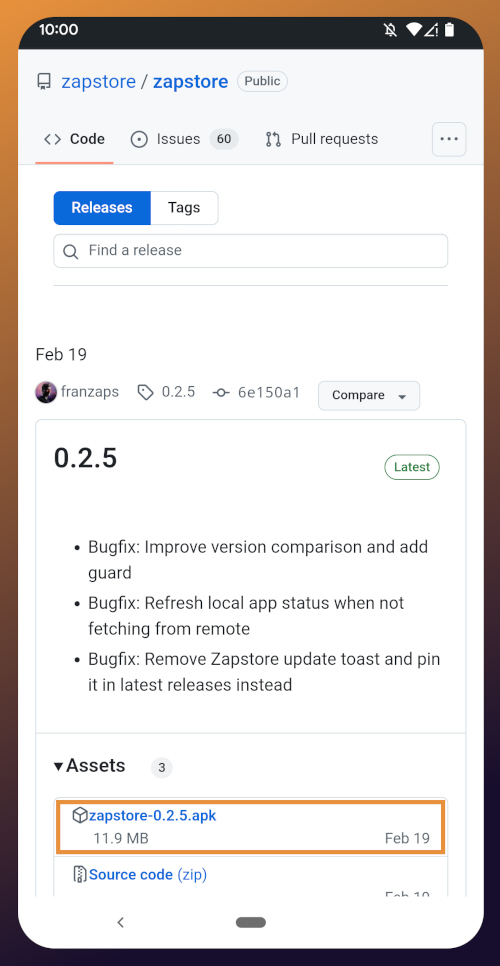
Tap the .apk to download it, and you should get a notification when the download has completed, with a prompt to open the file.
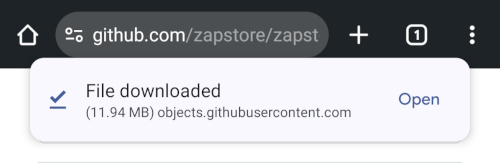
You will likely be presented with a prompt warning you that your phone currently isn't allowed to install applications from "unknown sources." Anywhere other than the Play Store is considered an "unknown source" by default. However, you can manually allow installation from unknown sources in the settings, which the prompt gives you the option to do.
In the settings page that opens, toggle it to allow installation from this source, and you should be prompted to install the application. If you aren't, simply go to your web browser's downloads and tap on the .apk file again, or go into your file browser app and you should find the .apk in your Downloads folder.
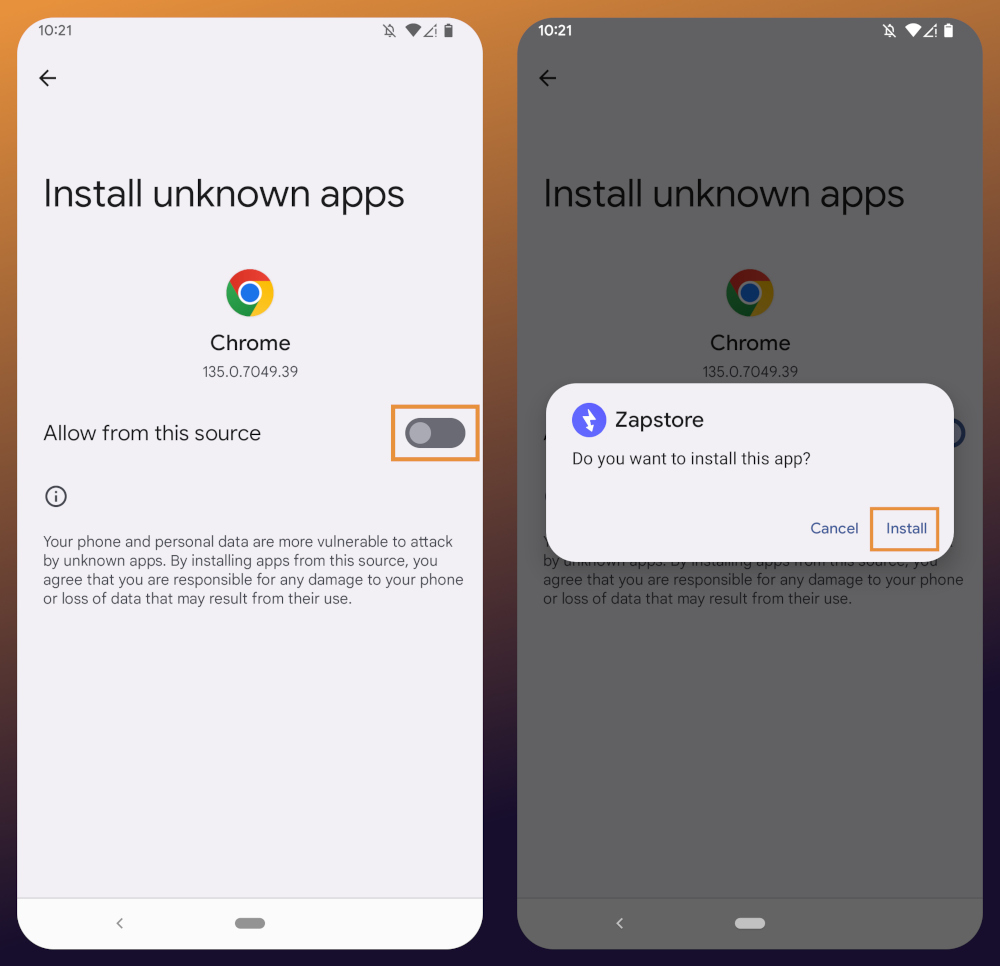
If the application doesn't open automatically after install, you will find it in your app drawer.
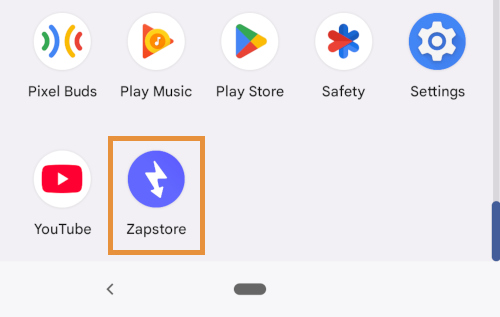
Home Page
Right at the top of the home page in the Zapstore is the search bar. You can use it to find a specific app you know is available in the Zapstore.

There are quite a lot of open source apps available, and more being added all the time. Most are added by the Zapstore developer, nostr:npub1wf4pufsucer5va8g9p0rj5dnhvfeh6d8w0g6eayaep5dhps6rsgs43dgh9, but some are added by the app developers themselves, especially Nostr apps. All of the applications we will be installing through the Zapstore have been added by their developers and are cryptographically signed, so you know that what you download is what the developer actually released.
The next section is for app discovery. There are curated app collections to peruse for ideas about what you may want to install. As you can see, all of the other apps we will be installing are listed in nostr:npub1wf4pufsucer5va8g9p0rj5dnhvfeh6d8w0g6eayaep5dhps6rsgs43dgh9's "Nostr" collection.

In future releases of the Zapstore, users will be able to create their own app collections.
The last section of the home page is a chronological list of the latest releases. This includes both new apps added to the Zapstore and recently updated apps. The list of recent releases on its own can be a great resource for discovering apps you may not have heard of before.

Installed Apps
The next page of the app, accessed by the icon in the bottom-center of the screen that looks like a clock with an arrow circling it, shows all apps you have installed that are available in the Zapstore. It's also where you will find apps you have previously installed that are ready to be updated. This page is pretty sparse on my test profile, since I only have the Zapstore itself installed, so here is a look at it on my main profile:
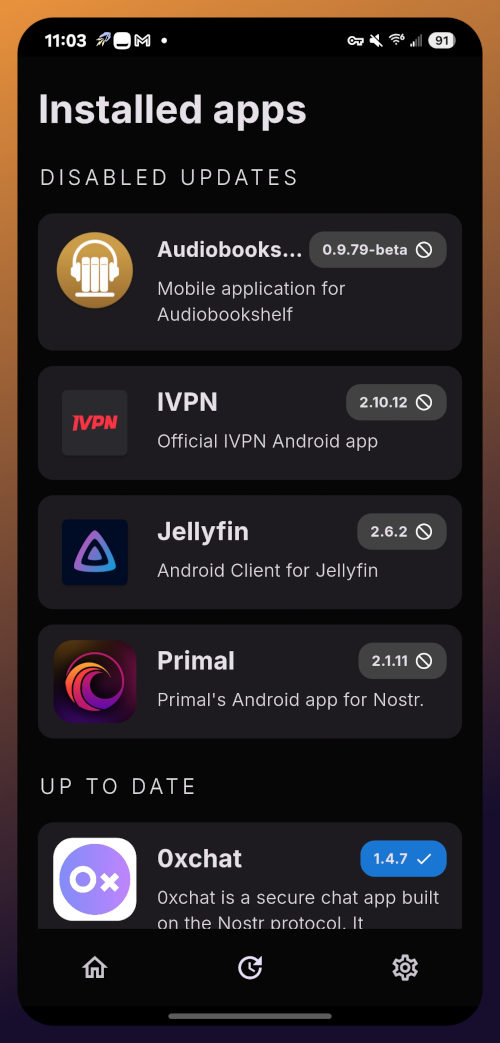
The "Disabled Apps" at the top are usually applications that were installed via the Play Store or some other means, but are also available in the Zapstore. You may be surprised to see that some of the apps you already have installed on your device are also available on the Zapstore. However, to manage their updates though the Zapstore, you would need to uninstall the app and reinstall it from the Zapstore instead. I only recommend doing this for applications that are added to the Zapstore by their developers, or you may encounter a significant delay between a new update being released for the app and when that update is available on the Zapstore.
Tap on one of your apps in the list to see whether the app is added by the developer, or by the Zapstore. This takes you to the application's page, and you may see a warning at the top if the app was not installed through the Zapstore.
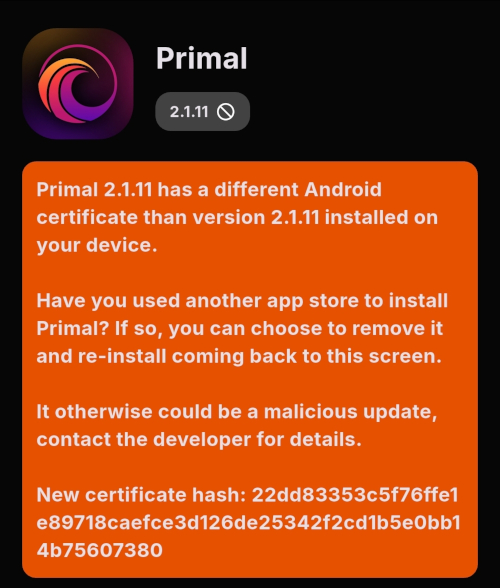
Scroll down the page a bit and you will see who signed the release that is available on the Zapstore.

In the case of Primal, even though the developer is on Nostr, they are not signing their own releases to the Zapstore yet. This means there will likely be a delay between Primal releasing an update and that update being available on the Zapstore.
Settings
The last page of the app is the settings page, found by tapping the cog at the bottom right.
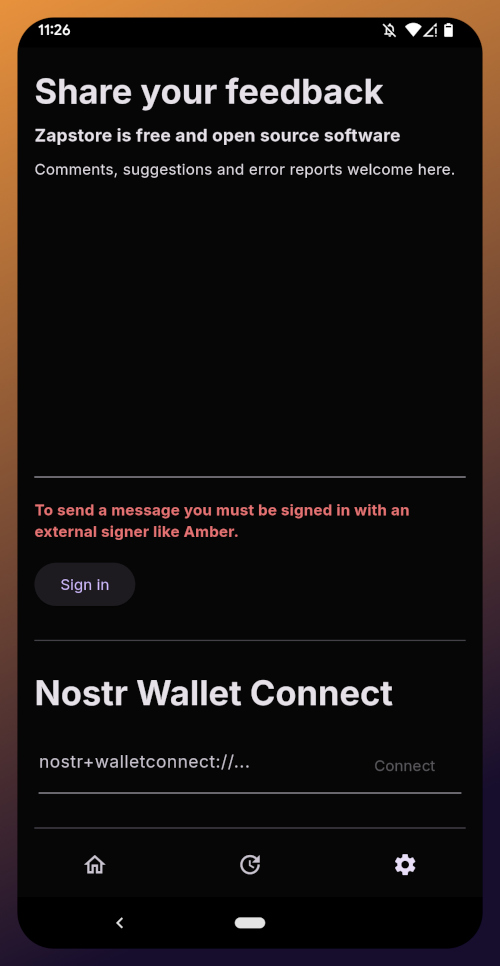
Here you can send the Zapstore developer feedback directly (if you are logged in), connect a Lightning wallet using Nostr Wallet Connect, delete your local cache, and view some system information.
We will be adding a connection to our nostr:npub1h2qfjpnxau9k7ja9qkf50043xfpfy8j5v60xsqryef64y44puwnq28w8ch wallet in part 5 of this tutorial series.
For the time being, we are all set with the Zapstore and ready for the next stage of our journey.
Continue to Part 3: Amber Signer. Nostr link: nostr:naddr1qqxnzde5xuengdeexcmnvv3eqgstwf6d9r37nqalwgxmfd9p9gclt3l0yc3jp5zuyhkfqjy6extz3jcrqsqqqa28qy2hwumn8ghj7un9d3shjtnyv9kh2uewd9hj7qg6waehxw309aex2mrp0yhxyunfva58gcn0d36zumn9wss80nug
-
 @ b7274d28:c99628cb
2025-05-28 00:59:49
@ b7274d28:c99628cb
2025-05-28 00:59:49Your identity is important to you, right? While impersonation can be seen in some senses as a form of flattery, we all would prefer to be the only person capable of representing ourselves online, unless we intentionally delegate that privilege to someone else and maintain the ability to revoke it.
Amber does all of that for you in the context of #Nostr. It minimizes the possibility of your private key being compromized by acting as the only app with access to it, while all other Nostr apps send requests to Amber when they need something signed. This even allows you to give someone temporary authority to post as you without giving them your private key, and you retain the authority to revoke their permissions at any time.
nostr:npub1w4uswmv6lu9yel005l3qgheysmr7tk9uvwluddznju3nuxalevvs2d0jr5 has provided Android users with an incredibly powerful tool in Amber, and he continues to improve its functionality and ease of use. Indeed, there is not currently a comparative app available for iOS users. For the time being, this superpower is exclusive to Android.
Installation
Open up the Zapstore app that you installed in the previous stage of this tutorial series.
Very likely, Amber will be listed in the app collection section of the home page. If it is not, just search for "Amber" in the search bar.

Opening the app's page in the Zapstore shows that the release is signed by the developer. You can also see who has added this app to one of their collections and who has supported this app with sats by zapping the release.
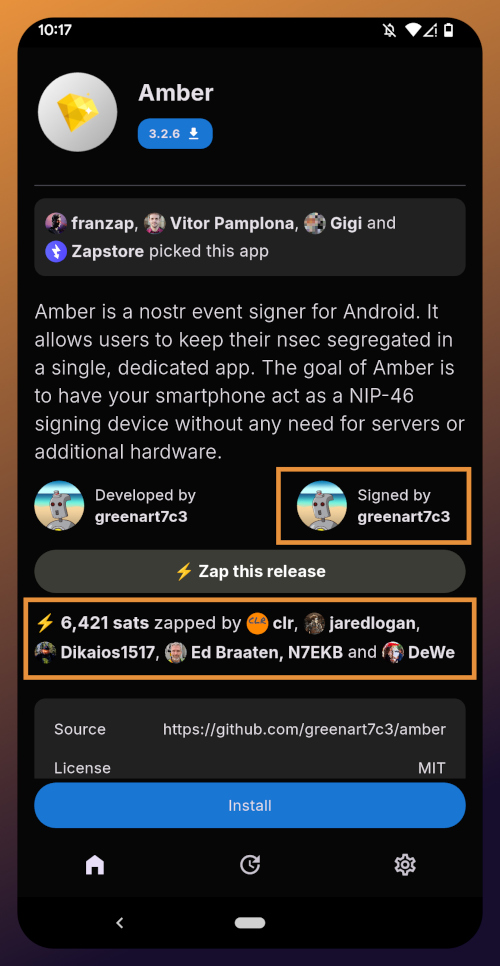
Tap "Install" and you will be prompted to confirm you are sure you want to install Amber.

Helpfully, you are informed that several other users follow this developer on Nostr. If you have been on Nostr a while, you will likely recognize these gentlemen as other Nostr developers, one of them being the original creator of the protocol.
You can choose to never have Zapstore ask for confirmation again with apps developed by nostr:npub1w4uswmv6lu9yel005l3qgheysmr7tk9uvwluddznju3nuxalevvs2d0jr5, and since we have another of his apps to install later in this tutorial series, I recommend you toggle this on. Then tap on "Trust greenart7c3 and install app."
Just like when you installed the Zapstore from their GitHub, you will be prompted to allow the Zapstore to install apps, since Android considers it an "unknown source."
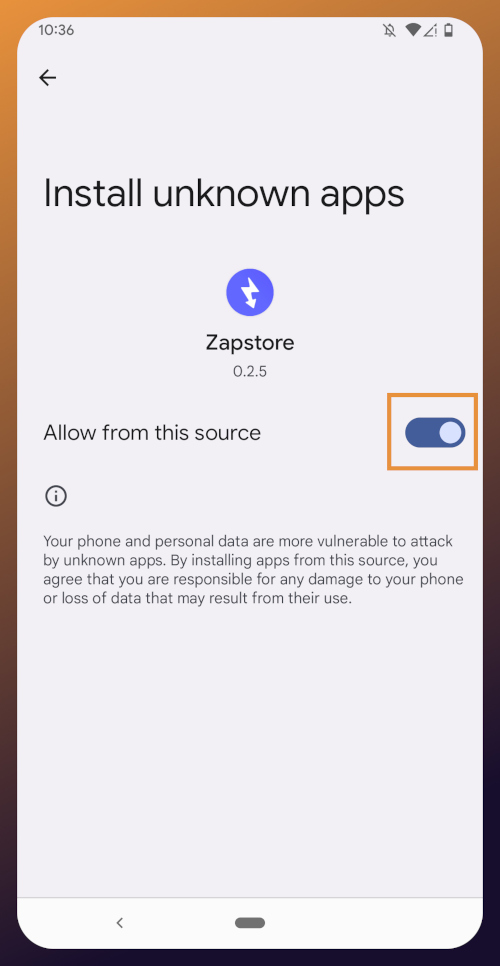
Once you toggle this on and use the back button to get back to the Zapstore, Amber will begin downloading and then present a prompt to install the app. Once installed, you will see a prompt that installation was a success and you can now open the app.

From here, how you proceed will depend on whether you need to set up a new Nostr identity or use Amber with an existing private key you already have set up. The next section will cover setting up a new Nostr identity with Amber. Skip to the section titled "Existing Nostrich" if you already have an nsec that you would like to use with Amber.
New Nostrich
Upon opening the application, you will be presented with the option to use an existing private key or create a new Nostr account. Nostr doesn't really have "accounts" in the traditional sense of the term. Accounts are a relic of permissioned systems. What you have on Nostr are keys, but Amber uses the "account" term because it is a more familiar concept, though it is technically inaccurate.

Choose "Create a new Nostr account" and you will be presented with a screen telling you that your Nostr account is ready. Yes, it was really that easy. No email, no real name, no date of birth, and no annoying capcha. Just "Create a new account" and you're done.
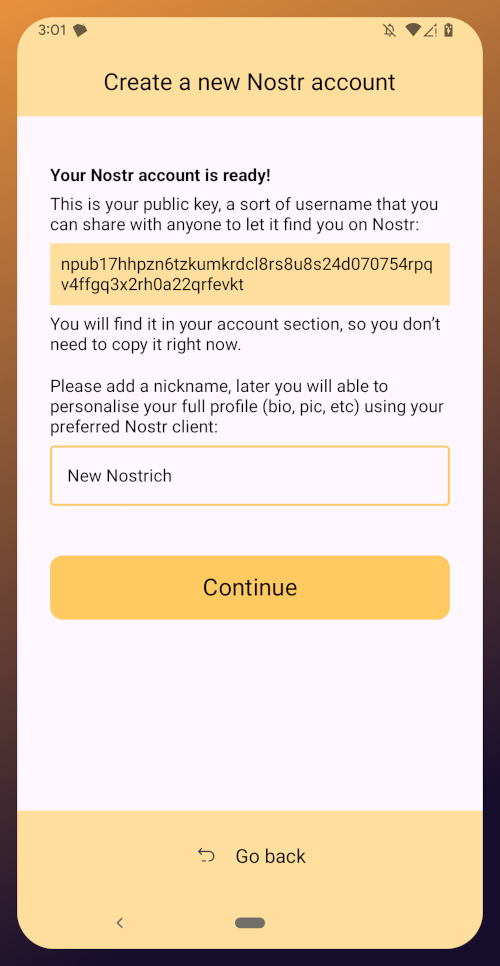
The app presents you with your public key. This is like an address that can be used to find your posts on Nostr. It is 100% unique to you, and no one else can post a note that lists this npub as the author, because they won't have the corresponding private key. You don't need to remember your npub, though. You'll be able to readily copy it from any Nostr app you use whenever you need it.
You will also be prompted to add a nickname. This is just for use within Amber, since you can set up multiple profiles within the app. You can use anything you want here, as it is just so you can tell which profile is which when switching between them in Amber.
Once you've set your nickname, tap on "Continue."
The next screen will ask you what Amber's default signing policy should be.

The default is to approve basic actions, referring to things that are common for Nostr clients to request a signature for, like following another user, liking a post, making a new post, or replying. If you are more concerned about what Amber might be signing for on your behalf, you can tell it to require manual approval for each app.
Once you've made your decision, tap "Finish." You will also be able to change this selection in the app settings at any time.
With this setup out of the way, you are now presented with the main "Applications" page of the app.
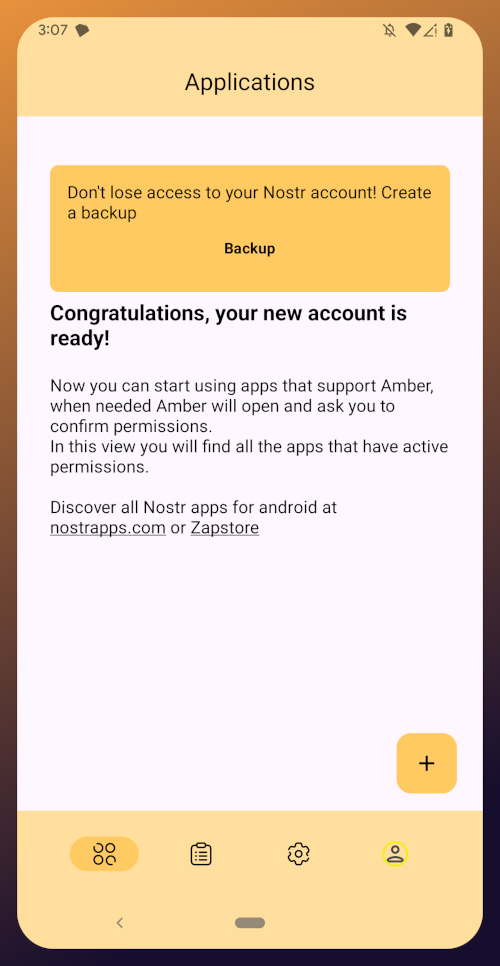
At the top, you have a notification encouraging you to create a backup. Let's get that taken care of now by tapping on the notification and skipping down to the heading titled "Backing Up Your Identity" in this tutorial.
Existing Nostrich
Upon opening the application, you will be presented with the option to use your private key or create a new Nostr account. Choose the former.

The next screen will require you to paste your private key.

You will need to obtain this from whatever Nostr app you used to create your profile, or any other Nostr app that you pasted your nsec into in the past. Typically you can find it in the app settings and there will be a section mentioning your keys where you can copy your nsec. For instance, in Primal go to Settings > Keys > Copy private key, and on Amethyst open the side panel by tapping on your profile picture in the top-left, then Backup Keys > Copy my secret key.
After pasting your nsec into Amber, tap "Next."

Amber will give you a couple options for a default signing policy. The default is to approve basic actions, referring to things that are common for Nostr clients to request a signature for, like following another user, liking a post, making a new post, or replying. If you are more concerned about what Amber might be signing for on your behalf, you can tell it to require manual approval for each app.
Once you've made your decision, tap "Finish." You will also be able to change this selection in the app settings at any time.

With this setup out of the way, you are now presented with the main "Applications" page of the app. You have nothing here yet, since you haven't used Amber to log into any Nostr apps, but this will be where all of the apps you have connected with Amber will be listed, in the order of the most recently used at the top.
Before we go and use Amber to log into an app, though, let's make sure we've created a backup of our private key. You pasted your nsec into Amber, so you could just save that somewhere safe, but Amber gives you a few other options as well. To find them, you'll need to tap the cog icon at the bottom of the screen to access the settings, then select "Backup Keys."
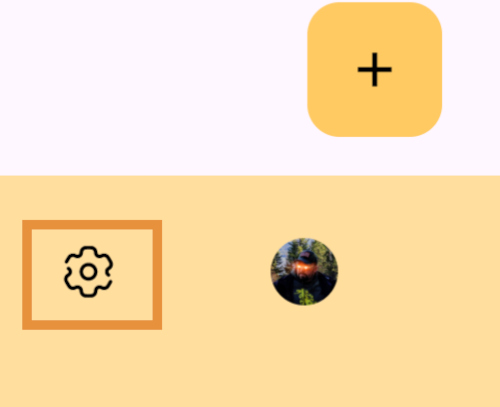
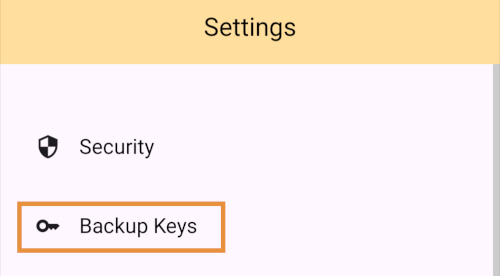
Backing Up Your Identity

You'll notice that Amber has a few different options for backing up your private key that it can generate.
First, it can give you seed words, just like a Bitcoin seed. If you choose that option, you'll be presented with 12 words you can record somewhere safe. To recover your Nostr private key, you just have to type those words into a compatible application, such as Amber.
The next option is to just copy the secret/private key in its standard form as an "nsec." This is the least secure way to store it, but is also the most convenient, since it is simple to paste into another signer application. If you want to be able to log in on a desktop web app, the browser extension Nostr signers won't necessarily support entering your 12 word seed phrase, but they absolutely will support pasting in your nsec.
You can also display a QR code of your private key. This can be scanned by Amber signer on another device for easily transferring your private key to other devices you want to use it on. Say you have an Android tablet in addition to your phone, for instance. Just make sure you only use this function where you can be certain that no one will be able to get a photograph of that QR code. Once someone else has your nsec, there is no way to recover it. You have to start all over on Nostr. Not a big deal at this point in your journey if you just created a Nostr account, but if you have been using Nostr for a while and have built up a decent amount of reputation, it could be much more costly to start over again.
The next options are a bit more secure, because they require a password that will be used to encrypt your private key. This has some distinct advantages, and a couple disadvantages to be aware of. Using a password to encrypt your private key will give you what is called an ncryptsec, and if this is leaked somehow, whoever has it will not necessarily have access to post as you on Nostr, the way they would if your nsec had been leaked. At least, not so long as they don't also have your password. This means you can store your ncryptsec in multiple locations without much fear that it will be compromised, so long as the password you used to encrypt it was a strong and unique one, and it isn't stored in the same location. Some Nostr apps support an ncryptsec for login directly, meaning that you have the option to paste in your ncryptsec and then just log in with the password you used to encrypt it from there on out. However, now you will need to keep track of both your ncryptsec and your password, storing both of them safely and separately. Additionally, most Nostr clients and signer applications do not support using an ncryptsec, so you will need to convert it back to a standard nsec (or copy the nsec from Amber) to use those apps.
The QR option using an ncryptsec is actually quite useful, though, and I would go this route when trying to set up Amber on additional devices, since anyone possibly getting a picture of the QR code is still not going to be able to do anything with it, unless they also get the password you used to encrypt it.
All of the above options will require you to enter the PIN you set up for your device, or biometric authentication, just as an additional precaution before displaying your private key to you.
As for what "store it in a safe place" looks like, I highly recommend a self-hosted password manager, such as Vaultwarden+Bitwarden or KeePass. If you really want to get wild, you can store it on a hardware signing device, or on a steel seed plate.
Additional Settings
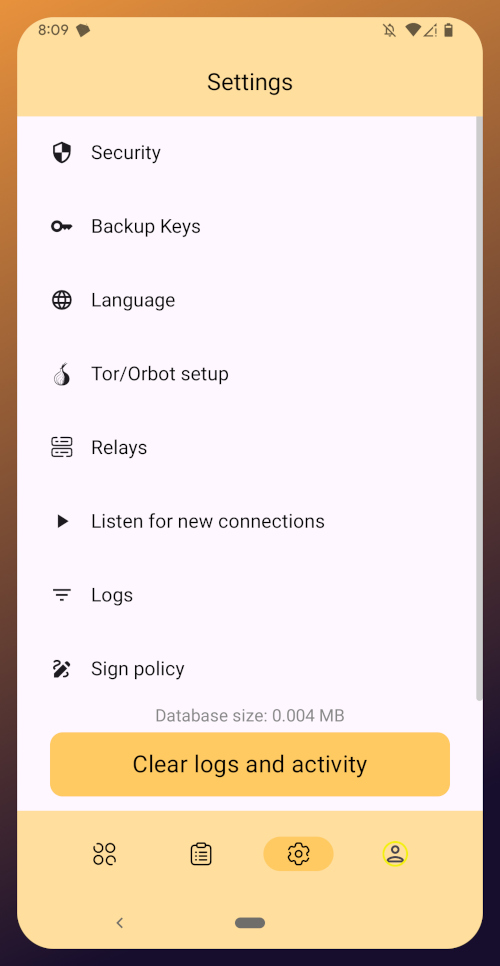
Amber has some additional settings you may want to take advantage of. First off, if you don't want just anyone who has access to your phone to be able to approve signing requests, you can go into the Security settings add a PIN or enable biometrics for signing requests. If you enable the PIN, it will be separate from the PIN you use to access your phone, so you can let someone else use your phone, like your child who is always begging to play a mobile game you have installed, without worrying that they might have access to your Nostr key to post on Amethyst.
Amber also has some relay settings. First are the "Active relays" which are used for signing requests sent to Amber remotely from Nostr web apps. This is what enables you to use Amber on your phone to log into Nostr applications on your desktop web browser, such as Jumble.social, Coracle.social, or Nostrudel.ninja, eliminating your need to use any other application to store your nsec whatsoever. You can leave this relay as the default, or you can add other relays you want to use for signing requests. Just be aware, not all relays will accept the notes that are used for Nostr signing requests, so make sure that the relay you want to use does so. In fact, Amber will make sure of this for you when you type in the relay address.
The next type of relays that you can configure in Amber are the "Default profile relays." These are used for reading your profile information. If you already had a Nostr identity that you imported to Amber, you probably noticed it loaded your profile picture and display name, setting the latter as your nickname in Amber. These relays are where Amber got that information from. The defaults are relay.nostr.band and purplepag.es. The reason for this is because they are aggregators that look for Nostr profiles that have been saved to other relays on the network and pull them in. Therefore, no matter what other relay you may save your profile to, Amber will likely be able to find it on one of those two relays as well. If you have a relay you know you will be saving your Nostr profiles to, you may want to add it to this list.
You can also set up Amber to be paired with Orbot for signing over Tor using relays that are only accessible via the Tor network. That is an advanced feature, though, and well beyond the scope of this tutorial.
Finally, you can update the default signing policy. Maybe after using Amber for a while, you've decided that the choice you made before was too strict or too lenient. You can change it to suit your needs.
Zapstore Login
Now that you are all set up with Amber, let's get you signed into your first Nostr app by going back to the Zapstore.
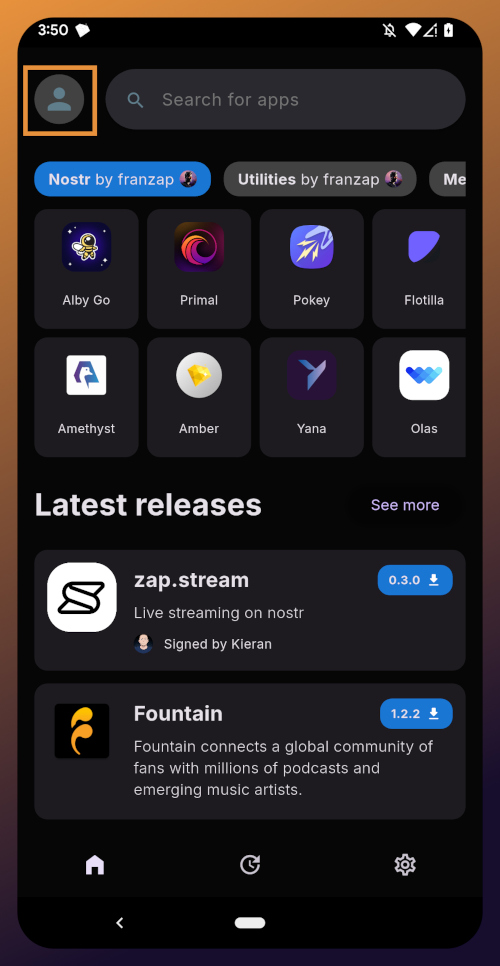
From the app's home screen, tap on the user icon in the upper left of the screen. This will open a side panel with not much on it except the option to "sign in." Go ahead and tap on it.
You will be presented with the option to either sign in with Amber, or to paste your npub. However, if you do the latter, you will only have read access, meaning you cannot zap any of the app releases. There are other features planned for the Zapstore that may also require you to be signed in with write access, so go ahead and choose to log in with Amber.
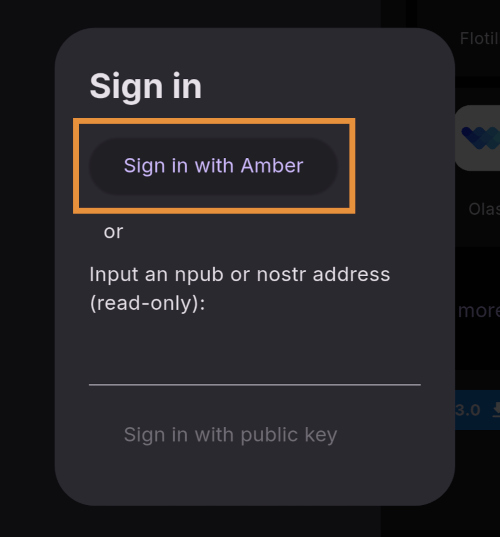
Your phone should automatically switch to Amber to approve the sign-in request.

You can choose to only approve basic actions for Zapstore, require it to manually approve every time, or you can tell it that you "fully trust this application." Only choose the latter option with apps you have used for a while and they have never asked you to sign for anything suspicious. For the time being, I suggest you use the "Approve basic actions" option and tap "Grant Permissions."
Your phone will switch back to the Zapstore and will show that you are now signed in. Congratulations! From here on out, logging into most Nostr applications will be as easy as tapping on "Log in with Amber" and approving the request.

If you set up a new profile, it will just show a truncated version of your npub rather than the nickname you set up earlier. That's fine. You'll have an opportunity to update your Nostr profile in the next tutorial in this series and ensure that it is spread far and wide in the network, so the Zapstore will easily find it.
That concludes the tutorial for Amber. While we have not covered using Amber to log into Nostr web apps, that is outside the scope of this series, and I will cover it in an upcoming tutorial regarding using Amber's remote signer options in detail.
Since you're already hanging out in the Zapstore, you may as well stick around, because we will be using it right out the gate in the next part of this series: Amethyst Installation and Setup. (Coming Soon)
-
 @ 5d4b6c8d:8a1c1ee3
2025-05-28 12:37:30
@ 5d4b6c8d:8a1c1ee3
2025-05-28 12:37:30https://rumble.com/embed/v6rp3fh/?pub=4e023h
I know some of our stackers are follicly challenged, so I thought I'd pass along this video.
Have any of you tried topical onion juice for hair regrowth?
I'll eat more onion and rosemary and get more Sun, just to be safe.
https://stacker.news/items/991118
-
 @ 491afeba:8b64834e
2025-05-27 23:57:01
@ 491afeba:8b64834e
2025-05-27 23:57:01Quando adolescente eu acreditava na coerência da teoria de "amor líquido" do polonês, sociólogo, Zygmunt Bauman, apresentada no livro "Amor Líquido: Sobre a Fragilidade dos Laços Humanos", qual no meu amadurecimento em estudos, sejam eles no meio acadêmico ou fora, percebo como uma das formas mais rasas de explicar as mudanças e transformações dos padrões de relações sócio-afetivas dos humanos. A seguir colocar-me-ei na minha juventude não tanto recente, direi então que nós, se adolescentes e conservadores, ou mesmo jovens adultos mais conservadores, costumamos levar como dogma uma óptica decadentista generalizada de todos os avanços de eras dos homens, universalizamos por nos ser comum a indistinção entre humanidade e humanidades, ou mesmo "humanity" e "humankind" ("humanidade" como espécime e "humanidade" como um universal), compreendemos toda "essas" como "essa" e indistinguimos as sociedades para com os homens, ou seja, a incapacidade de definir os seres dentro de suas respectivas singularidades e especificidades nos leva ao decadentismo generalista (a crença de que de forma geral, e universal, a "civilização universal" decai moralmente, éticamente, materialmente e espiritualmente), que aparente à nós determinadas mudanças nas relações humanas quanto ao caráter sócio-afetivo, por falta de profundidade e critérios ainda sobre questões alinhadas aos métodos e coerências, ou incoerências, lógicas, nós se jovens e conservadores somos levados ao engodo de concordar com a teoria do amor líquido de Bauman, que devo cá explicar de antemão: trata ela, a teoria, o padrão de "amor" dos tempos presentes como frágil, de prazo (curto e médio) e diferente em grau comparativamente ao amor comum das eras passadas.
Aos jovens mais progressistas opera uma compreensão dialética sobre as eras dos homens nos seu tempo presente, na qual ao tempo que o ser progride ele também regride simultaneamente, ou seja, a medida que aparecem contradições advindas de transformações materiais da realidade humana o ser supera essas contradições e progride em meio as transformações, ainda fazendo parte da lógica dessa indissociavelmente, assim constantemente progredindo e regredindo, havendo para esses dois vetores de distinção: o primeiro é o que releva questões espirituais como ao caráter do pensamento "new age", o segundo ignora essas questões por negar a existência da alma, seguem ao materialismo. Cedem em crer na teoria baumaninana como dogma, pois não encontram outros meios para explicar as transformações da sociedade na esfera sócio-afetiva sem que haja confrontamento direto com determinadas premissas assim pertinemente presentes, ou por não conciliarem com análises relativamente superiores, como a de Anthony Giddens sobre a "relação pura" em "A Transformação da Intimidade" e de François de Singly apresentada em "Sociologie du Couple".
https://i.pinimg.com/736x/6f/b4/9e/6fb49eda2c8cf6dc837a0abfc7e108e6.jpg
Há um problema quando uma teoria deixa de assim ser para vir a tornar-se mais um elemento desconexo da ciência, agora dentro da cultura pop, se assim podemos dizer, ou da cultura de massa, ou se preferirem mesmo "anticultura", esse problema é a sua deformização teórica, tornando-se essa rasa para sua palatabilidade massiva, somada a incapacidade de partes da sociedade civil em compreender as falhas daquilo que já foi massificado. Tive surpresa ao entender que muitos outros compartilham da mesma opinião, a exemplo, possuo um amigo na faculdade, marxista, que ao falarmos sobre nossos projetos de pesquisa, citou ele o projeto de um de nossos colegas, no qual esse referido um de nossos colegas faria seu projeto com base na teoria do amor líquido de Bauman, então alí demos risada disso, ora, para nós a teoria baumaniana é furada, passamos a falar sobre Bauman e o motivo pelo qual não gostávamos, lá fiquei até surpreso em saber que mais gente além de mim não gostava da teoria de Bauman, pois ao que eu via na internet era rede de enaltecimentos à figura e à sua teoria, tal como fosse uma revelação partindo de alguma divindade da Idade do Bronze. Pouco tempo depois tive em aula de teoria política uma citação de Bauman partindo do professor que ministrava a disciplina, no entanto, ao citar o nome de Bauman o mesmo fez uma feição na qual aparentava segurar risada, provavelmente ele também não levava Bauman à sério. Não devo negar que todas as vezes que vejo o sociólogo sendo citado em alguma nota no X, no Instagram ou qualquer outra rede social, tal como fosse um referencial teórico bom, sinto uma vergonha alheia pois alí tenho uma impressão de que a pessoa não leu Bauman e usa o referencial teórico como um fato já assim provado e comprovado.
Há pontos positivos na teoria baumaniana, como a capacidade de perceber o problema e correlacioná-lo à modernidade, assim como sucitar a influência do que há de material no fenômeno, porém os erros são pertinentes: o primeiro problema é de categoria. Não há, por parte de Bauman noção alguma entre as dissociações dos amores, não há atenção sobre o amor como estrutura ou ele como um sentimento, todo ele é compreendido uniformemente como "amor", partindo do pressuposto que todas as relações, todas elas, são firmadas com base no amor. Essa crença tem uma origem: Hegel. Nos Escritos Teológicos Hegel partia da crença que o amor ligava os seres relacionalmente como uma força de superação e alienação, mas há de compreendermos que esse Friedrich Hegel é o jovem ainda pouco maduro em suas ideias e seu sistema de pensamento, mais a frente, em "Fenomenologia do Espírito e na Filosofia do Direito", Hegel compreende a institucionalidade do direito no amor e a institucionalização dessa força, assim aproxima-se da realidade a respeito da inserção do amor nas esferas práticas do humano, porém essa ideia, apesar de imperfeita, pois ao que sabemos não é o amor que consolida a relação, mas sim a Verdade (Alétheia), conforme apontado por Heidegger em "Ser e Tempo", essa ideia do amor como a fundamento das relações humanas influenciou, e até hoje influencia, qualquer análise sobre as relações humanas fora da esfera materialista, fora dessa pois, melhormente explicado em exemplo, os marxistas (em exemplo), assim como Marx, consideram como base primordial das relações as condições materiais.
Por certo, não é de todo amor a base para a solidificação, ora, erram aqueles que creem que somente essa força, assim apontada por Hegel, constituiam todos os relacionamentos formais como pilares fundamentais, pois em prática as famílias eram até a fiduciarização dessas, por mais paradoxal que seja, compreendidas melhor como instituições orgânicas de caráter legal do que conluios de afetividades. A família outrora tinha consigo aparelhos de hierarquia bem estabelicidos, quais prezavam pela ordem interna e externa, que acima dessa instituição estava somente a Igreja (outra instituição), com sua fiduciarização [da família] após o movimento tomado pelos Estados nacionais em aplicação do casamento civil mudou-se a lógica das partes que a compõe, findou-se o princípio da subsidiariedade (não intervenção de determinadas instituições nas decisões quais podem ser exercidas em resuluções de problemas nas competências de quaisquer instituições), foi-se então, contudo, também a autoridade, e nisso revela-se um outro problema não apontado na teoria de Bauman: qual o padrão do amor "sólido"? Pois, ora, sociedades tradicionais não abdicavam do relevar dos amores para tornar seus filhos em ativos nas práticas de trocas (dádivas)? É notório que esse padrão se dissocia do padrão de sentimento apontado por Bauman, encontramos esse fato em estudo nos trabalhos "Ensaio Sobre a Dádiva", do Marcel Mauss, e "As Estruturas Elementares do Parentesco", do Claude Levi-Strauss, quais expõem que nas sociedades "sólidas", tradicionais, relevava-se mais questões institucionais que as sentimentais para a formação de laços (teoria da aliança). Muitas das relações passadas não eram baseadas no amor, não significando assim que as de hoje, em oposição, sejam, mas que permanecem-se semelhantes em base, diferentemente em grau e forma.
https://substackcdn.com/image/fetch/f_auto,q_auto:good,fl_progressive:steep/https%3A%2F%2Fsubstack-post-media.s3.amazonaws.com%2Fpublic%2Fimages%2F748b94c3-f882-45db-8333-09260ef15cfe_615x413.jpeg
Ora, ainda existem casamentos motivados pela política, pelo status, pelo prestígio, pelos bens, pelo poder, pela influência familiar e assim sucetivamente, tal como no passado, ocorre que essa prática tornou-se oculta, não mais explícita e aparente, devo dizer ainda que em partes, pois prepondera em nosso tempo uma epidemia de adultérios, fornicações, práticas lascivas e demais práticas libertinosas explicitamente, em contraposição às práticas ocultas em vergonhas de sociedades sem declínio moral e espiritual, o que nos leva a questionar o método comparativo em dicotomia temporal "presente x passado" aplicado por Bauman, no qual segue-se da seguinte forma:
Transformação Passado = *sólido* | Presente = *líquido* Categorias Padrão de amor: tradicional (*sólido*) moderno (*líquido*) *Sólido* = estável, prazo (médio-grande), profundo, determinado. *Líquido* = instável, prazo (curto-médio), raso, indeterminado.O que penso é: Zygmunt Bauman buscou uma explicação material e laical para desviar ao fato de que há uma notória correlação entre espiritualização da sociedade, se voltada à Verdade, com a estabilidade das instituições, o que é já reduzido à moral religiosa, somente, não à mística, como por pensadores da linha de Tocqueville, ou em abordagens também mais laical (positivista) porém ainda relevantes, como Émile Durkheim em "As Formas Elementares da Vida Religiosa" e Max Weber em "A Ética Protestante e o Espírito do Capitalismo", contrapondo uma abordage mais voltada, de fato, a espiritualidade, como Christopher Dawnson, que defende essa teoria em "Religião e o Surgimento da Cultura Ocidental", e Eric Voegelin, principalmente nas obras "A Nova Ciência da Política" e "Ordem e História".
Encerrando, minha cosmovisão é a católica, o sistema de crença e religião qual sigo é do Deus que se fez homem por amor aos seus filhos, não posso negar ou mesmo omitir o fato de que, por trás de toda a minha crítica estão meus pensamentos e minhas convicções alinhadas àquilo que mais tenho amor em toda minha vida: a Verdade, e a Verdade é Deus, pois Cristo é a Verdade, o Caminho e a Vida, ninguém vai ao Pai se não por Ele, e pois bem, seria incoerência de minha parte não relevar o fato de crença como um dos motivos pelos quais eu rejeito a teoria do amor líquido de Zygmunt Bauman, pois os amores são todos eles praticados por formas, existem por diferentes formas e assim são desde sua tradicionalidade até o predomínio das distorções de declínio espiritual das eras presentes (e também antigas pré-Era Axial), estão esses preservados pelo alinhamento à verdade, assim são indistorcíveis, imutáveis, ou seja, amor é amor, não releva-se o falso amor como um, simplesmente não o é, assim o interesse, a sanha por bens, o egoísmo e a egolatria ("cupiditas", para Santo Agostinho de Hipona, em oposição ao que o santo e filósofo trata por "caritas") não são formas do amor, são autoenganos, não bons, se não são bons logo não são de Deus, ora, se Deus é amor, se ele nos ama, determino como amor (e suas formas) o que está de acordo com a Verdade. Aprofundando, a Teologia do Corpo, do Papa São João Paulo II, rejeita a "liquidez" apresentada por Bauman, pois o amor é, em suma, sacríficio, parte da entrega total de si ao próximo, e se não há logo não é amor. A Teologia do Corpo rejeita não os fundamentos de mentira no "líquido", mas também no "sólido", pois a tradicionalidade não é sinônimo de bom e pleno acordo com o amor que Deus pede de nós, não são as coerções, as violências, as imposições e demais vontades em oposição às de Deus que determinam os amores -- fatos em oposição ao ideário romanticizado. Claro, nem todas as coerções são por si inválidas do amor, ou mesmo as escolhas em trocas racionalizadas, a exemplo do autruísmo em vista da chance da família ter êxito e sucesso, ou seja, pelo bem dos próximos haver a necessidade de submissão a, em exemplo, um casamento forjado, ou algo do gênero, reconhece-se o amor no ato se feito por bem da família, porém o amor incutido, nesse caso, explicita o caráter sacrificial, no qual uma vontade e um amor genuinamente potencial em prazeres e alegrias são anulados, ou seja, mesmo nesse modelo tradicional na "solidez" há possibilidade do amor, não nas formas romanticizadas em critérios, como "estabilidade" e "durabilidade", mas no caráter do sacríficio exercido. Conforme nos ensina São Tomás de Aquino, o amor não é uma "força", tal como ensina Hegel, mas sim uma virtude teologal conforme na "Suma Teológica" (II-II Q. 26-28), não devemos reduzir o amor e os amores em análises simplórias (não simples) de falsa complexidade extraídas em métodos questionáveis e pouco competentes à real diensão de crise espiritual das eras, por esse motivo não concordo com a teoria do amor líquido de Zygmunt Bauman.
-
 @ bf47c19e:c3d2573b
2025-05-27 21:19:32
@ bf47c19e:c3d2573b
2025-05-27 21:19:32Originalni tekst na bitcoin-balkan.com.
Pregled sadržaja
- Procena vrednosti
- Većina Bitcoin-ovih pozitivnih strana opstaje
- Broj ljudi koji su prihvatili Bitcoin
- Zaključak
Prošlo je trinaest godina od nastanka Bitcoina i lako je poverovati da je većina njegovog rasta iza njega. Deo ovoga je rezultat predrasude koju svi delimo i što nas navodi da zamislimo trenutno stanje stvari kao završni stepen njegovog razvoja. Svaki bitcoiner je nekad mislio da je prekasan sa Bitcoin-om. Međutim, kada primenjujemo kritičko razmišljanje da bismo procenili gde je Bitcoin u svojoj putanji rasta, otkrivamo da je suprotno u stvari tačno: još uvek je vrlo, vrlo rano.
Postoje dva načina da razmišljate o tome koliko je rano za Bitcoin kao zalihu vrednosti neke imovine:
-
Procena vrednosti kao procenat od njegovog punog potencijala
-
Prihvatanje kao procenat od njegovog punog potencijala (na čemu je fokus u ovom članku).
Procena vrednosti
Prvi i najčešći način da se proceni koliko je rano za Bitcoin je da se pogleda njegova ukupna vrednost (trenutno oko 900B USD) i uporedi sa njegovim punim potencijalom. Izazov sa ovim je očigledno da je puni potencijal Bitcoin-a stvar nagađanja. Oni koji duboko razumeju Bitcoin imaju tendenciju da njegov potencijal posmatraju barem kao potencijal zlata (oko 13T USD), ali teoretski više poput 200T USD (oko polovine ukupne vrednosti sveta).
Za brzi pregled ovog potencijala od 200T USD, pogledajmo ukupno raspoloživo tržište Bitcoin-a. Radi jednostavnosti, samo ćemo razmotriti njegovu ulogu zalihe vrednosti i zanemariti njegov potencijal da pojede tržišni udeo od oko 100T USD ukupne vrednosti u različitim svetskim valutama. Uzimajući u obzir različite zalihe vrednosne imovine i grubom procenom koliki bi % Bitcoin mogao da uzme od njih, dobili smo ovakav rezultat:

Iako put do 200T USD nije veliko rastezanje, u stvarnoj vrednosti čini se previše dobrim da bi bio istinit. Sa obzirom da je bez presedana da zaliha vrednosti neke robe postigne vrednost veću od zlata, to jednostavno predstavlja neistraženu teritoriju. Ali čak i ako se jednostavno pridržavamo targetiranja niže ciljne vrednosti zlata od 13T USD, Bitcoin još uvek tendenciju velikog porasta svoje cene u budućnosti.
Većina Bitcoin-ovih pozitivnih strana opstaje
Svako ko razmišlja da nešto svog teško zarađenog novca uskladišti u Bitcoin pita se „da li sam poranio ili zakasnio?“ Nepisano je pravilo da se svako oseća kao da je zakasnio kad stigne. Brojni su primeri ljudi koji žale kako su zakasnili 2011. ili 2013. ili 2016. godine, kada je cena Bitcoin-a bila 5, 100, odnosno 600 USD.
Kao i u bilo kojoj zajednici koja se razvija i raste i u kojoj ima manjka nekretninama, pridošlice zavide ljudima koji su već obezbedili sebi nekretninu, ne sluteći da će njima zavideti ljudi koji tek treba da dođu. Ovaj fenomen je primenjiv i na velikom broju drugih primera. Na primer, zakasneli u Kalifornijskoj zlatnoj groznici bili su razočarani kada su došli, a bogata zlatna polja su već bila iscrpljena, i umesto toga su se naseliti na nekoliko stotina hektara zemljišta, a koje sada vrede bogatstvo.
U srcu ovog osećanja je strah da više nema uspona, da više nema novca koji se može zaraditi uzimajući ono što je još uvek ostalo dostupno. Da li smo dostigli tu tačku sa Bitcoin-om?
Pa ne. Čini se da je zapravo suprotno. Na osnovu punog potencijalnog opsega procene koji smo utvrdili gore, čak i u ishodu niskog nivoa (13T USD), velika većina bogatstva koje će steći vlasnici Bitcoin-a, tek treba da se stekne (96%). Da bi parirao proceni zlata, Bitcoin i dalje mora da poraste 26 puta.
A ako se desi vrhunski ishod, punih 99,7% ukupnog stvaranja bogatstva Bitcoin-a ostaje pred nama. To bi značilo da Bitcoin još uvek treba da poraste 400 puta, zanemarujući pariranje zlatu.
Stavljanjem trenutne vrednosti Bitcoin-a u perspektivu, postaje jasno da je za Bitcoin još uvek vrlo rano.
Iako ova analiza sugeriše da za Bitcoin-u ostaje od 26x do 400x rasta, korisno je proveriti ovaj zaključak kroz drugo razumno objašnjenje, a tamo gde je poznat puni potencijal…
Broj ljudi koji su prihvatili Bitcoin
Procene broja vlasnika Bitcoin-a širom sveta se veoma razlikuju. To je dovelo do prilične količine dvosmislenosti i nesigurnosti u vezi sa stvarnim brojevima i određenog stepena odustajanja i mišljenja da je taj broj jednostavno preteško precizno proceniti. Iako je teško utvrditi konačan broj, glavni razlog za odstupanje u procenama je nedostatak standardizovanih definicija šta znači prihvatanje Bitcoin-a.
Istina je da postoje različiti nivoi prihvatanja Bitcoin-a. Podelom na segmente prihvatanja Bitcoin-a lakše je uvideti ne samo zašto postoji širok opseg procena, već i još važnije, koliko je još uvek rano za prihvatanje Bitcoin-a kao preferirane zalihe vrednosti.
U ove svrhe, hajde da podelimo u segmente prihvatanje Bitcoin-a na četiri različita „nivoa“:
1. Kežual amateri (prstom u vodi)
2. Alokatori 1% (stopalima u vodi)
3. Značajni vernici (do pojasa u vodi)
4. Bitcoin maximalisti (u vodi preko glave)
Pre nego što počnemo, potreban nam je imenilac. Mogli bismo da koristimo globalno stanovništvo, ali po mom mišljenju ovo daje loše rezultate. Ono što mi zaista procenjujemo je koji procenat sveta koji poseduje odredjeno bogatstvo za skladištenje u Bitcoin-u, je to i učinio. Prema podacima sa sajta Statista, 2,2 biliona ljudi na svetu poseduje najmanje 10k USD u neto vrednosti, što se čini kao razumna granica za zalihu koju žele da uskladište. Činjenica je da će siromašne zajednice takođe koristiti Bitcoin kao zalihu vrednosti i verovatno će iz njega izvući veću korist kao rezultat marginalnog pristupa tradicionalnoj bankarskoj infrastrukturi kao klijenti banaka sa „niskom vrednošću“. Međutim, u naše svrhe, jednostavno gledamo koliko je ljudi usvojilo Bitcoin među grupama sa značajnim bogatstvom za skladištenje, tako da će 2.2 biliona služiti kao naša puna potencijalna veličina tržišta.
1. Kežual amateri
Ovaj segment ljudi koji su prihvatili Bitcoin uključuje sve one koji imaju bilo koju količinu Bitcoin-a – vašeg prijatelja sa 20 USD BTC-a negde u nekom novčaniku ili vašu tetku koja se ne seća svoje Coinbase lozinke iz 2017. Po mom mišljenju, najveća zabuna oko broja ljudi koji su prihvatili Bitcoin nastaje zbog poistovećivanja „kežual amatera“ sa ljudima koji su u potpunosti prihvatili Bitcoin. Realnost je takva da ljudi ovog segmenta uglavnom samo eksperimentišu, bilo da bi stekli osećaj za ono o čemu svi pričaju, ili samo uložu nekoliko dolara u Bitcoin u nadi da će možda dobiti džekpot, kao što je slučaj sa greb-greb nagradnim igrama.
Zbog toga, „kežual amateri“ su razlog dovodjenja u zabludu pravog broja ljudi koji su u potpunosti prihvatili Bitcoin. Njihovo ponašanje zapravo ne predstavlja prihvatanje u pravom smislu te reči i stoga se ne bi trebalo smatrati ljudima koji su u potpunosti prihvatili Bitcoin. Istina je da, kada kežual amateri shvate da je Bitcoin najbolja zaliha vrednosti neke imovine u istoriji, neće ostati na samo 20 USD u Bitcoin-ima. Umesto toga, oni će svoju štednju prebaciti u mnogo većim iznosima.
Što se tiče odredjivanja veličine ovog segmenta, Willy Woo je sastavio razumno iscrpnu i sveobuhvatnu procenu od oko 187 miliona ljudi koji su prihvatili Bitcoin, što znači da su oni u najmanju ruku „kežual amateri“.
Koristeći ovaj i naš puni potencijal od 2,2 biliona ljudi kao imenioca, 8,5% potencijalnih ljudi koji su prihvatili Bitcoin-e dostiglo je nivo „kežual amatera“. Ovo je prilično velik broj i potpuno obmanjuje stvarni obim potpunog prihvatanja, a što će pokazati sledeći segmenti.
2. Alokatori 1%
Za preostale potkategorije, tačni podaci su manje dostupni. Kao takvi, sve što možemo je da smislimo razumne procene putem triangulacije.
Po mom mišljenju, „alokatori 1%“ se mogu okarakterisati kao ljudi koji su prihvatili Bitcoin, i koji žele da imaju mali, ali ne i zanemarljivi deo u Bitcoin-u. Za naše svrhu, mislim da je pristojan prag za ovu grupu svako ko ima najmanje 0,1 Bitcoin, i može se smatrati da imaju malu, ali ne i zanemarljivu poziciju u Bitcoin-u.
Gledajući Bitcoin blockchain, postoji oko 3 miliona adresa koje imaju najmanje 0,1 BTC. Pored ovih brojeva na blockchain-u, moramo da uzmemo u obzir i znatan broj ljudi koji imaju ovaj iznos na berzi ili GBTC-u. Kombinovanjem, mislim da je razumno proceniti da je 10 miliona ljudi dostiglo nivo „alokatora 1%“ ili veći.
Na osnovu ovih brojeva, samo 1⁄17 „kežual amatera“ dostiglo je nivo prihvatanja „alokatora 1%“, što znači da je ovaj nivo prihvatanja Bitcoin-a do danas postigao samo 0,5% penetracije. Ovaj strmi pad je razlog zašto je došlo do zablude da veliki broj „kežual amatera“ bude označeno kao grupa koja je u potpunosti prihvatila Bitcoin.
3. Značajni vernici
U ovu kategoriju spada svako ko je dostigao nivo razumevanja Bitcoin-a da alokacija od 1% ili čak 5% više ne izgleda dovoljna.
Uopšteno govoreći, ova grupa se kreće u rasponu od 5 – 50%. Išao bih toliko daleko da bih rekao da je većina ljudi koji sebe smatraju vernicima u Bitcoin-e, uključujući većinu Bitcoin Twitter-a, negde u ovoj grupi.
Procena veličine ove grupe postaje mnogo nejasnija, ali možemo se osloniti na podatke iz blockchain-a da bismo došli do razumne procene.
Za početak, hajde da utvrdimo da je većina ljudi koji su dostigli ovaj nivo verovanja i razumevanja Bitcoin-a, izborila da poseduje najmanje 1 Bitcoin. Pored toga, ovaj nivo ljudi koji su prihvatili Bitcoin je verovatno osigurao svoj Bitcoin u chain-u novčanika kojim oni upravljaju. Gledajući podatke na chain-u, oko 820k adresa ima najmanje 1 Bitcoin. Kao grubu pretpostavku, uzmimo da 500k od toga poseduju ljudi koji su dostigli nivo prihvatanja „značajnog vernika“.
Ako potom generički zaokružimo akaunte za ljude koji nisu postigli status wholecoiner-a (eng. osoba koja poseduje barem 1 BTC), ili koji svoja sredstva drže na berzi, dolazimo do grube procene od 2 miliona „značajnih vernika“.
4. Bitcoin maximalisti
Za našu svrhu, recimo da ova grupa uključuje svakoga ko je dovoljno duboko ušao u Bitcoin da je zaključio da bi više od 50% njihove neto vrednosti trebalo da bude uskladišteno u Bitcoin-u.
Procena veličine ove grupe je gotovo nemoguća, zato ćemo morati da budemo kreativni.
-
Prodaja „Bitcoin Standard“
-
Hajde da konzervativno procenimo da je samo 20% maximalističara kupilo Bitcoin Standard, i da je 50% tih ljudi koji su ga razumeli, postali maksimalisti. Na osnovu knjige Amazon US rank (6,681), onlajn kalkulatori procenjuju da je prodato oko 15k primeraka.
- Hajde da budemo velikodušni i da zaokružimo taj broj od oko 15k na 50k, uzimajući u obzir međunarodnu prodaju i kupovinu izvan Amazona.
Ovo nas dovodi do procene broja od 125k maximalista. Da ne bismo pogrešili, bićemo oprezni, i udvostručimo taj broj i rećićemo da ih ima 250k.
- Kvalitativna triangulacija
Čisto subjektivno, ali čini mi se da na Twitter-u, primarnom domu za komunikaciju maximalista, postoji možda 10k aktivno angažovanih Bitcoin maximalista. Da budemo vrlo konzervativni, recimo da ovo predstavlja oko 5% maximalista (od ukupno 200k).
Uz to, kao procenu od vrha nadole, čini se opravdanim da je oko 10% ljudi koji su dostigli 5 – 50% alokacije Bitcoin-a napravilo skok ka maximalizmu.
Sve u svemu, cifra od oko 250k Bitcoin maximalista čini se konzervativnom, ako ne i velikodušnom pretpostavkom.
To nas dovodi do 0,01% penetracije.
Zaključak
Kako god gledali brojke, još uvek je rano za Bitcoin. Posmatrajući procenu vrednosti Bitcoin-a kao procenat njegovog punog potencijala, vidimo da je trenutna vrednost Bitcoin-a negde između 0,2% i 3% njegovog krajnjeg stanja, što znači da ostaje 30x do 500x rasta. Gledajući napredak prihvatanja Bitcoin-a, vidimo da je trenutna penetracija Bitcoin-a negde između 0,01% i 8,5%, u zavisnosti od toga koji prag prihvatanja gledate.
Ako verujete, kao što ja verujem, da je Bitcoin na putu da postane dominantna zaliha vrednosti i preferirani novac za ceo svet, na kraju će norma biti više od 50% posedovanja neto vrednosti u Bitcoin-u. Budući da naša analiza ovde sugeriše da samo 0,01% sveta zadovoljava ove standarde, opravdano je zaključiti da 99,99% sveta ostaje da sledi njihov primer.
Sve u svemu, dok svi koji se pojave na Bitcoin-u neizbežno osećaju žaljenje zbog toga što nisu ranije investirali i pitaju se da li su u potpunosti propustili brod, jasno je da većina rasta Bitcoin-a ostaje pred nama. Da stavimo ovo u neki kontekst, obzirom da može postojati samo 21 milion Bitcoin-a, prosečna osoba na zemlji (od 8 biliona ljudi) imaće samo 0,0025 Bitcoin-a. Još je toliko rano, da ukupna neto vrednost te prosečne osobe u Bitcoin-u može da se kupi za samo 90 USD.
I ako mislite da je kasno, zapravo je veoma rano, zato vam čestitam i uživajte u skupljanju sats-ova dok su još uvek ovako jeftini!
-
 @ a3c6f928:d45494fb
2025-05-28 12:21:32
@ a3c6f928:d45494fb
2025-05-28 12:21:32In a world that constantly demands our attention, where external achievements are often mistaken for fulfillment, there is a quieter, more powerful path to freedom—the journey within. True freedom is not merely the absence of constraints but the presence of inner peace, purpose, and self-mastery.
What Is Self-Mastery?
Self-mastery is the ability to govern your thoughts, emotions, and actions in alignment with your values and goals. It is about becoming the author of your own story rather than being swept away by the noise and chaos of the external world. With self-mastery comes clarity, direction, and the freedom to live authentically.
The Pillars of Inner Freedom
-
Self-Awareness: Freedom begins with knowing who you are. Understanding your strengths, triggers, and motivations lays the foundation for personal growth.
-
Discipline: Discipline is not restriction—it is the structure that supports your vision. It turns intention into reality.
-
Emotional Intelligence: Learning to manage emotions, rather than being ruled by them, grants the power to respond rather than react.
-
Purpose: A sense of purpose provides direction. When you know what matters most, distractions lose their power.
Why Self-Mastery Matters
Without self-mastery, external freedom can feel hollow. You might have opportunities, resources, and rights, yet still feel trapped—by fear, self-doubt, or the need for validation. Mastering yourself unlocks the kind of freedom that no one can take away: the freedom to be at peace with who you are.
How to Begin the Journey
-
Reflect Daily: Spend time each day in silence or journaling to deepen your awareness.
-
Set Intentions: Start each day with a clear intention to guide your focus.
-
Challenge Yourself: Growth lies just beyond your comfort zone. Embrace discomfort as part of the process.
-
Seek Stillness: Create moments of stillness to listen to your inner voice.
“He who conquers himself is the mightiest warrior.” — Confucius
True freedom starts from within. Master yourself, and you master your life.
-
-
 @ 6be5cc06:5259daf0
2025-05-27 20:37:22
@ 6be5cc06:5259daf0
2025-05-27 20:37:22At
até uma ferramenta de agendamento de tarefas em Linux usada para executar comandos únicos em um horário e data específicos. Diferente docron, que serve para tarefas recorrentes, oatexecuta uma única vez.Como usar o
at1. Verifique se o
atestá instaladobash which atSe não estiver instalado:
bash sudo apt install atE inicie o serviço (caso necessário):
bash sudo systemctl enable --now atd2. Agendar um comando
bash at 10:00 AM tomorrowVocê será levado a um prompt interativo. Digite o comando desejado e finalize com
Ctrl + D.Exemplo 1:
bash at 09:00 AM next Monday(Entrada do usuário no prompt do
at)echo "Relatório pronto" >> ~/relatorio.txt Ctrl + DResultado: O trecho "relatório pronto" será incluído no documento relatorio.txt.
Exemplo 2:
bash at 21:00 Apr 15Entrada no prompt:
notify-send "Hora de fazer backup!" Ctrl + DResultado: Às 21h do dia 15 de abril, o sistema exibirá uma notificação.
Formatos de Data e Hora Válidos
-
now + 1 minute -
midnight -
tomorrow -
5pm -
08:30 -
7:00am next friday -
noon + 2 days
Visualizar tarefas agendadas
bash atqRemover uma tarefa agendada
bash atrm <número_da_tarefa>Você encontra o número da tarefa com
atq.
cron
O
croné um utilitário de agendamento de tarefas baseado no tempo. Permite executar comandos ou scripts automaticamente em horários específicos. Ele depende do daemoncrond, que deve estar ativo e em execução contínua no sistema.Arquivo de configuração:
-
Cada usuário pode editar seu próprio agendador com:
bash crontab -e -
O formato padrão de uma linha no crontab:
m h dom mon dow comando
|Campo|Descrição|Valores possíveis| |---|---|---| |m|Minuto|0–59| |h|Hora|0–23| |dom|Dia do mês|1–31| |mon|Mês|1–12| |dow|Dia da semana|0–6 (0 = Domingo)| |comando|Comando a executar|Qualquer comando shell válido|
Exemplos:
-
Executar um script a cada minuto:
bash * * * * * /usr/local/bin/execute/this/script.sh -
Fazer backup no dia 10 de junho às 08:30:
bash 30 08 10 06 * /home/sysadmin/full-backup -
Backup todo domingo às 5h da manhã:
bash 0 5 * * 0 tar -zcf /var/backups/home.tgz /home/
Limitações:
Tarefas agendadas com
cronnão são executadas se o computador estiver desligado ou suspenso no horário programado. O comando é simplesmente ignorado. Usecronpara tarefas com data/hora exatas.
anacron
O
anacroné uma alternativa aocronvoltada para sistemas que não ficam ligados o tempo todo, como notebooks e desktops. Ele garante a execução de tarefas periódicas (diárias, semanais, mensais) assim que possível após o sistema ser ligado, caso tenham sido perdidas. Useanacronpara tarefas periódicas tolerantes a atrasos.Verificação da instalação:
bash anacron -VInstalação (caso necessário):
bash sudo apt update sudo apt install anacronArquivo de configuração:
/etc/anacrontabAcessado com:
sudo nano /etc/anacrontabFormato de cada linha:
PERIOD DELAY IDENT COMMAND| Campo | Descrição | | ------- | ------------------------------------------- | | PERIOD | Intervalo em dias (1 = diário, 7 = semanal) | | DELAY | Minutos a esperar após o boot | | IDENT | Nome identificador da tarefa | | COMMAND | Comando ou script a ser executado |
Exemplo:
bash 1 3 limpeza-temporarios /home/usuario/scripts/limpar_tmp.shExecuta o script uma vez por dia, 3 minutos após o sistema ser ligado.
Nota: Não é necessário usar
run-partsnemcron.dailypara tarefas personalizadas. Basta apontar diretamente para o script desejado. Orun-partssó deve ser usado quando se deseja executar todos os scripts de um diretório.Ativação do serviço:
bash sudo systemctl enable --now anacronVerificação de status:
bash systemctl status anacronLogs de execução:
bash grep anacron /var/log/syslog/etc/anacrontab: Arquivo de Configuração doanacronO arquivo
/etc/anacrontabdefine tarefas periódicas a serem executadas peloanacron, garantindo que comandos sejam executados mesmo que o computador esteja desligado no horário originalmente programado.Cabeçalho Padrão
bash SHELL=/bin/sh HOME=/root LOGNAME=root-
SHELL: Shell padrão utilizado para executar os comandos. -
HOME: Diretório home usado durante a execução. -
LOGNAME: Usuário associado à execução das tarefas.
Entradas Padrão do Sistema
bash 1 5 cron.daily run-parts --report /etc/cron.daily 7 10 cron.weekly run-parts --report /etc/cron.weekly @monthly 15 cron.monthly run-parts --report /etc/cron.monthly|Campo|Significado| |---|---| |
1|Executa a tarefa diariamente (a cada 1 dia)| |5|Espera 5 minutos após o boot| |cron.daily|Identificador da tarefa (usado nos logs)| |run-parts|Executa todos os scripts dentro do diretório|Diretórios utilizados:
-
/etc/cron.daily: scripts executados uma vez por dia -
/etc/cron.weekly: scripts semanais -
/etc/cron.monthly: scripts mensais
O comando
run-partsexecuta automaticamente todos os scripts executáveis localizados nesses diretórios.Personalização
Para adicionar tarefas personalizadas ao
anacron, basta adicionar novas linhas com o formato:PERIOD DELAY IDENT COMMANDExemplo:
bash 1 3 limpeza-temporarios /home/usuario/scripts/limpar_tmp.shExecuta o script
limpar_tmp.shdiariamente, com 3 minutos de atraso após o boot.Importante: Não é necessário — nem recomendado — usar
run-partsquando a intenção é executar um script individual. Orun-partsespera um diretório e ignora arquivos individuais. Usarrun-partscom um script individual causará falha na execução. -
-
 @ eb0157af:77ab6c55
2025-05-28 12:01:28
@ eb0157af:77ab6c55
2025-05-28 12:01:28The company is facing a class action lawsuit following a stock price drop triggered by the delayed disclosure of a December data breach.
Coinbase finds itself at the center of a legal storm after being hit with a class action lawsuit filed by shareholders. The lawsuit stems from a decline in the company’s stock price, which occurred after the belated communication of a cybersecurity incident.
The class action, filed in the United States District Court for the Eastern District of Pennsylvania, names investor Brady Nessler as the lead plaintiff. The suit claims that the platform’s shareholders suffered “substantial losses and damages” due to the company’s alleged failure to disclose material information.
Investors accuse the company of not promptly revealing crucial details that could have influenced investment decisions. Among the main allegations is the failure to immediately communicate a data breach that took place last December.
Details of the breach
On May 15, Coinbase publicly disclosed the news of a cyberattack that occurred last December. The incident involved cybercriminals who managed to corrupt several company employees, gaining unauthorized access to customer personal data.
The delayed disclosure of the data breach triggered an immediate stock market reaction. Coinbase shares fell 7.2%, closing the day at $244.
The exchange estimated that the financial impact of the data breach could range between $180 million and $400 million. These costs would cover both expenses to restore security systems and potential reimbursements to customers affected by the incident.
The lawsuit highlights that the company should have communicated these estimated costs to investors more promptly, allowing them to make informed decisions about their investments.
Additional allegations in the lawsuit
In addition to the data breach, the lawsuit lists a series of other alleged communication failures by the company. Among them is the non-disclosure of a violation by CB Payments — Coinbase’s UK subsidiary — of a 2020 agreement with the UK’s Financial Conduct Authority.
The class action covers all investors who acquired company shares between April 14, 2021, and May 14, 2025 — a period during which the allegedly omitted information is believed to have negatively affected the stock price.
The legal action doesn’t target the company alone but also names top executives including CEO Brian Armstrong and CFO Alesia Haas among the defendants.
The post Lawsuit against Coinbase: investors sue exchange for failing to disclose data breach appeared first on Atlas21.
-
 @ bf47c19e:c3d2573b
2025-05-27 20:23:48
@ bf47c19e:c3d2573b
2025-05-27 20:23:48Originalni tekst na bitcoin-balkan.com.
Pregled sadržaja
- Šta je Bitcoin?
- Šta Bitcoin može da učini za vas?
- Zašto ljudi kupuju Bitcoin?
- Da li je vaš novac siguran u dolarima, kućama, akcijama ili zlatu?
- Šta je bolje za štednju od dolara, kuća i akcija?
- Po čemu se Bitcoin razlikuje od ostalih valuta?
- kako Bitcoin spašava svet?
- Kako mogu da saznam više o Bitcoin-u?
Bitcoin čini da štednja novca bude kul – i praktična – ponovo. Ovaj članak objašnjava kako i zašto.
Šta je Bitcoin?
Bitcoin se naziva digitalno zlato, mašina za istinu, blockchain, peer to peer mreža čvorova, energetski ponor i još mnogo toga. Bitcoin je, u stvari, sve ovo. Međutim, ova objašnjenja su često toliko tehnička i suvoparna, da bi većina ljudi radije gledala kako trava raste. Što je najvažnije, ova objašnjenja ne pokazuju kako Bitcoin ima bilo kakve koristi za vas.
iPod nije postao kulturološka senzacija jer ga je Apple nazvao „prenosnim digitalnim medijskim uređajem“. Postao je senzacija jer su ga zvali “1,000 pesama u vašem džepu.”
Ne zanima vas šta je Bitcoin. Vas zanima šta on može da učini za vas.
Baš kao i Internet, vaš auto, vaš telefon, kao i mnogi drugi uređaji i sistemi koje svakodnevno koristite, vi ne treba da znate šta je Bitcoin ili kako to funkcioniše da biste razumeli šta on može da učini za vas.
Šta Bitcoin može da učini za vas?
Bitcoin može da sačuva vaš teško zarađeni novac.
Bitcoin je stekao veliku pažnju u 2017. i 2018. godini zbog svoje spekulativne upotrebe. Mnogi ljudi su ga kupili nadajući se da će se obogatiti. Cena je naglo porasla, a zatim se srušila. Ovo nije bio prvi put da je Bitcoin uradio to. Međutim, niko nikada nije izgubio novac držeći bitcoin duže od 3,5 godine – ćak i ako je kupio na apsolutnim vrhovima.
Zašto Bitcoin konstantno raste? Ljudi počinju da shvataju koliko je Bitcoin moćan, kao način uštede novca u svetu u kojem je ’novac’ poput dolara, eura i drugih nacionalnih valuta dizajniran da gubi vrednost.
Ovo čini Bitcoin odličnom opcijom za štednju novca na nekoliko godina ili više. Bitcoin je bolji od štednje novca u dolarima, akcijama, nekretninama, pa čak i u zlatu.
Zato pokušajte da zaboravite na trenutak na razumevanje blockchaina, digitalne valute, kriptografije, seed fraza, novčanika, rudarstva i svih ostalih nerazumljivih termina. Za sada, razgovarajmo o tome zašto ljudi kupuju Bitcoin: razlog je prostiji nego što vi mislite.
Zašto ljudi kupuju Bitcoin?
Naravno, svako ima svoj razlog za kupovinu Bitcoin-a. Jedan od razloga, koji verovatno često čujete, je taj što mu vrednost raste. Ljudi žele da se obogate. Uskoče kao spekulanti, krenu u vožnju i najverovatnije ih prodaju ubrzo nakon kupovine.
Međutim, čak i kada cena krene naglo prema gore i strmoglavo padne nazad, mnogi ljudi ostanu i nakon tog pada. Otkud mi to znamo? Broj aktivnih novčanika dnevno, koji je otprilike sličan broju korisnika Bitcoin-a, nastavlja da raste. Takođe, nakon svakog balona u istoriji Bitcoin-a, cena se nikada ne vraća na svoju cenu pre balona. Uvek ostane malo višlja. Bitcoin se penje, a svaka masovna spekulativna serija dovodi sve više i više ljudi.
Broj aktivnih Bitcoin novčanika neprekidno raste
„Aktivna adresa“ znači da je neko tog dana poslao Bitcoin transakciju. Donji grafikon je na logaritamskoj skali.
 Izvor: Glassnode
Izvor: GlassnodeCena Bitcoina se neprestano penje
Kroz istoriju Bitcoin-a možemo videti divlje kolebanje cena, ali nakon svakog balona, cena se ostaje višlja nego pre. Ovo je cena Bitcoin-a na logaritamskoj skali.
 Izvor: Glassnode
Izvor: GlassnodeTo pokazuje da se ljudi zadržavaju: potražnja za Bitcoin-om se povećava. Da je svaki masovni rast cena bio samo balon koji su iscenirali prevaranti koji žele brzo da se obogate, cena bi se vratila na nivo pre balona. To se dogodilo sa lalama, ali ne i sa Bitcoin-om.
I zašto se onda cena Bitcoin-a stalno povećava? Sve veći broj ljudi čuva Bitcoin dugoročno – oni razumeju šta Bitcoin može učiniti za njihovu štednju.
Zašto ljudi štede svoj novac u Bitcoin-u umesto na štednim računima, kućama, deonicama ili zlatu? Hajde da pogledajmo sve te metode štednje, i zatim da ih uporedimo sa Bitcoin-om.
Da li je vaš novac siguran u dolarima, kućama, akcijama ili zlatu?
Tokom mnogo godina, to su bile pristojne opcije za štednju. Međutim, sistem koji podržava vrednost svega ovoga je u krizi.
Dolari, Euri, Dinari
Dolari i sve ostale „tradicionalne“ valute koje proizvode vlade, stvorene su da izgube vrednost kroz inflaciju. Banke i tradicionalni monetarni sistem uzrokuju inflaciju stalnim stvaranjem i distribucijom novog novca. Kada Američke Federalne Rezerve objave ciljanu stopu od 2% inflacije, to znači da žele da vaš novac svake godine izgubi 2% od svoje vrednosti. Čak i sa inflacijom od samo 2%, vaša štednja u dolarima izgubiće polovinu vrednosti tokom 40-godišnjeg radnog veka.
Izveštena inflacija se danas opasno povečava, uprkos rastućem „buretu sa barutom“ koji bi mogao da explodira i dovede do masivne hiperinflacije. Što je više valute u opticaju, to je više baruta u buretu.
Naše vlade su ekonomiju napunile valutama da bankarski sistem ne bi propao nakon finansijske krize koja se dogodila 2008. godine. Od tada je većina glavnih centralnih banaka postavila vrlo niske kamatne stope, što pojedincima i korporacijama omogućava dobijanje jeftinijih kredita. To znači da mnogi pojedinci i korporacije podižu ogromne kredite i koriste ih za kupovinu druge imovine poput deonica, umetničkih dela i nekretnina. Sve ovo pozajmljivanje znači da stvaramo tone novog novca i stavljamo ga u opticaj.
Računi za podsticaje (stimulus bills) COVID-19 za 2020. godinu unose trilione u sistem. Ovoliko stvaranje valuta na kraju dovodi do inflacije – velikog gubitka u vrednosti valute.
 Količina američkog dolara u opticaju gotovo se udvostručila od marta 2020. godine. Izvor
Količina američkog dolara u opticaju gotovo se udvostručila od marta 2020. godine. IzvorRačuni za podsticaje su bez presedana, toliko da je neko izmislio meme da opiše ovu situaciju.

Resurs koji vlade mogu da naprave u većem broju da bi platile svoje račune? Ne zvuči kao dobro mesto za štednju novca.
Kuće
Kuće su tokom prošlog veka bile pristojan način štednje novca. Međutim, pad cena nekretnina 2007. godine doveo je do toga da su mnogi vlasnici kuća izgubili svu ušteđevinu.
Danas su kuće gotovo nepristupačne za prosečnog čoveka. Jedan od načina da se ovo izmeri je koliko godišnjih zarada treba prosečnom čoveku da zaradi ekvivalent vrednosti prosečne kuće. Prema CityLab-u, publikaciji Bloomberg-a koja pokriva gradove, porodica može da priuštiti određenu kuću ako košta manje od 2,6 godišnjih prihoda domaćinstva te porodice.
Međutim, prema RZS (Republički zavod za statistiku) prosečan prihod porodičnog domaćinstva u Srbiji iznosi oko 570 EUR mesečno ili otprilike 7.000 EUR godišnje. Nažalost, samo najjeftinija područja van gradova imaju srednje cene kuća od oko 2,6 prosečnih godišnjih prihoda domaćinstva. U većim gradovima poput Beograda i Novog Sada srednja cena kuće je veća od 10 prosečnih godišnjih prihoda jednog domaćinstva.
Ako nekako možete sebi da priuštite kuću, ona bi mogla biti pristojna zaliha vrednosti. Dokle god ne doživimo još jedan krah i izvršitelji zaplene ovu imovinu mnogim vlasnicima kuća.
Akcije
Berza je u prošlosti takođe dobro poslovala. Međutim, sporo i stabilno povećanje tržišta događa se u dosadnom, predvidljivom svetu. Svakog dana vidimo sve manje toga. Nakon ubrzanja korona virusa, videli smo smo najbrži pad američke berze u istoriji od 25% – brži od Velike depresije.
Neki se odlučuju za ulaganje u obveznice i drugu finansijsku imovinu, ali ’prinosi’ za tu imovinu – procenat kamate zarađene na imovinu iz godine u godinu – stalno opada. Sve veći broj odredjenih imovina ima čak i negativne prinose, što znači da posedovanje te imovine košta! Ovo je veliki problem za sve koji se oslanjaju na penziju. Plus, s obzirom na to da su akcije denominovane u tradicionalnim valutama poput dolara i evra, inflacija pojede prinos koji investitor dobije.
Najgore od svega je to što ti isti ekonomski krahovi koji uzrokuju masovna otpuštanja i teško tržište rada takođe znače i nagli pad cena akcija. Čuvanje ušteđevine u akcijama može značiti i gubitak štednje i gubitak posla zbog recesije. Teška vremena mogu da vas prisile da svoje akcije prodate po vrlo malim cenama samo da biste platili svoje račune.
A to nije baš siguran način štednje novca.
Zlato
Vrednost zlata neprekidno se povećavala tokom 5000 godina, obično padajući onda kada berza obećava jače prinose.
Evidencija vrednosti zlata je solidna. Međutim, zlato nosi i druge rizike. Većina ljudi poseduje zlato na papiru. Oni fizički ne poseduju zlato, već ga njihova banka čuva za njih. Zbog toga je zlato veoma podložno konfiskaciji od strane vlade.
Zašto bi vlada konfiskovala nečije zlato, a kamoli u demokratskoj zemlji u „slobodnom svetu“? Ali to se dešavalo i ranije. 1933. godine Izvršnom Naredbom 6102, predsednik Roosevelt naredio je svim Amerikancima da prodaju svoje zlato vladi u zamenu za papirne dolare. Vlada je iskoristila pretnju zatvorom za prikupljanje zlata u fizičkom obliku. Znali su da se zlato više poštuje kao zaliha vrednosti širom sveta od papirnih dolara.
Ako posedujete svoje zlato na nekoj od aplikacija za trgovanje akcijama, možete se kladiti da će vam ga država oduzeti ako joj zatreba. Čak i ako posedujete fizičko zlato, onda ga izlažete mogućnosti krađe – od strane kriminalca ili vaše vlade.
Vaša uštedjevina nije bezbedna.
Rast cena svih gore navedenih sredstava zavisi od našeg trenutnog političkog i ekonomskog sistema koji se nastavlja kao i tokom proteklih 100 godina. Međutim, danas vidimo ogromne pukotine u ovom sistemu.
Sistem ne funkcioniše dobro za većinu ljudi.
Od 1971. plate većine američkih radnika nisu rasle. S druge strane, bogatstvo koje imaju najbogatiji u društvu nalazi se na nivoima koji nisu viđeni više od 80 godina. U međuvremenu, ljudi sve manje i manje veruju institucijama poput banaka i vlada.
 CBPP Nejednakost Bogatstva Tokom Vremena
CBPP Nejednakost Bogatstva Tokom VremenaŠirom sveta možemo videti dokaze o slamanju sistema kroz politički ekstremizam: izbor Trampa i drugih ekstremističkih desničarskih kandidata, Bregzit, pokret Occupy, popularizacija koncepta univerzalnog osnovnog dohotka, povratak pojma „socijalizam“ nazad u modu. Ljudi na svim delovima političkog i društvenog spektra osećaju problematična vremena i posežu za sve radikalnijim rešenjima.
Šta je bolje za štednju od dolara, kuća i akcija?
Pa kako ljudi mogu da štede novac u ovim teškim vremenima? Ili ne koriste tradicionalne valute, ili kupuju sredstva koja će zadržati vrednost u teškim vremenima.
Bitcoin ima najviše potencijala da zadrži vrednost kroz politička i ekonomska previranja od bilo koje druge imovine. Na tom putu će biti rupa na kojima će se rušiti ili pumpati, međutim, njegova svojstva čine ga takvim da će verovatno preživeti previranja kada druga imovina ne bude to mogla.
Šta Bitcoin čini drugačijim?
Bitcoini su retki.
Proces ‘rudarenja’ bitcoin-a, proizvodnju bitcoin-a čini veoma skupom, a Bitcoin protokol ograničava ukupan broj bitcoin-a na 21 milion novčića. To čini Bitcoin imunim na nagle poraste ponude. Ovo se veoma razlikuje od tradicionalnih valuta, koje vlade mogu da štampaju sve više kad god one to požele. Zapamtite, povećanje ponude vrši veliki pritisak na vrednost valute.
Bitcoini nemaju drugu ugovornu stranu.
Bitcoin se takođe razlikuje od imovine kao što su obveznice, akcije i kuće, jer mu nedostaje druga ugovorna strana. Druge ugovorne strane su drugi subjekti uključeni u vrednost sredstva, koji to sredstvo mogu obezvrediti ili vam ga uzeti. Ako imate hipoteku na svojoj kući, banka je druga ugovorna strana. Kada sledeći put dođe do velikog finansijskog kraha, banka vam može oduzeti kuću. Kompanije su kvazi-ugovorne strane akcijama i obveznicama, jer mogu da počnu da donose loše odluke koje utiču na njihovu cenu akcija ili na „neizvršenje“ duga (da ga ne vraćaju vama ili drugim poveriocima). Bitcoin nema ovih problema.
Bitcoin je pristupačan.
Svako sa 5 eura i mobilnim telefonom može da kupi i poseduje mali deo bitcoin-a. Važno je da znate da ne morate da kupite ceo bitcoin. Bitcoin-i su deljivi do 100-milionite jedinice, tako da možete da kupite Bitcoin u vrednosti od samo nekoliko eura. Neuporedivo lakše nego kupovina kuće, zlata ili akcija!
Bitcoin se ne može konfiskovati.
Banke drže većinu vaših eura, zlata i akcija za vas. Većina ljudi u razvijenom svetu veruje bankama, jer većina ljudi koji žive u današnje vreme nikada nije doživela konfiskaciju imovine ili ’šišanje’ od strane banaka ili vlada. Nažalost, postoji presedan za konfiskaciju imovine čak i u demokratskim zemljama sa snažnom vladavinom prava.
Kada vlada konfiskuje imovinu, ona obično ubedi javnost da će je menjati za imovinu jednake vrednosti. U SAD-u 1930-ih, vlada je davala dolare vlasnicima zlata. Vlada je znala da uvek može da odštampa još više dolara, ali da ne može da napravi više zlata. Na Kipru 2012. godine, jedna propala banka je svojim klijentima dala deonice banke da pokrije dolare klijenata koje je banka trebala da ima. I dolari i deonice su strmoglavo opali u odnosu na imovinu koja je uzeta od ovih ljudi.
Doći do bitcoin-a koji ljudi poseduju, biće mnogo teže jer se bitcoin-i mogu čuvati u novčaniku koji ne poseduje neka treća strana, a vi možete čak i da zapamtite privatne ključeve do vašeg bitcoin-a u glavi.
Bitcoin je za štednju.
Bitcoin se polako pokazuje kao najbolja opcija za dugoročnu štednju novca, posebno s obzirom na današnju ekonomsku klimu. Posedovanje čak i malog dela, je polisa osiguranja koja se isplati ako svet i dalje nastavi da ludi. Cena Bitcoin-a u dolarima može divlje da varira u roku od godinu ili dve, ali tokom 3+ godine skoro svi vide slične ili više cene od trenutka kada su ga kupili. U stvari, doslovno niko nije izgubio novac čuvajući Bitcoin duže od 3,5 godine – čak i ako je kupio BTC na apsolutnim vrhovima tržišta.

Imajte na umu da nakon ove tačke ti ljudi više nikada nisu videli rizik od gubitka. Cena se nikada nije smanjila niže od najviše cene u prethodnom ciklusu.
Po čemu se Bitcoin razlikuje od ostalih valuta?
Bitcoin funkcioniše tako dobro kao način štednje zbog svog neobičnog dizajna, koji ga čini drugačijim od bilo kog drugog oblika novca koji je postojao pre njega. Bitcoin je digitalna valuta, prvi i verovatno jedini primer valute koja ima ograničenu ponudu dok radi na otvorenom, decentralizovanom sistemu. Vlade strogo kontrolišu valute koje danas koristimo, poput dolara i eura, i proizvode ih za finansiranje ratova i dugova. Korisnici Bitcoin-a – poput vas – kontrolišu Bitcoin protokol.
Evo šta Bitcoin razlikuje od dolara, eura i drugih valuta:
Bitcoin je otvoren sistem.
Svako može da odluči da se pridruži Bitcoin mreži i primeni pravila softverskog protokola, što je dovelo do vrlo decentralizovanog sistema u kojem nijedan pojedinac ili entitet ne može da blokira transakciju, zamrzne sredstva ili da ukrade od druge osobe.Današnji savremeni bankarski sistem se uveliko razlikuje. Nekoliko banaka je dobilo poverenje da gotovo sve valute, akcije i druge vredne predmete čuvaju na “sigurnom” za svoje klijente. Da biste postali banka, potrebni su vam milioni dolara i neverovatne količine političkog uticaja. Da biste pokrenuli Bitcoin čvor i postali „svoja banka“, potrebno vam je nekoliko stotina dolara i jedno slobodno popodne.
 Tako izgleda Bitcoin čvor – Node
MyNode čvor vam omogućava da postanete svoja banka za samo nekoliko minuta.
Tako izgleda Bitcoin čvor – Node
MyNode čvor vam omogućava da postanete svoja banka za samo nekoliko minuta.Bitcoin ima ograničenu ponudu.
Softverski protokol otvorenog koda koji upravlja Bitcoin sistemom ograničava broj novih bitcoin-a koji se mogu stvoriti tokom vremena, sa ograničenjem od ukupno 21.000.000 bitcoin-a. S druge strane, valute koje danas koristimo imaju neograničenu ponudu. Istorija i sadašnje odluke centralnih banaka govore nam da će vlade uvek štampati sve više i više valuta, sve dok valuta ne bude bezvredna. Sve ovo štampanje uzrokuje inflaciju, što pravi štetu običnim radnim ljudima i štedišama.
Tradicionalne valute su dizajnirane tako da opadaju vremenom. Svaki put kada centralna banka kaže da cilja određenu stopu inflacije, oni ustvari kažu da žele da vaš novac svake godine izgubi određeni procenat svoje vrednosti.
Bitcoin-ova ograničena ponuda znači da je on tako dizajniran da raste vremenom kako se potražnja za njim povećava.

Bitcoin putuje oko sveta za nekoliko minuta.
Svako može da pošalje bitcoin-e za nekoliko minuta širom sveta, bez obzira na granice, banke i vlade. Potrebno je manje od minuta da se transakcija pojavi na novčaniku primaoca i oko 60 minuta da se transakcija u potpunosti „obračuna“, tako da primaoc može da bude siguran da su primljeni bitcoin-i sada njegovi (6 konfirmacija bloka). Slanje drugih valuta širom sveta traje danima ili čak mesecima ako se šalju milionski iznosi, a podrazumeva i visoke naknade.
Neke vlade i novinari tvrde da ova sloboda putovanja koju pruža Bitcoin pomaže kriminalcima i teroristima. Međutim, transakciju Bitcoin-a je lakše pratiti nego većinu transakcija u dolarima ili eurima.
Bitcoin se može čuvati na “USB-u”.
Dizajn Bitcoin-a je takav da vam treba samo da čuvate privatni ključ do svojih ‘bitcoin’ adresa (poput lozinke do bankovnih računa) da biste pristupili svojim bitcoin-ima odakle god poželite. Ovaj privatni ključ možete da sačuvate na disku ili na papiru u obliku 12 ili 24 reči na engleskom jeziku. Kao rezultat toga, možete da držite Bitcoin-e vredne milione dolara u svojoj šaci.
Sve ostale valute danas možete ili da strpate u svoj dušek ili da ih poverite banci na čuvanje. Za većinu ljudi koji žive u razvijenom svetu, i koji ne osporavaju autoritet i poverenje u banku, ovo deluje sasvim dobro. Međutim, oni kojima je potrebno da pobegnu od ugnjetavačke vlade ili koji naljute pogrešne ljude, ne mogu verovati bankama. Za njih je sposobnost da nose svoju ušteđevinu bez potrebe za ogromnim koferom neprocenjiva. Čak i ako ne živite na mestu poput ovog, cena Bitcoin-a se i dalje povećava kada ih neko kome oni trebaju kupi.
Kako Bitcoin spašava svet?
Bitcoin, kao ultimativni način štednje, je cakum pakum, ali da li on pomaže u poboljšanju sveta u celini?
Kao što ćete početi da shvatate, ulazeći sve dublje i u druge sadržaje na ovoj stranici, mnogi temeljni delovi našeg današnjeg monetarnog sistema i ekonomije su duboko slomljeni. Međutim, oni koji upravljaju imaju korist od ovakvih sistema, pa se on verovatno neće promeniti bez revolucije ili mirnog svrgavanja od strane naroda. Bitcoin predstavlja novi sistem, sa nekoliko glavnih prednosti:
- Bitcoin popravlja novac, koji je milenijumima služio kao važan alat za rast i poboljšanje društva.
- Bitcoin vraća zdrav razum pozajmljivanju, uklanjanjem apsurdnih situacija poput negativnih kamatnih stopa (gde zajmitelj plaća da bi se zadužio).
- Bitcoin pokreće ulaganja u obnovljive izvore energije i poboljšava energetsku efikasnost u mreži, služeći kao „krajnji kupac“ za sve vrste energije.
Kako mogu da saznam više o Bitcoin-u?
Ovaj članak vam je dao osnovno razumevanje zašto biste trebali razmišljati o Bitcoin-u. Ako želite da saznate više, preporučujem ove resurse:
- Film "Bitcoin: Kraj Novca Kakav Poznajemo"
- Još uvek je rano za Bitcoin
- Zasto baš Bitcoin?
- Šta je to Bitcoin?
- The Bitcoin Whitepaper ← objavljen 2008. godine, ovo je izložio dizajn za Bitcoin.
-
 @ 9ca447d2:fbf5a36d
2025-05-28 12:01:18
@ 9ca447d2:fbf5a36d
2025-05-28 12:01:18Ed Suman, a 67-year-old retired artist who helped create large sculptures like Jeff Koons’ Balloon Dog, reportedly lost his entire life savings — over $2M in digital assets — in a sophisticated scam.
The incident is believed to be tied to the major data breach at Coinbase, one of the world’s largest digital asset exchanges.
Suman’s story is part of a bigger wave of attacks on digital asset holders using stolen personal info, and has triggered lawsuits, regulatory concerns and questions about digital security in the Bitcoin space.
In March 2025, Suman got a text message about suspicious activity on his Coinbase account. After Suman reported he was unaware of any unauthorized activity regarding his account, he got a call from a man who introduced himself as Brett Miller from Coinbase Security.
The guy sounded legit — he knew Suman’s setup, including that he used a Trezor Model One hardware wallet, a device meant to keep bitcoin and other digital assets offline and safe.
Suman told Bloomberg the guy knew everything, including the exact amount of digital assets he had.
The attacker persuaded Suman that his Trezor One hardware wallet and its funds were at risk and walked him through a “security procedure” that involved entering his seed phrase into a website that looked exactly like Coinbase, in order to “link his wallet to Coinbase”.
Nine days later, another guy called and repeated the process, saying the first one didn’t work.
And then, all of Suman’s digital assets — 17.5 bitcoin and 225 ether — were gone. At the time, bitcoin was around $103,000 and ether around $2,500, so the stolen stash was worth over $2 million.
Suman turned to digital assets after retiring from a decades-long art career. He stored his assets in cold storage to avoid the risks of online exchanges. He thought he did everything right.
Suman’s attackers didn’t pick his name out of a hat.
It looks like his personal info may have been leaked in the major breach at Coinbase. The company confirmed on May 15 that some of its customer service reps in India were bribed to access internal systems and steal customer data.
The stolen data included names, phone numbers, email addresses, balances and partial Social Security numbers.
According to Coinbase’s filing with the U.S. Securities and Exchange Commission, the breach may have started as early as January and affected nearly 1% of the company’s active monthly users — tens of thousands of people.
Hackers demanded $20M from Coinbase to keep the breach quiet but the company refused to pay. Coinbase says it fired the compromised agents and is setting aside $180M to $400M to reimburse affected users.
But so far, Suman hasn’t been told if he’ll be reimbursed.
Since the breach was disclosed, Coinbase has been hit with at least six lawsuits.
The lawsuits claim the company failed to protect user data and handled the aftermath poorly. One lawsuit filed in New York federal court on May 16 says Coinbase’s response was “inadequate, fragmented, and delayed.”
“Users were not promptly or fully informed of the compromise,” the complaint states, “and Coinbase did not immediately take meaningful steps to mitigate further harm.”
Some lawsuits are seeking damages, others are asking Coinbase to purge user data and improve its security. Coinbase has not commented on the lawsuits but pointed reporters to a blog post about its response.
Suman’s case is a cautionary tale across the Bitcoin world. He used a hardware wallet (considered the gold standard of Bitcoin security) and was still tricked through social engineering. Even the strongest security is useless if you don’t understand how Bitcoin works.
It’s never too early for Bitcoiners to start learning more about Bitcoin, especially on how to keep their stash safe. And the first lesson is “never ever share your seed phrase with anyone”.
Related: Bitcoin Hardware Wallet Hacks: What You Need to Know
-
 @ 6be5cc06:5259daf0
2025-05-27 20:22:09
@ 6be5cc06:5259daf0
2025-05-27 20:22:09A posição do libertário que rejeita o cristianismo padece de sérias incoerências lógicas, históricas e filosóficas. Ao renegar as bases espirituais e culturais que tornaram possível o próprio ideal libertário, tal posição demonstra ser, ao mesmo tempo, autofágica e irracional. É o caso de alguém que se gloria dos frutos de uma árvore que corta pela raiz.
I. Fundamento histórico: a civilização da liberdade é cristã
Não foi o secularismo moderno, nem o paganismo antigo, que ergueram as instituições que protegem a dignidade da pessoa humana e os limites ao poder. Desde os primeiros séculos, a Igreja resistiu ao culto estatal romano, afirmando a soberania de Deus sobre os Césares — "Mais importa obedecer a Deus que aos homens" (Atos 5,29).
Foi o cristianismo que:
-
Fundou universidades livres, onde o saber era buscado sob o primado da verdade;
-
Defendeu a lei natural como fundamento do direito — uma doutrina que protege o indivíduo contra tiranias;
-
Resgatou e aprofundou o conceito de pessoa, dotada de razão e livre-arbítrio, imagem de Deus, e, portanto, inalienavelmente digna e responsável.
Em momentos-chave da história, como nas disputas entre papado e império, nas resistências contra absolutismos, e na fundação do direito internacional por Francisco de Vitoria e a Escola de Salamanca, foi o cristianismo quem freou o poder estatal em nome de princípios superiores. A tradição cristã foi frequentemente o principal obstáculo à tirania, não seu aliado.
Negar isso é amputar a própria genealogia da liberdade ocidental.
Uma das chaves do cristianismo para a construção dessa civilização da liberdade foi a exaltação do individualismo. Ao afirmar que o ser humano é feito à imagem de Deus e que sua salvação é uma escolha pessoal, o cristianismo colocou o indivíduo no centro da moralidade e da liberdade. Diferente dos gregos, cuja ética era voltada para a polis e a cidade-estado, o cristianismo reafirma a suprema importância do indivíduo, com sua capacidade de escolha moral, responsabilidade pessoal e dignidade intrínseca. Esse princípio, mais do que qualquer outra religião, foi o alicerce do desenvolvimento da liberdade individual e da autonomia, valores que sustentam a civilização ocidental.
A ética grega, na melhor das hipóteses, descreve a ordem natural — mas não consegue justificar por que essa ordem deveria obrigar a vontade humana. Um Logos impessoal não tem autoridade moral. Uma ordem cósmica sem um Legislador é apenas um dado de fato, não uma norma vinculante. A vontade pode rebelar-se contra o telos — e sem um Deus justo, que ordena a natureza à perfeição, não há razão última para não o fazer.
A cultura grega teve uma influência indiscutível sobre o desenvolvimento da civilização ocidental, mas o cristianismo não só absorveu o que havia de bom na cultura grega, como também elevou e completou esses aspectos. O cristianismo, ao afirmar que todos os homens são feitos à imagem e semelhança de Deus e têm dignidade intrínseca, levou a uma noção de igualdade moral e liberdade que transcende as limitações da pólis grega.
II. Falsa dicotomia: fé e liberdade não são opostas
Com frequência equiparam a religião à coerção e à obediência cega. Mas isso é um equívoco: o cristianismo não se impõe pela força, mas apela à consciência. O próprio Deus, em sua relação com a criatura racional, respeita sua liberdade. Como ensina a Escritura:
"Se alguém quiser vir após mim..." (Mt 16,24);
"Eis que estou à porta e bato. Se alguém ouvir a minha voz e abrir a porta, entrarei em sua casa e cearei com ele." (Ap 3,20);
"Assim falai, e assim procedei, como devendo ser julgados pela lei da liberdade." (Tiago 2,12).A adesão à fé deve ser livre, voluntária e racional, pois sem liberdade não há verdadeiro mérito, nem amor genuíno. Isso é mais compatível com o princípio de não agressão do que qualquer utopia secular. Ora, o núcleo do evangelho é voluntarista: salvação pessoal, conversão interior, caridade.
Ninguém deve ser forçado, contra sua vontade, a abraçar a fé, pois o ato de fé é por sua natureza voluntário (Dignitatis Humanae; CDC, cân. 748,2)
Se algum Estado usa da força para impor o cristianismo, afirmar que o cristianismo causou as coerções é tão equivocado quanto dizer que a propriedade privada causa o comunismo; é uma inversão da realidade, pois o comunismo surge precisamente da violação da propriedade. Portanto, a fé forçada é inválida em si mesma, pois viola a natureza do ato de crer, que deve ser livre.
III. Fundamento moral: sem transcendência, o libertarianismo flutua no vácuo
O libertário anticristão busca defender princípios objetivos — como a inviolabilidade do indivíduo e a ilegitimidade da agressão — sem um fundamento transcendente que lhes dê validade universal. Por que a agressão é errada? Por que alguém tem direito à vida, à liberdade, à propriedade? Sem uma explicação transcendental, as respostas para tais perguntas se tornam apenas opiniões ou convenções, não obrigações morais vinculantes. Se a moralidade é puramente humana, então os direitos podem ser modificados ou ignorados conforme a vontade da sociedade. O conceito de direitos naturais, tão caro ao libertarianismo, precisa de um solo metafísico que justifique sua universalidade e imutabilidade. Caso contrário, eles podem ser tratados apenas como acordos utilitários temporários ou preferências culturais, sem qualquer obrigatoriedade para todos os seres humanos em todas as circunstâncias.
Pensadores libertários seculares, como Ayn Rand e Murray Rothbard, tentaram ancorar os direitos naturais na razão humana ou na natureza do homem. Rand baseia sua ética no egoísmo racional, enquanto Rothbard apela à lei natural. Embora essas abordagens busquem objetividade, elas carecem de uma resposta definitiva para por que a razão ou a natureza humana obrigam moralmente todos os indivíduos. Sem um fundamento transcendente, suas concepções permanecem vulneráveis a interpretações subjetivas ou a cálculos utilitários.
Aqui, o cristianismo oferece uma explicação sólida e transcendental que fundamenta os direitos naturais. A visão cristã de que o ser humano foi criado à imagem e semelhança de Deus confere à pessoa uma dignidade intrínseca, imutável e universal. Essa dignidade não depende de fatores externos, como consenso social ou poder político, mas é uma característica inerente ao ser humano pela sua criação divina. A partir dessa perspectiva teológica, torna-se possível afirmar com base sólida que os direitos naturais são dados por Deus e, portanto, são universais e vinculantes.
O cristianismo também é a base de um sistema moral que distingue claramente justiça de legalidade. O Estado pode criar leis, mas isso não significa que essas leis sejam justas. A justiça, sob a ótica cristã, é uma expressão da ordem moral objetiva, algo que transcende as leis humanas e é definido pela vontade divina. Por isso, o libertarianismo cristão vê a agressão como uma violação de uma ordem moral objetiva, e não apenas uma violação de uma convenção social ou de um acordo utilitário.
Se a moralidade e os direitos naturais não forem fundamentados em um Logos criador e legislador, o que acontece é que o conceito de direito natural degenera para algo mais frágil, como um simples acordo utilitário. Nesse cenário, os direitos do indivíduo se tornam algo acordado entre os membros de uma sociedade, em vez de princípios imutáveis e universais. Os direitos podem ser negociados, alterados ou ignorados conforme o interesse do momento.
IV. Fundamento científico: a racionalidade moderna é filha da fé cristã
A ciência moderna só foi possível no contexto cultural cristão. Nenhuma outra civilização — nem a grega, nem a islâmica, nem a chinesa — produziu o método científico como o Ocidente cristão o fez.
Isso se deve a quatro premissas teológicas:
-
Criação racional: O mundo é ordenado por um Deus racional.
-
Distinção entre Criador e criatura: A natureza não é divina e pode ser estudada sem sacrilégio.
-
Valor do trabalho e da observação empírica, herdado do monaquismo.
-
Autonomia institucional, presente nas universidades medievais.
A doutrina cristã da Criação ex nihilo ensina que o mundo foi criado por um Deus racional, sábio e pessoal. Portanto, o cosmos é ordenado, possui leis, e pode ser compreendido pela razão humana — que é imagem do Criador. Isso contrasta fortemente com as cosmovisões panteístas ou mitológicas, onde o mundo é cíclico, arbitrário ou habitado por forças caprichosas.
Sem essa fé no Logos criador, não há razão para crer que a natureza tenha uma ordem inteligível universal e constante, que pode ser descoberta por observação e dedução. A ciência moderna só é possível porque, antes de investigar a natureza, pressupôs-se que ela era investigável — e isso foi uma herança direta do pensamento cristão.
Homens como Bacon, Newton, Kepler e Galileu viam na ciência um modo de glorificar o Criador. O ateísmo cientificista é, portanto, parasitário da teologia cristã, pois toma seus frutos e rejeita suas raízes. A ciência moderna nasceu como filha legítima da fé cristã. E os que hoje a usam contra sua mãe, ou são ingratos, ou ignorantes.
V. O cristianismo como barreira à revolução cultural
O cristianismo é a barreira mais sólida contra a infiltração revolucionária. A chamada "marcha gramsciana", que visa corroer os fundamentos morais da sociedade para subjugar o indivíduo ao coletivo, encontra sua resistência mais firme nos princípios cristãos. A fé cristã, ao proclamar a existência de uma verdade objetiva, de uma lei moral imutável e de uma dignidade humana que transcende o Estado e o consenso social, imuniza a civilização contra o relativismo e o igualitarismo nivelador do marxismo cultural.
Além disso, o cristianismo é uma tradição milenar, profundamente enraizada no cotidiano das pessoas, não sendo uma novidade a ser imposta ou implementada, mas uma força presente há séculos, que permeia a estrutura social, moral e cultural da sociedade. Sua presença constante nas comunidades, desde os tempos mais antigos, oferece uma resistência robusta contra qualquer tentativa de subverter a ordem natural e moral estabelecida.
Não por acaso, tanto Karl Marx quanto Antonio Gramsci identificaram no cristianismo o principal obstáculo à realização de seus projetos revolucionários. Marx chamou a religião de "ópio do povo" porque sabia que uma alma ancorada em Deus não se submete facilmente ao poder terreno; Gramsci, mais sutil, propôs a destruição da cultura cristã como pré-condição para o triunfo do socialismo. Sem essa âncora transcendente, a sociedade torna-se presa fácil das engenharias sociais que pretendem redefinir arbitrariamente o homem, a família e a liberdade.
Conclusão
O libertário anticristão, consciente ou não, nega as fundações mesmas do edifício que habita. Ao rejeitar o cristianismo, cava o abismo sob os próprios pés, privando o ideal libertário de sua base moral, cultural e racional. Ele defende a ética voluntária, a liberdade individual e a ordem espontânea, mas sem o solo metafísico e histórico que torna esses princípios inteligíveis e possíveis. É um erro tentar preservar a liberdade em termos absolutos sem reconhecer as raízes cristãs que a sustentam, pois o cristianismo é a única tradição que a legitima e a viabiliza.
Negar o cristianismo é racionalmente insustentável. A liberdade, como a conhecemos, é filha da fé cristã, que oferece a base moral e metafísica que torna a liberdade tanto desejável quanto possível. Mesmo que ateu, o libertário que ama a liberdade deveria, no mínimo, respeitar — e, idealmente, redescobrir — essas raízes cristãs. Pois sem fé, restam apenas o niilismo e o relativismo, que, eventualmente, desaguam na servidão.
Como nos ensina a tradição: Ubi fides ibi libertas — onde há fé, há liberdade.
-
-
 @ 5391098c:74403a0e
2025-05-27 18:20:42
@ 5391098c:74403a0e
2025-05-27 18:20:42Você trabalha 5 meses do ano somente para pagar impostos. Ou seja, 42% da sua renda serve para bancar serviços públicos de péssima qualidade. Mesmo que você tivesse a liberdade de usar esses 42% da sua renda para contratar serviços privados de qualidade (saúde, segurança e ensino), ainda assim você seria um escravo porque você recebe dinheiro em troca do seu trabalho, e o dinheiro perde cerca de 10% do valor a cada ano. Em outras palavras todo seu dinheiro que sobra depois de comprar comida, vestuário e moradia perde 100% do valor a cada 10 anos. Isso acontece porque o Estado imprime dinheiro do nada e joga na economia de propósito para gerar INFLAÇÃO e manter todos nós escravizados. Você pode deixar seu dinheiro investido em qualquer aplicação que imaginar e ainda assim nunca terá uma rentabilidade superior a inflação real. No final, acaba perdendo tudo do mesmo jeito. Caso você se ache esperto por investir o que sobra da sua renda em bens duráveis como imóveis ou veículos, sabia que esses bens também não são seus, porque se deixar de pagar os impostos desses bens (iptu, itr, ipva) você também perde tudo. Além disso, o custo de manutenção desses bens deve ser levado em consideração na conta das novas dívidas que você assumiu. No caso dos imóveis urbanos é impossível alugá-lo por mais de 0,38% do seu valor mensalmente. Em outras palavras, a cada ano você recebe menos de 5% do que investiu, tem que pagar o custo de manutenção, mais impostos e a valorização do bem nunca será superior a inflação real, também fazendo você perder quase tudo em cerca de 15 anos. A situação é ainda pior com os imóveis rurais e veículos, basta fazer as contas. Caso o dinheiro que você receba em troca do seu trabalho seja suficiente apenas para comprar comida, vestuário e moradia, você já sabe que é um escravo né?… Precisamos entender que a escravidão não acabou, apenas foi democratizada. Hoje a escravidão é financeira, nós somos os castiços e os donos do dinheiro são o senhorio. Os donos do dinheiro são os Globalistas e os Estados seus fantoches. O esquema é simples: fazer todo mundo trabalhar em troca de algo que perde 100% do valor a cada 10 anos, ou seja o dinheiro. Se você pudesse trabalhar em troca de algo que aumentasse de valor acima da inflação real a cada 10 anos você finalmente conquistaria sua liberdade financeira e deixaria de ser escravo. Pois bem, isso já é possível, e não se trata de ouro ou imóveis e sim sobre o Bitcoin, que sobe de valor mais de 100% a cada 10 anos, com a vantagem de ser inconfiscável e de fácil transferência para seus herdeiros quando você morrer, através de uma simples transação LockTime feita em vida. Portanto, mesmo que você não tenha dinheiro para comprar Bitcoin, passar a aceitar Bitcoin em troca de seus produtos e serviços é a única forma de se libertar da escravidão financeira. A carta de alforria financeira proporcionada pelo Bitcoin não é imediata, pois a velocidade da sua libertação depende do quanto você está disposto a aprender sobre o assunto. Eu estou aqui para te ajudar, caso queira. No futuro o Bitcoin estará tão presente na sua vida quanto o pix e o cartão de crédito, você querendo ou não. Assim como o cartão de crédito foi a evolução do cheque pós-datado e o pix a evolução do cartão, o Bitcoin e outras criptomoedas serão a evolução de todos esses meios de pagamento. O que te ofereço é a oportunidade de abolição da sua escravatura antes dos demais escravos acordarem para a realidade, afinal a história sempre se repete: desde o ano de 1300 a.c. a escravidão era defendida pelos próprios escravos, que mais cedo ou mais tarde, foram libertados por Moisés em êxodo 11 da Bíblia Sagrada e hoje o povo de israel se tornou a nação mais rica do mundo. A mesma história se repetiu na Roma Antiga: com o pão e circo. Da mesma forma todo esse império escravocrata ruiu porque mais cedo ou mais tarde os escravos se revoltam, bastam as coisas piorarem bastante. O atual regime de escravidão teve início com a queda do padrão-ouro para impressão do dinheiro no ano de 1944. A escravidão apenas ficou mais sofisticada, pois em vez de pagar os escravos com cerveja como no Egito Antigo ou com pão e circo como na Roma Antiga, passou-se a pagar os escravos com dinheiro sem lastro, ou seja dinheiro inventado, criado do nada, sem qualquer representação com a riqueza real da economia. Mesmo sendo a escravidão atual mais sofisticada, que deixou de ser física para ser financeira, o que torna a mentira mais bem contada, mais cedo ou mais tarde os escravos modernos irão acordar, basta as coisas piorarem mais ou perceberem que todos os bens e serviços do mundo não representam nem 1% de todo o dinheiro que impresso sem lastro. Em outras palavras, se os donos de todo o dinheiro do mundo resolvessem utilizá-lo para comprar tudo o que existe à venda, o preço do quilo do café subiria para R$ 297.306,00 e o preço médio dos imóveis subiria para um número tão grande que sequer caberia nesta folha de papel. Hoje, o dinheiro não vale nada, seus donos sabem disso e optam por entregar o dinheiro aos poucos para os escravos em troca do seu trabalho, para manter o atual regime o máximo de tempo possível. Mesmo assim, o atual regime de escravidão financeira está com os dias contados e depende de você se posicionar antes do efeito manada. Nunca é tarde para entrar no Bitcoin, mesmo ele tendo uma quantidade de emissão limitada, seu valor subirá infinitamente. A menor unidade do Bitcoin é o satoshi, cuja abreviação é sats. Diferente do centavo, cada sat vale um centésimo milionésimo de bitcoin. Hoje (25/05/25), cada unidade de Bitcoin equivale a setecentos mil reais. Logo, cada R$ 0,01 equivale à 0,007 sats. Lembrando que o centavo é um real dividido por cem e o sat é um bitcoin dividido por cem milhões, por isso ainda não existe a paridade entre 1 centavo de real e 1 sat. Essa paridade será alcançada quando um Bitcoin passar a valer um milhão de reais. Com a velocidade que nosso dinheiro está perdendo valor isso não irá demorar muito. Utilizando dados econômicos avançados, prevejo que cada unidade de Bitcoin passará a valer hum milhão de reais até o ano de 2029, assim equiparando 1 sat para cada R$ 0,01. Nesse momento, certamente muitos empresários, comerciantes e profissionais liberais passarão a aceitar o Bitcoin como forma de pagamento pelos seus produtos e serviços, assim como o cheque foi substituído pelo cartão de crédito e o cartão pelo pix. Sabendo disso, você pode entrar na onda de transição no futuro junto com a manada e perder essa alta valorização, ou passar a aceitar Bitcoin agora pelos seus produtos e serviços, assinando assim, a própria carta de alforria da sua escravidão financeira. É importante dizer que os próprios globalistas e governos estão trocando dinheiro por Bitcoin como nunca na história e mesmo que eles adquiram todos os bitcoins disponíveis, ainda assim não será mais possível manter seu regime de escravidão financeira funcionando porque a emissão de Bitcoin é limitada, sendo impossível criar Bitcoin sem lastro, como é feito com o dinheiro hoje. Com o presente artigo, te ofereço a oportunidade de conquistar seus primeiros sats agora, de forma segura e independente, sem precisar de corretoras, bancos, intermediários ou terceiros, basta você querer pois toda a informação necessária está disponível na internet gratuitamente. Se ainda assim você quiser continuar sendo escravo financeiro, depois não adiantar se arrepender quando as janelas de oportunidade se fecharem, o Drex for implantado, papel moeda restringido e sua vida piorar bastante. Importante mencionar que a Lei Brasileira ainda permite a movimentação de até R$ 30.000,00 em Bitcoin por mês sem a necessidade de declaração à Receita Federal e que esse direito pode deixar de existir a qualquer momento, e que quando o Drex for implantado você perderá diversos outros direitos, dentre ele a liberdade de gastar seu dinheiro como quiser e o sigilo. Ofereço ainda, a oportunidade de você baixar uma carteira de Bitcoin gratuita e segura no seu aparelho de celular que funciona de forma semelhante a um banco digital como Nubank e Pagseguro por exemplo, para poder começar à receber Bitcoin pelos seus produtos e serviços agora, de forma fácil e gratuita. Utilizando o qrcode abaixo você ainda ganha alguns sats de graça, promoção válida até o dia 29/05/25 e patrocinada pela Corretora Blink de El Salvador, onde o Bitcoin já é moeda oficial do país, basta acessar o link e instalar o aplicativo: https://get.blink.sv/btcvale
Aviso: disponibilizei o link da carteira de Bitcoin da Corretora Blink apenas como exemplo de como é fácil aceitar Bitcoin como forma de pagamento pelos seus produtos e serviços. Não recomento depender de qualquer corretora para guardar seus valores em Bitcoin. A melhor forma de fazer isso é mantendo dois computadores ou notebook em casa, um conectado à internet com memória em disco disponível de 1 terabyte ou mais para armazenar e visualizar suas transações e outro computador ou notebook desconectado da internet para armazenar suas senhas e chaves privadas para assinar as transações via pendrive. Somente assim você estará 100% livre e seguro. Importante ainda fazer backup em vários CDs com criptografia do seu computador ou notebook que assina as transações, assim também ficando 100% livre e seguro para restaurar sua carteira em qualquer outro computador caso necessário. Todas as instruções de como fazer isso já estão disponíveis gratuitamente na internet. Caso deseje contratar uma consultoria pessoal que inclui aulas particulares por vídeo conferência, onde você aprenderá:
→ Tudo o que precisa saber sobre Bitcoin e demais criptomoedas; → Sistema operacional Linux; → Como instalar sua carteira de Bitcoin em dois computadores para assinaturas air gapped; → Se manter 100% livre e seguro. → Com carga horária à combinar conforme sua disponibilidade.
O custo do investimento pelo meu serviço individual para esse tipo de consultoria é de 204.000 sats (R$ 1.543,46 na cotação atual) valor válido até 31/07/25, interessados entrar em contato por aqui ou através da Matrix: @davipinheiro:matrix.org https://davipinheiro.com/voce-e-escravo-e-nem-sabe-eu-vou-te-provar-agora/
-
 @ cae03c48:2a7d6671
2025-05-28 12:00:38
@ cae03c48:2a7d6671
2025-05-28 12:00:38Bitcoin Magazine

Bitcoin Enters a New Era: Industry Leaders Predict Trillions in Institutional InflowsAt the 2025 Bitcoin Conference in Las Vegas, the Founder and CEO of Kelly Intelligence Kevin Kelly, the Chief Executive Officer of Bitwise Asset Management Hunter Horsley, the CEO of BitGo Mike Belshe and the Advisor of WBTC Justin Sun talked about the future of financial products in the globe.
Hunter Horsley started the panel by saying that we are entering a new chapter in 2025 with the change in the regulatory circumstances.
“In the US wealth managers manage between 30 and 60 trillion dollars,” said Horsley. “If wealth managers wind up allocating 1% to the space on behalf of their clients, helping their clients access the opportunities here that are hundreds and billions of dollars.”
JUST IN:
 $12 billion Bitwise CEO Hunter Horsley says if wealth managers allocate 1% to #Bitcoin, “that's hundreds of billions of dollars.”
$12 billion Bitwise CEO Hunter Horsley says if wealth managers allocate 1% to #Bitcoin, “that's hundreds of billions of dollars.”  pic.twitter.com/4OhoBjwDYR
pic.twitter.com/4OhoBjwDYR— Bitcoin Magazine (@BitcoinMagazine) May 27, 2025
Justin Sun emphasized the importance of integrating Bitcoin into decentralized finance (DeFi) platforms:
“Raw Bitcoin is a way to get your Bitcoin into a smart contract platform,” said Sun. “You can use your Bitcoin as collateral you borrow like stablecoin, you borrow other major crypto currencies tokens and also of course generate yield on the Bitcoin you are holding because Bitcoin is a proof of network.”
“Any transaction you can see in the blockchain and all the reserve addresses is available on the Blockchain. It’s safe and transparent and at the same time is smart,” stated Sun.
Mike Belshe elaborated on the foundational elements that make a stablecoin successful, particularly when Bitcoin is used in that context.
“What makes a good stablecoin whether you are talking about dollars or Bitcoin, it’s the liquidity that you have on the market around the world,” stated Belshe.
Horsley continued by addressing that we’ll see more companies adopting this and hundreds of thousands of Bitcoin being put onto more balance sheets.
“Corporations are buying Bitcoin,” commented Horsley. “It’s an extraordinary theme of this year. As of the first quarter of this year, 79 publicly traded companies had put Bitcoin on their balance sheet. Over 600k Bitcoin and there is only 21 million Bitcoin. It’s a lot of Bitcoin”
Justin Sun closed the panel by stating, “the progress we are making here in the United States really matters because as we all further encourage people around the world to get into the Bitcoin industry.”
“Once Bitcoin passes this kind of stage and gets institution adoption in the United States will accelerate that option globally,” said Sun.
This post Bitcoin Enters a New Era: Industry Leaders Predict Trillions in Institutional Inflows first appeared on Bitcoin Magazine and is written by Oscar Zarraga Perez.
-
 @ 10846a37:73b5f923
2025-05-28 11:41:30
@ 10846a37:73b5f923
2025-05-28 11:41:30A 80win tem se destacado como uma das plataformas de entretenimento online mais completas do momento. Com um ambiente moderno, intuitivo e pensado especialmente para o público brasileiro, a plataforma oferece uma experiência única que une tecnologia, segurança e uma vasta seleção de jogos. Seja você um iniciante curioso ou um jogador experiente, a 80win proporciona diversão para todos os perfis.
Interface Amigável e Acesso Rápido Ao acessar a 80win, o que chama a atenção de imediato é o design leve e fácil de navegar. A plataforma foi projetada para que os usuários encontrem tudo o que precisam com poucos cliques. Desde o cadastro, que pode ser feito em minutos, até a escolha dos jogos, tudo é prático e acessível.
Além disso, a 80win está otimizada para dispositivos móveis, o que significa que você pode jogar onde estiver, sem comprometer a qualidade gráfica ou o desempenho. O site funciona perfeitamente em smartphones, tablets e computadores, garantindo flexibilidade total para o usuário.
Diversidade de Jogos Para Todos os Gostos A seleção de jogos da 80winé um dos seus grandes diferenciais. A plataforma reúne uma enorme variedade de opções, desde jogos de cartas clássicos como pôquer e bacará, até roletas virtuais e jogos temáticos com gráficos impressionantes e trilhas sonoras envolventes.
Para os fãs de jogos com elementos de sorte, a plataforma oferece slots (caça-níqueis) com temas variados, bônus atrativos e efeitos visuais de última geração. Esses jogos são atualizados com frequência, garantindo que sempre haja novidades para explorar.
Já quem prefere jogos que exigem mais estratégia e raciocínio rápido também encontra ótimas opções. Os modos multiplayer permitem interações com outros jogadores em tempo real, trazendo uma camada extra de emoção e competitividade.
Segurança e Suporte de Qualidade A 80win preza pela segurança dos seus usuários. A plataforma utiliza tecnologia de criptografia avançada para proteger todos os dados e transações, garantindo que suas informações pessoais e financeiras estejam sempre seguras.
Além disso, o suporte ao cliente é outro ponto forte. A equipe da 80win está disponível todos os dias para tirar dúvidas, resolver problemas técnicos e auxiliar em qualquer situação. O atendimento pode ser feito via chat ao vivo ou e-mail, com respostas rápidas e eficazes.
Experiência do Jogador: Diversão com Responsabilidade Na 80win, a experiência do jogador vai além dos jogos em si. A plataforma oferece promoções regulares, bônus de boas-vindas e programas de fidelidade que recompensam os usuários mais ativos. Tudo isso contribui para uma jornada mais dinâmica e envolvente.
Outro ponto importante é o incentivo ao jogo responsável. A 80win disponibiliza ferramentas para controle de tempo e gastos, permitindo que cada jogador tenha controle sobre sua própria experiência e jogue de forma consciente.
Conclusão A 80win é muito mais do que uma simples plataforma de jogos online. É um ambiente completo, seguro e divertido, onde a variedade de opções e a qualidade dos serviços colocam o jogador em primeiro lugar. Se você está em busca de uma experiência empolgante, interativa e acessível, a 80win é a escolha certa para explorar o mundo do entretenimento digital com total confiança.
-
 @ 5391098c:74403a0e
2025-05-27 18:15:38
@ 5391098c:74403a0e
2025-05-27 18:15:38Você trabalha 5 meses do ano somente para pagar impostos. Ou seja, 42% da sua renda serve para bancar serviços públicos de péssima qualidade. Mesmo que você tivesse a liberdade de usar esses 42% da sua renda para contratar serviços privados de qualidade (saúde, segurança e ensino), ainda assim você seria um escravo porque você recebe dinheiro em troca do seu trabalho, e o dinheiro perde cerca de 10% do valor a cada ano. Em outras palavras todo seu dinheiro que sobra depois de comprar comida, vestuário e moradia perde 100% do valor a cada 10 anos. Isso acontece porque o Estado imprime dinheiro do nada e joga na economia de propósito para gerar INFLAÇÃO e manter todos nós escravizados. Você pode deixar seu dinheiro investido em qualquer aplicação que imaginar e ainda assim nunca terá uma rentabilidade superior a inflação real. No final, acaba perdendo tudo do mesmo jeito. Caso você se ache esperto por investir o que sobra da sua renda em bens duráveis como imóveis ou veículos, sabia que esses bens também não são seus, porque se deixar de pagar os impostos desses bens (iptu, itr, ipva) você também perde tudo. Além disso, o custo de manutenção desses bens deve ser levado em consideração na conta das novas dívidas que você assumiu. No caso dos imóveis urbanos é impossível alugá-lo por mais de 0,38% do seu valor mensalmente. Em outras palavras, a cada ano você recebe menos de 5% do que investiu, tem que pagar o custo de manutenção, mais impostos e a valorização do bem nunca será superior a inflação real, também fazendo você perder quase tudo em cerca de 15 anos. A situação é ainda pior com os imóveis rurais e veículos, basta fazer as contas. Caso o dinheiro que você receba em troca do seu trabalho seja suficiente apenas para comprar comida, vestuário e moradia, você já sabe que é um escravo né?… Precisamos entender que a escravidão não acabou, apenas foi democratizada. Hoje a escravidão é financeira, nós somos os castiços e os donos do dinheiro são o senhorio. Os donos do dinheiro são os Globalistas e os Estados seus fantoches. O esquema é simples: fazer todo mundo trabalhar em troca de algo que perde 100% do valor a cada 10 anos, ou seja o dinheiro. Se você pudesse trabalhar em troca de algo que aumentasse de valor acima da inflação real a cada 10 anos você finalmente conquistaria sua liberdade financeira e deixaria de ser escravo. Pois bem, isso já é possível, e não se trata de ouro ou imóveis e sim sobre o Bitcoin, que sobe de valor mais de 100% a cada 10 anos, com a vantagem de ser inconfiscável e de fácil transferência para seus herdeiros quando você morrer, através de uma simples transação LockTime feita em vida. Portanto, mesmo que você não tenha dinheiro para comprar Bitcoin, passar a aceitar Bitcoin em troca de seus produtos e serviços é a única forma de se libertar da escravidão financeira. A carta de alforria financeira proporcionada pelo Bitcoin não é imediata, pois a velocidade da sua libertação depende do quanto você está disposto a aprender sobre o assunto. Eu estou aqui para te ajudar, caso queira. No futuro o Bitcoin estará tão presente na sua vida quanto o pix e o cartão de crédito, você querendo ou não. Assim como o cartão de crédito foi a evolução do cheque pós-datado e o pix a evolução do cartão, o Bitcoin e outras criptomoedas serão a evolução de todos esses meios de pagamento. O que te ofereço é a oportunidade de abolição da sua escravatura antes dos demais escravos acordarem para a realidade, afinal a história sempre se repete: desde o ano de 1300 a.c. a escravidão era defendida pelos próprios escravos, que mais cedo ou mais tarde, foram libertados por Moisés em êxodo 11 da Bíblia Sagrada e hoje o povo de israel se tornou a nação mais rica do mundo. A mesma história se repetiu na Roma Antiga: com o pão e circo. Da mesma forma todo esse império escravocrata ruiu porque mais cedo ou mais tarde os escravos se revoltam, bastam as coisas piorarem bastante. O atual regime de escravidão teve início com a queda do padrão-ouro para impressão do dinheiro no ano de 1944. A escravidão apenas ficou mais sofisticada, pois em vez de pagar os escravos com cerveja como no Egito Antigo ou com pão e circo como na Roma Antiga, passou-se a pagar os escravos com dinheiro sem lastro, ou seja dinheiro inventado, criado do nada, sem qualquer representação com a riqueza real da economia. Mesmo sendo a escravidão atual mais sofisticada, que deixou de ser física para ser financeira, o que torna a mentira mais bem contada, mais cedo ou mais tarde os escravos modernos irão acordar, basta as coisas piorarem mais ou perceberem que todos os bens e serviços do mundo não representam nem 1% de todo o dinheiro que impresso sem lastro. Em outras palavras, se os donos de todo o dinheiro do mundo resolvessem utilizá-lo para comprar tudo o que existe à venda, o preço do quilo do café subiria para R$ 297.306,00 e o preço médio dos imóveis subiria para um número tão grande que sequer caberia nesta folha de papel. Hoje, o dinheiro não vale nada, seus donos sabem disso e optam por entregar o dinheiro aos poucos para os escravos em troca do seu trabalho, para manter o atual regime o máximo de tempo possível. Mesmo assim, o atual regime de escravidão financeira está com os dias contados e depende de você se posicionar antes do efeito manada. Nunca é tarde para entrar no Bitcoin, mesmo ele tendo uma quantidade de emissão limitada, seu valor subirá infinitamente. A menor unidade do Bitcoin é o satoshi, cuja abreviação é sats. Diferente do centavo, cada sat vale um centésimo milionésimo de bitcoin. Hoje (25/05/25), cada unidade de Bitcoin equivale a setecentos mil reais. Logo, cada R$ 0,01 equivale à 0,007 sats. Lembrando que o centavo é um real dividido por cem e o sat é um bitcoin dividido por cem milhões, por isso ainda não existe a paridade entre 1 centavo de real e 1 sat. Essa paridade será alcançada quando um Bitcoin passar a valer um milhão de reais. Com a velocidade que nosso dinheiro está perdendo valor isso não irá demorar muito. Utilizando dados econômicos avançados, prevejo que cada unidade de Bitcoin passará a valer hum milhão de reais até o ano de 2029, assim equiparando 1 sat para cada R$ 0,01. Nesse momento, certamente muitos empresários, comerciantes e profissionais liberais passarão a aceitar o Bitcoin como forma de pagamento pelos seus produtos e serviços, assim como o cheque foi substituído pelo cartão de crédito e o cartão pelo pix. Sabendo disso, você pode entrar na onda de transição no futuro junto com a manada e perder essa alta valorização, ou passar a aceitar Bitcoin agora pelos seus produtos e serviços, assinando assim, a própria carta de alforria da sua escravidão financeira. É importante dizer que os próprios globalistas e governos estão trocando dinheiro por Bitcoin como nunca na história e mesmo que eles adquiram todos os bitcoins disponíveis, ainda assim não será mais possível manter seu regime de escravidão financeira funcionando porque a emissão de Bitcoin é limitada, sendo impossível criar Bitcoin sem lastro, como é feito com o dinheiro hoje. Com o presente artigo, te ofereço a oportunidade de conquistar seus primeiros sats agora, de forma segura e independente, sem precisar de corretoras, bancos, intermediários ou terceiros, basta você querer pois toda a informação necessária está disponível na internet gratuitamente. Se ainda assim você quiser continuar sendo escravo financeiro, depois não adiantar se arrepender quando as janelas de oportunidade se fecharem, o Drex for implantado, papel moeda restringido e sua vida piorar bastante. Importante mencionar que a Lei Brasileira ainda permite a movimentação de até R$ 30.000,00 em Bitcoin por mês sem a necessidade de declaração à Receita Federal e que esse direito pode deixar de existir a qualquer momento, e que quando o Drex for implantado você perderá diversos outros direitos, dentre ele a liberdade de gastar seu dinheiro como quiser e o sigilo. Ofereço ainda, a oportunidade de você baixar uma carteira de Bitcoin gratuita e segura no seu aparelho de celular que funciona de forma semelhante a um banco digital como Nubank e Pagseguro por exemplo, para poder começar à receber Bitcoin pelos seus produtos e serviços agora, de forma fácil e gratuita. Utilizando o qrcode abaixo você ainda ganha alguns sats de graça, promoção válida até o dia 29/05/25 e patrocinada pela Corretora Blink de El Salvador, onde o Bitcoin já é moeda oficial do país, basta acessar o link e instalar o aplicativo: https://get.blink.sv/btcvale
Aviso: disponibilizei o link da carteira de Bitcoin da Corretora Blink apenas como exemplo de como é fácil aceitar Bitcoin como forma de pagamento pelos seus produtos e serviços. Não recomento depender de qualquer corretora para guardar seus valores em Bitcoin. A melhor forma de fazer isso é mantendo dois computadores ou notebook em casa, um conectado à internet com memória em disco disponível de 1 terabyte ou mais para armazenar e visualizar suas transações e outro computador ou notebook desconectado da internet para armazenar suas senhas e chaves privadas para assinar as transações via pendrive. Somente assim você estará 100% livre e seguro. Importante ainda fazer backup em vários CDs com criptografia do seu computador ou notebook que assina as transações, assim também ficando 100% livre e seguro para restaurar sua carteira em qualquer outro computador caso necessário. Todas as instruções de como fazer isso já estão disponíveis gratuitamente na internet. Caso deseje contratar uma consultoria pessoal que inclui aulas particulares por vídeo conferência, onde você aprenderá:
→ Tudo o que precisa saber sobre Bitcoin e demais criptomoedas; → Sistema operacional Linux; → Como instalar sua carteira de Bitcoin em dois computadores para assinaturas air gapped; → Se manter 100% livre e seguro. → Com carga horária à combinar conforme sua disponibilidade.
O custo do investimento pelo meu serviço individual para esse tipo de consultoria é de 204.000 sats (R$ 1.543,46 na cotação atual) valor válido até 31/07/25, interessados entrar em contato por aqui ou através da Matrix: @davipinheiro:matrix.org https://davipinheiro.com/voce-e-escravo-e-nem-sabe-eu-vou-te-provar-agora/
-
 @ f0fcbea6:7e059469
2025-05-27 18:08:04
@ f0fcbea6:7e059469
2025-05-27 18:08:04Muita gente, hoje em dia, acha que a leitura já não é tão necessária quanto foi no passado. O rádio e a televisão acabaram assumindo as funções que outrora pertenciam à mídia impressa, da mesma maneira que a fotografia assumiu as funções que outrora pertenciam à pintura e às artes gráficas. Temos de reconhecer - é verdade - que a televisão cumpre algumas dessas funções muito bem; a comunicação visual dos telejornais, por exemplo, tem impacto enorme. A capacidade do rádio em transmitir informações enquanto estamos ocupados - dirigindo um carro, por exemplo - é algo extraordinário, além de nos poupar muito tempo. No entanto, é necessário questionar se as comunicações modernas realmente aumentam o conhecimento sobre o mundo à nossa volta.
Talvez hoje saibamos mais sobre o mundo do que no passado. Dado que o conhecimento é pré-requisito para o entendimento, trata-se de algo bom. Mas o conhecimento não é um pré-requisito tão importante ao entendimento quanto normalmente se supõe. Não precisamos saber tudo sobre determinada coisa para que possamos entendê-la. Uma montanha de fatos pode provocar o efeito contrário, isto é, pode servir de obstáculo ao entendimento. Há uma sensação, hoje em dia, de que temos acesso a muitos fatos, mas não necessariamente ao entendimento desses fatos.
Uma das causas dessa situação é que a própria mídia é projetada para tornar o pensamento algo desnecessário - embora, é claro, isso seja apenas mera impressão. O ato de empacotar ideias e opiniões intelectuais é uma atividade à qual algumas das mentes mais brilhantes se dedicam com grande diligência. O telespectador, o ouvinte, o leitor de revistas - todos eles se defrontam com um amálgama de elementos complexos, desde discursos retóricos minuciosamente planejados até dados estatísticos cuidadosamente selecionados, cujo objetivo é facilitar o ato de "formar a opinião" das pessoas com esforço e dificuldade mínimos. Por vezes, no entanto, o empacotamento é feito de maneira tão eficiente, tão condensada, que o telespectador, o ouvinte ou o leitor não conseguem formar sua opinião. Em vez disso, a opinião empacotada é introjetada em sua mente mais ou menos como uma gravação é inserida no aparelho de som. No momento apropriado, aperta-se o play e a opinião é "tocada". Eles reproduzem a opinião sem terem pensado a respeito.
















